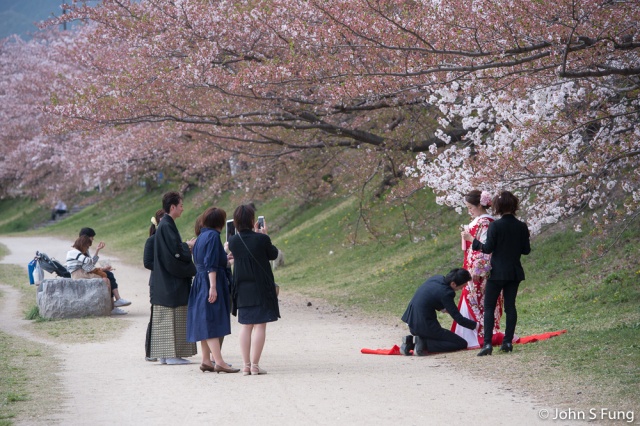
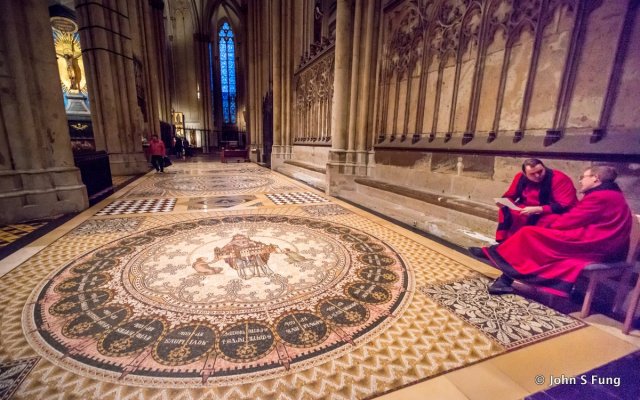



聖托里尼(希臘文:Σαντορίνη)是在希臘大陸東南200公里的愛琴海上由一群火山組成的島環,位於北緯 36.40° —東經25.40°。聖托里尼島環上最大的一個島也叫聖托里尼島,別名錫拉島(Θήρα)。聖托里尼島位於基克拉澤斯群島的最南端,面積約73平方公里,人口約一萬四千餘人,多為希臘人。「聖托里尼」是十三世紀時威尼斯人所命名的,起源於聖·愛蓮(義大利語:Santa Irene);在此前這個島稱為錫拉島、卡利斯提(Καλλίστη,在古希臘語意為「最美」)或斯特隆基里(Στρογγύλη)。島上建築藍白相間,襯以蔚藍大海,美不勝收,是著名旅遊勝地。 維基百科 – 聖托里尼
Santorini (Greek: Σαντορίνη, pronounced [sandoˈrini]), classically Thera (English pronunciation /ˈθɪərə/), and officially Thira (Greek: Θήρα [ˈθira]), is an island in the southern Aegean Sea, about 200 km (120 mi) southeast of Greece’s mainland. It is the largest island of a small, circular archipelago, which bears the same name and is the remnant of a volcanic caldera…. Wikipedia – Santorini

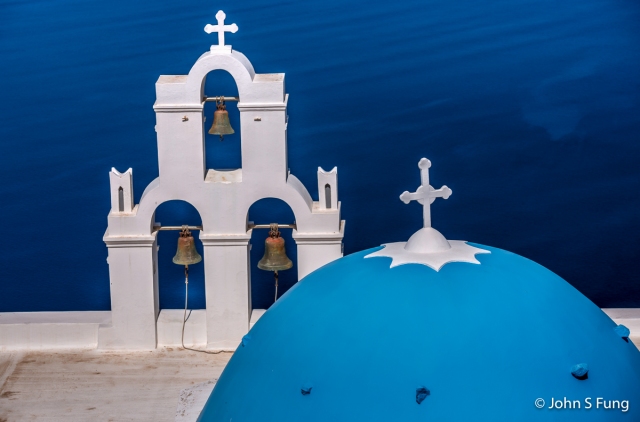


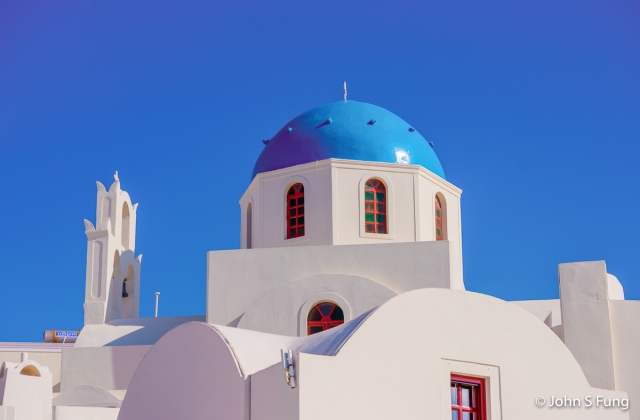
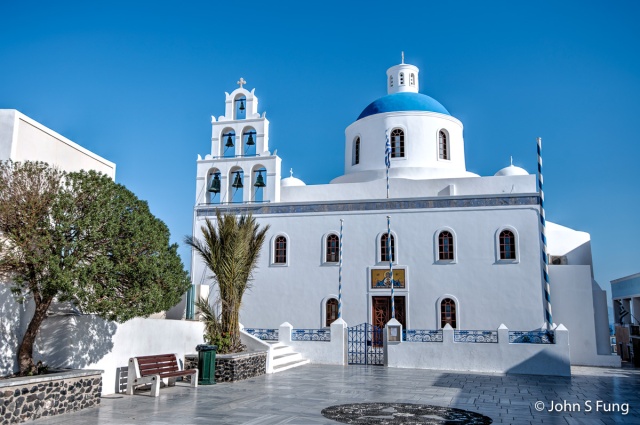
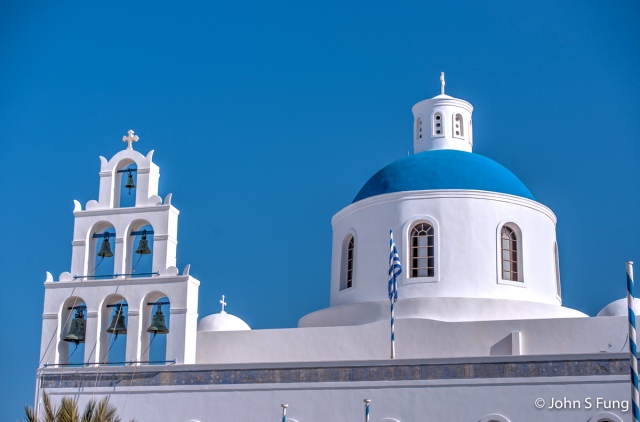
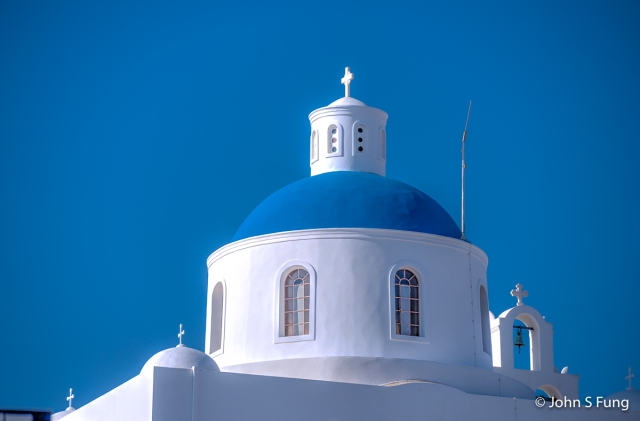
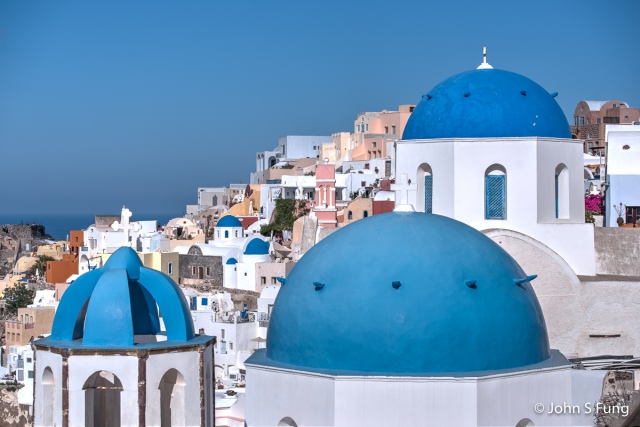

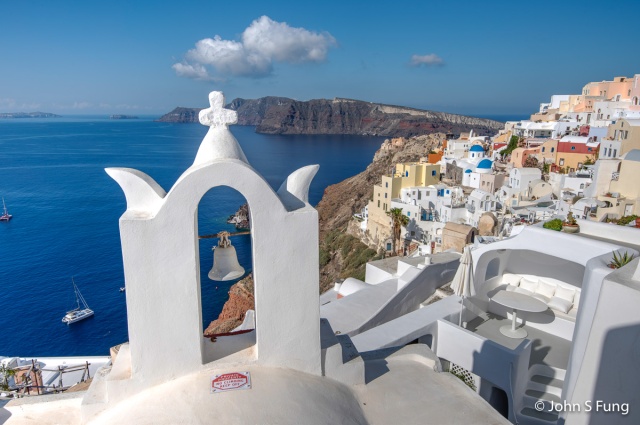
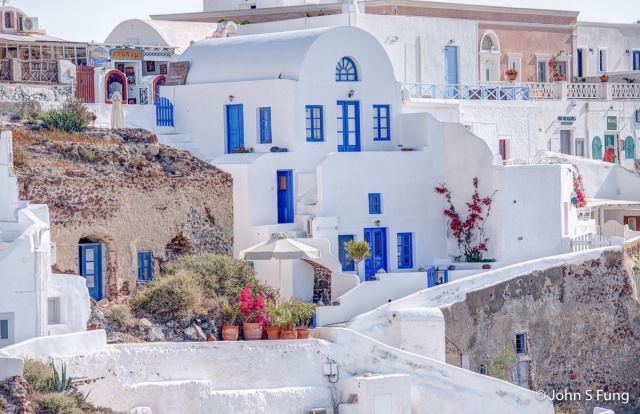

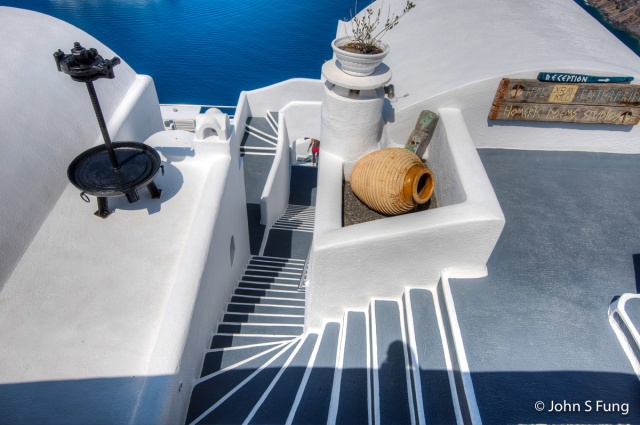
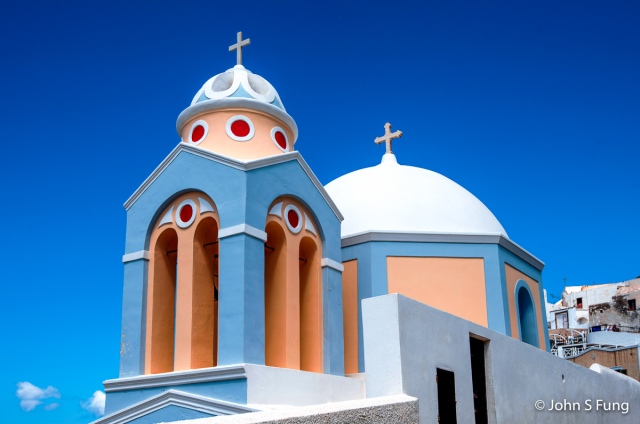
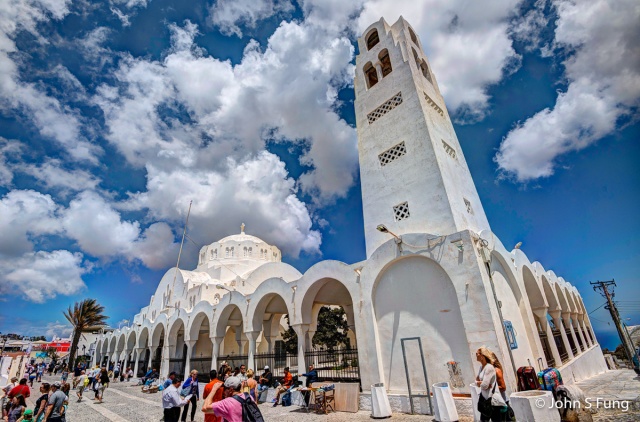
Visited 2016.5.18
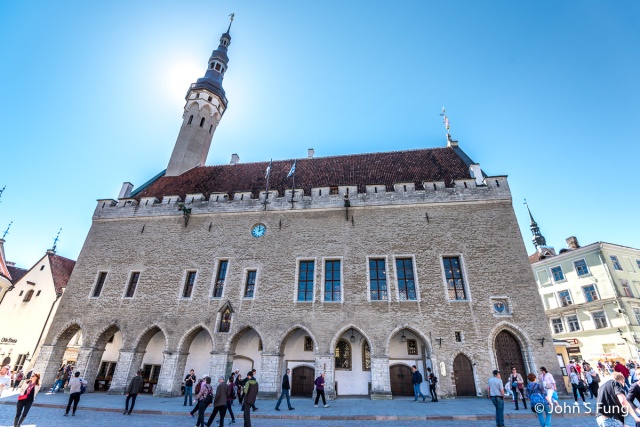
市政廳廣場(City Hall Square or Raekoja plats)在歷史上都是塔林的市集和聚會場所,據說曾經至少一次是執行死刑的地點。今天, 它仍然是塔林城的中心,大部分的主要活動都在這裡舉行,如聖誕市集、舊城節等。我們五月時參觀這裡,五月還不是旅遊最旺季,但是它已經擠滿了遊客,廣場周圍都是商家和餐館,在建築物的前面,擺有很多咖啡/餐桌,非常熱鬧。
The town hall square (Raekoja plats) is historically the market and meeting place of the town of Tallinn, and was at least once the site of execution. Today it is still the heart of the town, most of the main events are held here, like the Christmas market and the Old Town Days festival. We visited the place in May, not considered to be the peak of the tourist season, however, it was packed with tourists, the open plaza is surrounded by merchant houses and restaurants, and in front of the buildings, there were a lot of cafe tables.
從屋頂延伸出來下水口。⇑⇑ Water sprout extended from the roof.

市政廳牆上的中古紋章。 ⇑⇑ Medieval coat of arms on the wall of the Town Hall.
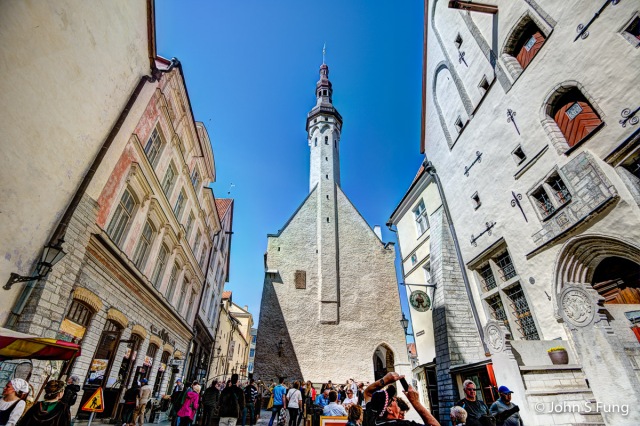
⇑⇓ The Tower of City Hall as seen in front of Olde Hansa Restaurant.
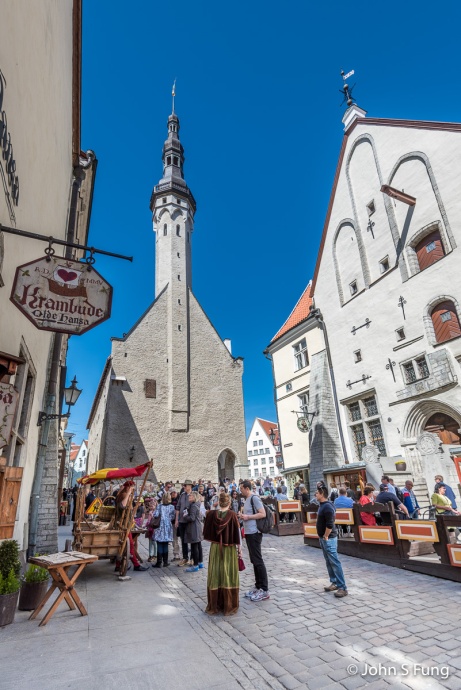
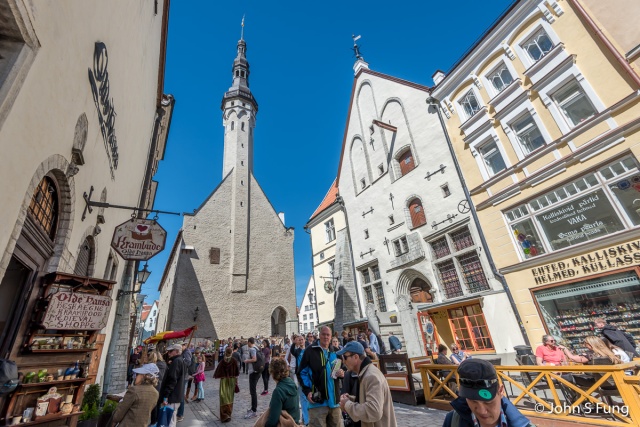


Olde Hansa 餐館,号称塔林老城最負盛名的中世纪主题餐厅。Olde Hansa Restaurant, said to be the best restaurant in Tallinn with medieval ambience.
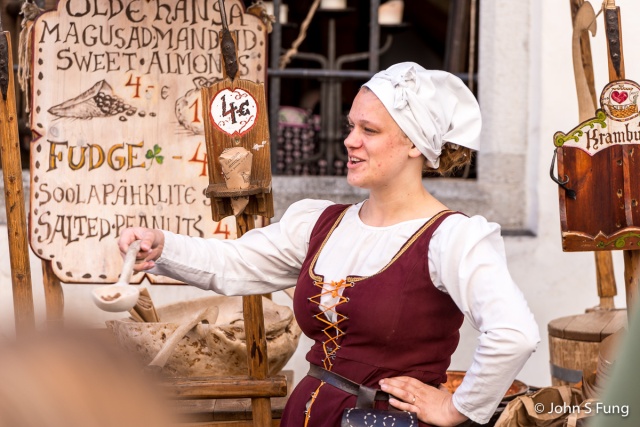

遊客和穿著中世紀服裝的店員合照。 Tourist posted with shopkeeper dressed in Medieval costumes.

穿著中世紀服裝的店員。 ⇑⇓ Shopkeepers dressed in Medieval costumes.
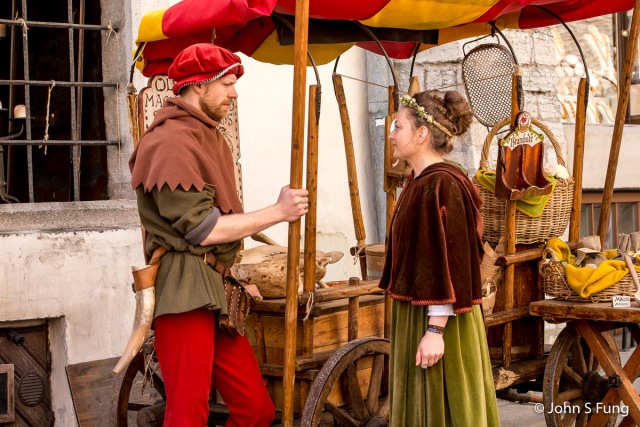

塔林市政廳僅在7月和8月向遊客開放,然而,年中大部份時間,塔樓是對外開放的。 ⇑ 塔的入口。
The town hall of Tallinn opens to tourists only in July and August, however, the tower is open, most of the time, to those who wants to have a panoramic view of the city . ⇑ The entrance to the tower.
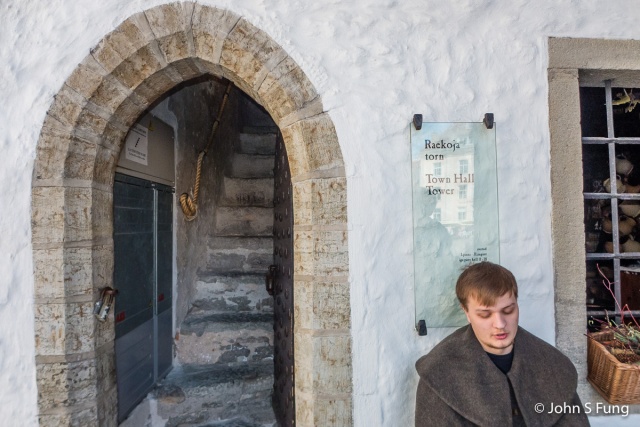

⇑ 鳥瞰塔前的廣場。 ⇓ 在地面上看到的商家的店面。
⇑ A bird’s eye view of the plaza in front of the tower. ⇓ The merchants’ houses as seen on the ground.
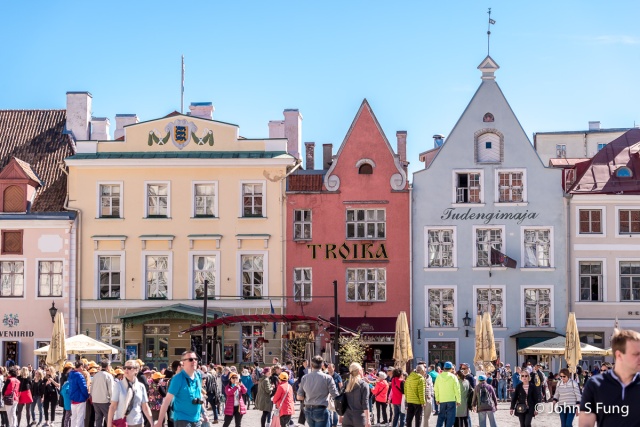
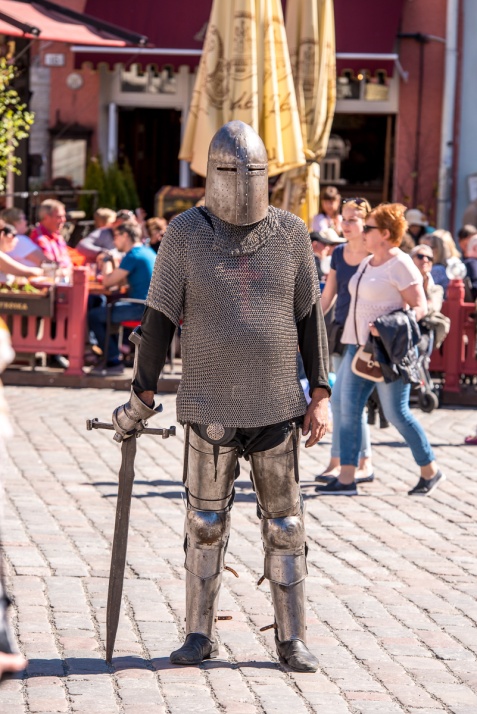
中世紀武士模仿藝人。 A medieval warrior impersonator.

西望上城區 (Toompea),洋蔥圓頂的聖亞歷山大涅夫斯基大教堂,遠處看就知道是俄羅斯式的 。
Looking to the west (Toompea), the onion-domed church, St. Alexander Nevsky Cathedral, is surely Russian looking even from a distance.
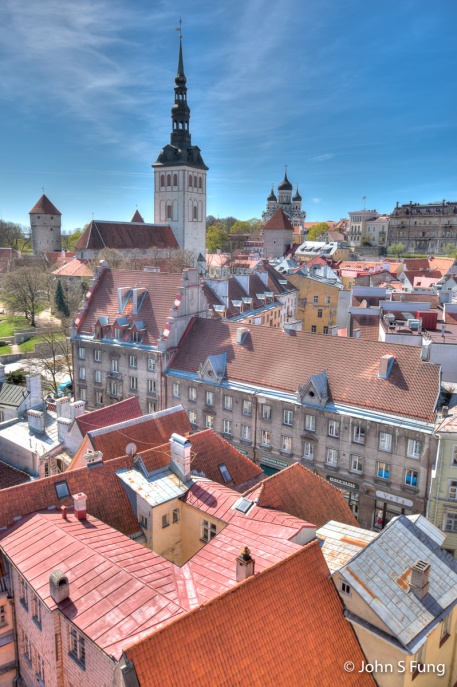


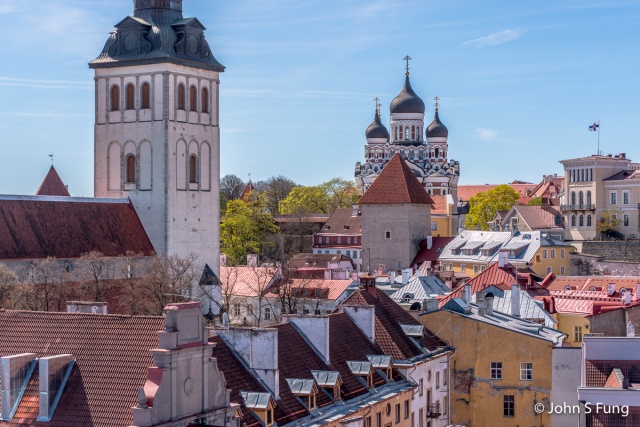

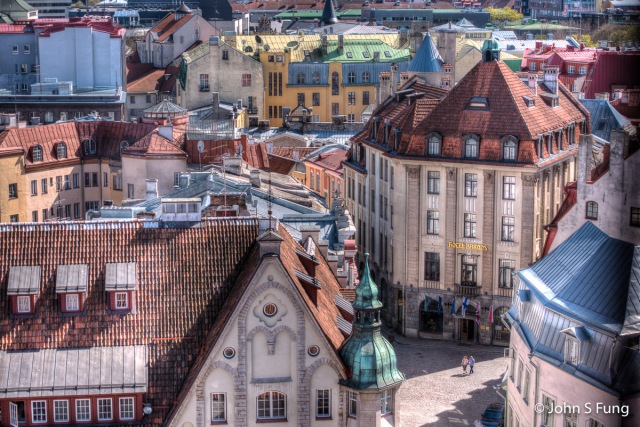
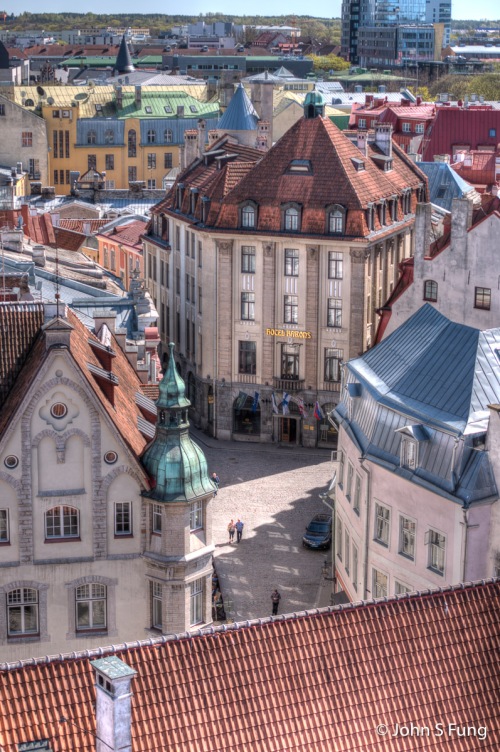
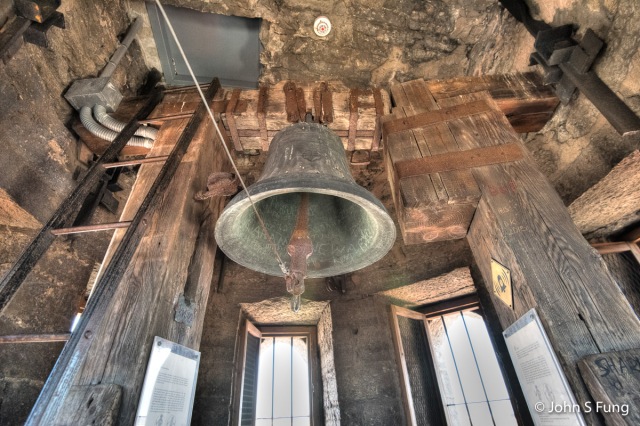
頂樓的鐘。 The bell on the top floor.
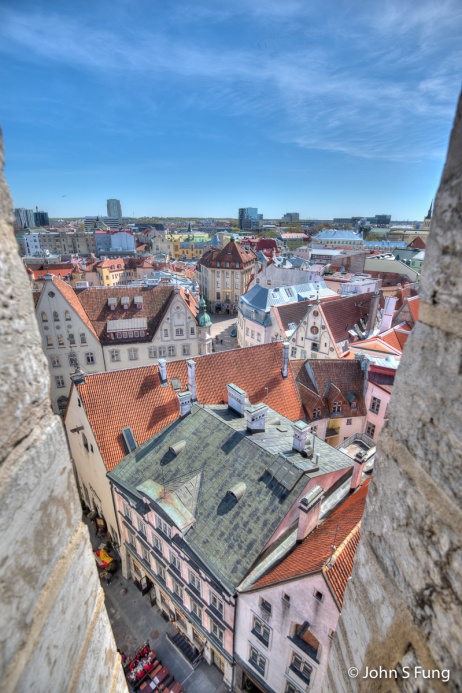

在參觀了舊市政廳的塔樓後,我們走到廣場對面的聖靈教堂(看下面)。在路上,我們看到多姿多彩的建築元素 ⇓⇓。
After a visit to the top of the old town hall tower, we walked to Holy Spirit Church across the plaza. On our way, we enjoyed the colorful elements on their architecture ⇓⇓.





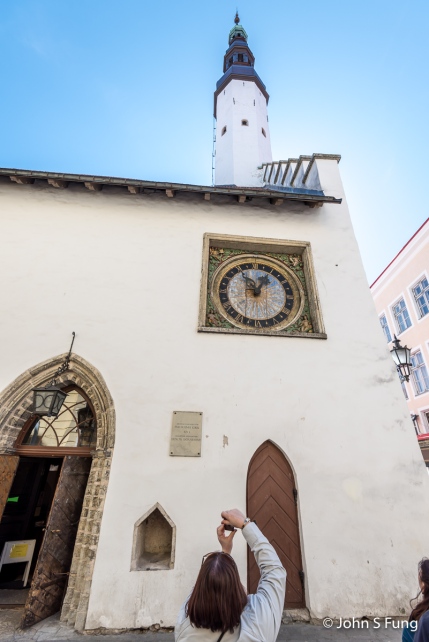
聖靈教堂的正面。這個精心繪製的時鐘據說是該城的第一個公共時計。
The facade of Holy Spirit Church. This elaborately painted clock is said to be the first public timepiece of the town.
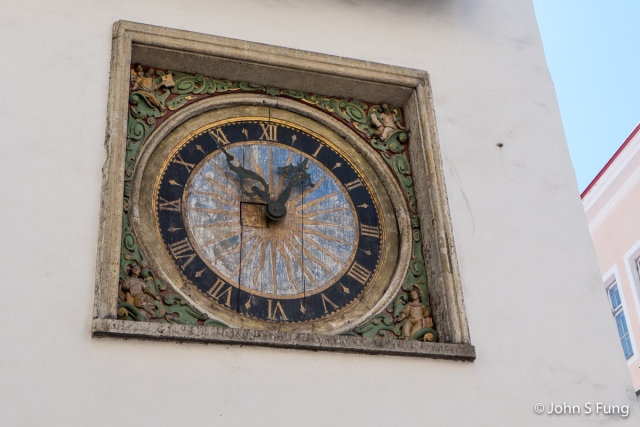
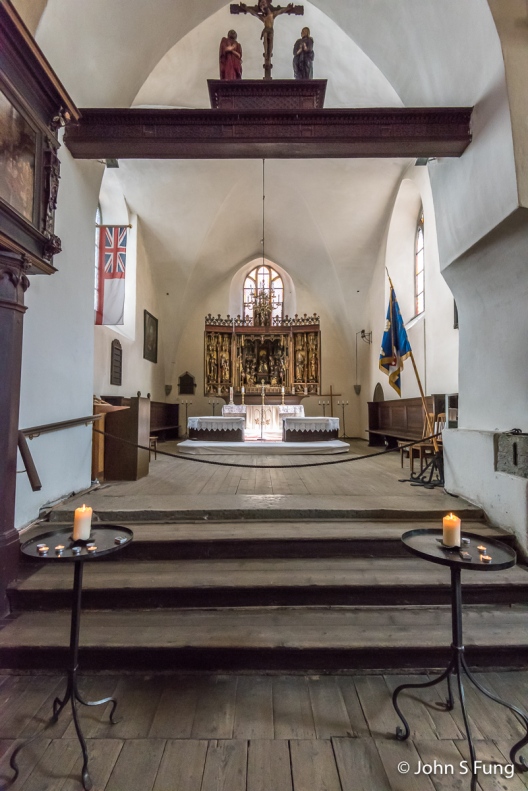
這座15世紀的祭壇是由 Lubëck 藝術家 Bernt Notke 創作的。
This 15th century altar was created by Lubëck artist Bernt Notke.
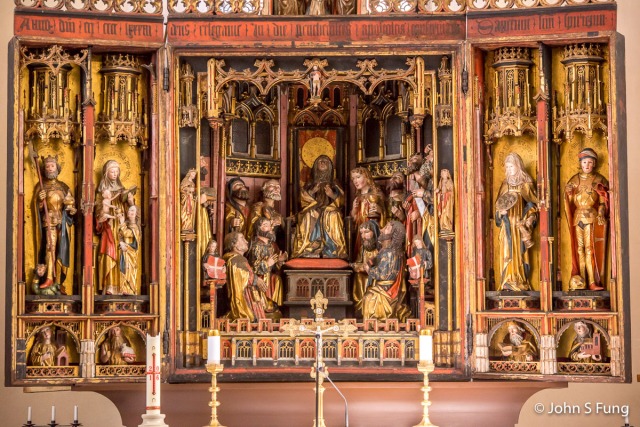
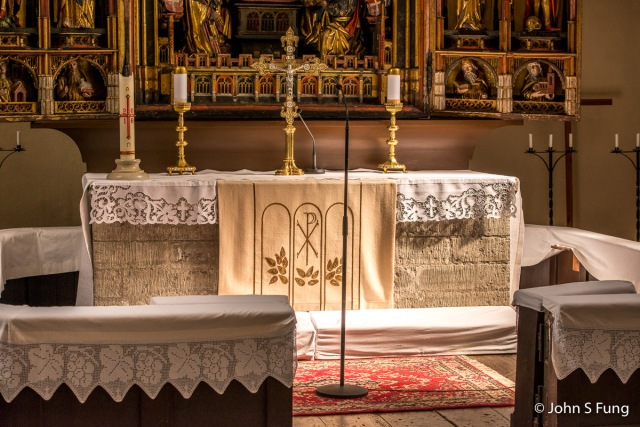
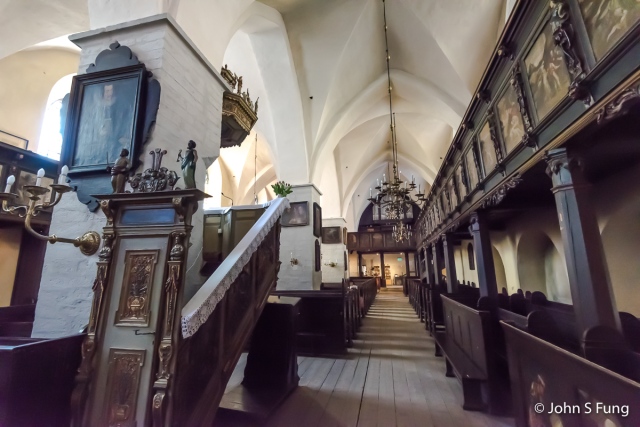
精心雕刻的教堂內部, 透着中世紀的氣氛。
The elaborately carved interior of the church yields a medieval ambiance.
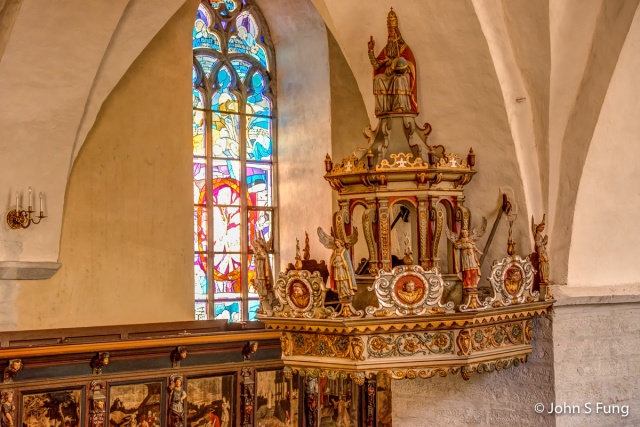
⇑⇓ 這個講壇據說是愛沙尼亞最古老的講壇之一,可追溯到1597年。
⇑⇓ This pulpit is said to be one of the oldest in Estonia, dating back to 1597.
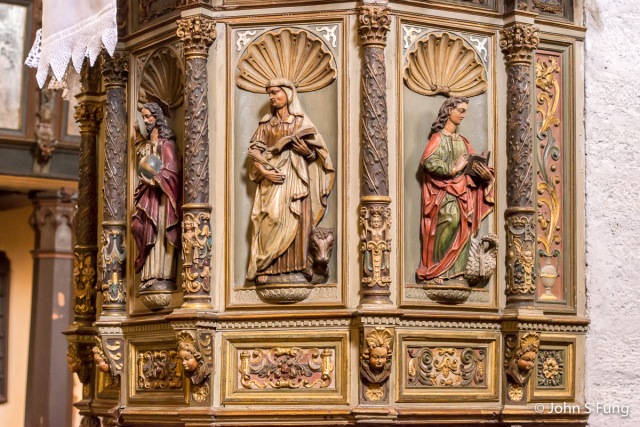
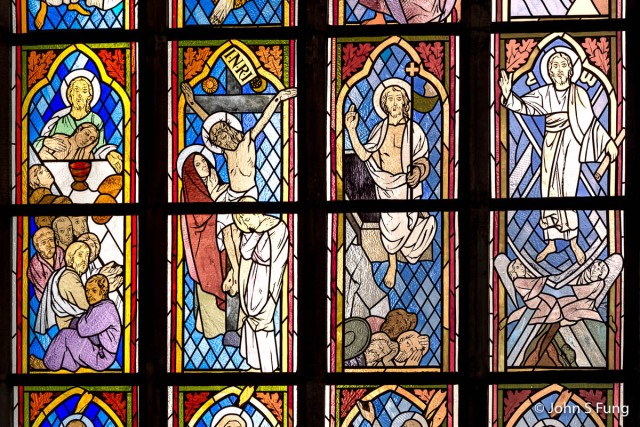


午後的陽光把彩色玻璃窗的色彩灑落在長椅和地板上。
The afternoon sun spilled the benches and the floor with colors from the stained glass windows. 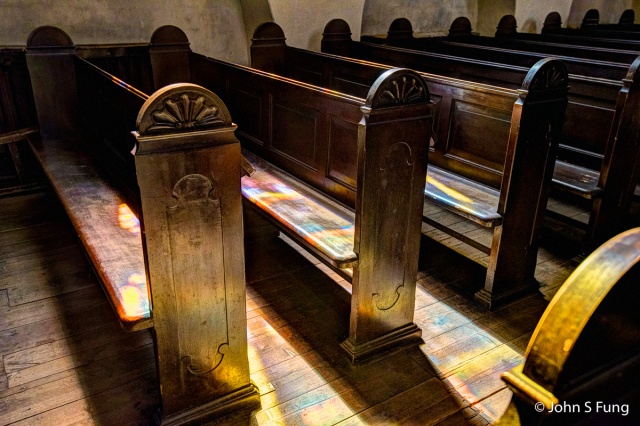
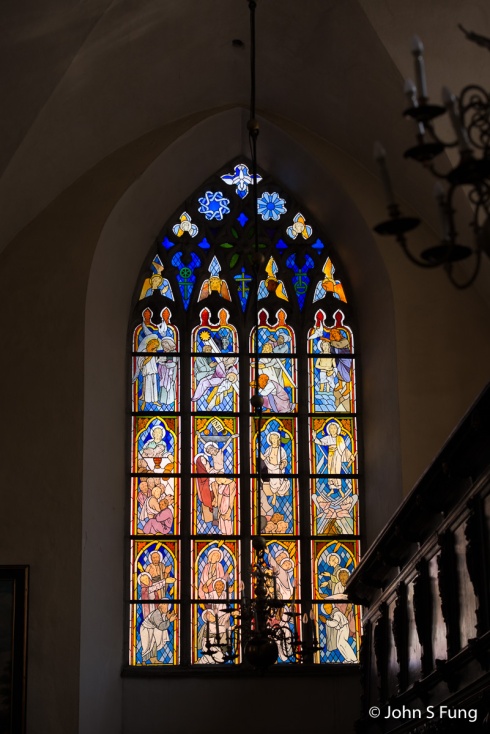
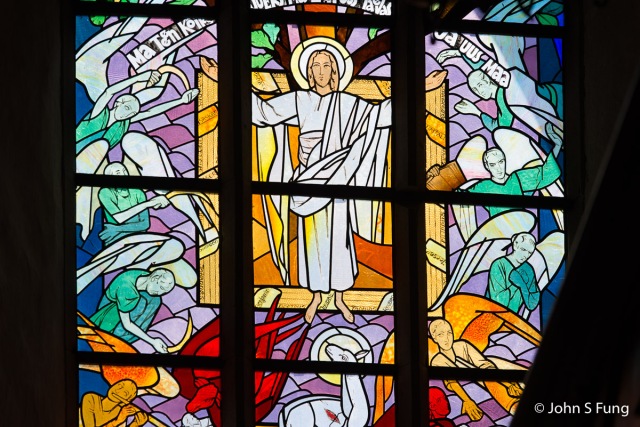

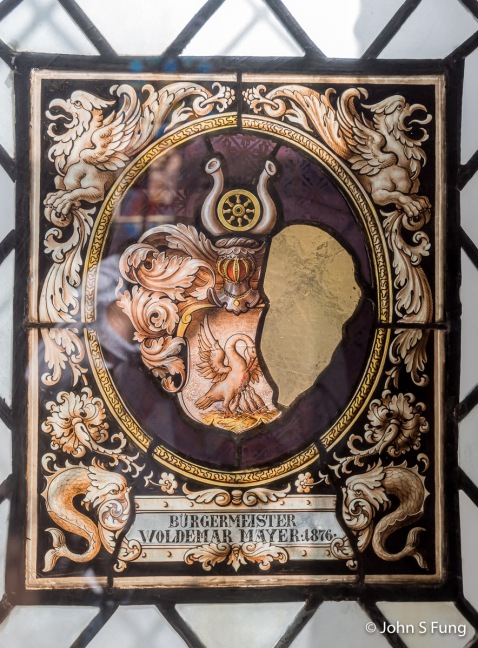

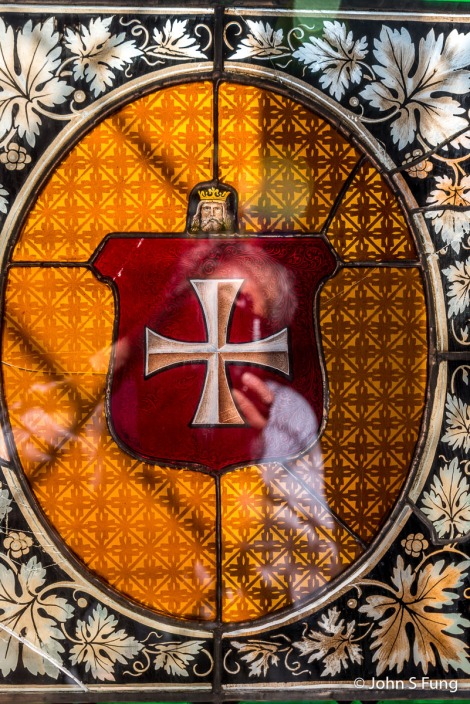

聖靈教堂的塔樓。 The tower of Holy Spirit Church.
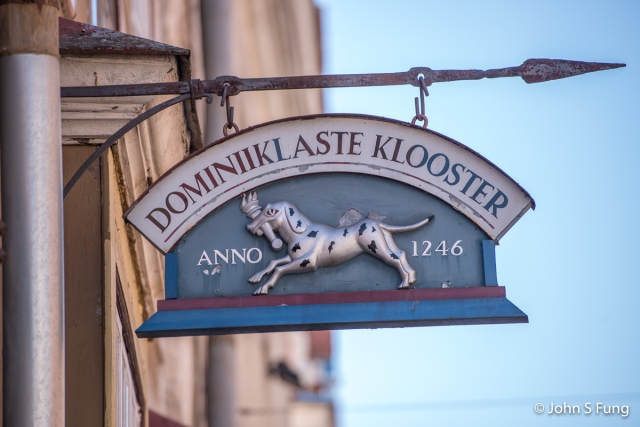
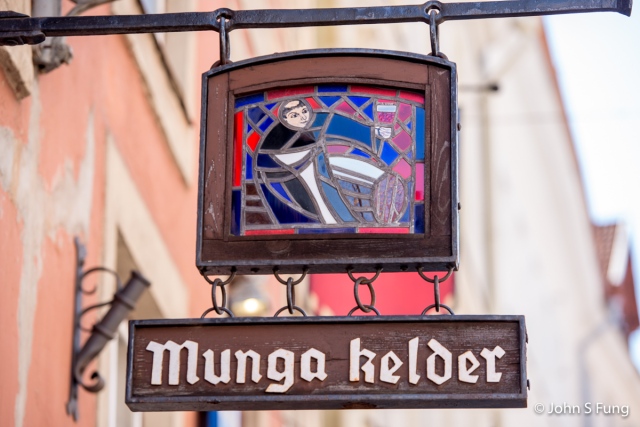
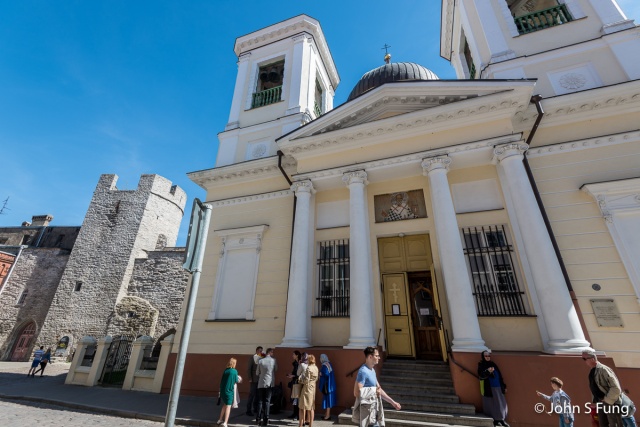
⇓ The icon above the entrance.
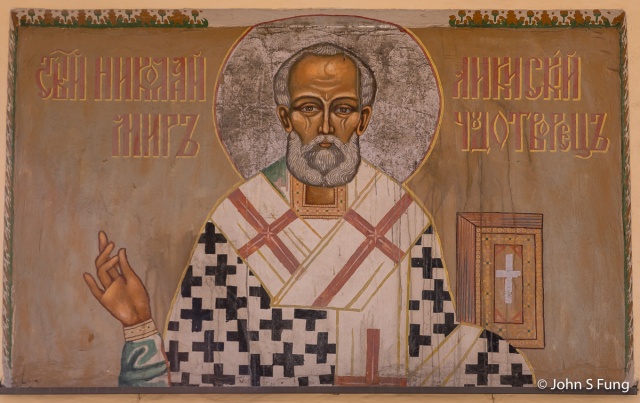


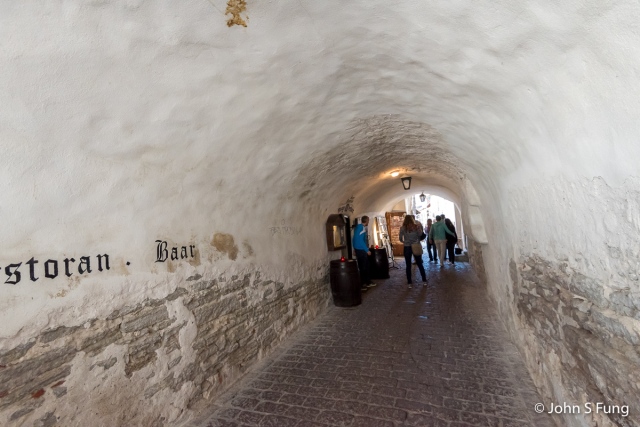
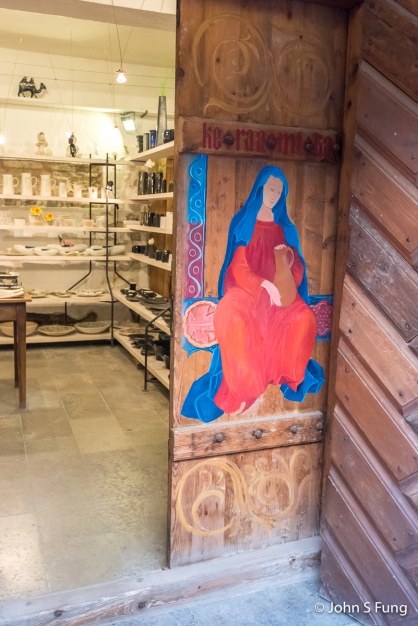
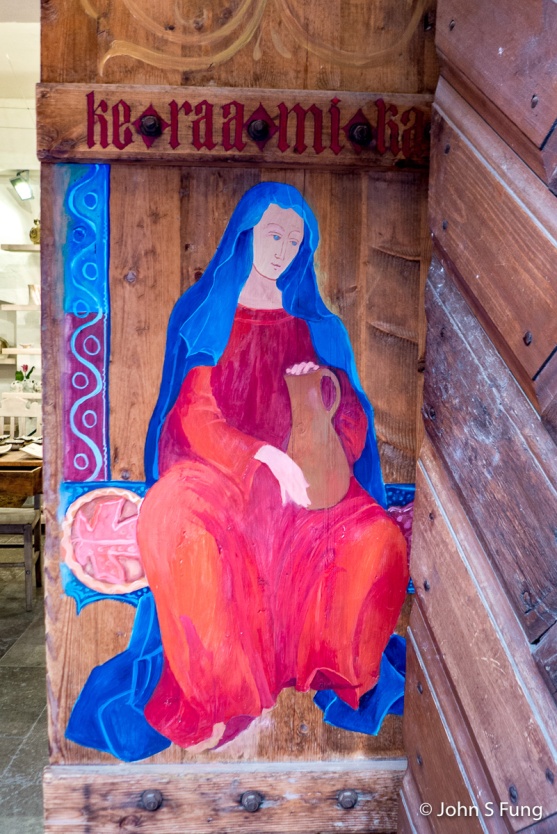
除了咖啡館和餐廳外,這裡還有很多精美的工藝品作坊,並兼作禮品店出售同時具有傳統中世紀技藝和現代創意的玻璃器皿,陶瓷,繪畫等藝品 。
Besides of cafe and restaurants, there is a good collection of craft workshops, double up as gift shops selling glassware, ceramics, paintings, etc, created using traditional medieval skills and modern creativity.
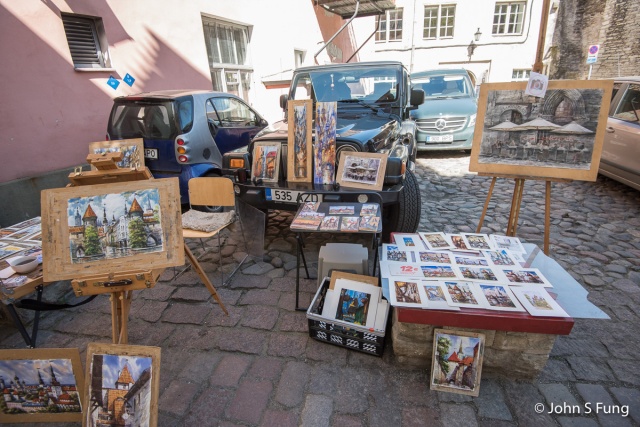

14至15世紀的墓碑來自塔林的聖凱瑟琳多米尼加修道院。在19世紀中葉,毀壞的教堂西部被修復,並在牆上展示了保存最完好的墓碑。據說一些墓碑可以追溯到黑頭兄弟會和大公會的成員。
14th to 15th century Tombstones from the St Catherine’s Dominican Friary in Tallinn. In the mid-19th century the western part of the ruined church was restored and the best preserved tombstones were displayed on the wall. It is said that some of the tombstones can be traced back to the members of the Brotherhood of the Blackheads and the Great Guild.
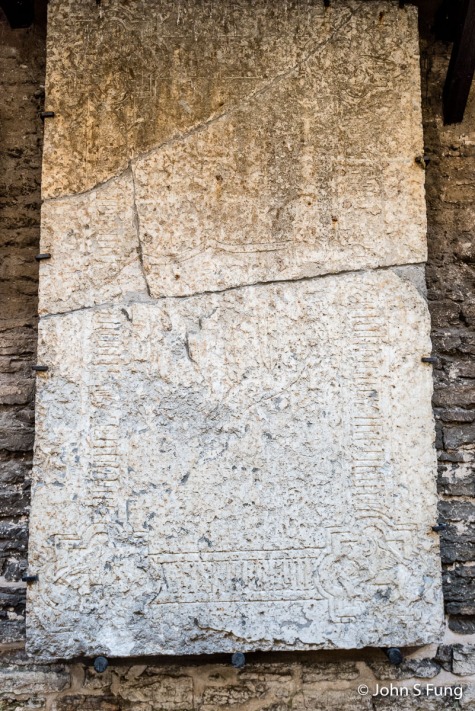
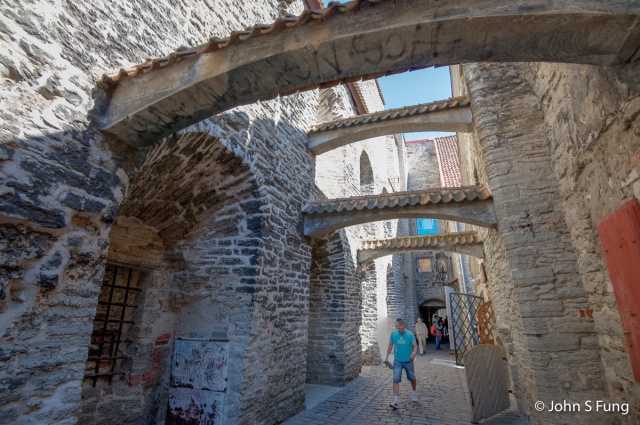
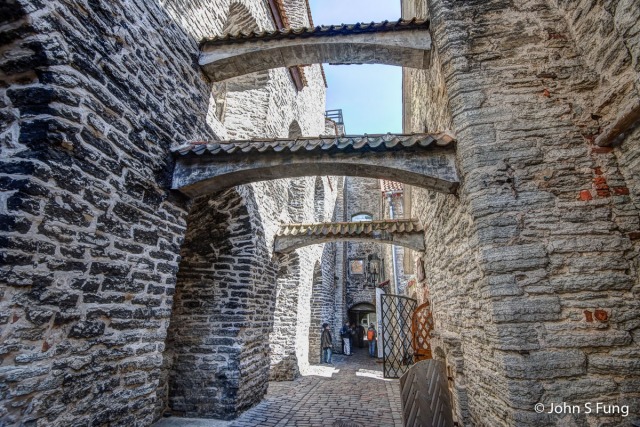
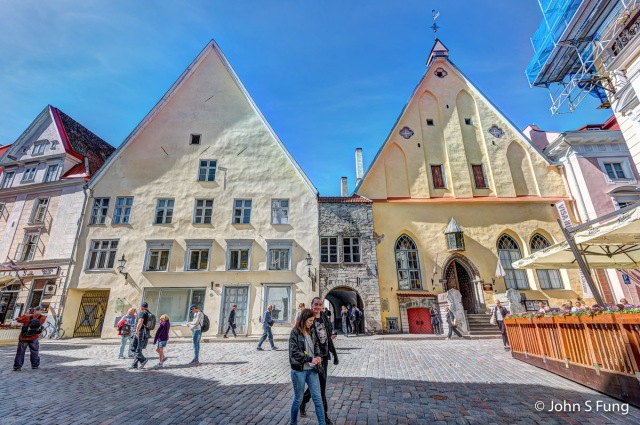

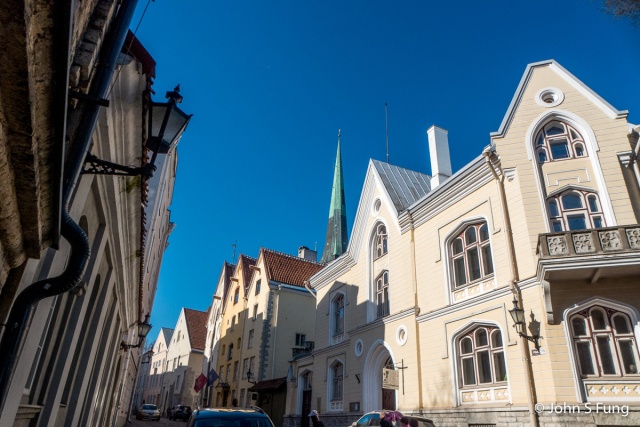
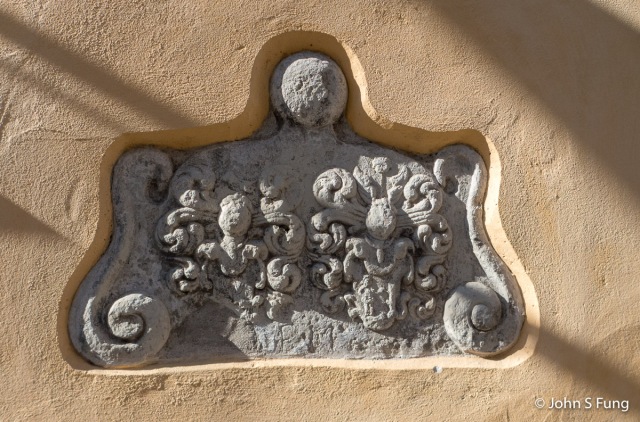

在網上收集資料後,這座教堂就成為我在塔林必看的名單之一。據說這座教堂於1997年被大火燒毀,並於2000年重修。這座建築看起來像中世紀,但是裡面的畫似乎是新近的。教堂位於Laboratooriumi街,毗鄰老城牆。我們早上 9 點到達,發現門是鎖上了。我試圖從他們的告示板上看開放時間資料,這時,一位工作人員出現在門口,問我們是否要參觀教堂,他開門帶領我們進教堂,並告訴我們自己先看, 他要到辦公室辨些業務。 教堂不是典型的教堂建築,因為教堂起初是一座倉庫。它現在還是塔林烏克蘭宗教和文化生活的中心。
After studying infomation collected online, this church stood on top of my must-see list in Tallinn. It is said that this church was destroyed by fire in 1997 and was restored in 2000. The building looked medieval to me, however, the icon paintings inside appeared to be of recent dates. The church is located on Laboratooriumi Street next to the old town wall. We arrived before 9 am and found that the door was locked. I was trying to get something from their notice board, meanwhile, a gentleman on a bicycle appeared at the door and asked if we were interested to visit the church, he opened the door and led us to the chapel and told us to enjoy ourself while he was taking care of some business in the office. The architecture of the church is not typical because the church started as a medieval warehouse. It also serves as the center of the Ukrainian religious and cultural life in Tallinn. Three handed Mother of God Church
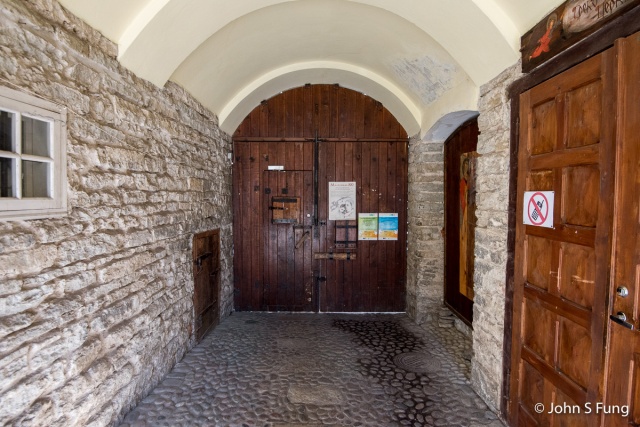
由於從外面通往教堂的門尚未打開,這位工作人員帶領我們通過這個拱門 ⇑ 進入,右邊的門是通往教堂的另一扇門。這扇門的兩側有漂亮的繪畫 ⇓。
Since the door to the church from outside was not yet opened, the gentleman led us enter through this arch doorway. The door on the right is another door to the church, there are beautiful paintings on the walls next to this door.

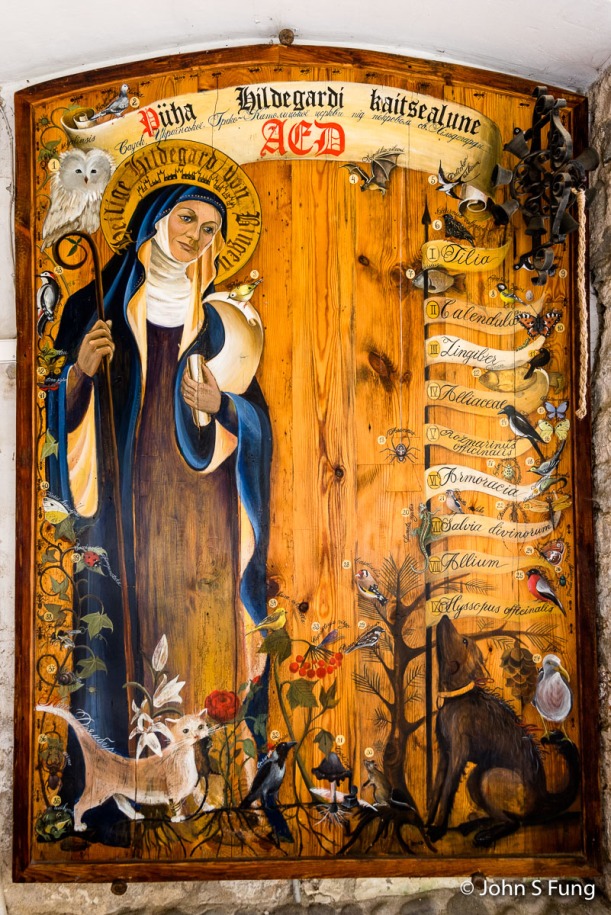
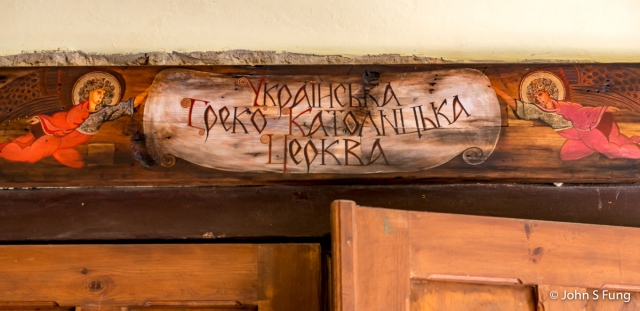
⇑ 門楣上的繪画, 可惜不知寫的是什麽。 ⇑ Beautiful painting on the intel, can’t read it though, it’s all Greek to me.
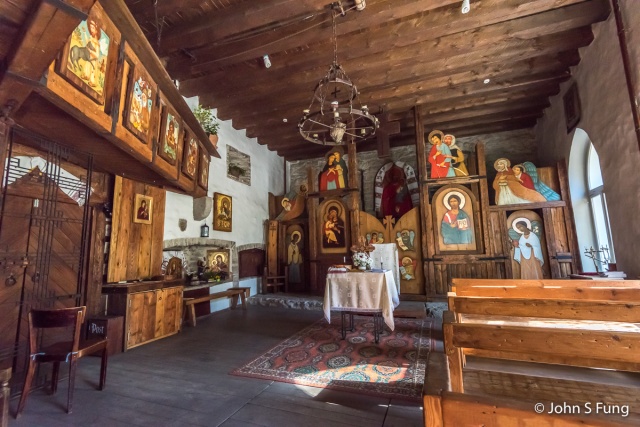
⇑⇓ 教堂的中殿。 ⇑⇓ The nave of the church.
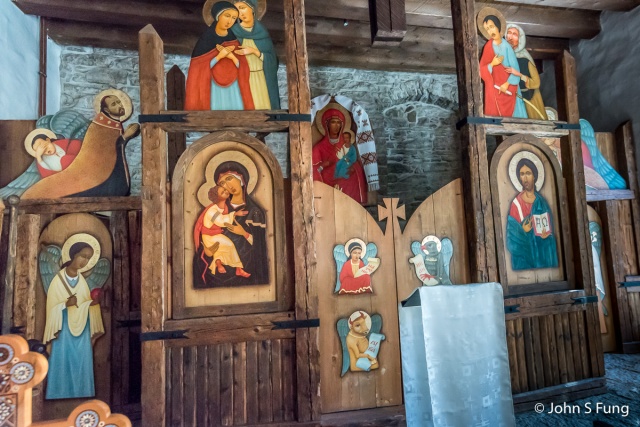

⇑⇑ 教會供奉三手聖母,那些受到了不公正對侍的人們, 會受到三手聖母的照料。
⇑⇑ This church was dedicated to the Three-handed Mother of God.
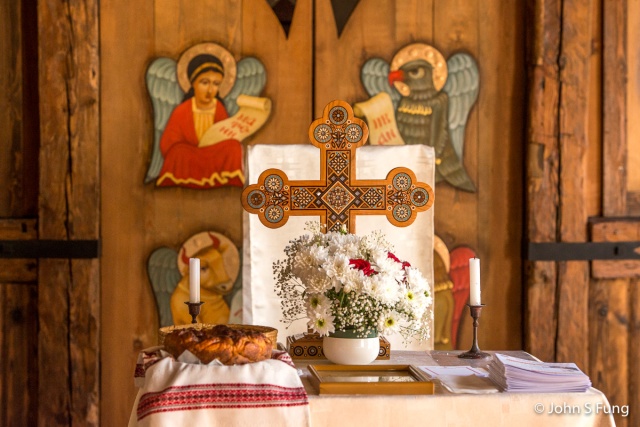
⇑⇓ 教堂的祭壇。 ⇑⇓ The altar of the chapel.

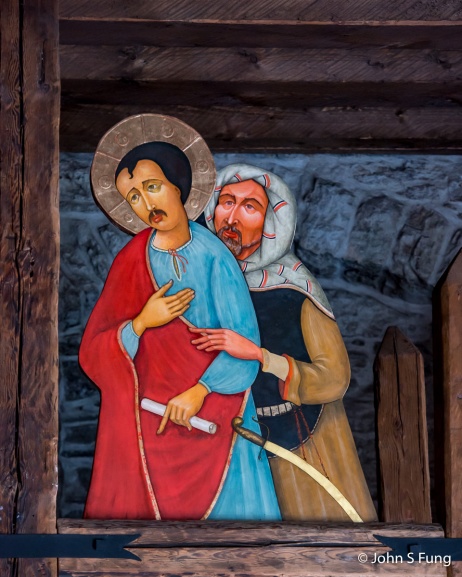
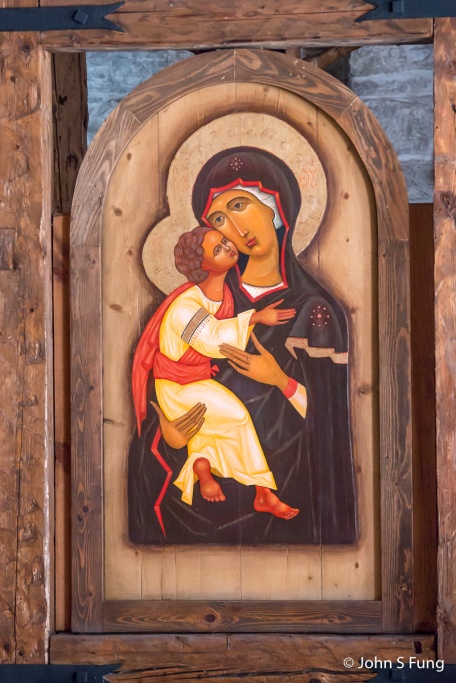

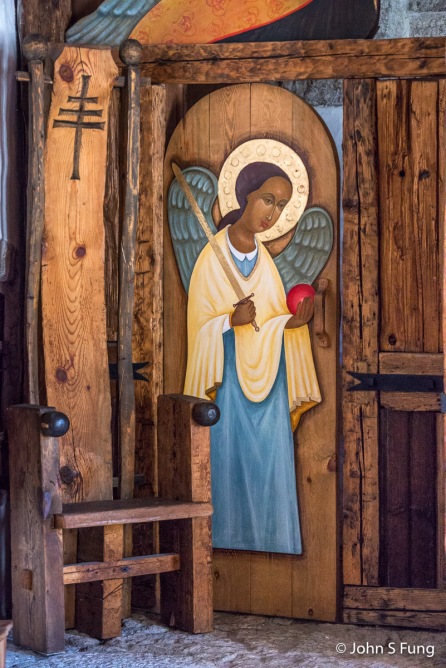
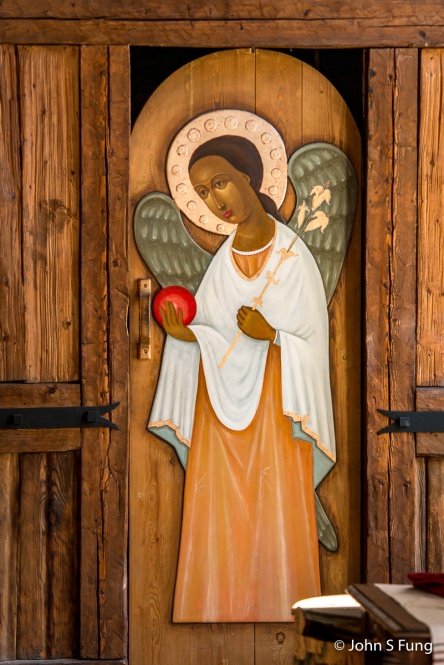
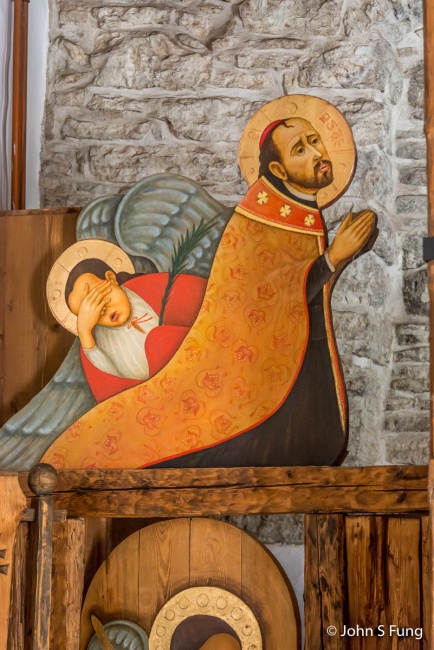
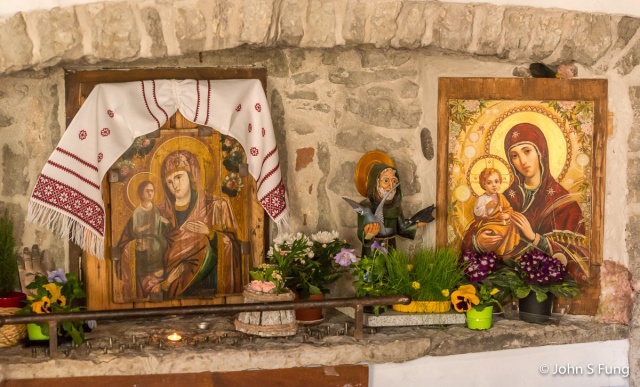
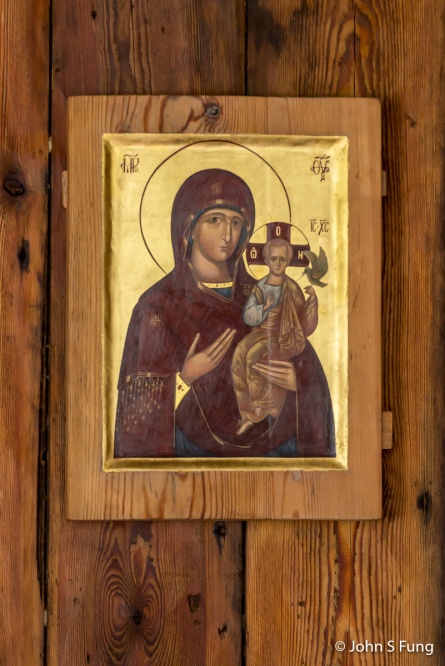
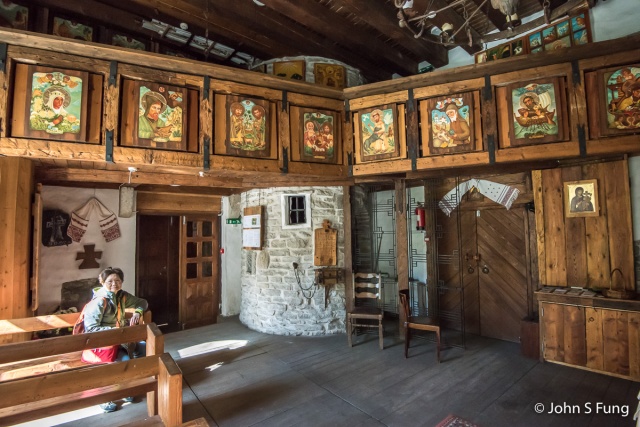
⇑ 教堂內有小閣樓, 但當天沒有向遊客開放。牆上掛著一個木製的奉獻箱,上面有相信是遊客用20多種語言寫成的”奉獻箱” ⇓。
⇑ There is a staircase to the mezzanine, however, it was not opened to visitors that day. A small wooden donation box was hung on the wall. ⇓ Donation Box is labeled in 20+ languages, probably written by tourists.
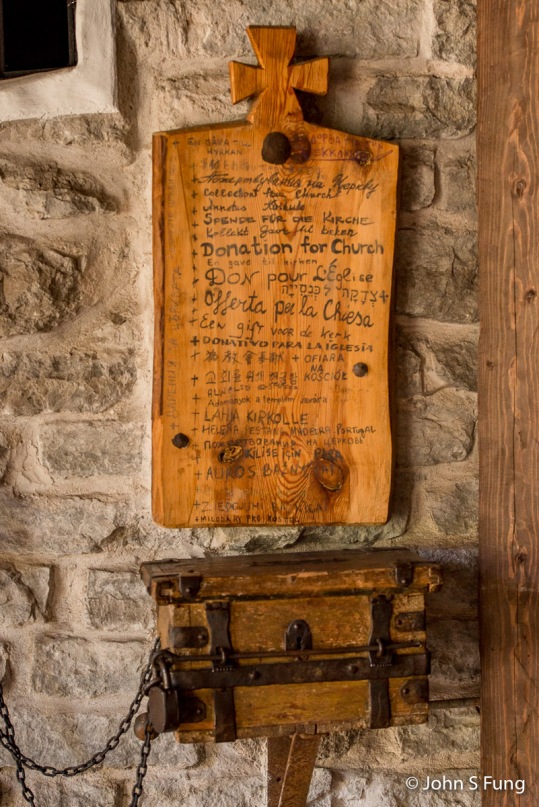
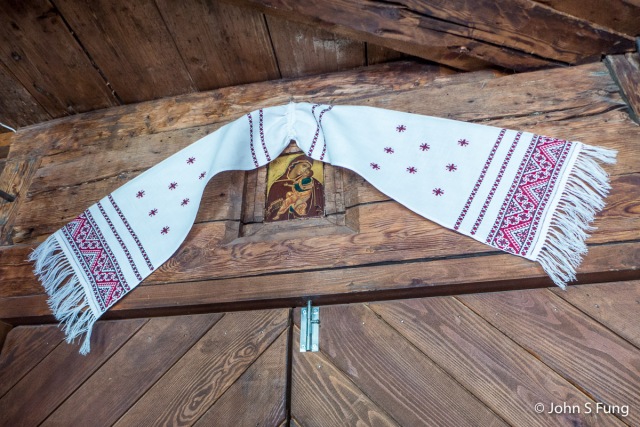
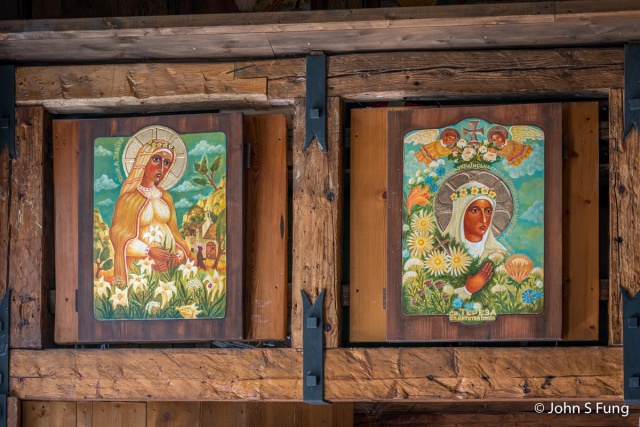
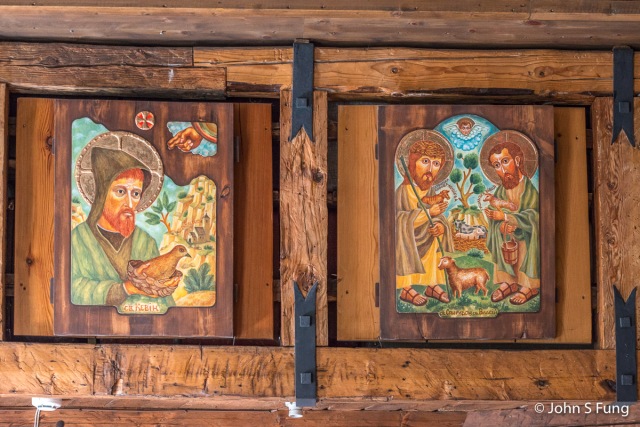
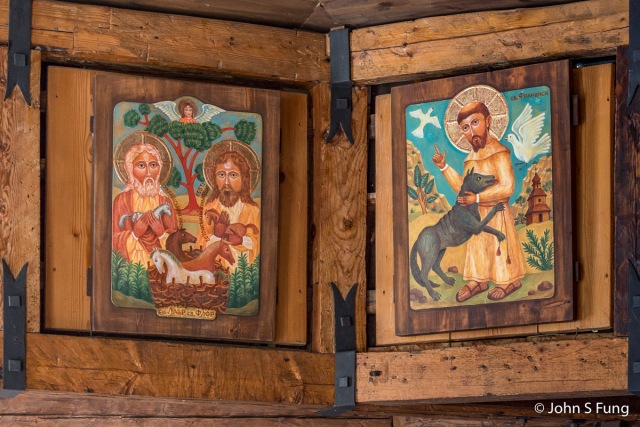
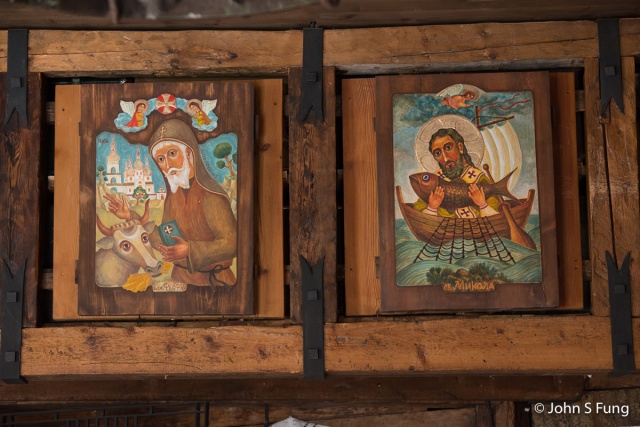
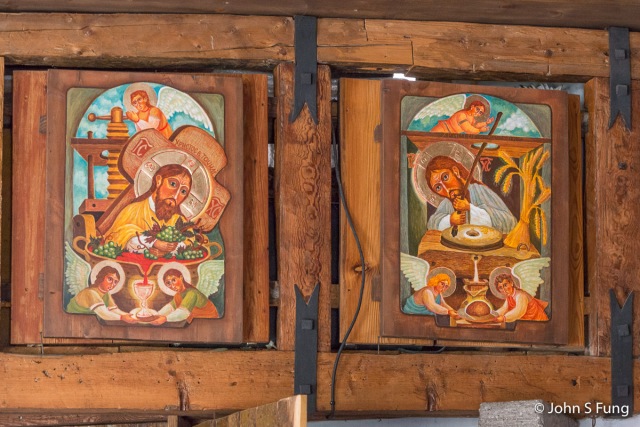
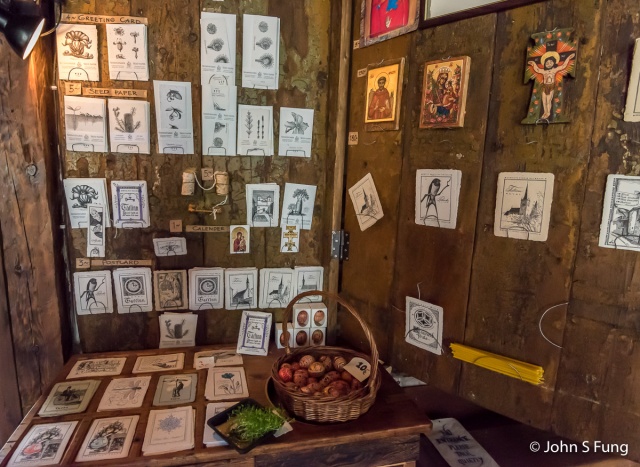
⇑ 這是一個工藝角,出售手工造紙/手印明信片和精美彩蛋。
⇑ This is an art and crafts corner selling handmade paper/hand printed postcards and beautifully painted eggs.
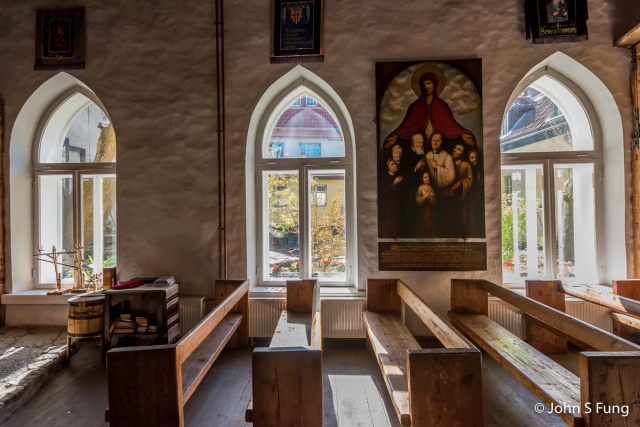
⇑ 從工藝角望向教堂的另一邊, 那是一個小院子,再過去,相信是一個小修道院。
⇑ Looking to the other side of the chapel from the art and craft corner is a small yard, beyond that is believed to be a small monastery.

當我正在拍攝教堂裡的藝術品時, 一位先生過來問我是否想看他們的地下室。他移動了祭壇桌,把地毯拉到旁邊,露出一個地下室,真是令人愉悅的驚喜。
While I was taking picture of the artworks in the chapel, another gentleman came to greet me and asked if we would care to visit their basement. He moved the altar table and pulled the rug aside revealing an automatic basement door. We were so happy that we got this delightful surprise.
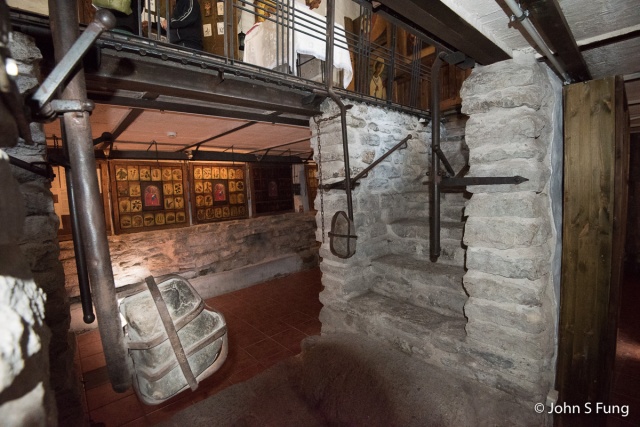
地下室有很多烏克蘭宗教藝術品和手工藝品。
There is a good collection of Ukrainian religious art and handicrafts in the basement.

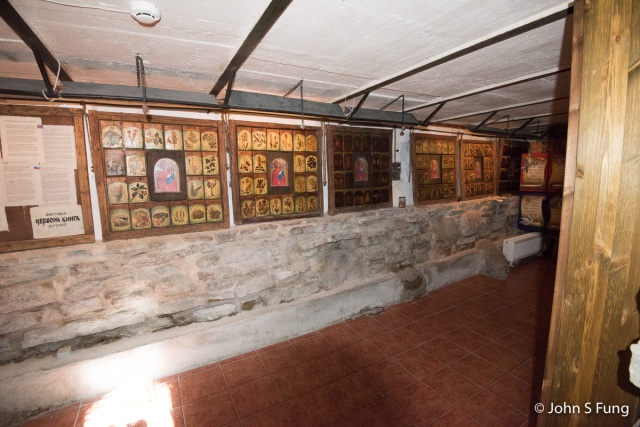

⇑⇓ 這些都是手繪的。 ⇑⇓ These are all hand-painted.
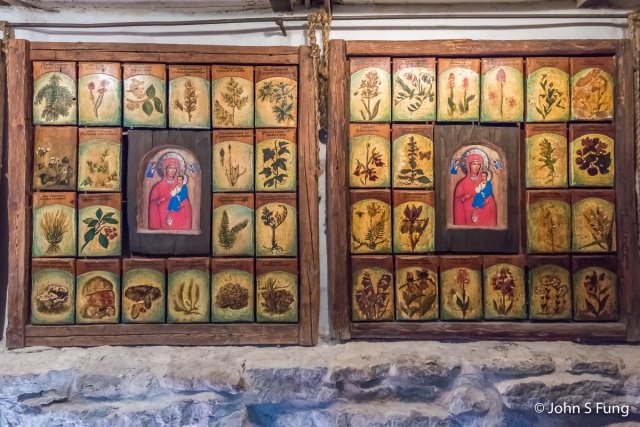


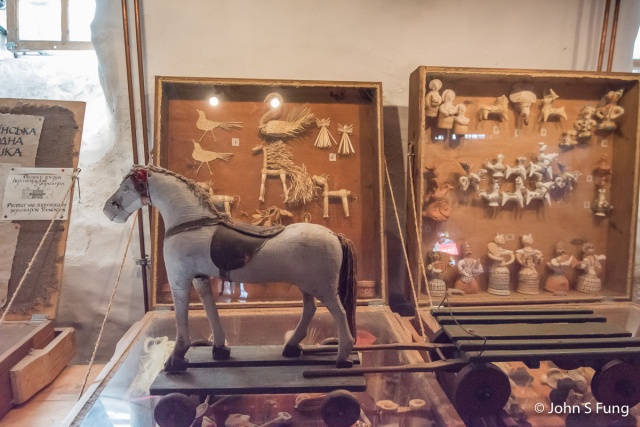
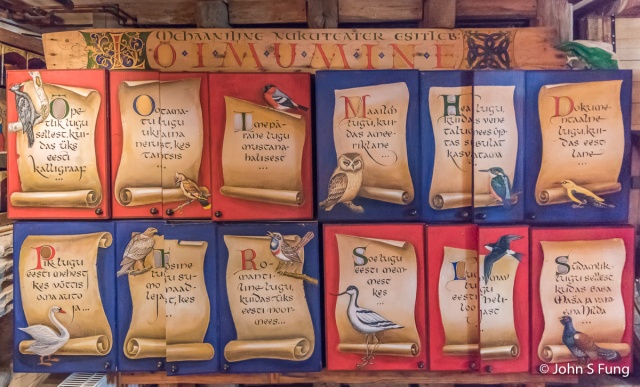
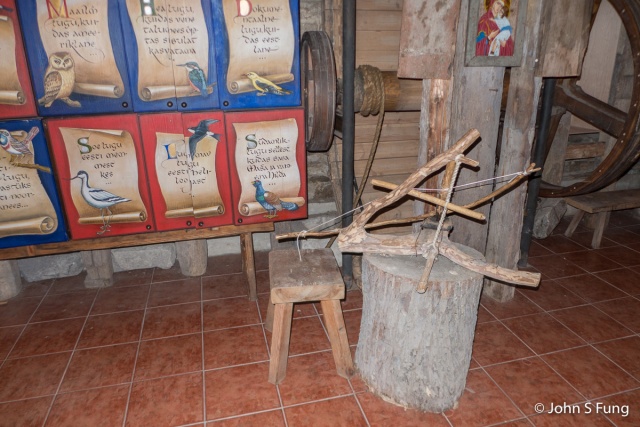
⇑ 精彩的手動鑽。 ⇑ What a wonderful hand drill.

教堂外面的告示板。 The notice board on the outside.
Visited: 2016.5.6
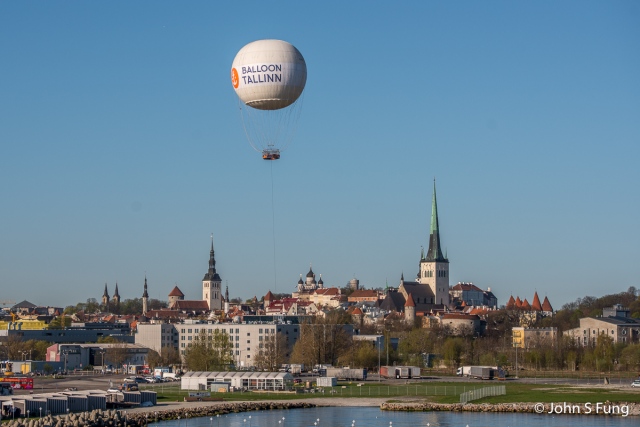
⇑⇓ 從港口看塔林老城, 圖中最高建築是聖奧拉夫教堂。 Tallinn, as seen from the cruise port, the tower of the St. Olaf’s Church stands tall at the horizon. St. Olaf’s Church is the iconic landmark of Tallinn.
維基百科: 塔林聖奧拉夫教堂(愛沙尼亞語:Oleviste kirik)是愛沙尼亞首都塔林的一座教堂,創建於12世紀,在1219年丹麥征服塔林以前,是舊塔林斯堪的那維亞社區的中心。它的主保聖人是奧拉夫二世。最早的文字記載見於1267年,在14世紀進行了大規模改建。維基百科: 塔林
Wikipedia : St. Olaf’s Church or St. Olav’s Church (Estonian: Oleviste kirik) in Tallinn, Estonia, is believed to have been built in the 12th century and to have been the centre for old Tallinn’s Scandinavian community before Denmark conquered Tallinn in 1219. Its dedication relates to King Olaf II of Norway (also known as Saint Olaf, 995–1030). The first known written records referring to the church date back to 1267, and it was extensively rebuilt during the 14th century. St. Olaf’s Church, Tallinn Estonia: Tallinn
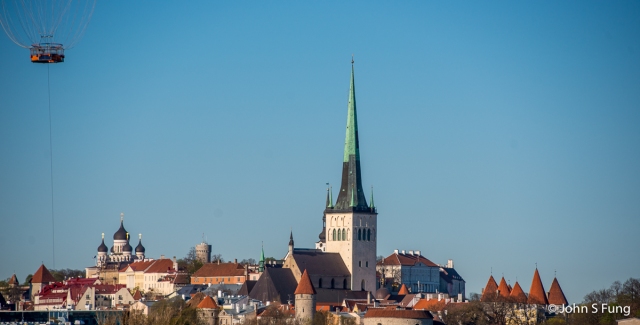
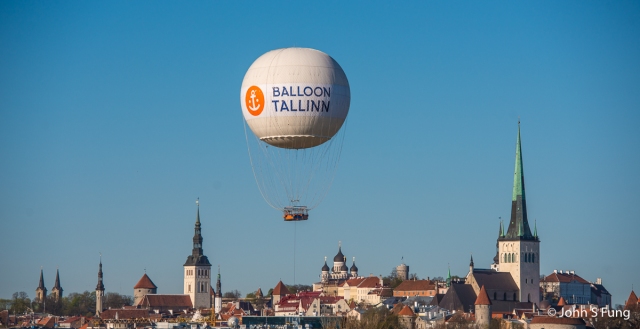
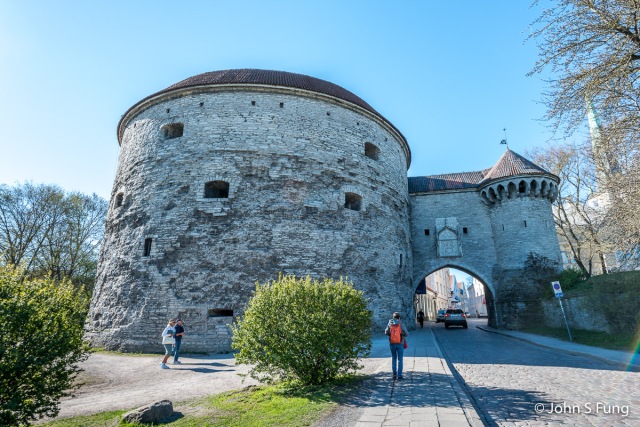
Fat Margaret Tower, 16th-century limestone cannon tower with a museum inside highlighting Estonian maritime history. Estonian Maritime Museum Tallin
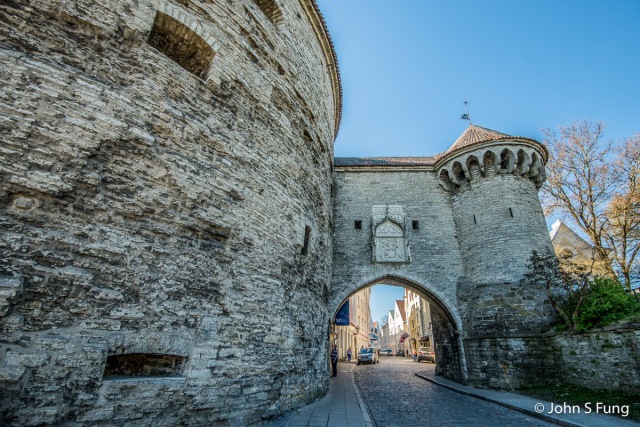
塔林舊城入口, 亦是愛沙尼亞航海博物館。

胖瑪加烈塔 Fat Margaret(愛沙尼亞語:Paks Margareeta,在德語中也稱為Dicke Margarethe), 重建於16世紀初(1511年至1530年), 內為愛沙尼亞航海博物館。
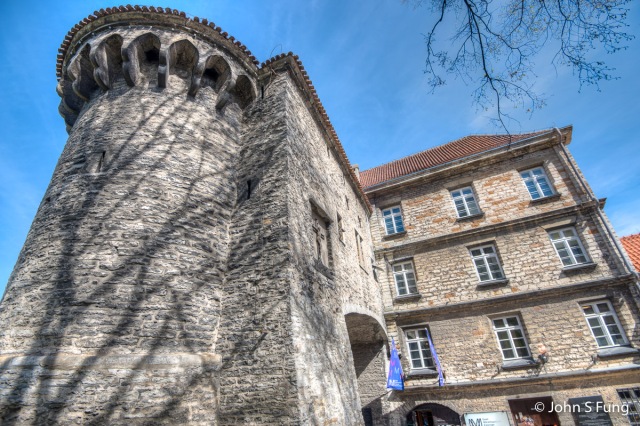
Fat Margaret (Estonian: Paks Margareeta, also known in German as Dicke Margarethe) was built in the early 16th century (from 1511 to 1530) during the reconstruction of the medieval city gate system. (Wikipedia)
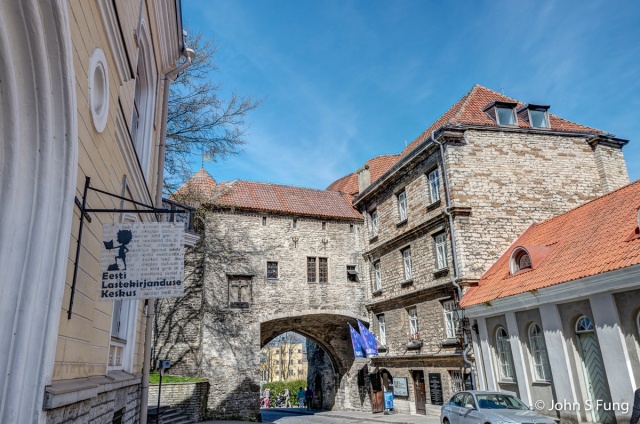

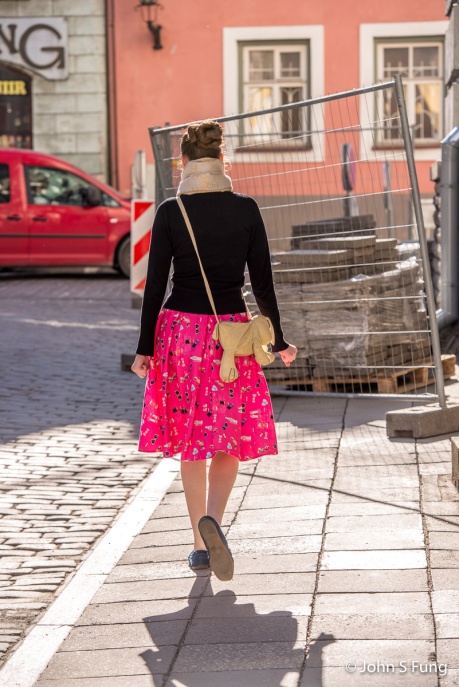

塔林聖奧拉夫教堂(愛沙尼亞語:Oleviste kirik)是愛沙尼亞首都塔林的一座教堂,創建於12世紀,在1219年丹麥征服塔林以前,是舊塔林斯堪的那維亞社區的中心。它的主保聖人是奧拉夫二世。最早的文字記載見於1267年,在14世紀進行了大規模改建。(維基百科)
⇑⇓ St. Olaf’s Church, we arrived at the front gate of the church around 9am, the door was still closed. We wasted no time and headed to the nearby Ukrainian Greek-Catholic Church (see the next post) which is located next to the Old Town wall at Laboratooriumi (northeasten side of the old town wall). After an interesting visit to the Ukrainian church, climbed up the old town wall to admire the architecture.
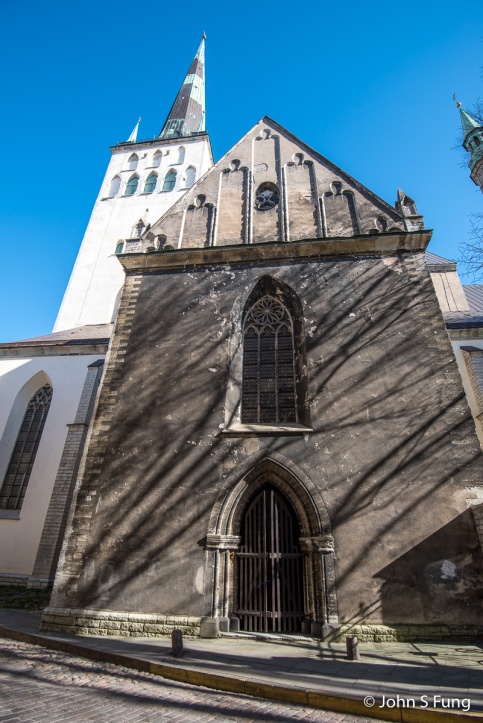
在返回郵輪港的路上,我們回來看聖奧拉夫教堂的內部,與聖靈教堂不同,它相對簡單,沒有花哨的彩畫玻璃或藝術品。
On our way back to the cruise port, we came back to see the inside of St. Olaf’s Church, unlike that of the Holy Spirit Church, it is relatively simple, no fancy stained glasses or art works.

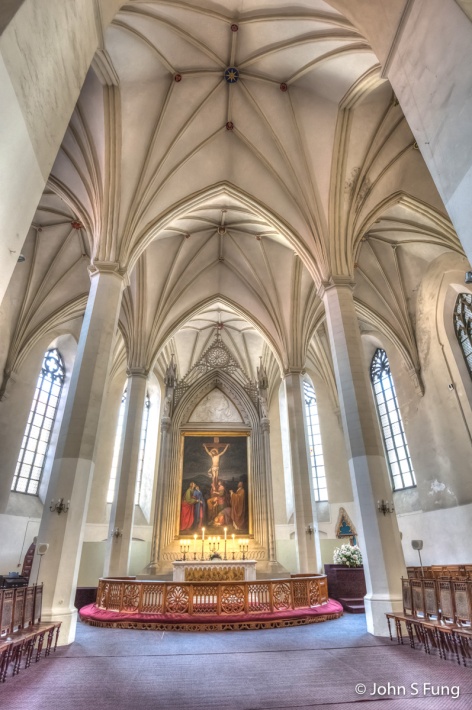

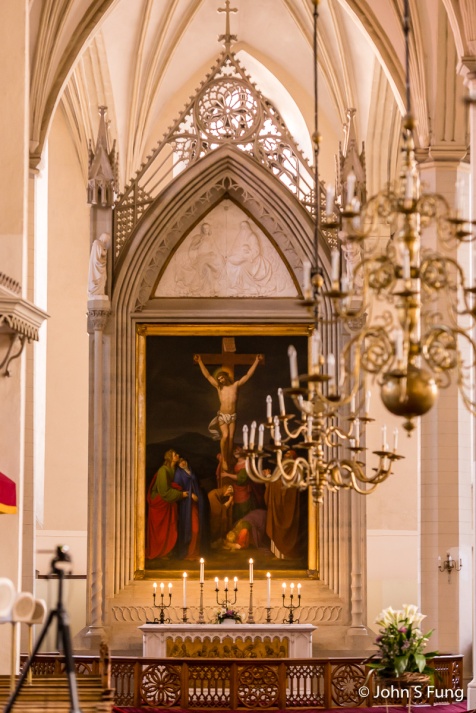
教堂內的聖壇 The altar.

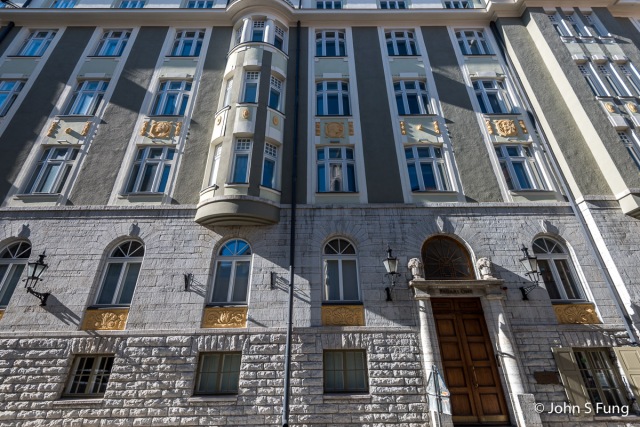
⇓ 在尋找烏克蘭希臘天主教堂時,我們在塔林的小巷漫步,中世紀的建築有趣地出現現代塗鴉。
⇑ Across the street of St. Olaf’s Church, this beautiful old building caught my eyes. ⇓ While looking for Ukrainian Greek-Catholic Church, we strolled on the side streets of Tallinn where medieval architecture interestingly highlighted with modern graffiti.
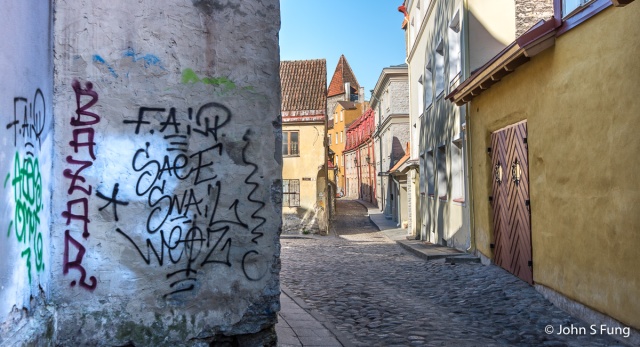

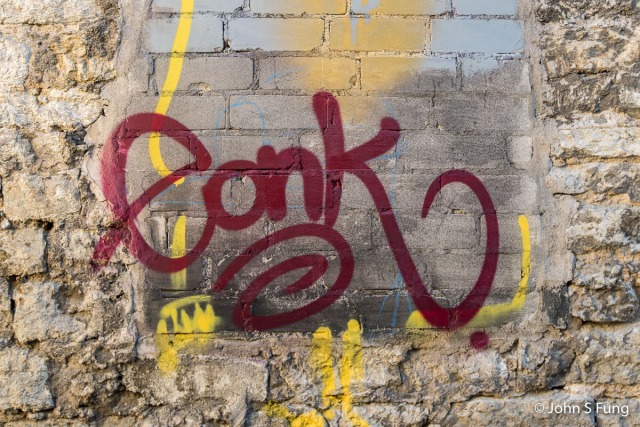

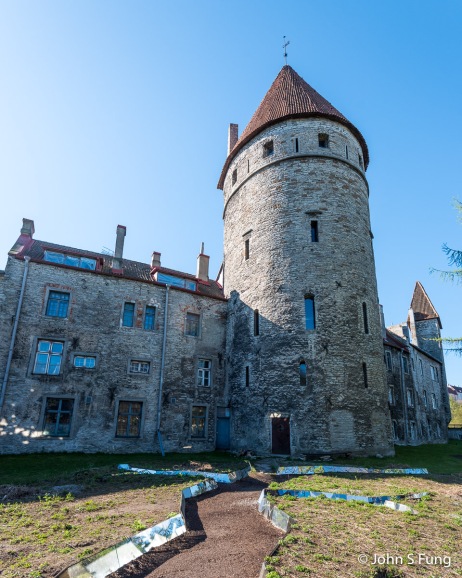
我不確定這是不是Epping Tower。不記得什麼原因,我們沒有去Epping Tower,那裡據說是一個博物館。在這個多層博物館展示中世紀的盔甲和手工藝品,遊客可以免費試穿盔甲。
⇑ I’m not sure if this is the Epping Tower. For some reasons I don’t recall, we did not visit to the Epping Tower where there is said to be a kid-friendly museum. There are display of medieval armor and handicrafts in this multi-floored museum, and visitors are free to try on the armors.


⇑ 從Gömnaasiumi 路/街道外的 Park Tornide Väljak 看到的舊城牆。 ⇓從舊城牆內看到的景色。
⇑ The Old Town Wall as seen from Park Tornide Väljak, outside Gümnaasiumi Road/street. ⇓ View as seen from inside the Old Town Wall.
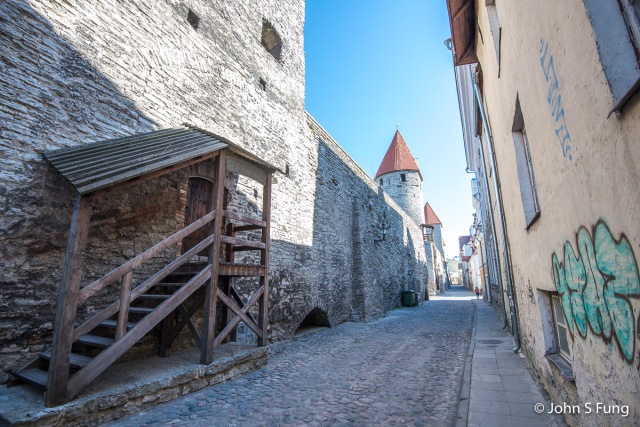
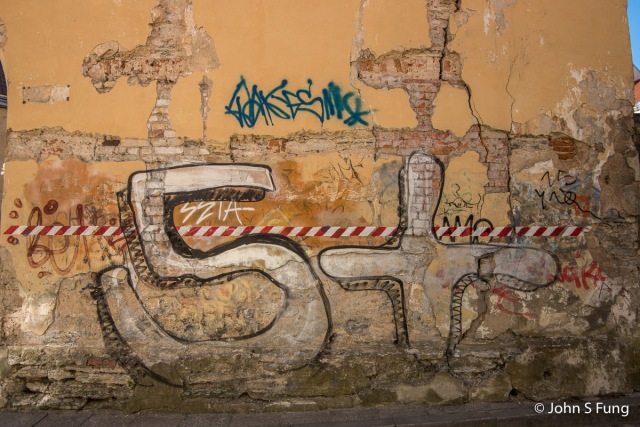
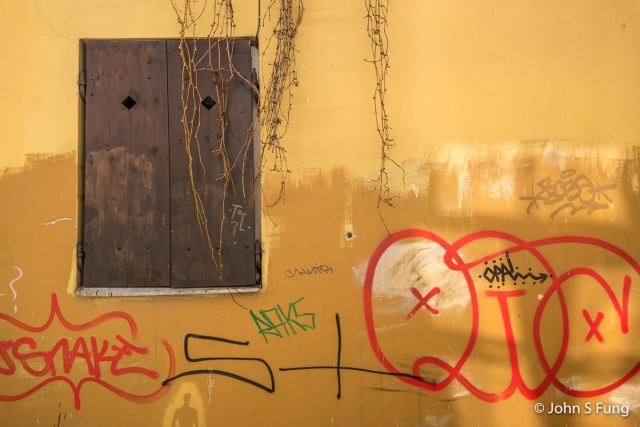
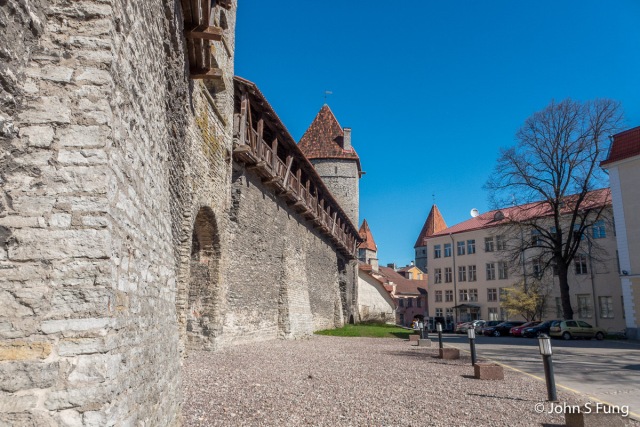
如果我沒記錯,遊客可以在三個不同的地方登上城牆,我們參觀了連接Nunna,Sauna和Kuldjala 塔的這一部分城牆。
If my memory serves me well, tourists can climb up the city wall and tower at three different locations, we visited this portion of the wall connecting Nunna, Sauna and Kuldjala towers where medieval warriors used to stand guard against invaders.
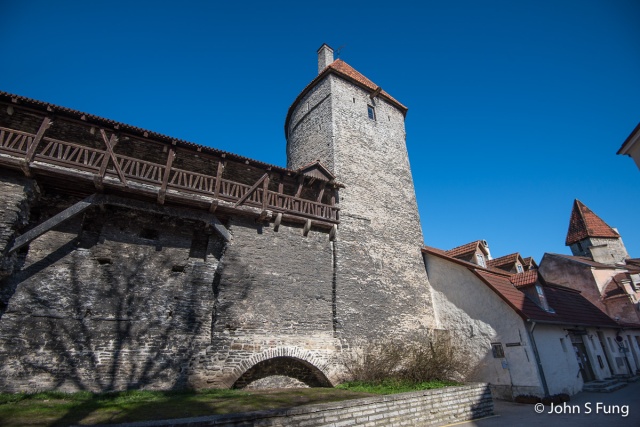

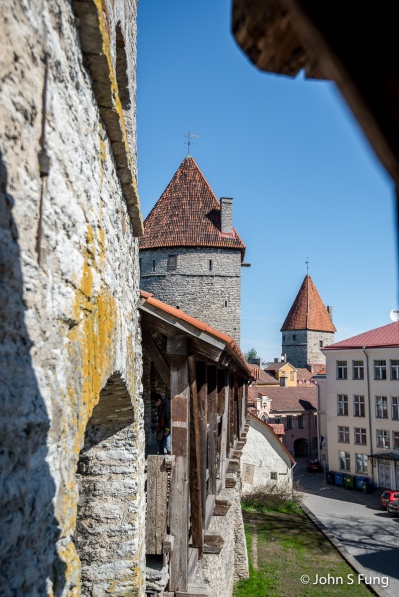
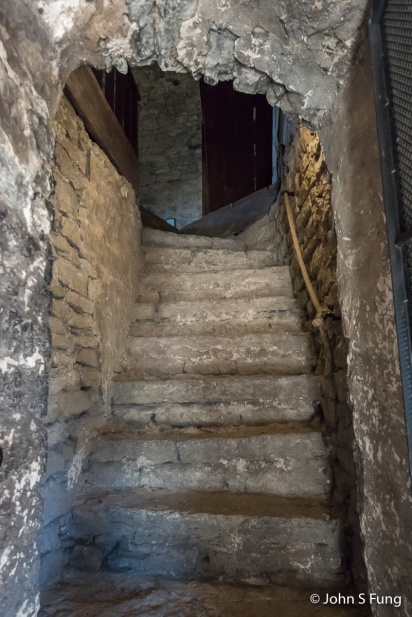
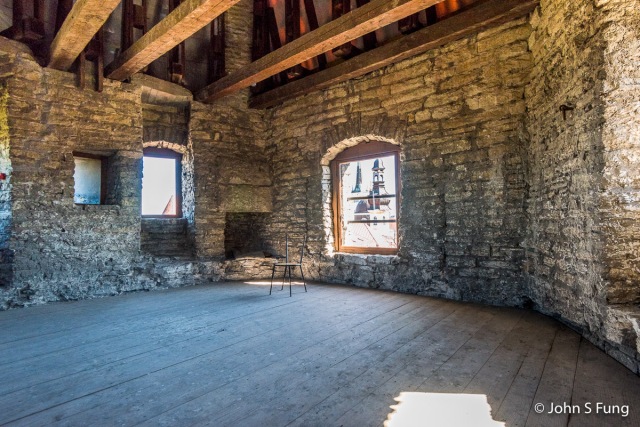
Looking out from the Sauna Town, the tower and the dome of the Church of the Transfiguration of Our Lord and the tower of St. Olaf’s Church are in sight.

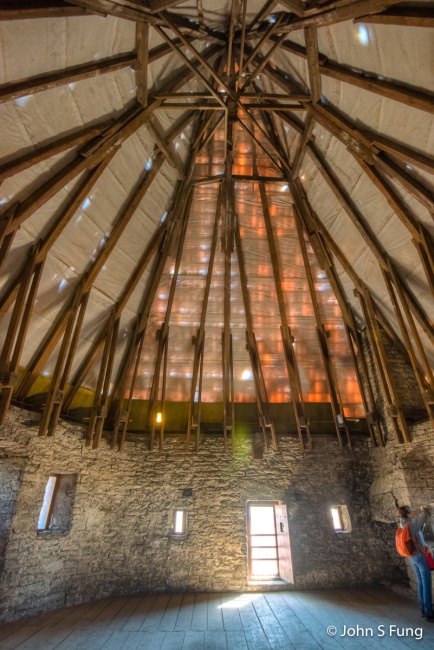
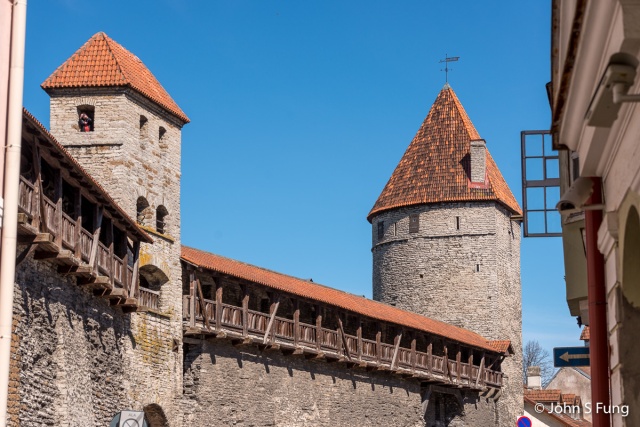
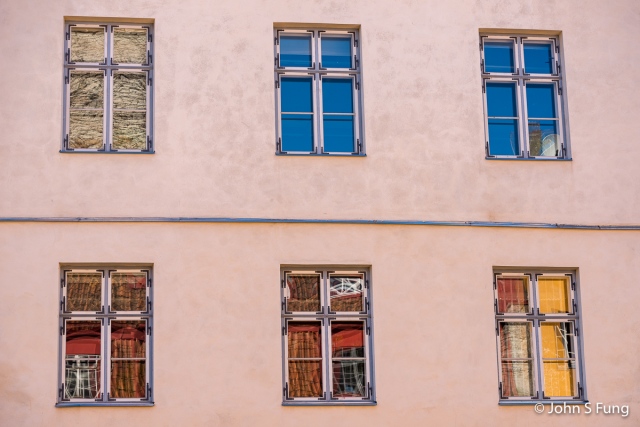
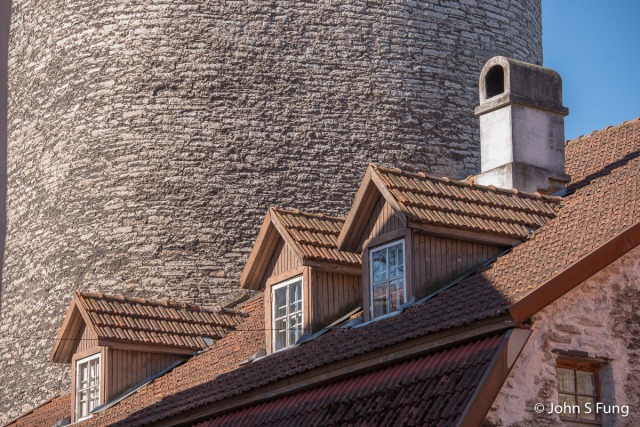
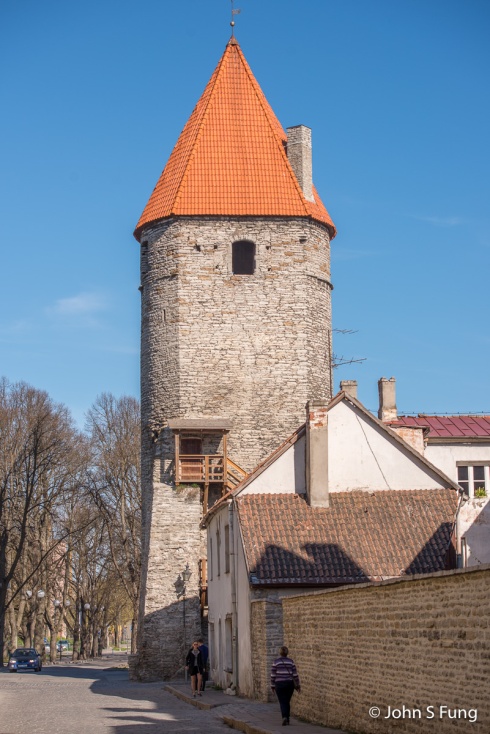

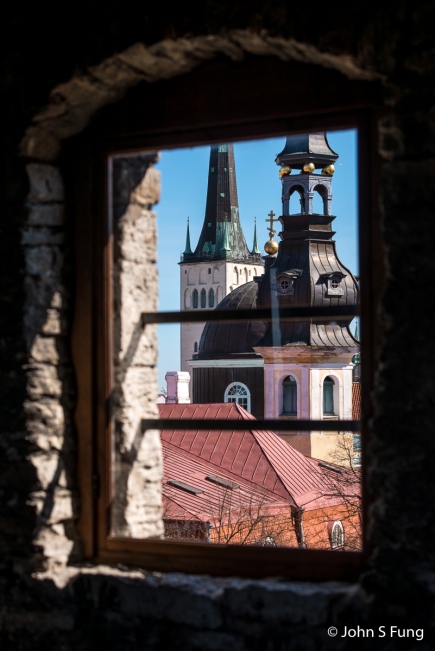
從Sauna Tower望向東北方,Church of the Transfiguration of Our Lord 塔樓和教堂的圓頂和聖奧拉夫教堂的塔樓都入眼簾。
Looking out from Saunatorn (Sauna Tower) to the northeast, the tower and the dome of the Church of the Transfiguration of Our Lord are at the front and the tower of St. Olaf’s Curch is on the back.
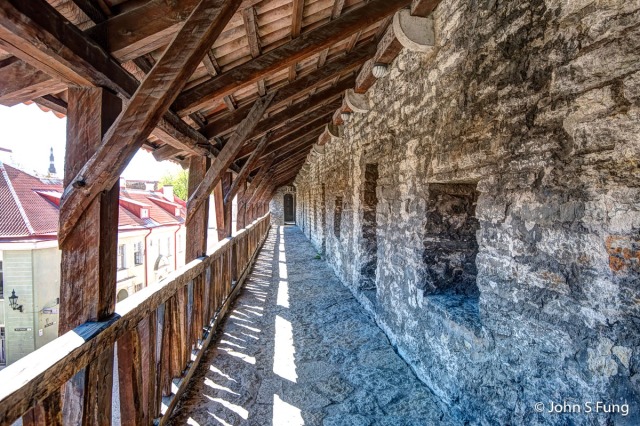
⇑⇓ The beautiful walkway on top of the town wall.


⇑ Viru Gate。這對美麗的塔樓高高聳立在Viru街的入口處,是從東邊抵達Tallinn的第一瞥。這些塔在19世紀80年代在Viru門的拆卸中倖存下來。
⇑ Viru Gate. This beautiful pair of towers stands tall at the entrance to Viru Street, they would be the first glimpse visitors get when arriving from the east. These towers survived the pull down of the Viru Gate in the 1880s.
Visited: 2016.5.6

Wikipedia: A supermoon is a full moon or a new moon that approximately coincides with the closest distance that the Moon reaches to Earth in its elliptic orbit, resulting in a slightly larger-than-usual apparent size of the lunar disk as seen from Earth. Wikipedia – Supermoon
超級月亮是滿月(或新月)與近點月同時發生的近點朔望月。這是描述月球在橢圓軌道上繞著地球公轉,行經近地點之時,同時又在日地聯線上的通俗名詞,並非天文學的專業術語。 維基百科 – 超級月亮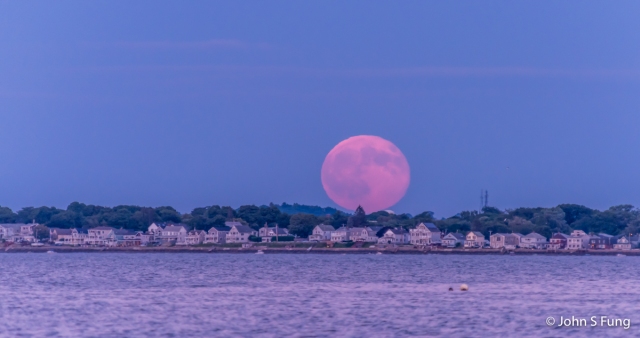

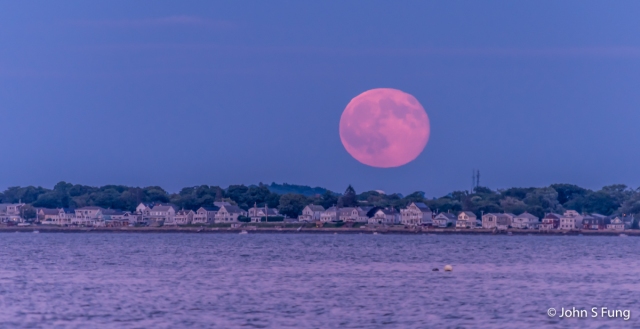
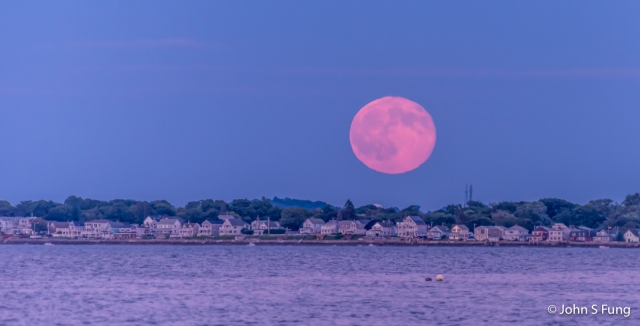
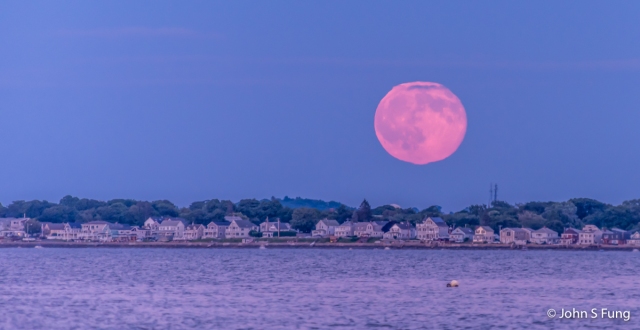
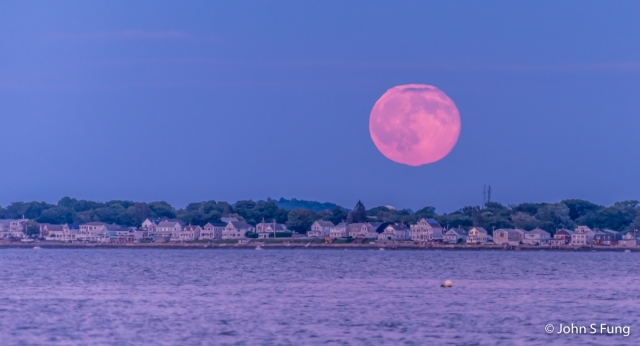
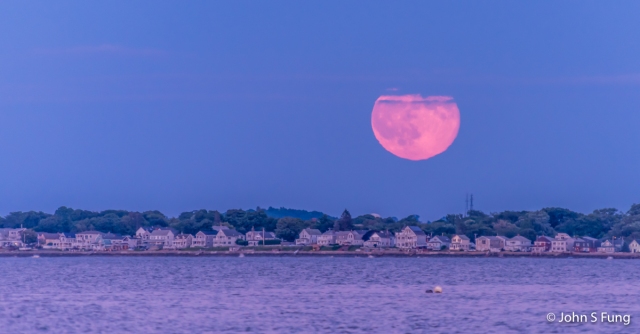

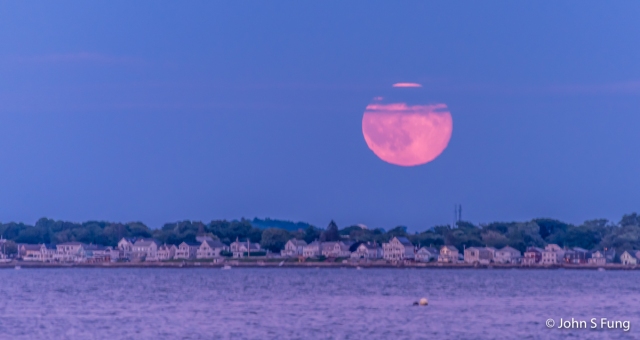

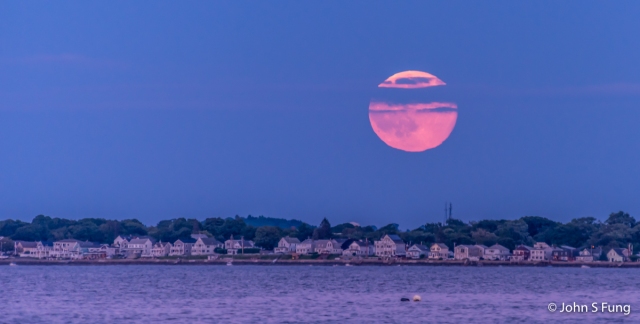
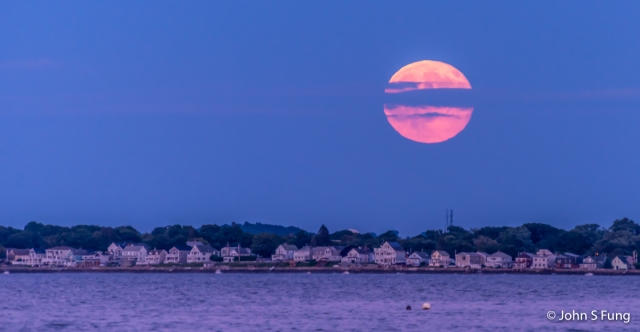
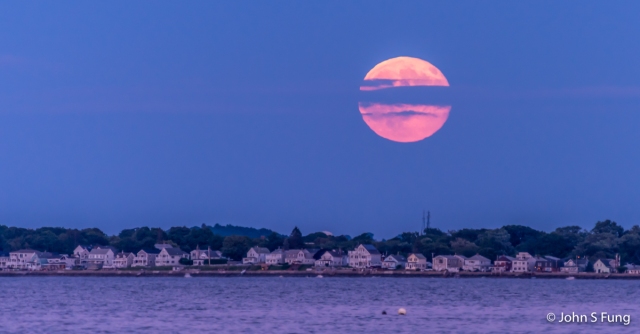


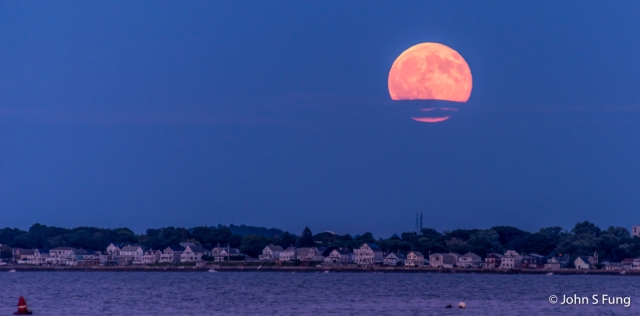
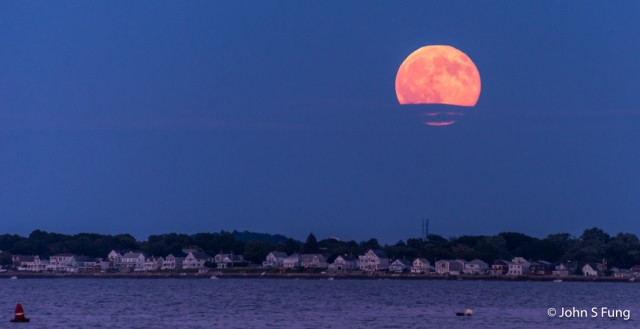
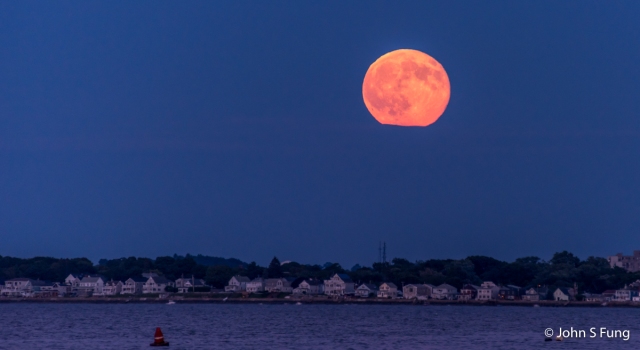
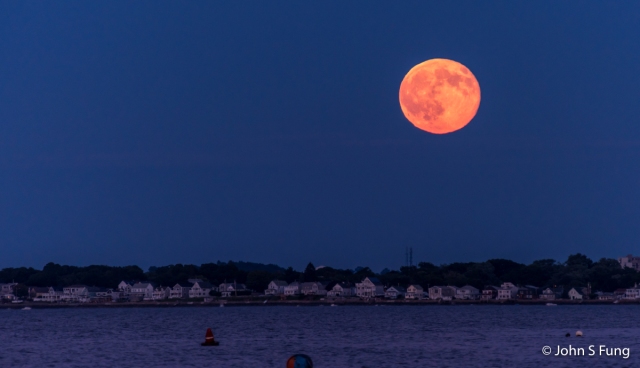
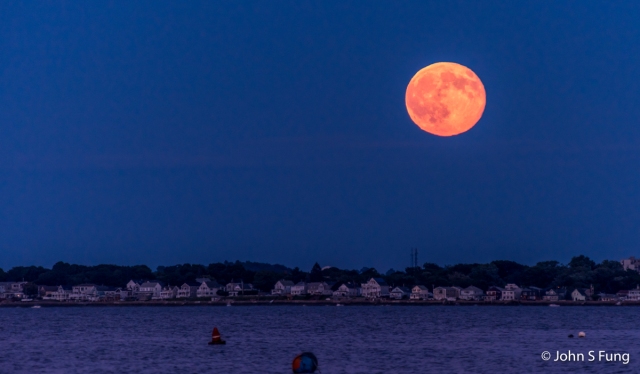
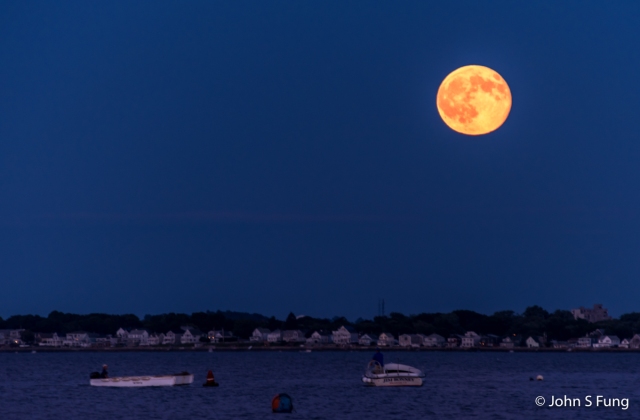

2015.7.31 Wollaston Beach, Quincy, MA
Note: 這一輯相的稿子在2015年五月就寫完,不知為何,一直未發放,今日清理,才發現有幾個舊稿。這輯應該是2014京都之秋的完結篇了。有點混亂,看官莫怪。The draft of this post was finished in May 2015, and somehow got stuck in the draft box for years, I can’t recall any reason for this. Anyhow, this is the finale of the 2014 Autumn in Kyoto series.
曼殊院門跡 Manshuin Monzeki, Kyoto
六年前第一次來曼殊院賞楓, 印象深刻。寺内庭院枯山水不錯, 加上用園外樹木和後面山頭作為「借景」, 相當不俗, 只是室內不能拍照, 遊人又多, 提着相機和鞋, 人擠着人穿堂入室,有點狼狽。反而院外曼殊院道大門附近和對面 的天滿宫境內的水池和銀杏很有看頭。這次遊罷圓光寺安步走過來, 不想再進寺内去擠, 就在外圍賞楓。今年到訪的日子比上一次剛晚了一星期 (11/20), ,可惜銀杏已是相見恨晚, 楓樹有早落的, 有「楓」華正茂的, 更有些還在變色中的。葉落的多, 天滿宫境內的水池浮着頗多枯葉, 有點髒兮兮的, 真的是今非昔比。下午三點了, 除了在圓光寺內偷吃了两口麵飽外, 未進午餐, 饑腸轆轆, 尤幸天滿宫境內有小吃店, 來碗熱烏冬, 人又活過來了。
I first came here in 2008, one sunny afternoon in mid-November, I was so impressed of the colors created by the late afternoon sun when the leaves were being viewed against the light, I decided to come here in more or less the same time of the day in November 2014. I got what I had come here for, the same bright orange-red color. However, I was about a week late, the ginko trees had already passed their peak, not many leaves left hanging. The pond between the temple and the restaurant was somehow only half filled, a lot of leaf debris floating on the water and lying on the ground, not exactly the scene I would love to have. For the interior of Manshuin, the garden is good, and there are a number of nice paintings and artifacts inside, however, photography was prohibited, and I would have to carry my own shoes dangling along side with my cameras and bag…. I had no initiative to get in.
As its name, Manshuin Monzeki (曼殊院門跡), implies, Prince Ryosho was once the abbot of the temple. The temple was first founded in the 8th century and was located near Mount Hiei. It was renamed as Manshuin in 1108 and moved to its current location in Edo period.
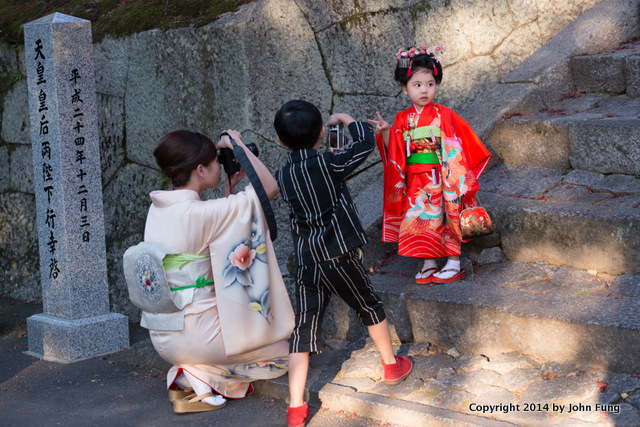
左碑記天皇伉儷行幸曼殊院, 2012. The stone on the left marks the royal visit of Japanese emperor and empress to Manshuin in December 2012.
************************************************************************************ 鷺森神社 Saginomori Shrine, Kyoto
從曼殊院往下走, 約七、八分鐘路程, 來到一小徑口, 轉右入小徑, 通過陰陰的大樹, 就會來到鷺森神社。 神社附近頗多大樹, 如果光線配合, 銀杏和紅楓都不錯。看罷, 順着清幽的参道往下走, 不一會就到白川通, 可乘巴士回四条或京都站。 如再往前走, 就是叡山電鉄修學院站, 可乘電車到四条通。
After our visit to Manshuin, we walked down to Shirakawa Dori (白川通) to catch a bus back to Shijo. On the way, we visited Saginomori Shrine. It is only a five minutes walk, however, the pavement that leads to the shrine is not easy to find, I would recommend to have a Google map in hand. There are a lot of maple and ginko surrounding the shrine. From there a gentle downhill road leads the way through the neighborhood with a couple of turns, we reached Shirakawa Dori with no difficulties. You can take a bus to Shijo or Kyoto Station from there. If you prefer, walk a bit further, you will reach Shugakuin station of Eizan electric railway main line where you can take a train to Gion Shijo.
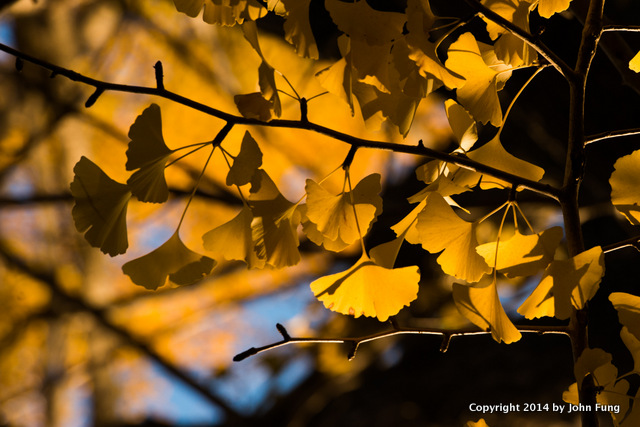
LINKS:
Wikipedia – Manshuin (English)
Visited 2014.11.20
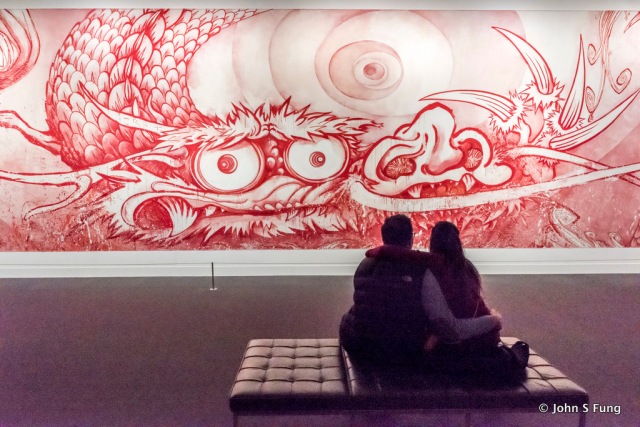
Finally, I have finished editing most of the photos of my Japan, Thailand and Myanmar trips. Now it is time to take care of some “old” photos. This bunch of photos were taken in an exhibition in Museum of Fine Art of Boston in February 2018. To me, his art work is very “refreshing”. He was majored in Nihonga (Japanese painting), however, he’s able to package elements in Nihonga and manga with western art concept, like Zeitgeist ( “spirit of the age” or “spirit of the times”) into a postmodern art movement called superflat.
終於把日本賞桜行、緬甸曼谷行的照片基本上處理完,可以整理一下堆積的「老照片」了。這一輯是年頭在波士頓美術館看到的村上隆美展。他是日本美術家,超扁平藝術的始創人。他揉合日本畫、漫畫,Zeitgeist 的原素而創出「超扁平」藝術,而且能把作品用於商品上。
Wikipedia : Takashi Murakami (村上 隆 Murakami Takashi, born February 1, 1962) is a Japanese contemporary artist. He works in fine arts media (such as painting and sculpture) as well as commercial media (such as fashion, merchandise, and animation) and is known for blurring the line between high and low arts. He coined the term “superflat“, which describes both the aesthetic characteristics of the Japanese artistic tradition and the nature of post-war Japanese culture and society, and is also used for Murakami’s own artistic style and that of other Japanese artists he has influenced. Wikipedia – Takashi Murakami
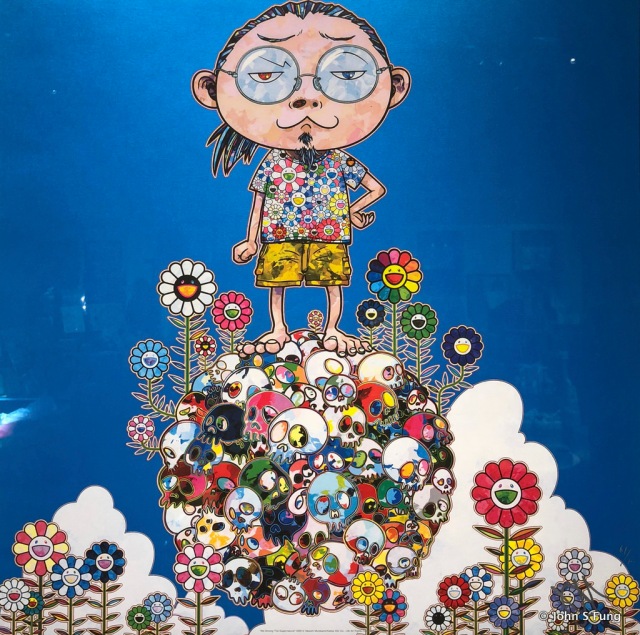
村上隆(1962年2月1日-)是一位日本藝術家。他是受日本動畫和日本漫畫影響而專注於御宅族文化和生活方式的後現代藝術風格——超扁平(Superflat)運動創始人。其靈感源自眾多古怪的浮世繪藝術家和金田伊功於1983年發布的動畫作品《Harmagedon》。維基百科 – 村上隆
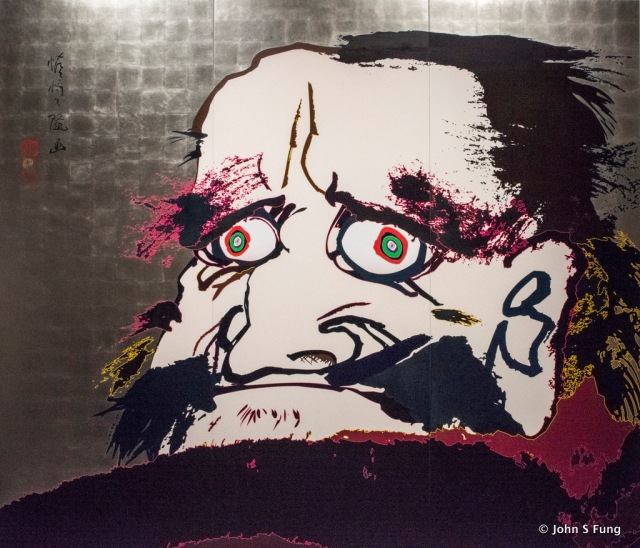
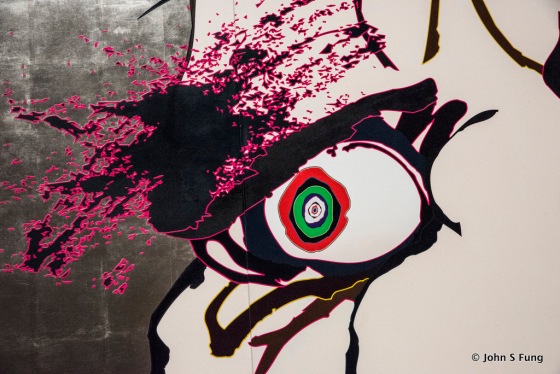

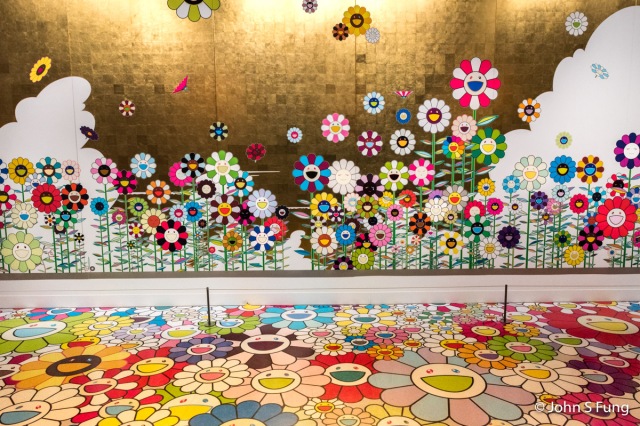
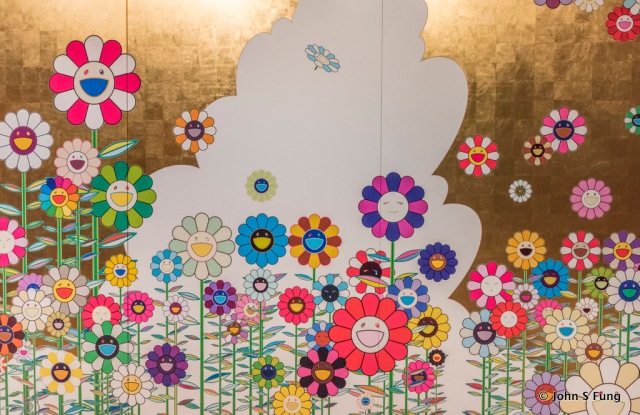
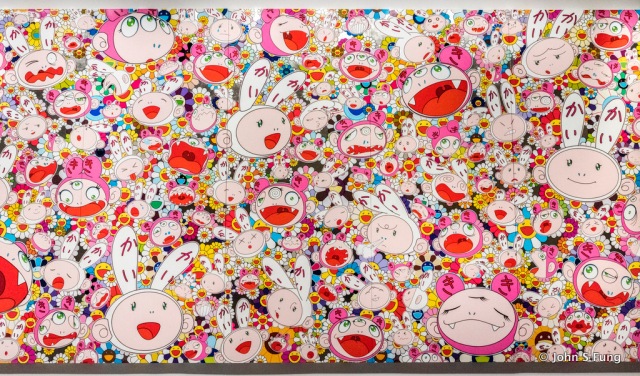


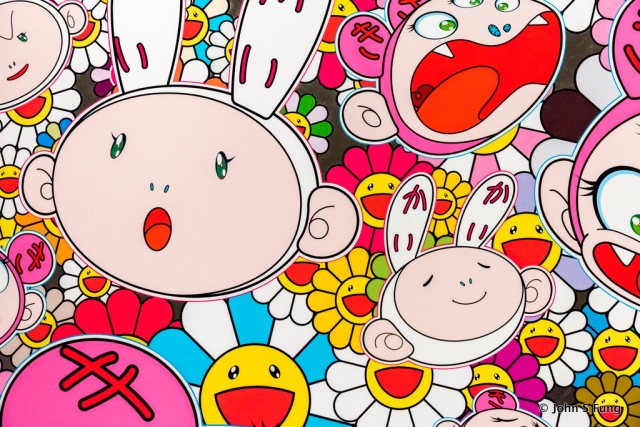
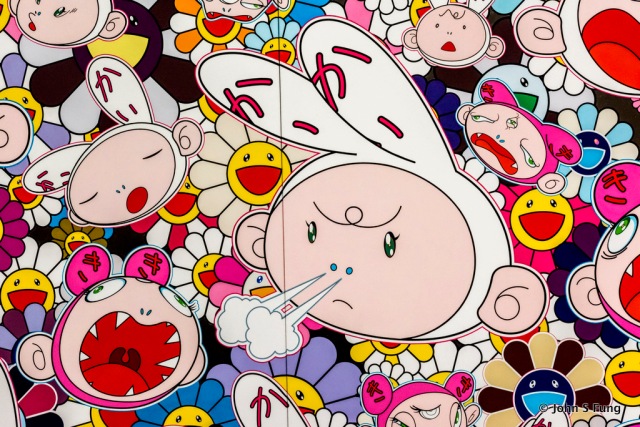
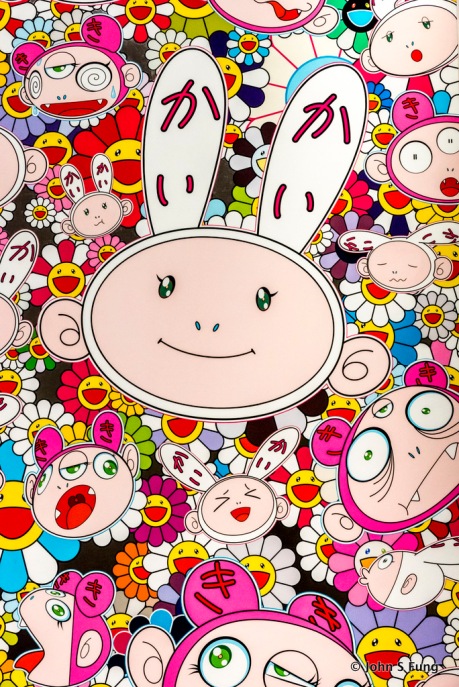
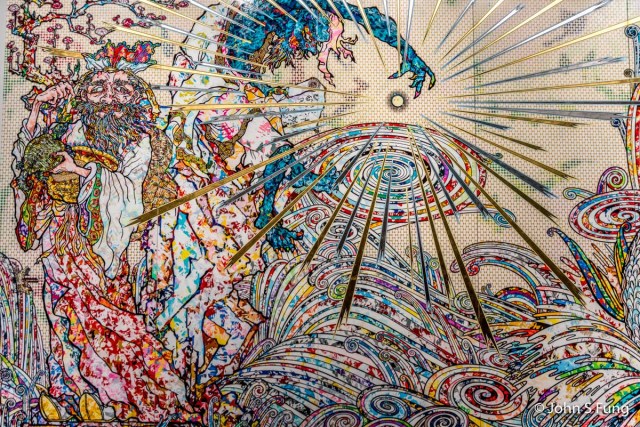
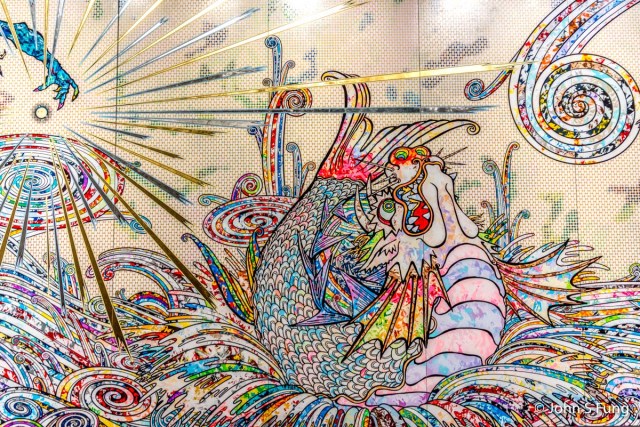
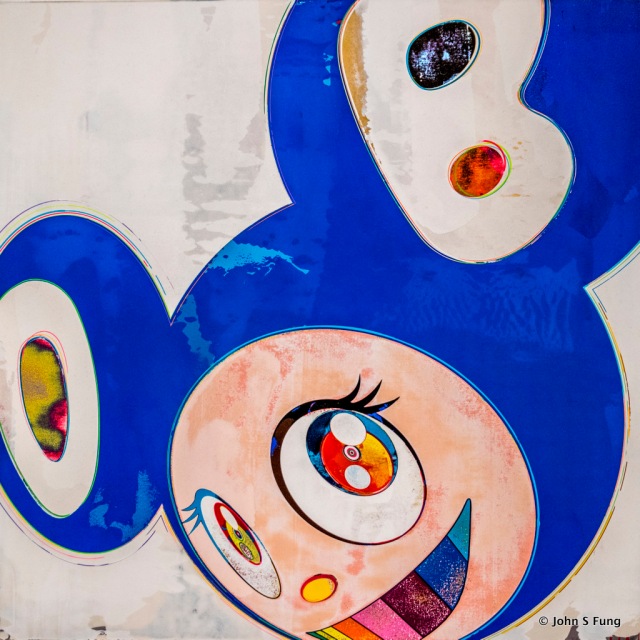
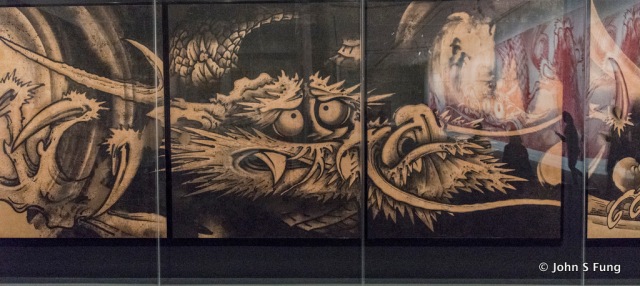
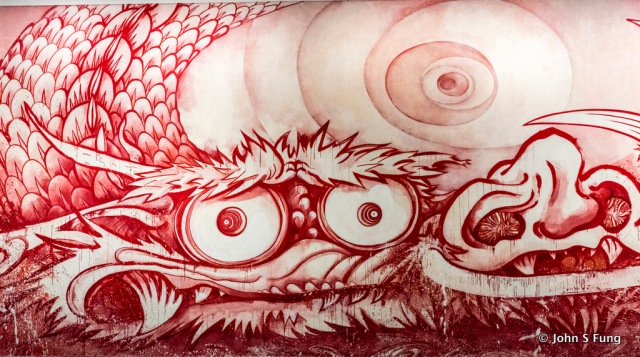
Visited 2018.2.3
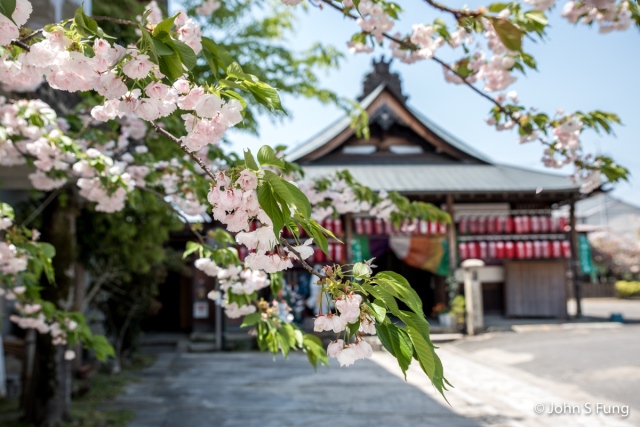
What brought us to Injoji (いんじょうじ, 引接寺) or Senbon Enmado (千本ゑんま堂, or 千本閻魔堂, せんぼんえんまどう) was its Fugenzo sakura (普賢象の花 Prunus lannesiana). a variety of satozakura (サトザクラ, 里桜). It is said that Fugenzo sakura is a late blooming sakura, usually bloom in the last third part of April. In other words, it is the finale of the sakura show in Kyoto. We didn’t expect to see it because 4/13 was our last full day in Kyoto, it would be too early for it, however, 2018 season bloomed 7-8 days earlier than usual, Fugenzo sakura became in bloom on 4/13.
Injoji is not a popular tourist spot, but is a famous spot among sakura peepers for Fugenzo sakura. This monastery has a few names, it is known to the locals as Senbon Enmado (千本ゑんま堂/千本閻魔堂). Injo (引接) refers to the Buddha who leads our way after life to the western Buddhist heaven, ji (寺))= monastery. ゑんま=閻魔= Enma is the deity who is the King of the Hell. Enma-do refers to the main hall that is dedicated to Enma.
As for the name of this variety of sakura, 普賢象 refers to the ride of Smantabhadra, bodhisativa who rides on a white elephant. Online info says “この桜は中央の雌しべが葉化していて, その変異が象の鼻に見えることから” , because of the pistil of the double flower mutated to have a leafy appearance which resembles the nose of an elephant. To Japanese in the old days, the most well known elephant is Smantabhadra’s white elephant ride, that’s why it was named 普賢象.
這篇是2018京都賞桜行的完結篇。在原來的行程規劃中,引接寺 (Injojiいんじょうじ)不在我們的行程上,因為引接寺以普賢象桜著名,而普賢象桜的開花期一般在四月下旬,我們四月十四日就離開京都了,所以預計是看不到的了。只是2018京都的桜花季早開了7-8天,4/13那天,普賢象桜已是滿開,加上是日天朗氣清,坐地鐵到鞍馬口站,信步走到引接寺,中間也經過雨寶院去看看那𥚃的御衣黃桜。
對京都人來說,引接寺多稱為千千本ゑんま堂/千本閻魔堂,主要供奉閻魔 (閻魔=ゑんま= Enma),即我們稱閻羅王的神祇。主堂中供奉巨大閻魔像,印象中好像有玻璃門擋著,無法看清。引接寺並無弘偉的建築,參拜的人也不多。我們來看的普賢象桜,普賢象指普賢菩薩的坐騎白象。原因是這品種桜花滿開時,花心轉紅,而且雌蕊突出,似象鼻。日本不産象,過去, 最為人熟悉的象就是普賢菩薩的坐騎,故名之。

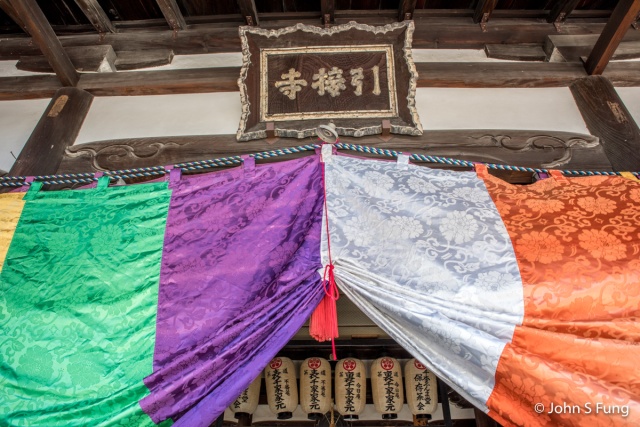

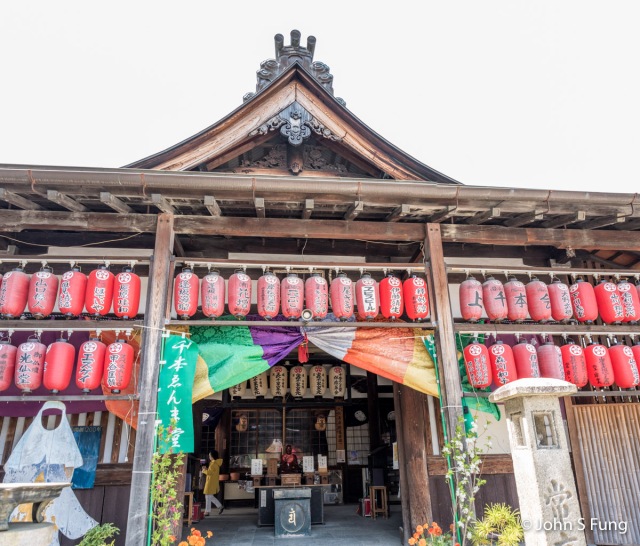
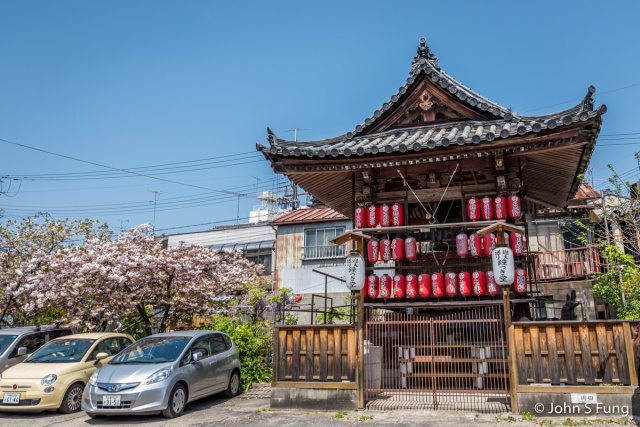
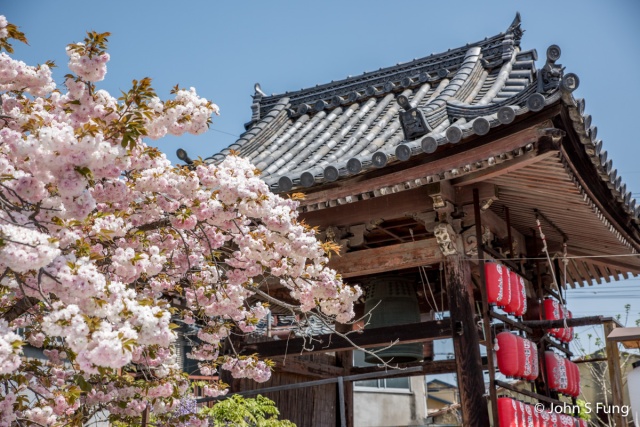


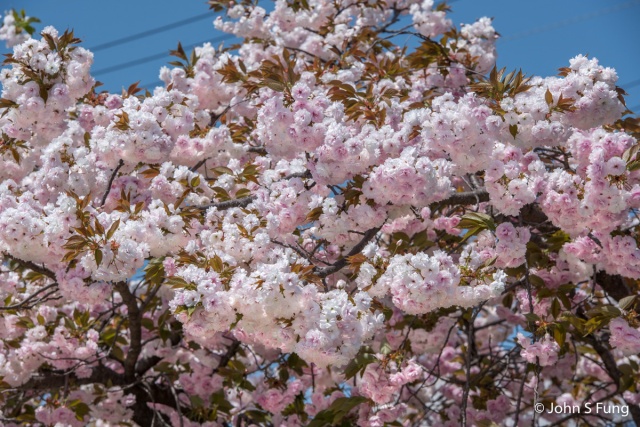
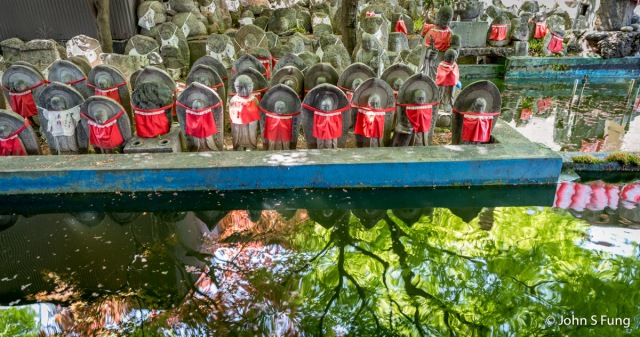


⇑⇓ As seen here, Jizo statues are often carved out of stone and dressed with a small bib, usually red in color, around their necks. It is not uncommon to see Jizo being dressed with hats and robes.
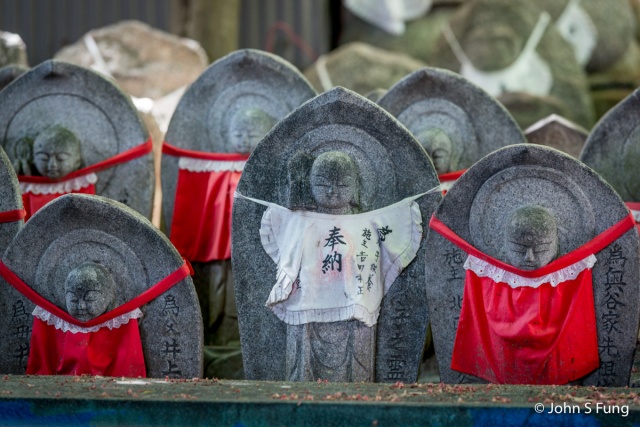
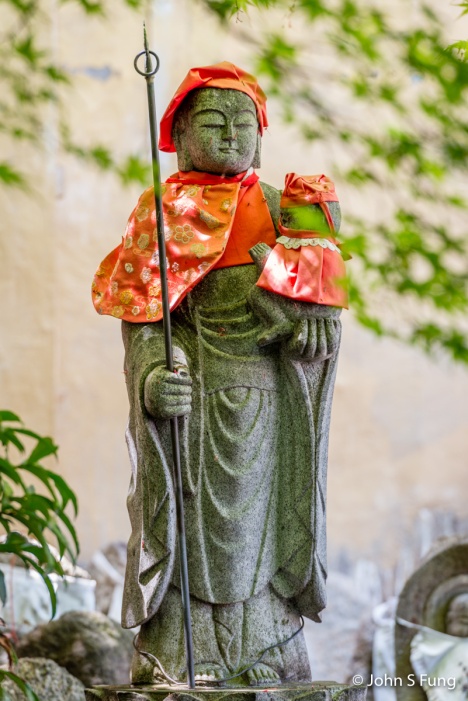
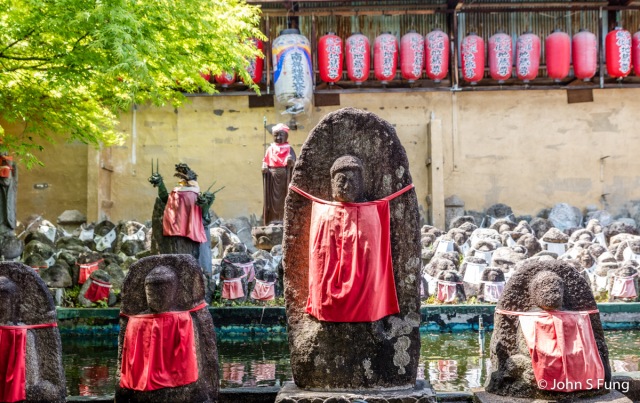
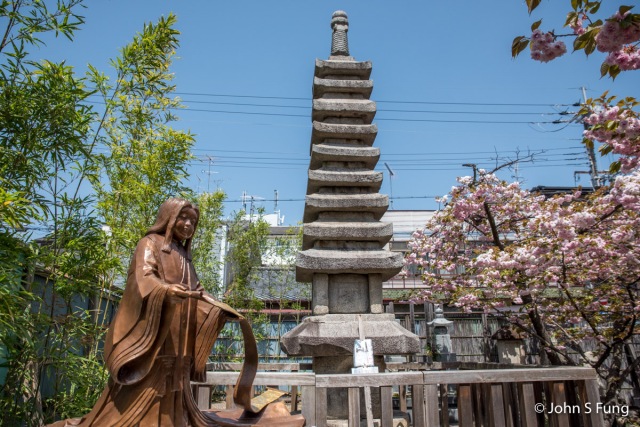
⇑⇓ 石造十重の紫式部供養塔: 紫式部(978-1016?或1031年?),日本平安時代女性文學家。

紫式部, 日本平安時代女性文學家, 創作《源氏物語》。
Wikipedia: Murasaki Shikibu was a Japanese novelist, poet and lady-in-waiting at the Imperial court during the Heian period. She is best known as the author of The Tale of Genji, written in Japanese between about 1000 and 1012.
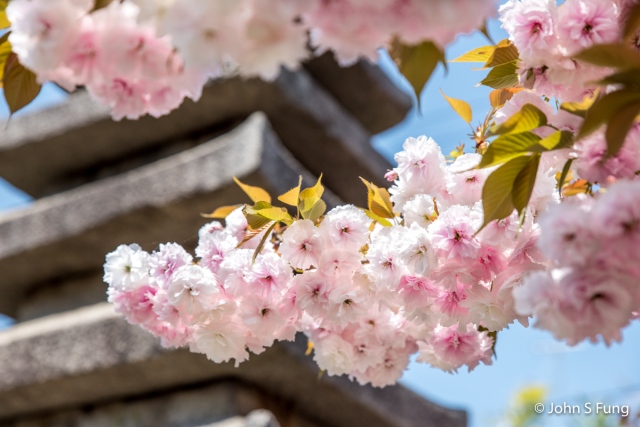
Fugenzo sakura 普賢象の花 (Prunus lannesiana)
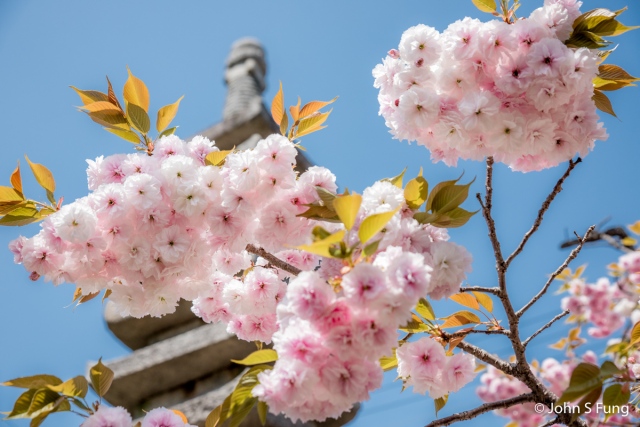
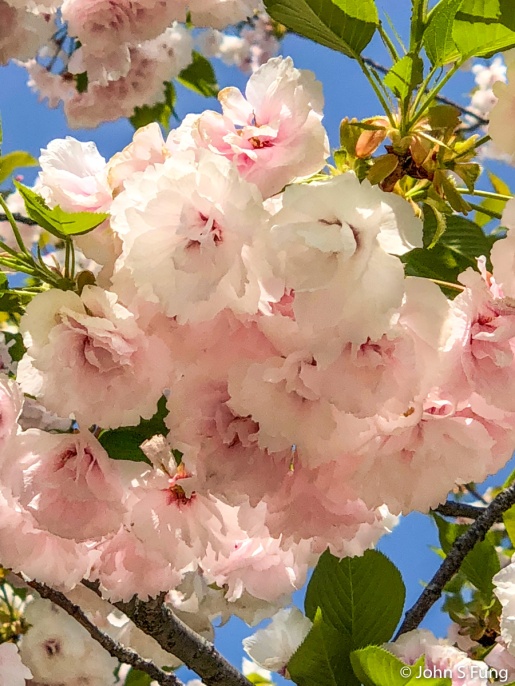


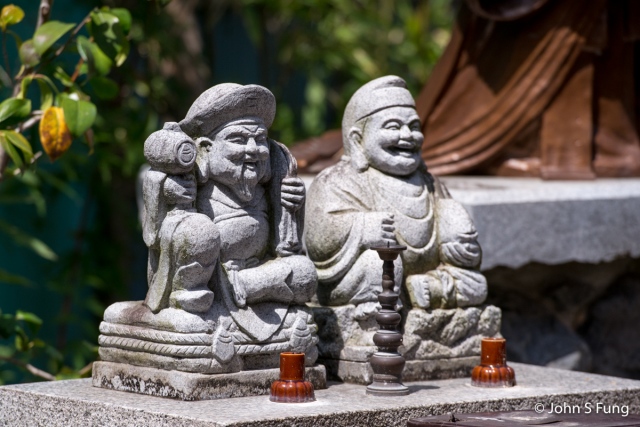
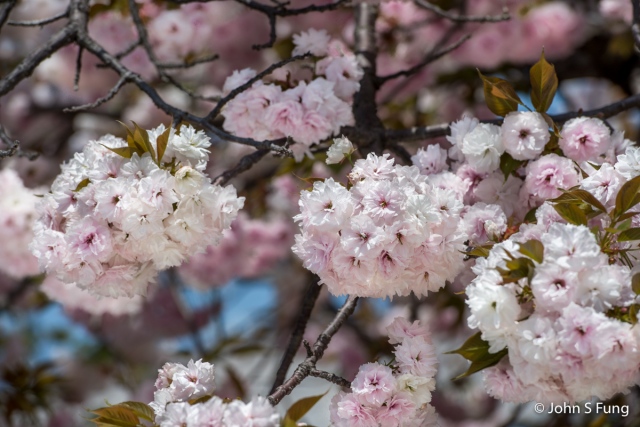


⇑⇓ Trace of the mural of the Scene of Hell (Jigoku e 地獄絵) on the plank wall in the hall of Injoji. It was said that this mural and the statue of 閻魔大王像 (Senbon Enmado) had once shocked the early European missionaries.
⇑⇓ 主殿大堂內一方仍見老舊壁板,上有殘留的舊壁畫,是「地獄絵」的殘跡。據說數百年前,早期抵京的西方傳教士初見此畫,感其震憾力云云。
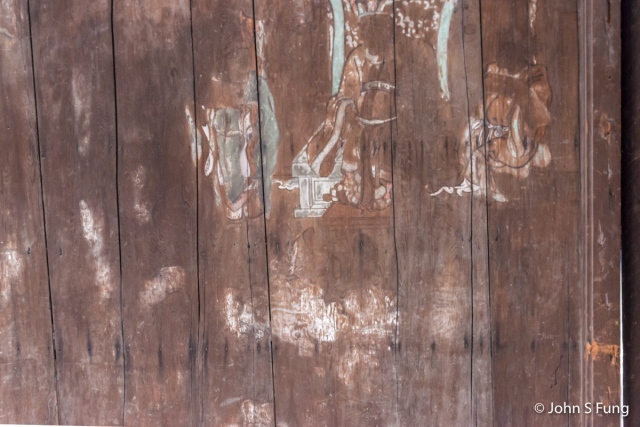
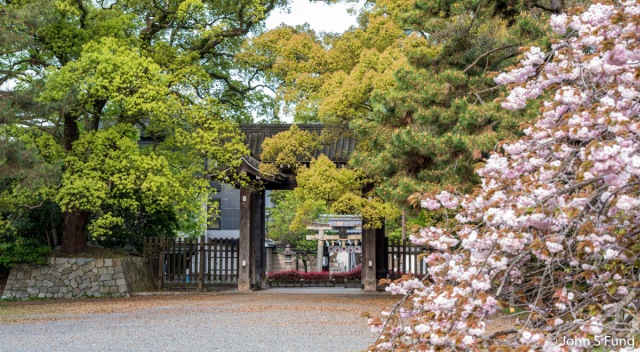
⇑⇑ 下立売御門 Shimodachiuri-Gomon Gate
We stayed in a hotel near Kyoto Imperial Palace or Kyoto Gyoen, so we had the luxury to come here to check out the sakura in early morning or late afternoon. That day was our last full day in Kyoto, and the weather had turned much brighter, we came here for the last look on the sakura of Demizu-no-ogawa (出水の小川). Despite the fact that this year’s (2018) sakura season was a week earlier than average, there were still plenty of sakura in bloom. My conclusion is that, whether you are in town early or late for sakura, Kyoto Imperial Palace or Kyoto Gyoen is a spot not to be missed.
我們住在京都御所附近的酒店,所以沒事就過來看看這裡的桜花。這天是我們在京都的最後一天,主要是去引接寺看普賢象桜。早上天氣轉晴,在出發去引接寺前,先來御所逛逛。京都御所的桜花比網上資料說的還要好,而且由早開到晚開的品種都有,是極佳的賞櫻好去處。

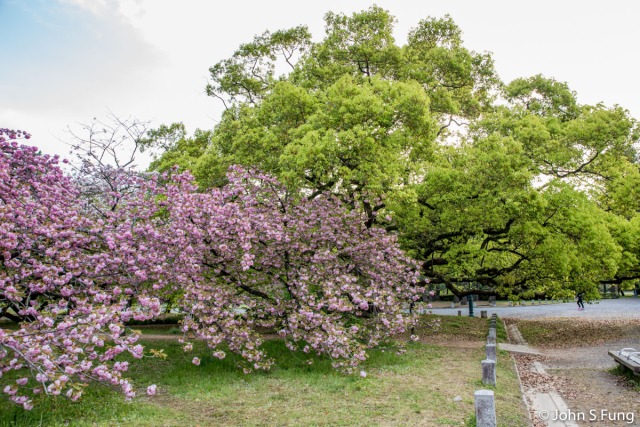
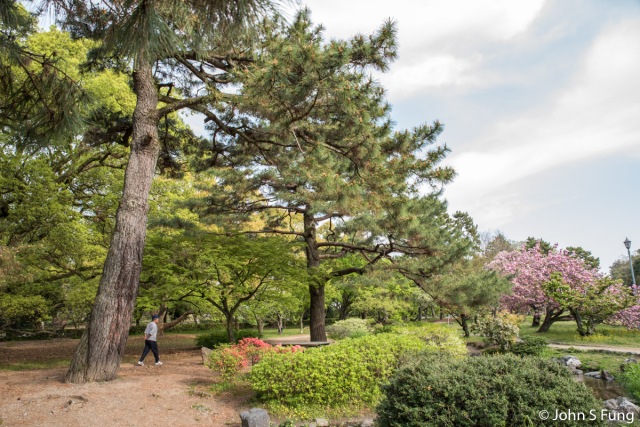

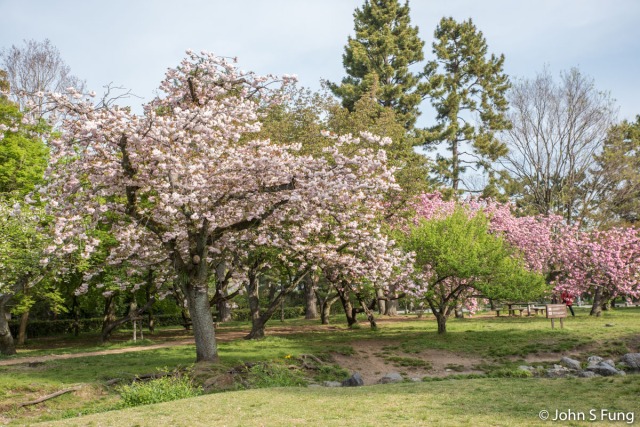
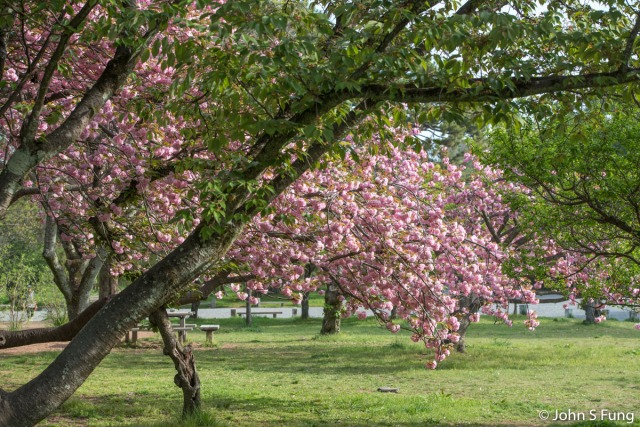
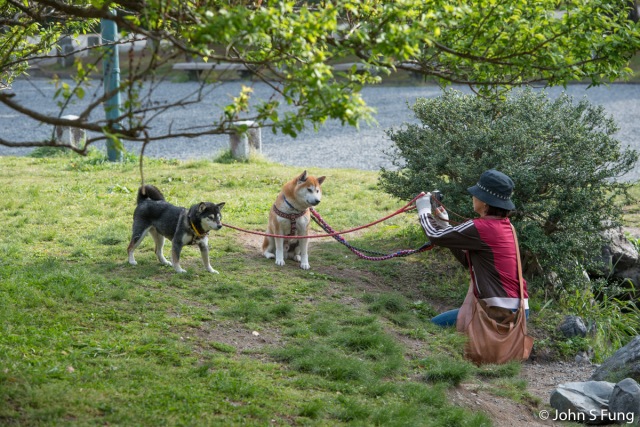
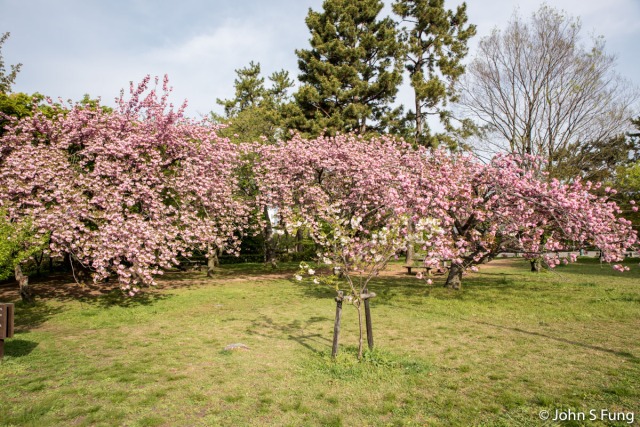

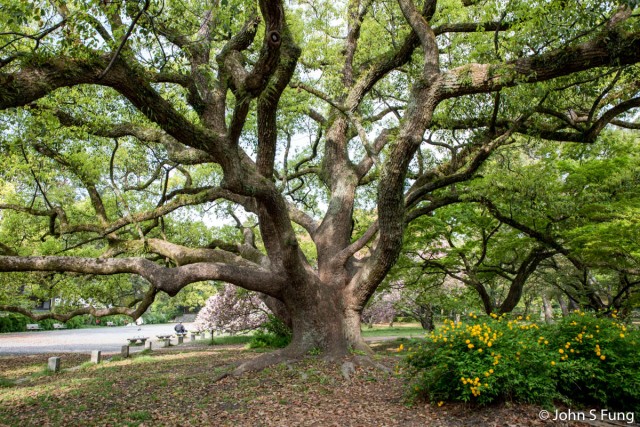

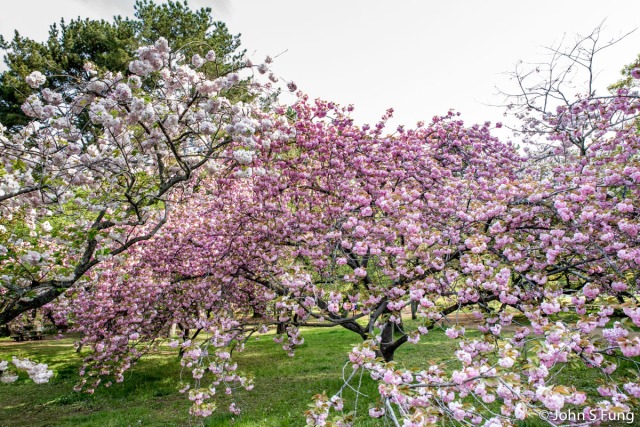

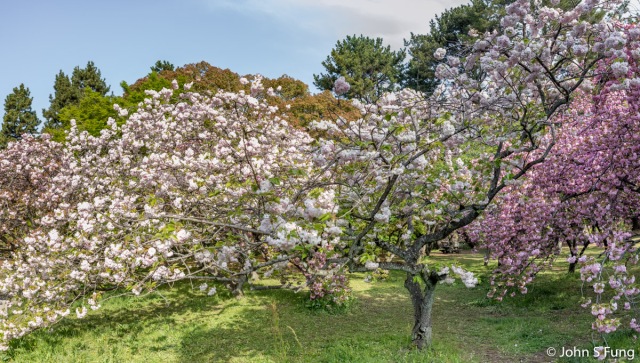
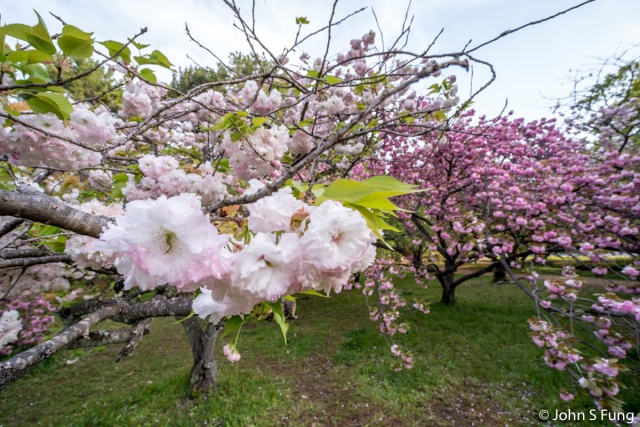


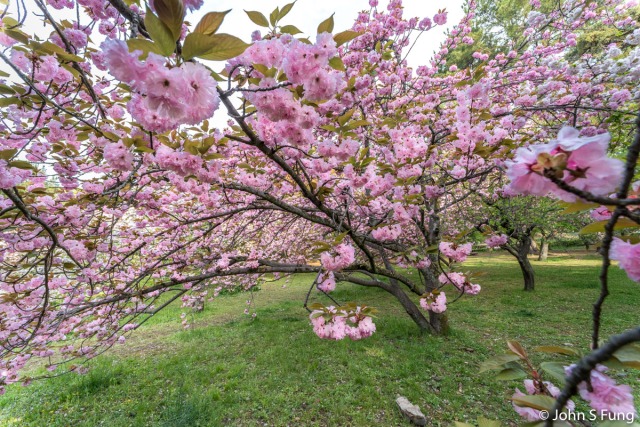
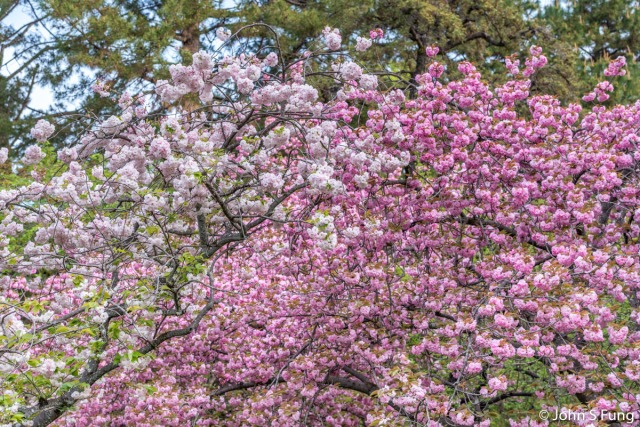
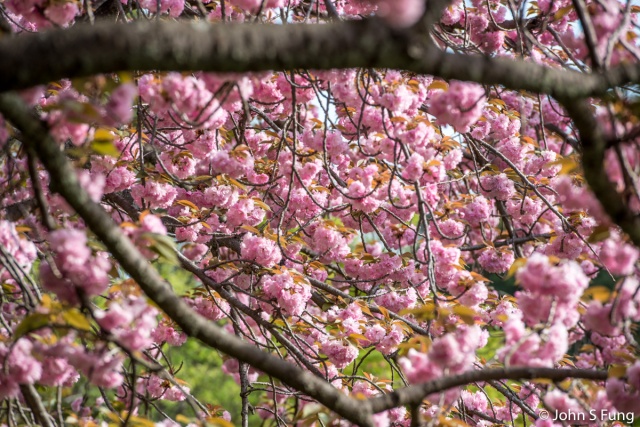
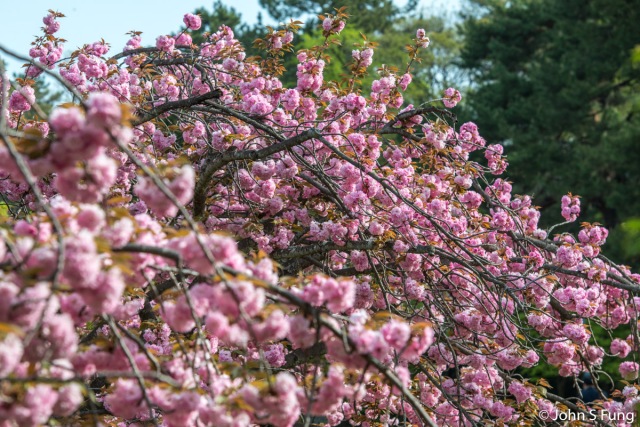
Kanzan variety (?) (カンザン, 関山, 学名: Prunus lannesiana)
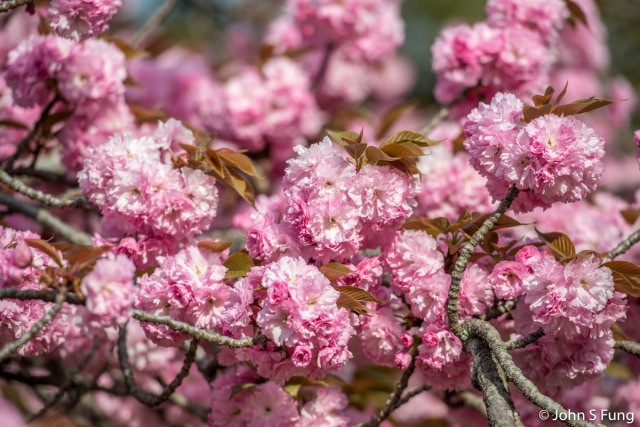
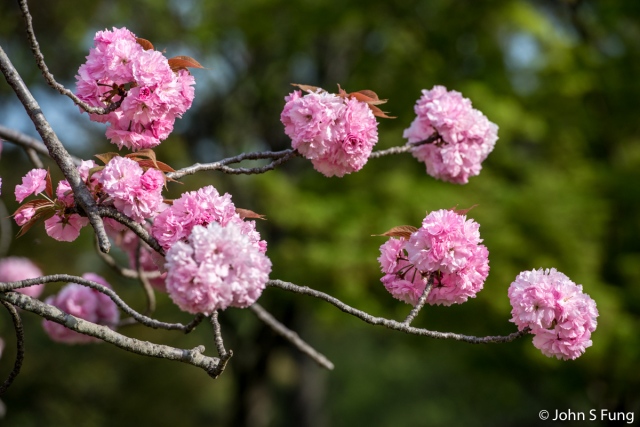
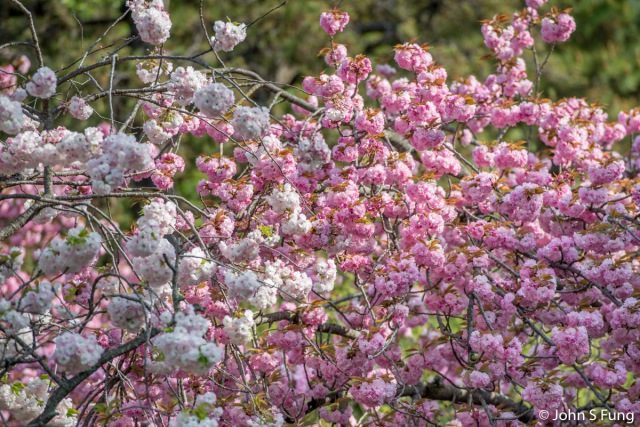
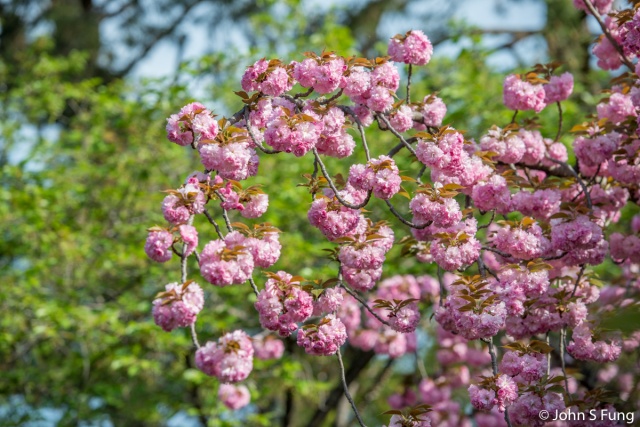
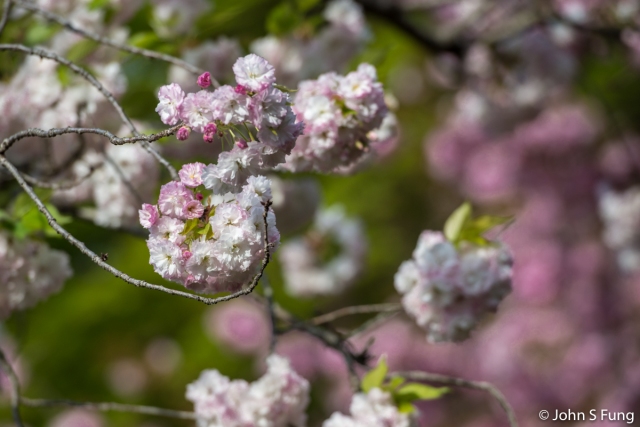

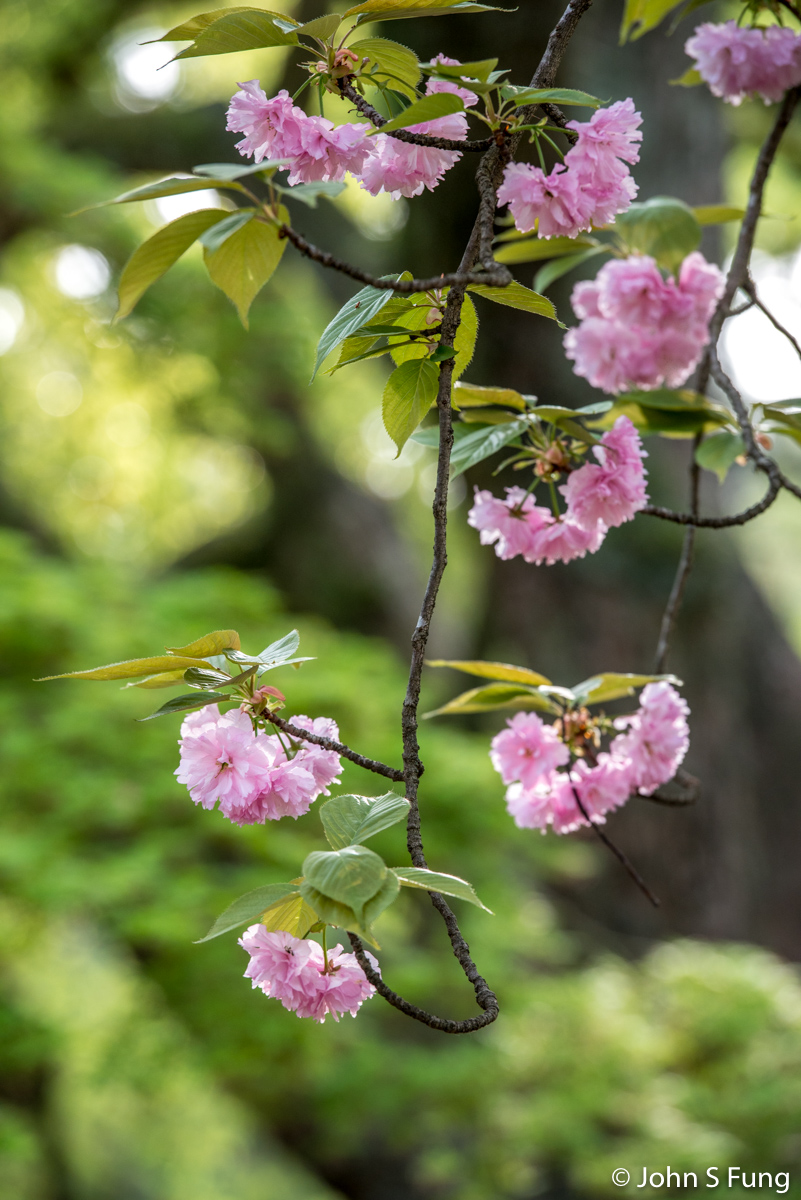
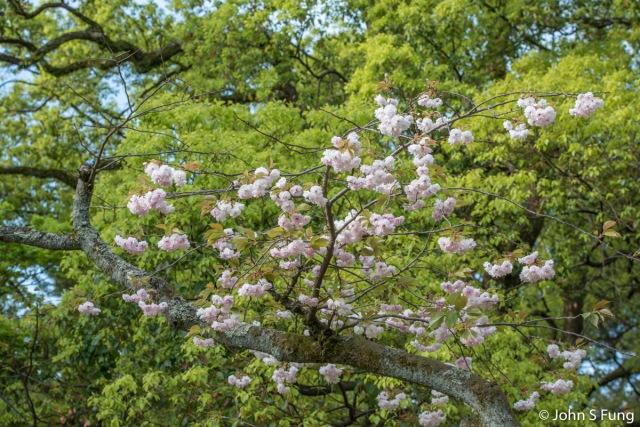
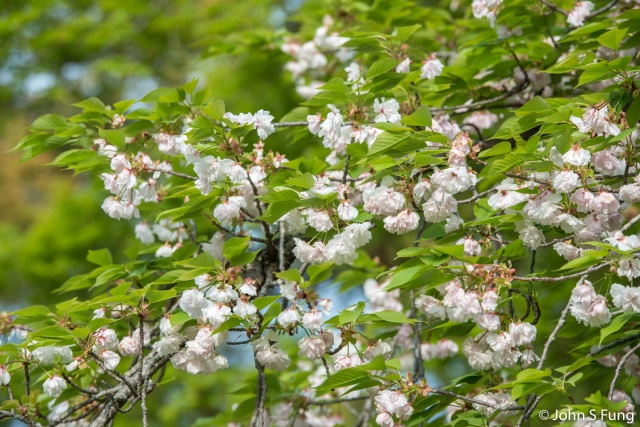
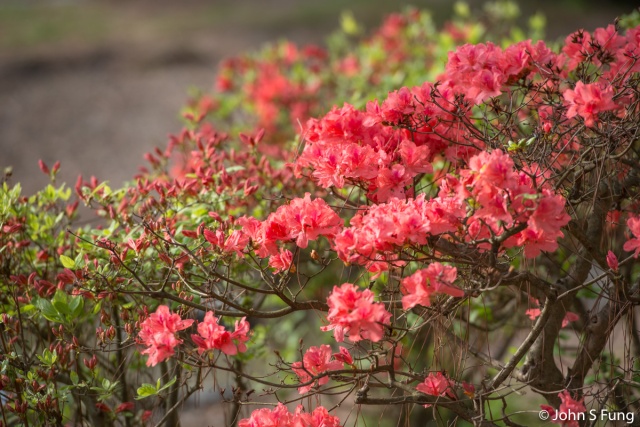
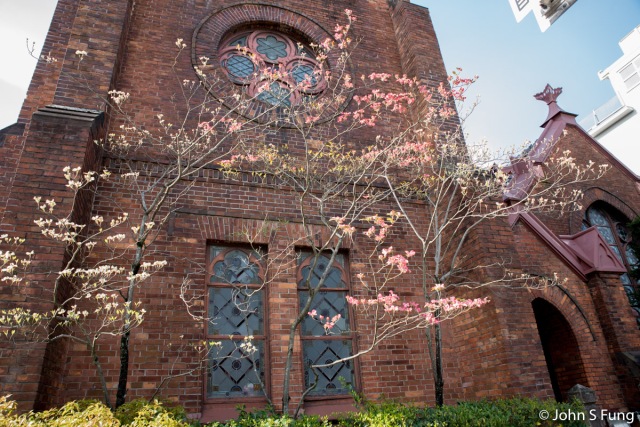
⇑⇑ Dogwood in front of a church across the street of 下立売御門 (Shimodachiuri-Gomon) Gate .
⇑⇑ 下立売御門對面教堂前面的山茱萸。

⇑⇑ Standing on the observation deck of Nara Prefecture Office Building, looking south to the five-story pagoda and Tōkondō of Kōfuku-ji (興福寺). ⇑⇑ 站在奈良縣政府辦公大樓頂樓的觀景層,遠眺興福寺五層塔。
April 12th, checked the weather first thing in the morning, mainly a cloudy day, but better than the day before, the percentage of precipitation was predicted to be low, so we headed out to Nara. We’ve been to Nara many times, our original plan was to take pictures of the cherry trees planted along the Saho River, however, the earlier than usual sakura season messed up our plan, so we made Yoshiki-en our destination for that day. After that, I couldn’t help but walked to Saho River to check out the cherry trees.
早上起來,天色仍然沒有太好,但說是不會下雨,所以就去奈良走走。早先原來計劃是要到佐保川拍兩岸滿滿的桜花,但也因桜花早開而錯過了。今日來主要是去看吉城園,以前來都想去那裡看看,但陰差陽錯, 都沒去成。最後,奈不住,也還去了佐保川看看,了個心願。
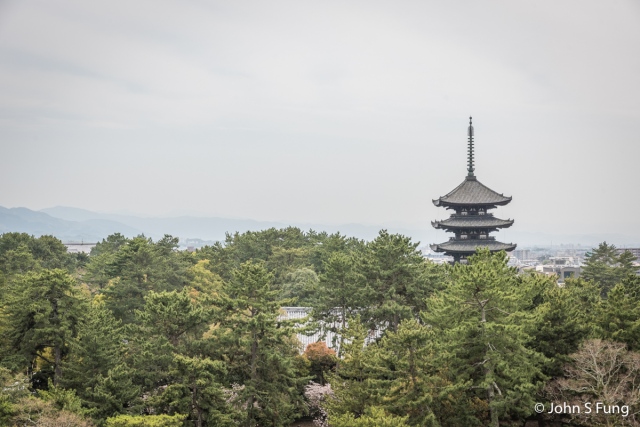
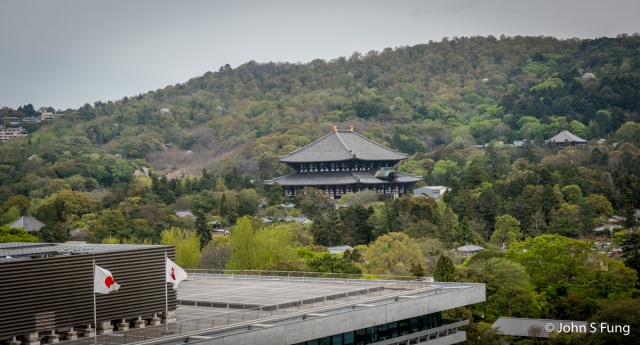
⇑⇑ Looking to the East: Daibutsuden (Big Buddha Hall), Todaji (東大寺). ⇑⇑ 向東望向東大寺大佛殿。
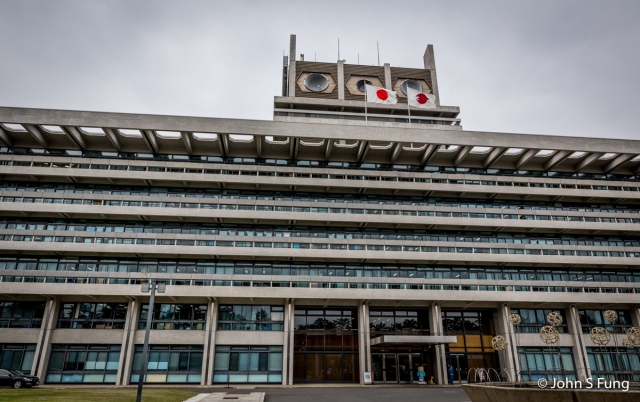
⇑⇑ Nara Prefectural Office Building is located just a stone’s throw away from Yoshiki-en. The west side of the top floor of this building is a canteen which offers a panoramic view of the city of Nara. The canteen is open to public, including tourists like us. Above the canteen, there is an observatory deck where one can have an almost 360 degree view of the city.
⇑⇑ 這𥚃就是奈良縣政府辦公大樓,頂層有一食堂,妙的是對外開放,也歡迎遊客到那𥚃用餐,食堂在西面,有北、南、西三面無礙景覌。食堂再上一層,是屋頂陽台,中央有高一層的觀望台,免費供人使用。

⇑⇑ A monk on his alms round. 近鐵車站前的化緣僧人。
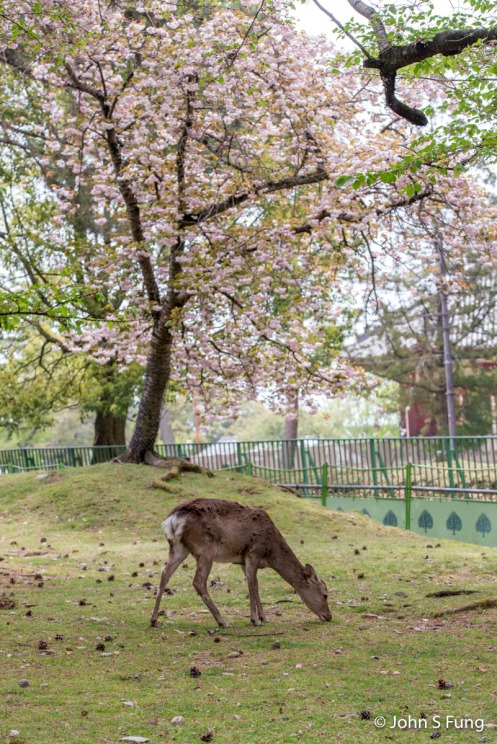
⇑⇓ One of the few cherry trees still in bloom. 少數還在開化的桜花樹。

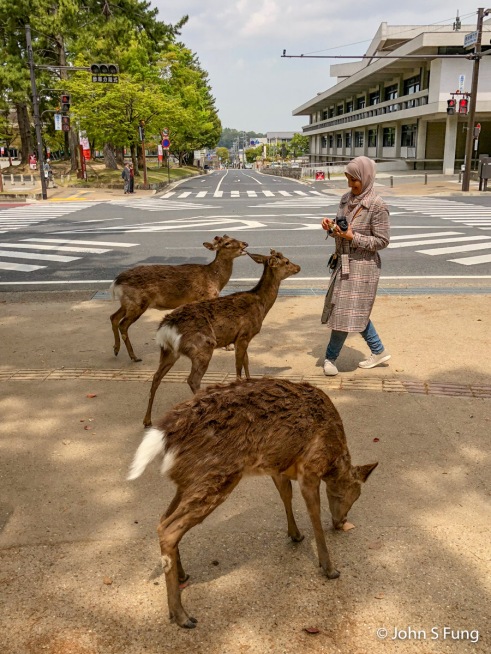
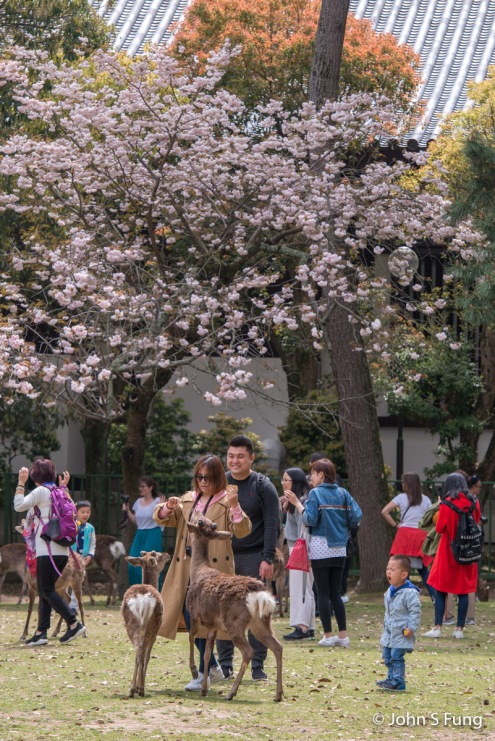
*************************************************************************************

Wikipedia: Yoshiki-en (吉城園) is a Japanese garden in Nara. Adjacent to Yoshiki-en flows the Yoshiki River (宣寸川 or 吉城川), celebrated in the Man’yōshū. According to an old plan of Kōfuku-ji (興福寺古絵図), the site was occupied until the Edo period by one of its branch temples, Manishu-in (摩尼珠院). The gardens have been open to the public since the end of the Shōwa period.
吉城園在江戶時代原為摩尼珠院用地,至昭和時代開放供公眾遊覧。園內有三不同主題之庭院,池之庭、苔之庭和茶之庭。
There are three gardens in Yoshikien: a pond garden, a moss garden and a tea ceremony garden. So, a visit to Yoshikien provides the opportunity to see three different variations of Japanese gardens in one spot. 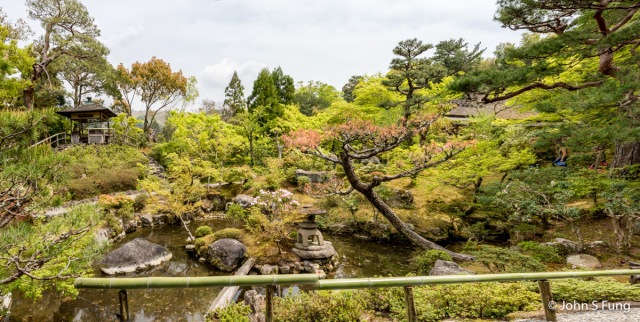
The Pond Garden 池之庭( 池の庭)
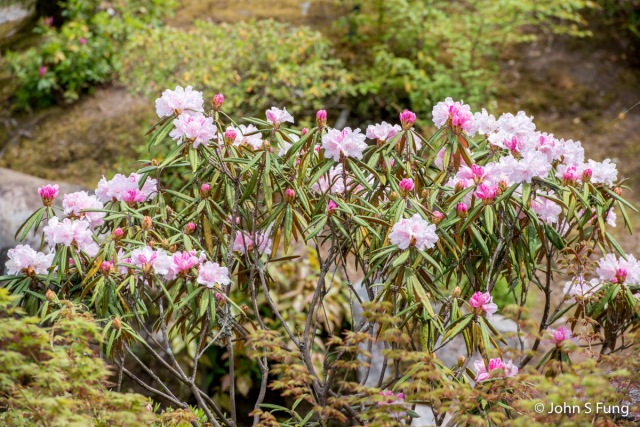

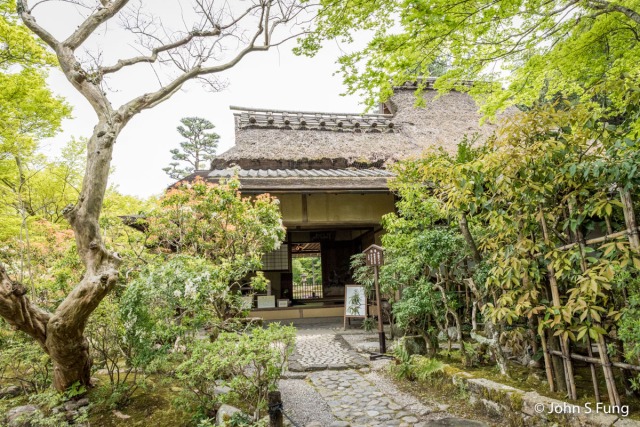
The Tea House. 離れ茶室, 芽葺之屋頂
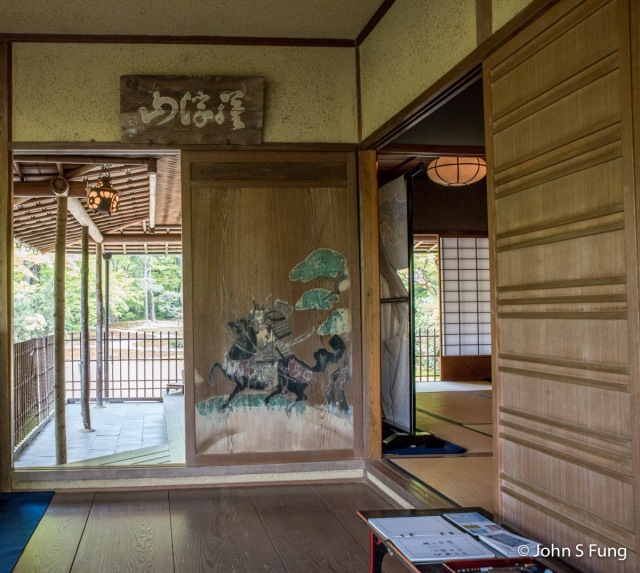
Written on the tablet above the door of the teat house, Rafusan, which refers to a mountain located in Guandong Provence, China, where there was a legendary huge cave suitable for meditation to become a celestial being. Painted on the door is a horse-riding warrior.
茶室的門上繪有騎馬武士圖,而門上扁額書有「羅浮山」,旁有説明指出是指廣東省的羅浮山,山上有山洞宜練仙云云。
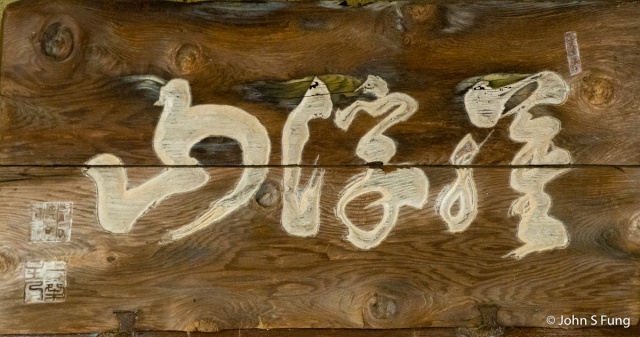
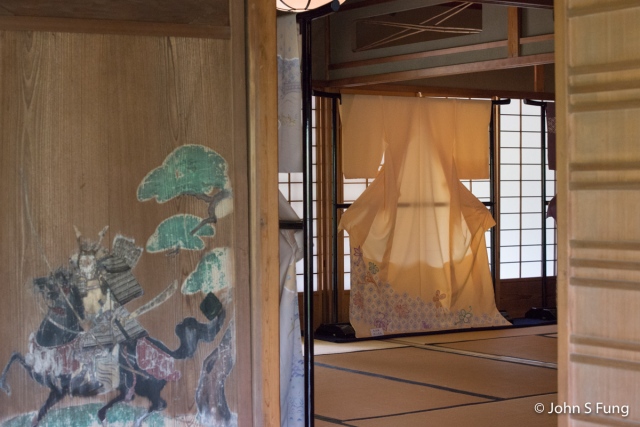
During our visit, the tea house was having an exhibition of kimono, however, only for invited guests.
我們入園的時候,茶室正舉辦和服的展覽,可惜不對外公開。


The Moss Garden 苔之庭(苔の庭)

The Tea House, as viewed from the moss garden. 離れ茶室, 芽葺之屋頂
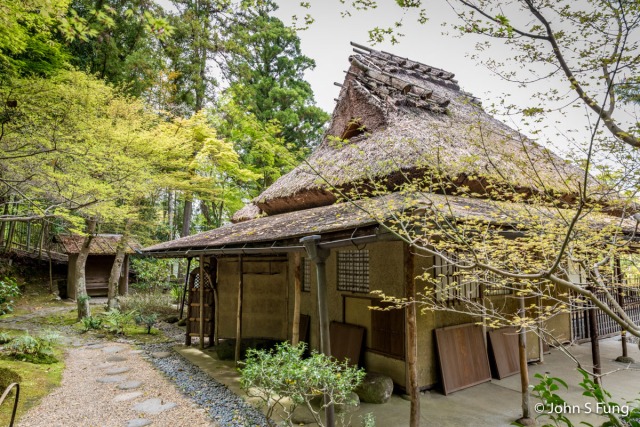
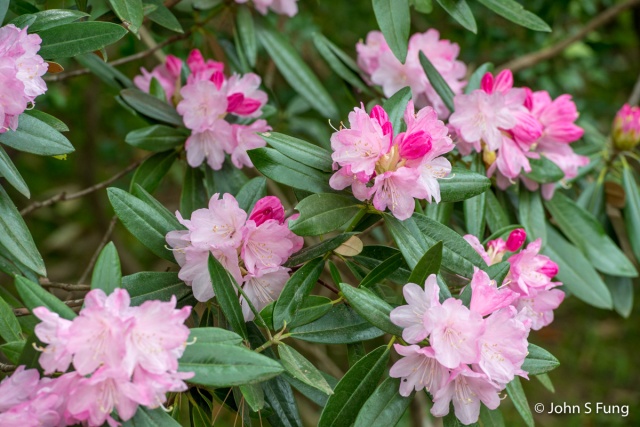
Rhododendron or azalea 杜鵑花


Camellia Garden (or Tea Ceremony Garden) : I guess we have missed the bloom of Camellia (normally in January to March). This garden is said to be suitable for tea ceremony. There was no Camellia flowers or sakura blossoms left, however, dogwood was taking over the center stage.
茶花之庭(茶花の庭/茶道の庭),此庭內植有茶花,應該已過花期(1-3月),反而園內的山茱萸正盛開。
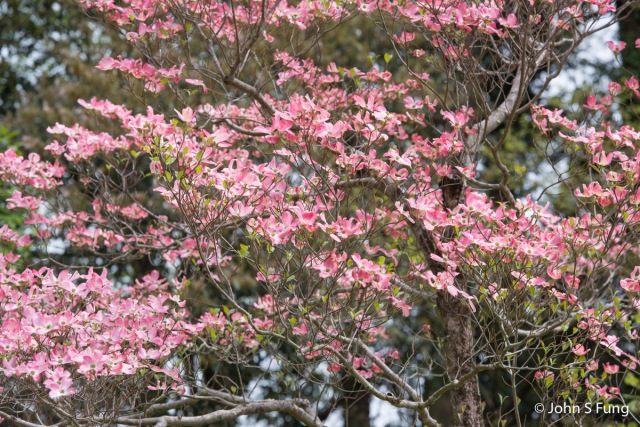

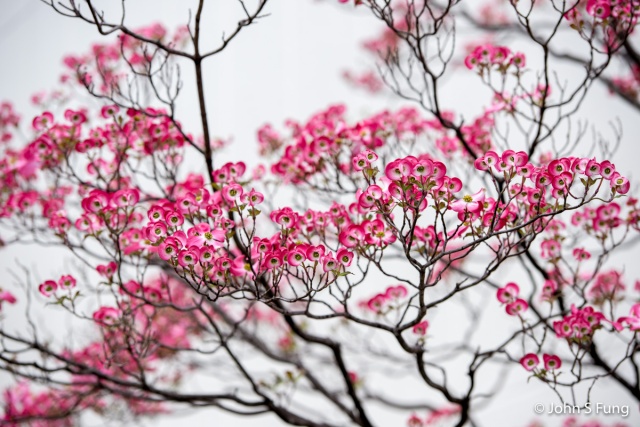
*************************************************************************************
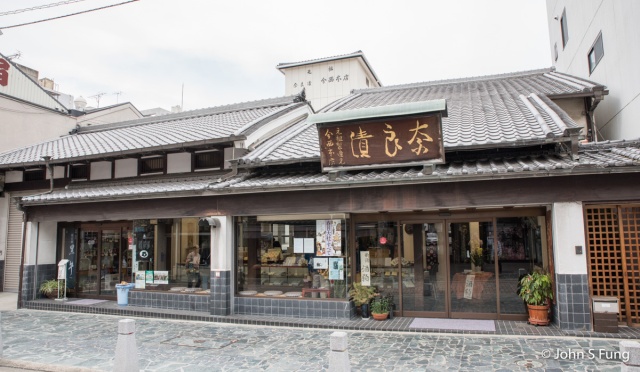
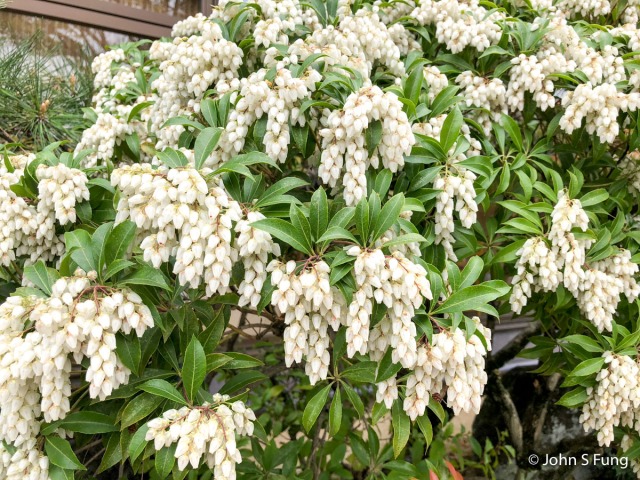

⇑⇑ 黑芝麻 (黑ごま) 軟冰淇淋筒 Black sesame soft ice cream cone
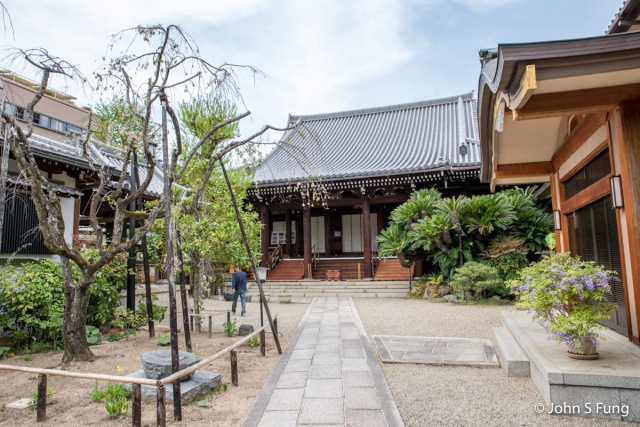
⇑⇓ A small monastery . 小寺院。
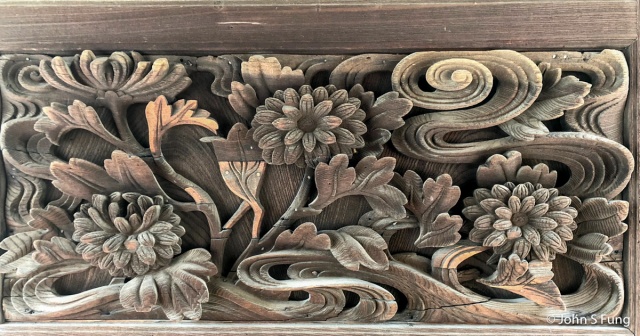
⇑⇓ Beautiful wood carvings on the gate of the monastery. 小寺院門上漂亮的木雕。
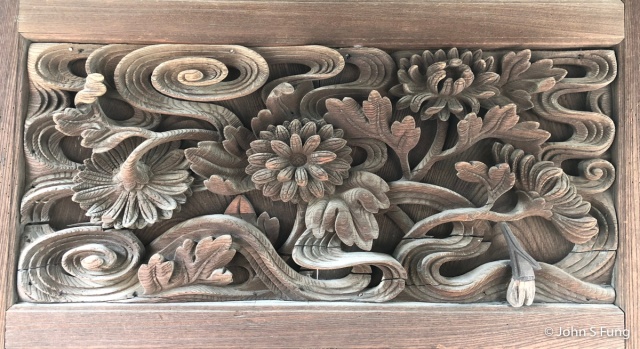
*************************************************************************************
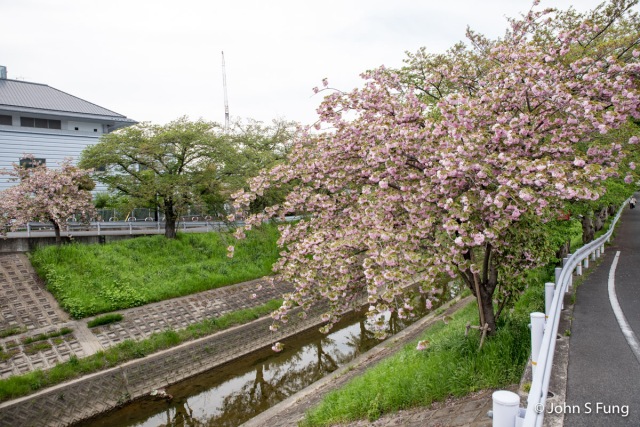
Saho River is a river flowing through the city of Nara. Dozens, if not hundreds, of sakura trees are planted on both sides of the river. It was on our itinerary, but the earlier-than-usual season messed up our plan. Even though it was too late to come, I still wanted to check out the site, however, we were greeted with these two still-in-bloom cherry trees.
佐保川兩岸種有數哩的桜花樹,如果來得合時,景色會很壯覌。如今晚了,絶大部份只有緑葉,這兩株算是聊勝於無。
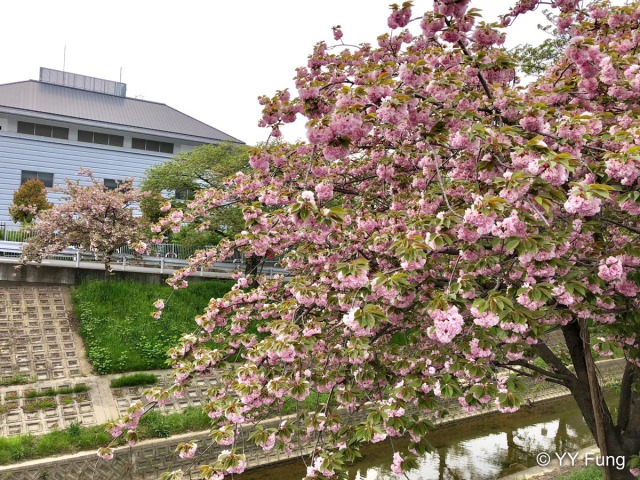
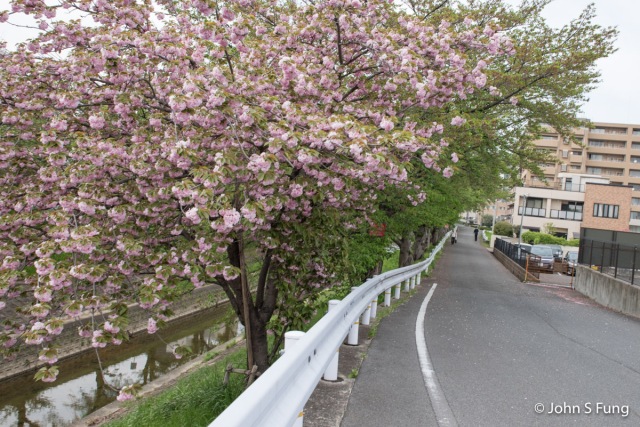
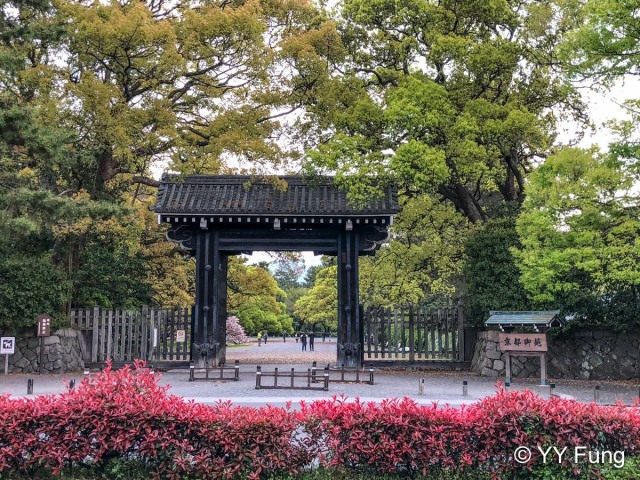
After a bright sunny day the day before, we had, once again, heavily overcast weather with forecast of rain around noon time. We couldn’t complain because we had a wonderful day the day before at Hirano Shrine. However, at that point, with most of the sakura spots in Kyoto reported end of season, our options were limited. We came to Kyoto Imperial Palace, it didn’t let us down, there were at least 3-4 varieties including even the Gyoiko cherry (御衣黃櫻) and the Fugenzo sakura (普賢象桜)(?). Both white and pinkish yaezakura varieties (淡紅色八重咲, Kanzan?)
經過前一天的燦爛陽光,這天又轉回密雲的天氣,而且還説中午會下雨。早上吃早餐時在傷腦筋,盤算著應該怎麼安排行程,因為幾乎大部分京都桜花景點都說桜花開完了。最後信步走到京都御所,就在下立売御門進去就看到大片的桜花還在滿開。可惜的是,天色確實太沉,照片效果也昏暗。驚喜的是這裡也有御衣黃桜和普賢象桜(?不確定)。
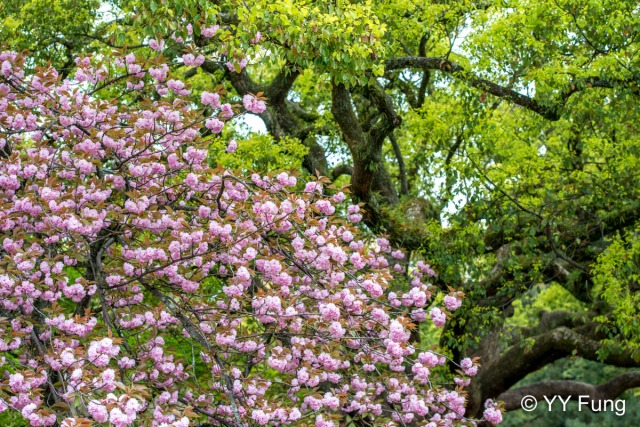
⇑⇓ Not sure what variety of this pink yaezakura this is, according to the info online, it is very likely the Kanzan variety, (カンザン, 関山, 学名: Prunus lannesiana), which is one of the most common pink double flower, its fresh leaves are coppery brown.
⇑⇓ 不確定此粉紅色品種是何品種。唯根據網上資料,猜想可能是関山 (カンザン, 学名: Prunus lannesiana)。它是一種較常見的粉紅色重瓣桜,新葉為銅啡色。

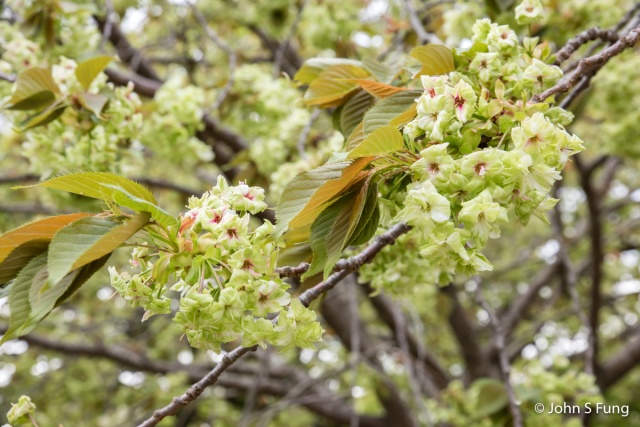
⇑⇑ 御衣黃櫻(較稀有品種) Gyoiko cherry


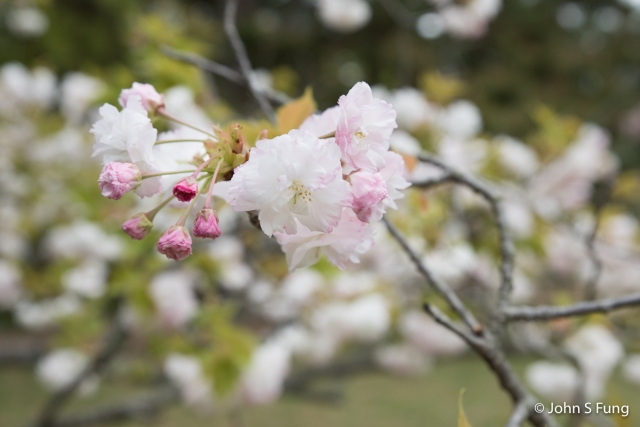

⇑⇓ Ichiyo variety (??), a common late blooming yaezakura. ⇑⇓ 一叶樱 (??)
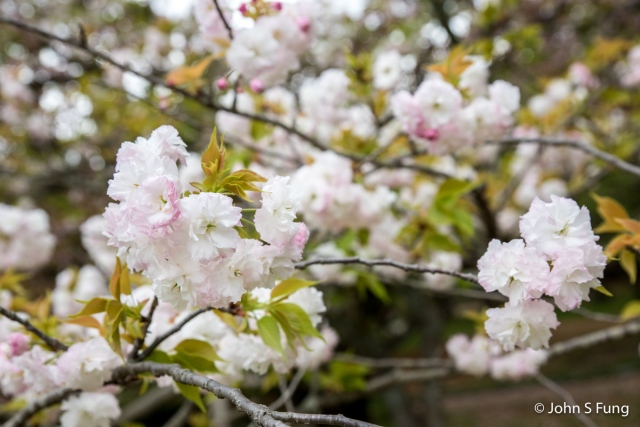

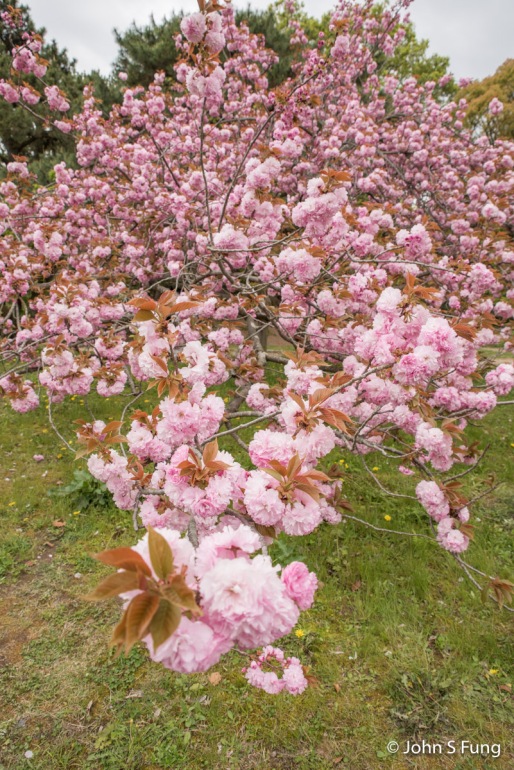
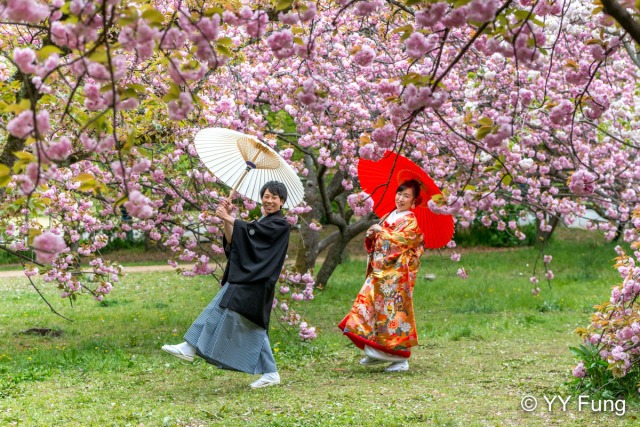
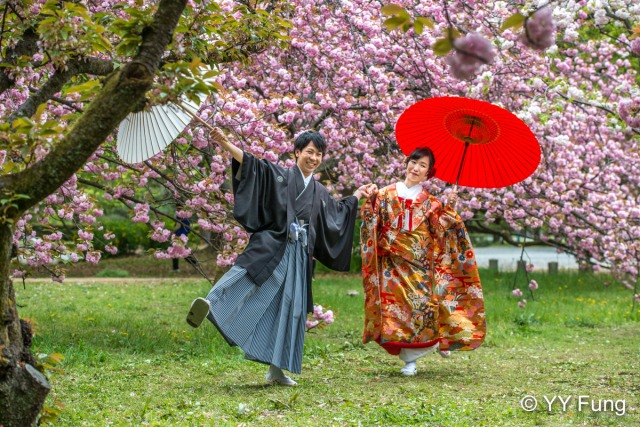

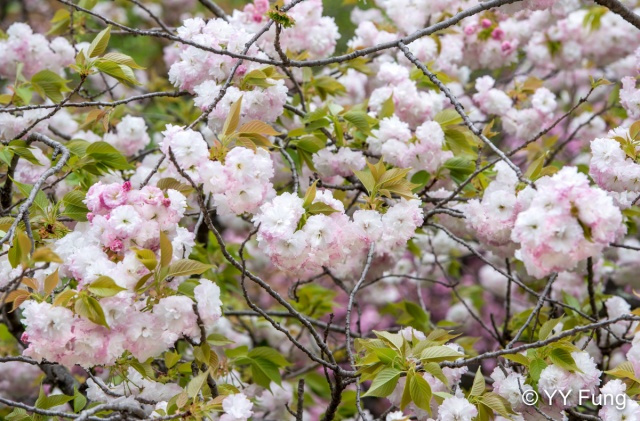
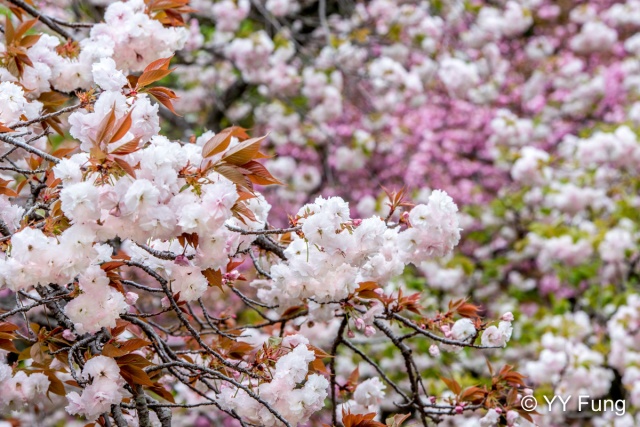
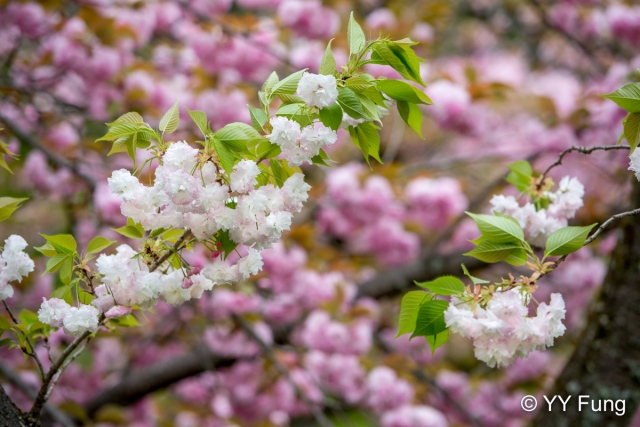
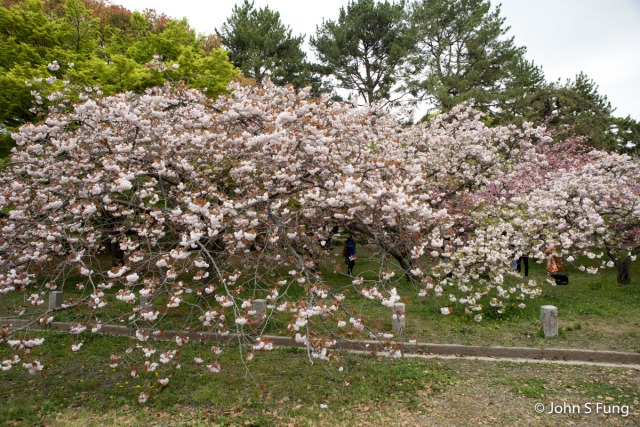
*************************************************************************************

Kyoto cherry blossom viewing tour 4.11-2 Late blooming sakura at Horikawa Promenade
With this year’s earlier-than-usual sakura season in Kyoto close to an end, there were no sakura left at Nijo Castle at this point, however, we were told that there were still some late blooming sakura in mankai at Horikawa Promenade. Horikawa Promenade is a nice promenade located across the street of the entrance of Nijo Castle. It is the site for 京の七夕 Tanabata (Festival of the Weaver) in August. After our visit to the Imperial Palace, the weather was not turning any better, so we came here to try our luck. They were right, there were still a lot of sakura there and most of them were double flowers. We walked a section of the promenade, and it began to rain. We called it a day and went to Shijo for window shopping.
今年原安排去二条城,但𥚃面的桜早已開完了,所以在御所走過來,是想去堀川遊步道看看,據說那裡有遲開的八重桜。步道就在二条城入口對面,長長的小溪兩旁修得整潔,是散步的好去處,每年「京の七夕」就在此舉行。看來這𥚃亦有不同的品種,可覌性高,可惜走了一段就下雨了,我們只好跑到四条逛公司去了。
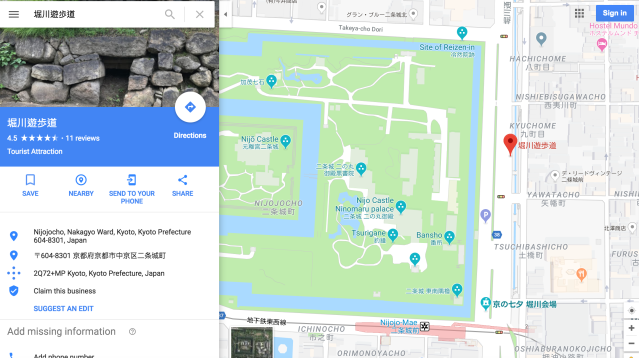
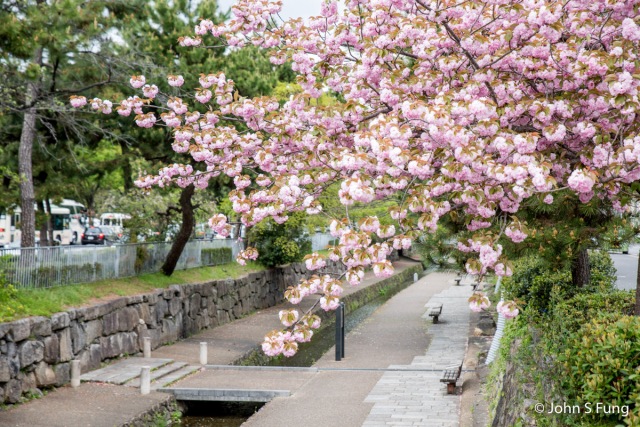
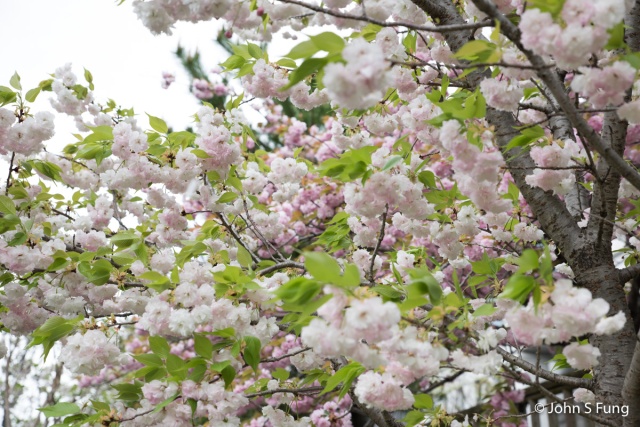
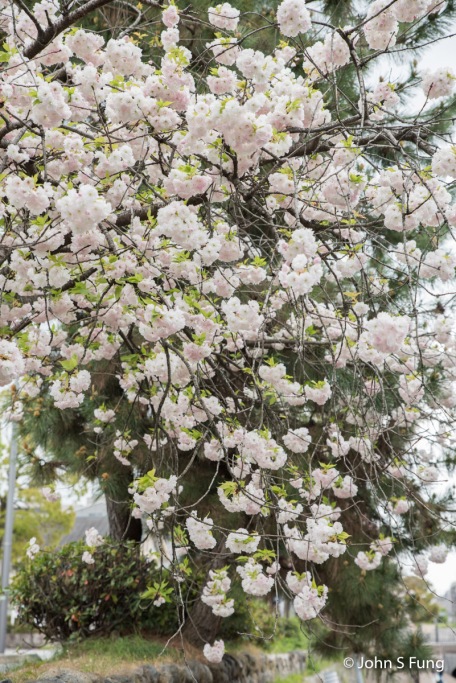
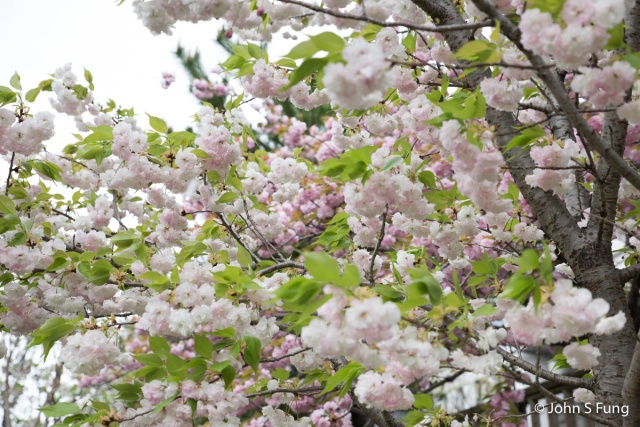
⇑⇓ Fugenzo sakura (普賢象の花 Prunus lannesiana) (?)
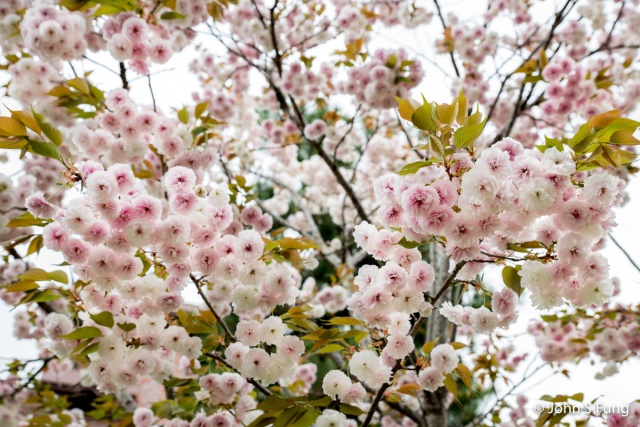
⇑⇓ Fugenzo sakura (普賢象桜)(?)
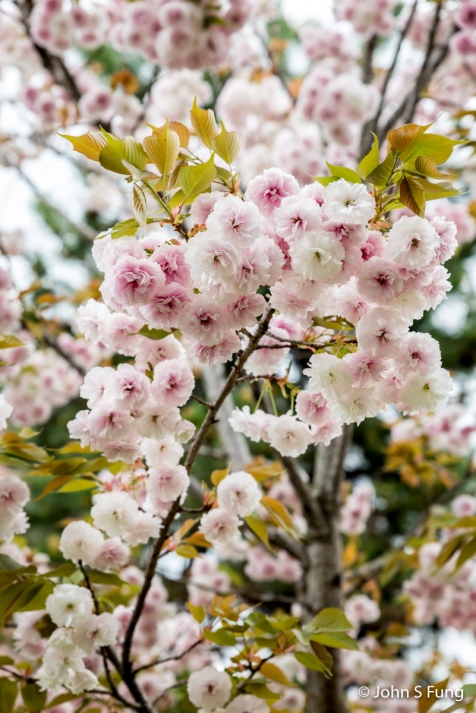
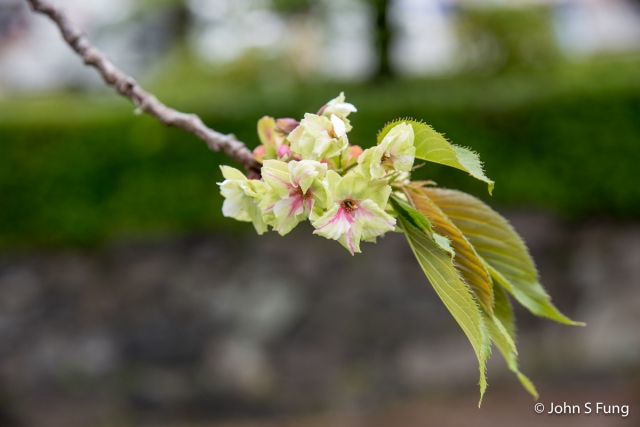
⇑⇑ 御衣黃櫻 Gyoiko cherry

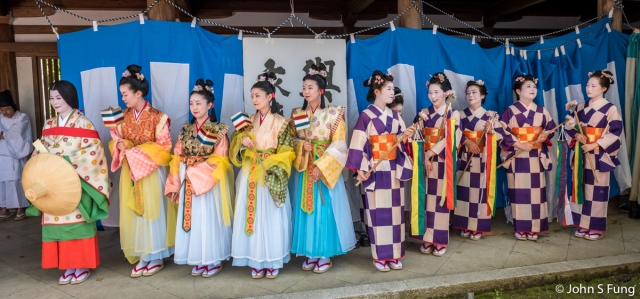
Kyoto cherry blossom viewing tour 4.10-3 Hirano Shrine Oka-sai 2 (おうかさい Sakura Festival) – Parade
The highlight of the Hirano Shrine Oka-kai was the parade. It is a highly anticipated annual event during the sakura season in Kyoto. After a series of Shinto rituals (at 10:00 am on 4/10), the kami (god or gods) of Hirano Shrine was/were being transferred from the honden to a divine palanquin to participate in the parade, accompanied by Shinto priests and other participants dressed in costumes representing characters from Heian period to Edo period. This collection of photos show most of the participants in their costumes.
平野神社桜花祭的高潮就是下午一時出發的神幸祭巡行。正如前一篇所示,神祗被請移駕至鳯輦,參與稍後舉行的巡行。我們在第一部份儀式後,並沒有想著隨第二部份去花山天皇陵,因為這時已有很多參與巡遊的穿著古代裝束,準備參與第三部份儀式,大家都忙著拍照,我們也不例外。
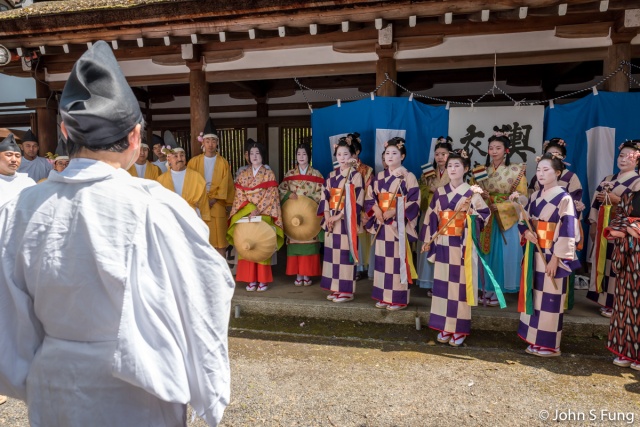
⇑⇑ Instruction was given to parade participants while awaiting for the third Shinto ceremony to take place. 工作人員向參加者講解工作細節。
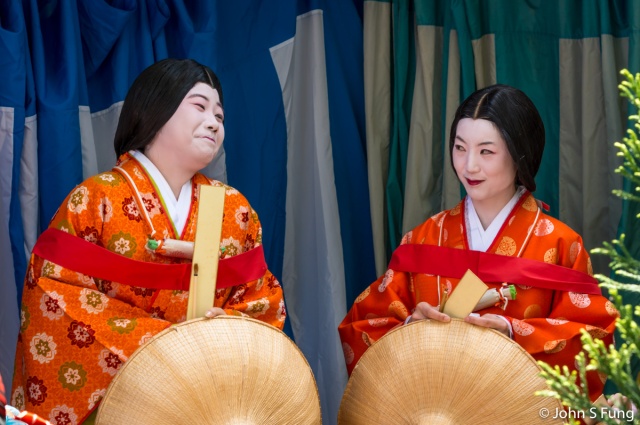
⇑⇓ 曲水遊び列 (あそびれつ ), Ladies, dressed in Heian costumes from the Kyokusui asobi retsu group. (info below) ⇑⇓ 曲水列是平安時期服飾。
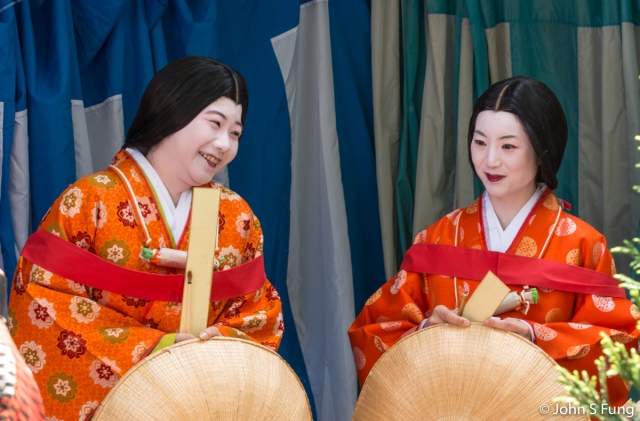
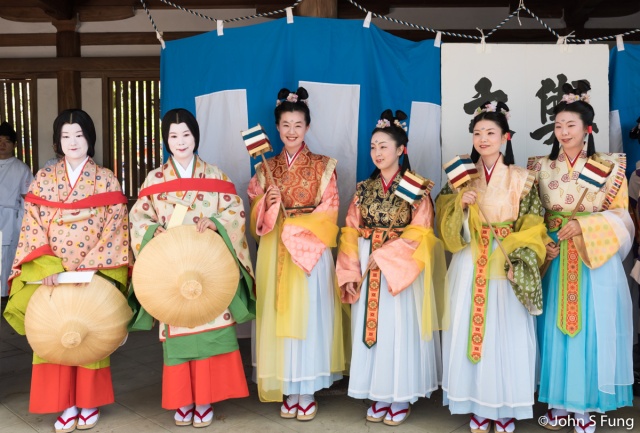
⇑⇑ Heian ladies + Lady weavers ⇑⇑ 曲水遊び列 + 織姫列


⇑⇓ 織姫 Orihime , lady weaver, or Weaving Princess as in the legend of Tanabata ( たなばた or 七夕) Wikipedia: Tanabata
⇓⇓ The face of this lady weaver shows some norms of beauty of the Tang Dynasty court ladies in China, 618 – 907 AD. 1. The tracing eyebrows (in the old days, eyebrows would have been shaved off first), probably of the “silkworm antennae” style; 2. The gilding or painted forehead with a floral pattern. However, she didn’t have whitened and rouging face and small rouging lips.
⇓⇓ 織姬,即織女。此織姬的化𥺁十分有意思,她眼眉的描法有別於其他織姬,她的眼眉似是用了唐人「蛾眉」描法。當然,現代人不可能先把眉毛剃去,所以就不能像唐人仕女一樣畫得高高的。另外,所有織姬印堂都有藍色的圖案,據說唐人仕女印堂上絵有圖案彩絵或貼上金箔。不過,唐人仕女面敷水粉和婟脂的化妝,他們倒沒有。
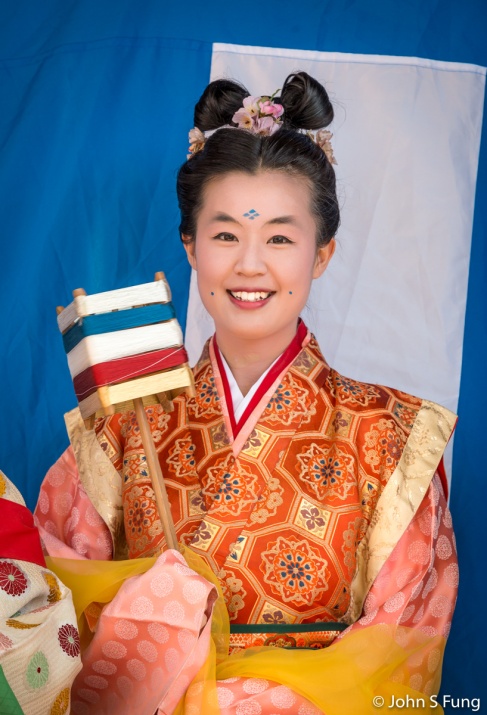
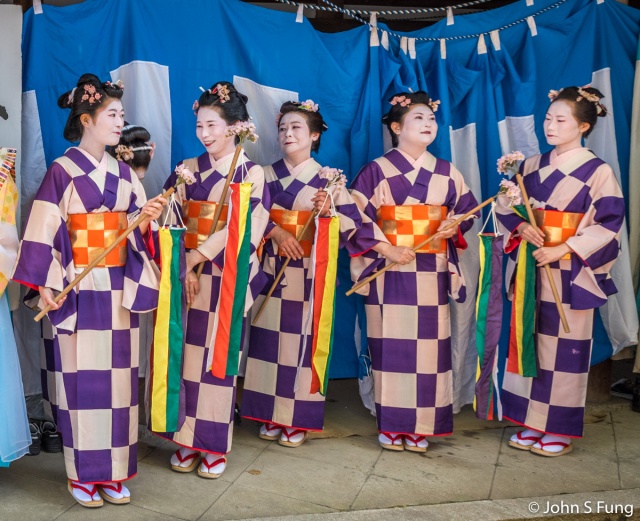
⇑⇓ 染色列 Ladies of the dyeing group. It is believed that one of the Kami (deities) residing in the Hirano Shrine is the Kami of dyeing and the dye ladies, they have whitened face and small rouging lips.
⇑⇓ 染色列=染色組: 我的理解是她們亦可被稱為染姬,據説平野神社其中一位神祇是管染布的。
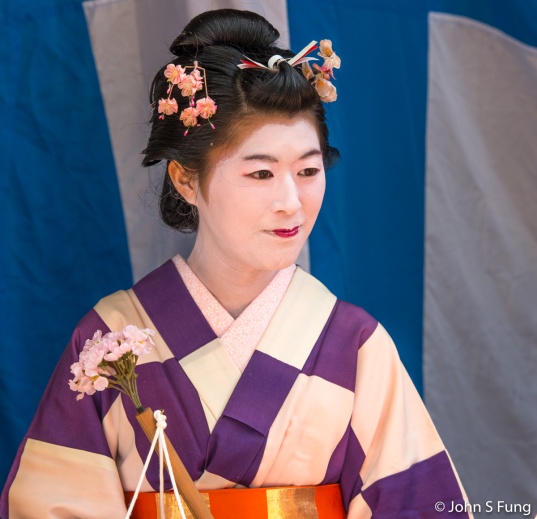

⇑⇑ 織姫 Orihime , lady weaver
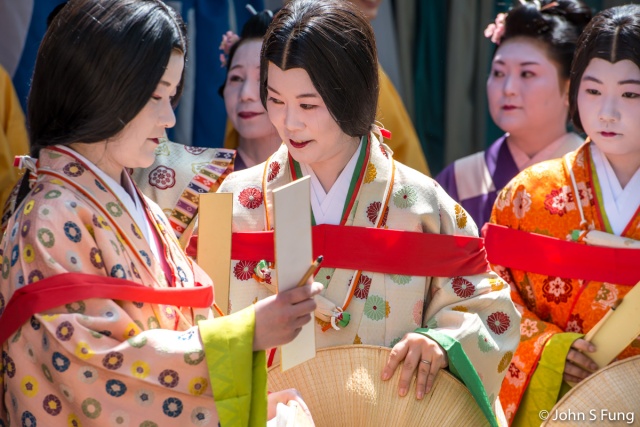
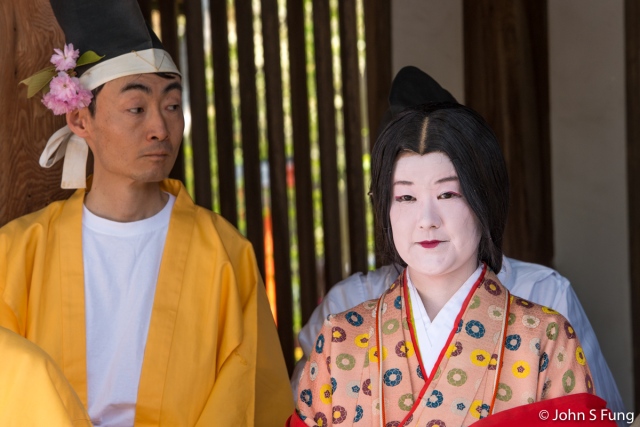
⇑⇓ The hair style and dress of a Heian court lady. ⇑⇓ 平安時期服飾。

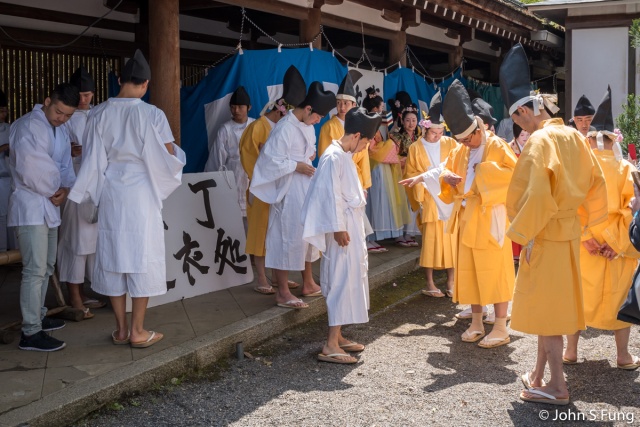

⇑⇓ Portable shrine carriers ⇑⇓ 神輿隨從。
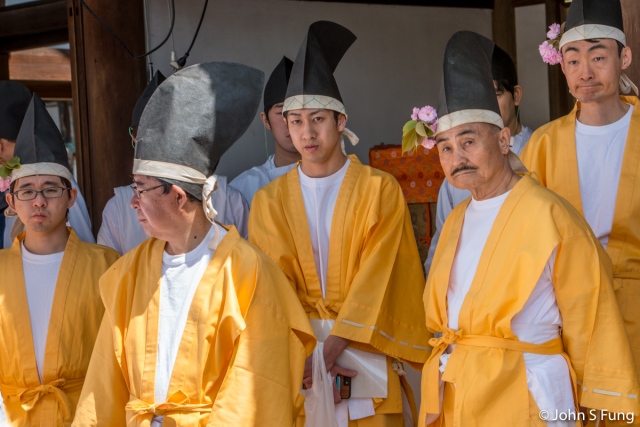
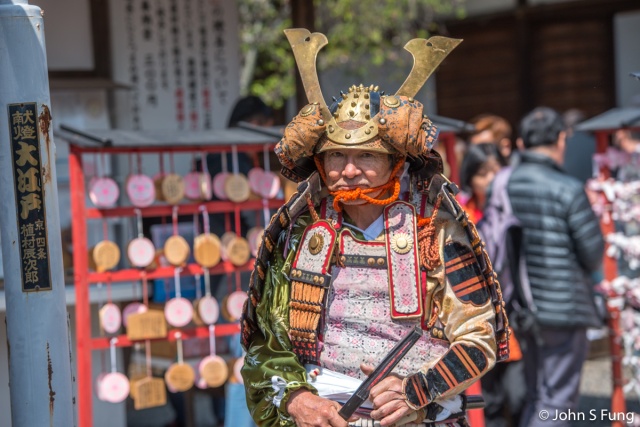
⇑⇑ Minamoto no Mitsunaka, Mid-Heian era warrior. 多田満仲・頼光列, 武士裝扮。
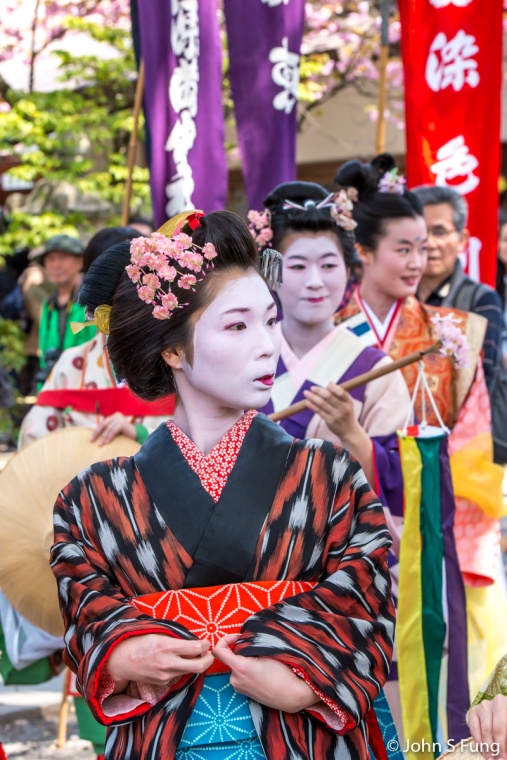
⇑⇑ Not sure who this lady represented, probably a maiko (?)
⇑⇑ 查不到她的身份,根據她的頭飾(另外的照片),我猜可能是舞妓(?)

Route of Parade: 2018/4/10 13:00
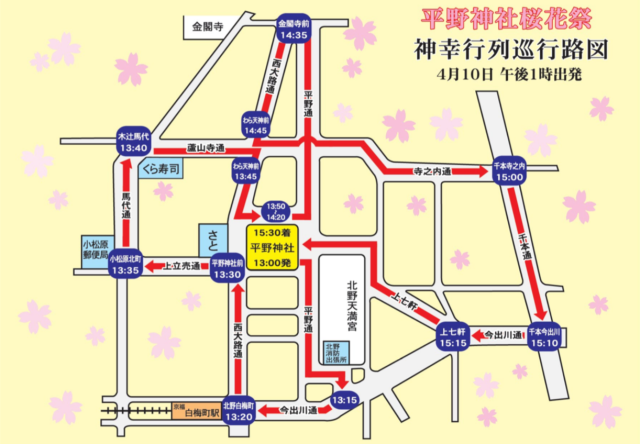

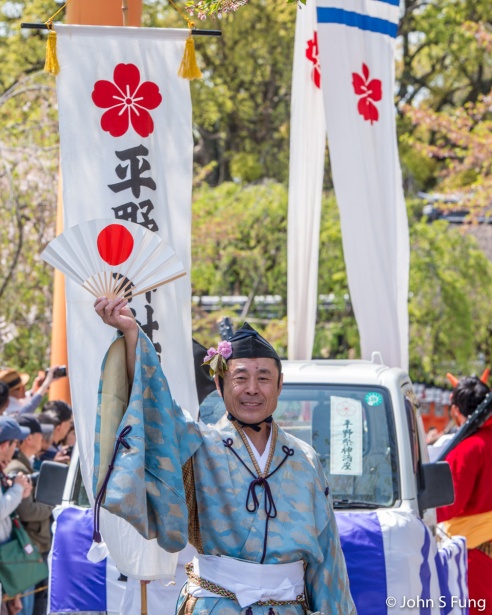
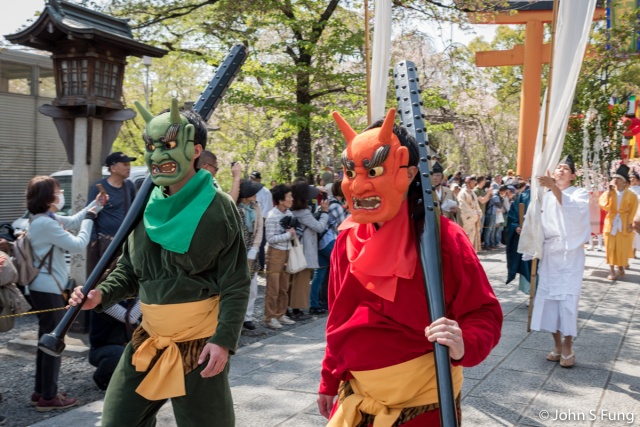
⇑⇑ 鬼二匹 , 赤鬼, 青鬼. Red and green ogre, carrying iron clubs.
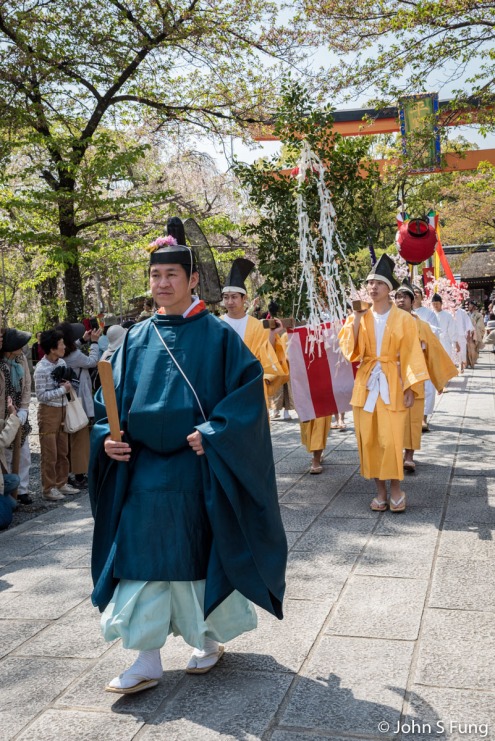
⇑⇑ A Shinto priest in his dark blue vestment was leading the way.
⇑⇑ 巡行隊伍由神主領先(和押隊)。

⇑⇑ 花山天皇花山車 Emperor Kazan Keigyo flower cart
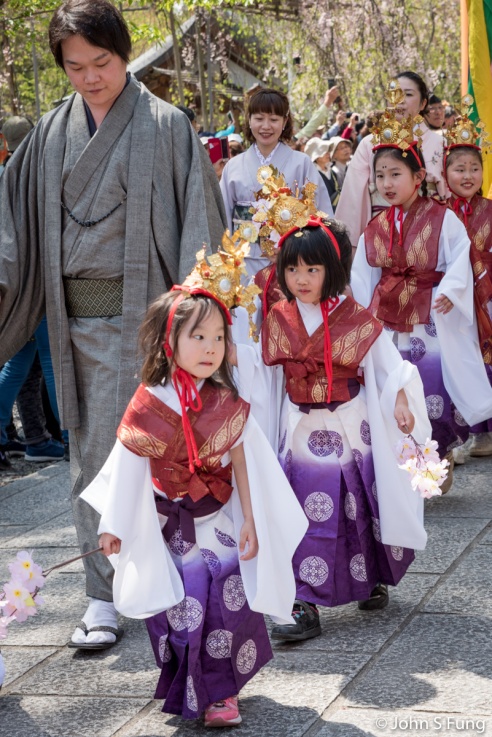
⇑⇑ 稚児列(組) 子供の無事成長を祈 Kids’ group – pray for safe growth of children.
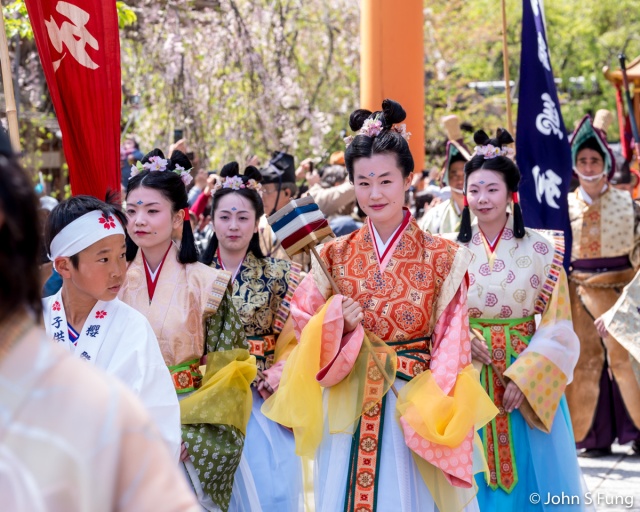
⇑⇓ 織姫列(組) 天平年間 ( 729-749年) Lady weaver (Year of Tenpyo 729-749) group.
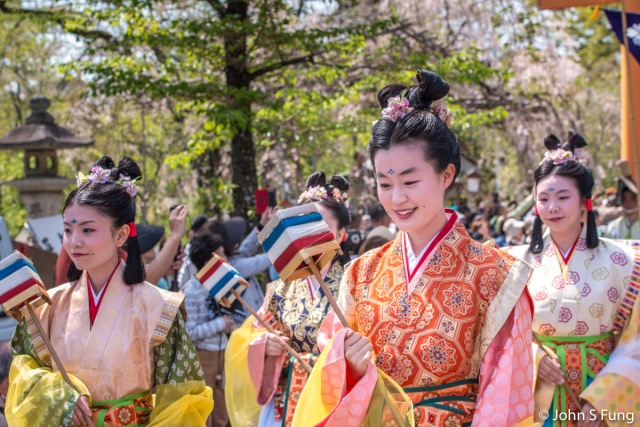

⇑⇑ 流鏑馬列(組), やぶさめれつ (yabusame retsu) Horseback archer. This outfit is often seen at Kasagake (笠懸 かさがけ ) , horseback archery rituals. The hat he was wearing is called an ayaigasa (綾藺笠) and was originally used as a type of target. 笠懸 can be translated as “hat shooting”. Note the deer-hide chaps, mukabaki (行縢).
⇑⇑ 流鏑馬 – 乃騎射箭手。此裝束多見於笠懸(かさがけ) = 騎射。此箭手所戴之笠稱綾藺笠,本來是用作騎射時的靶子用的。射手下身圍有鹿皮,稱行滕。

⇑⇓ Divine palanquin 御鳳輦
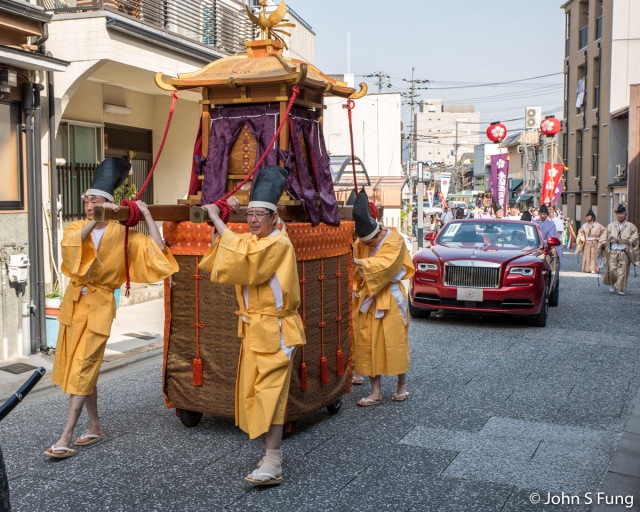
⇑⇓ Accompanying the divine palanquin, the principal priest was riding in a convertible Rolls Royce, with the Hirano Shrine cherry blossom emblem printed on the front and back plates.
⇑⇓ 緊隨鳳輦後面,就是平野神社的神主。他們坐的開蓬勞士雷斯的車牌是神社的桜花紋。
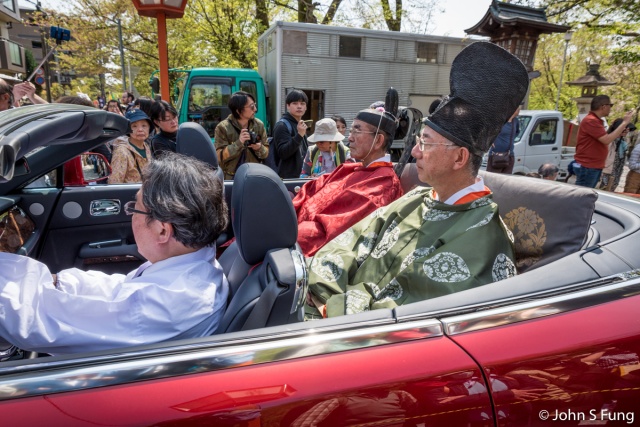

染色列(組) Dyer’s group

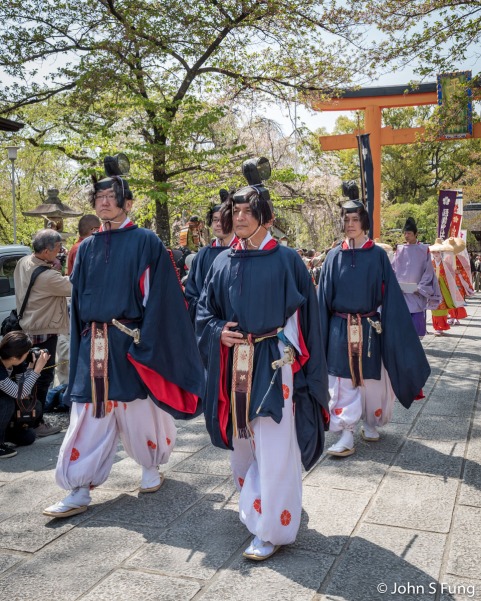
⇑⇑ 東遊列(組) Formal court wear of military officer of Konoe (近衛). It was worn only by military official of the fourth rank. This uniform features wrapped tail kanmuni (巻纓冠 ) and oikake (blinders made of lacquered horsehair).
⇑⇑ 東遊到(組): 第四級近衛武官的服裝。所戴的冠,Kanmuri (遠紋), 其特色是有 keneikan(卷纓)和 oikake (用馬毛上漆造成的眼罩)。
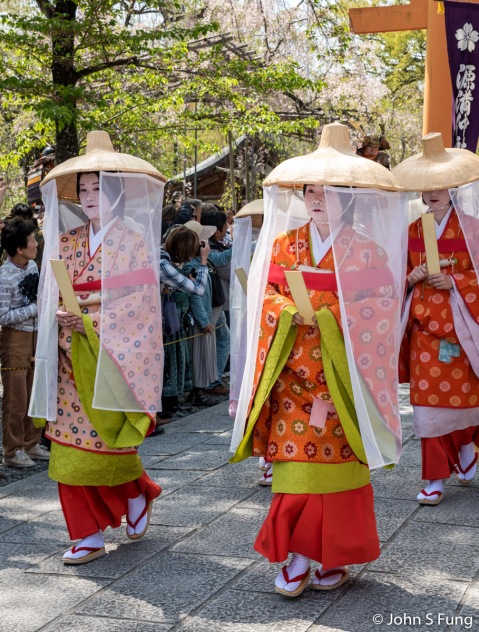
⇑⇓ 曲水遊び列 (kyoku mizu asobi retsu), couldn’t find the meaning of 曲水遊び online, I would guess it has something to do with kyokusui-no-en 曲水の宴 which refers to the scholar-poets gathering held by the famous Eastern Jin calligrapher Wang Xishi (Ou Gishi 王義之, 321-79) in the year of 353. In the re-enactment of 曲水の宴in Kyoto, (still being held annually at Jonangu Shrine 城南宮 and Kamigamo-jinja 上賀茂神社), participants wear costumes of Heian aristocrats. The women shown were wearing an uchikatsugi hat, a long veiled headdress worn by high class ladies to protect their anonymity.
⇑⇓ 曲水遊び組(組):沒有找到直接解釋的意義,但似乎是與曲水之宴有關。日本平安時期甚愛中國晉王羲之的曲水流觴,文人雅集之典故。所以猜想是平安時期皇族女眷的裝束。帽周囲有輕紗,是為了隱藏女眷的身份。


⇑⇓ Minamoto no Mitsunaka, Mid-Heian era warrior.多田満仲・頼光列(組)(ただみつなか・源 満仲) 平安時代中期の武将, 源滿仲在攝津國管理期間在多田町多次定居,故而被稱多田滿仲.
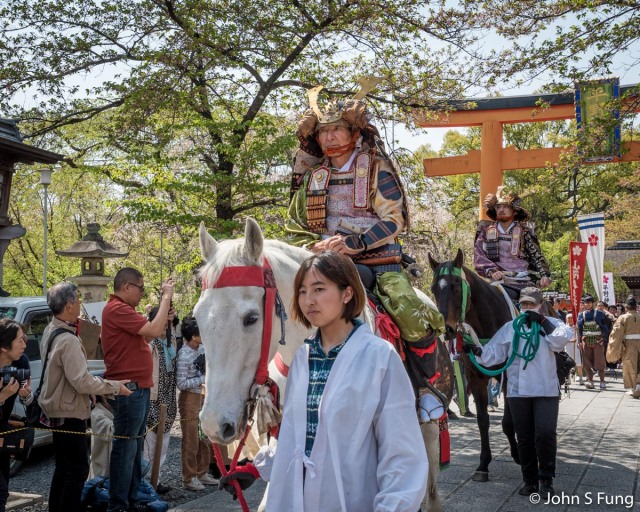
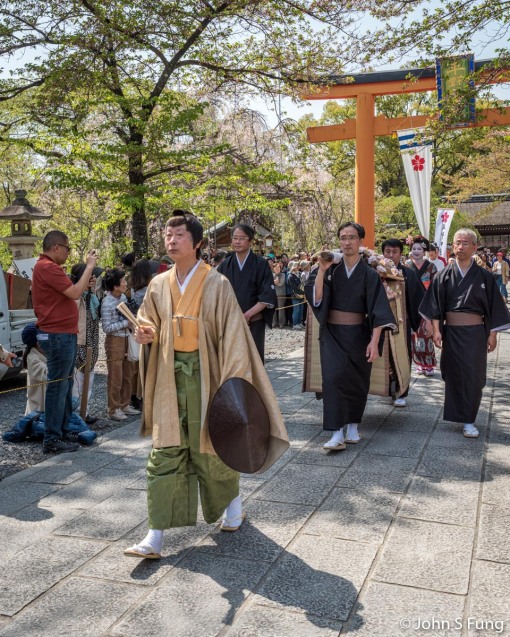
⇑⇑ Rai Sanyo (頼山陽), famous scholar in Edo period. His mother used to come to Oka-sai in a covered palanquin. 頼山陽母花見列(組)(らいさんようはははなみれつ) – 頼山陽, 生於日本大阪,江戸時代後期歷史家、思想家、漢詩人、文人、藝術家、陽明學者。

Maiko ? 舞妓(?)
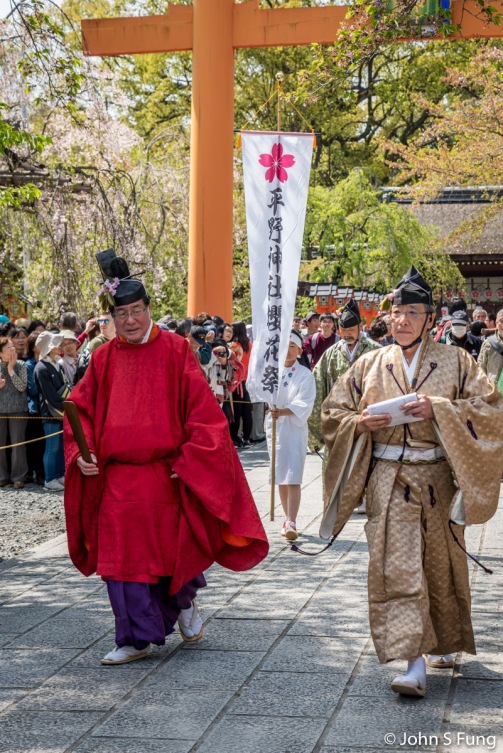
A Shinto priest brought up the rear. 後駆 神職 (殿(しんがり)の神職)
*************************************************************************************
The set menu contains Japanese tea, yuba “sashimi,” tofu, soy milk, tofu pudding (not sweet), tempura vegetables, a bowl of rice, pickle ….
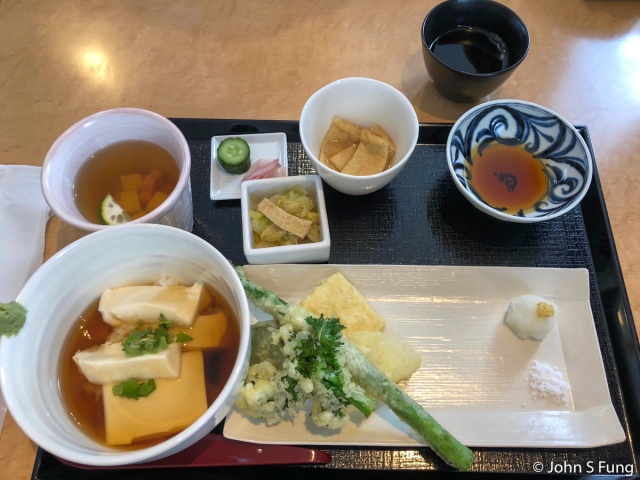
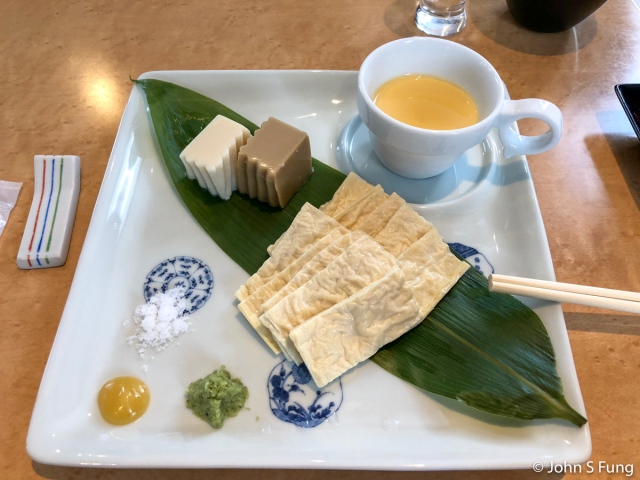
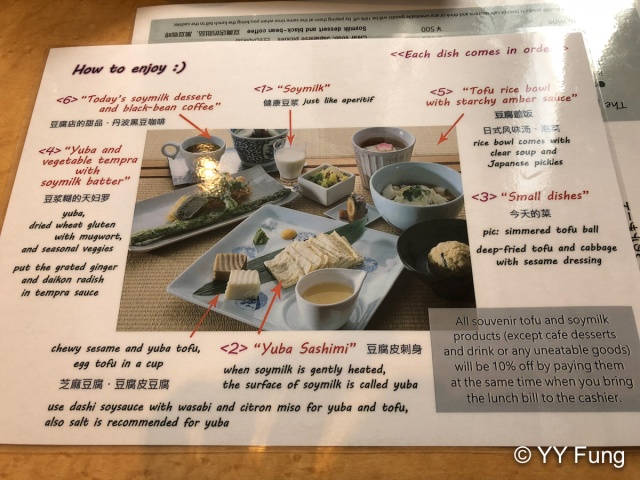
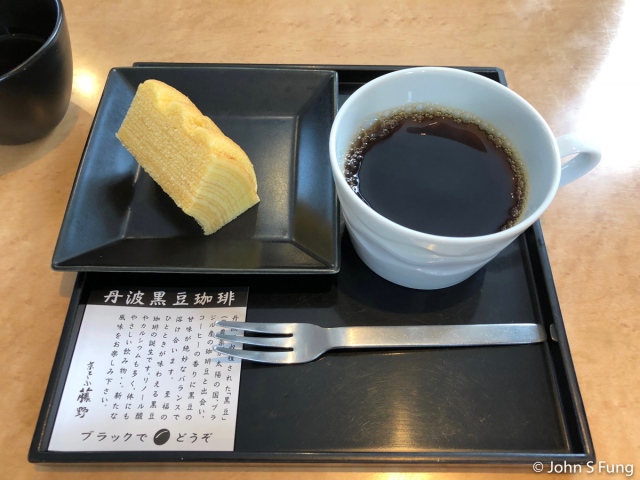
Dessert: a choice of black bee coffee or sweet cold drink.
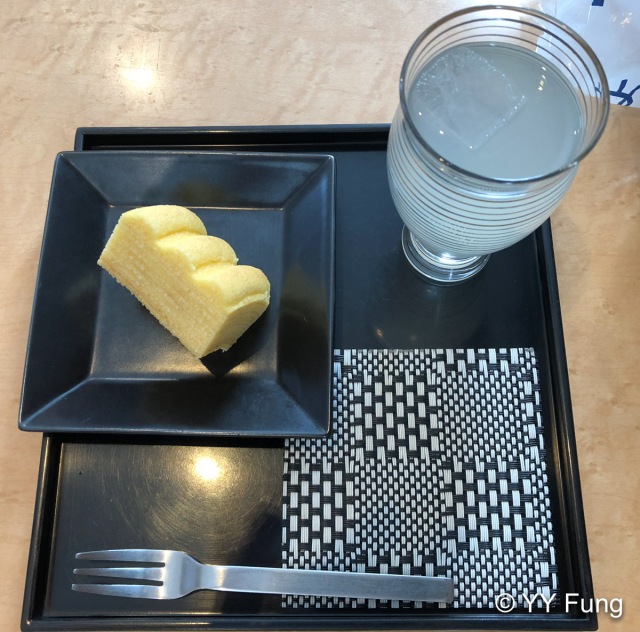
Wikipedia: It is the oldest hanamachi (geisha district) in Kyoto, and is located just east of the Kitano Tenman-gū Shrine. The name Kamishichiken literally means “Seven Upper Houses.” These refer to the seven teahouses built from the equipment and material left over from the rebuilding of the Kitano Shrine in Muromachi era (1333–1573).
維基百科:上七軒(かみしちけん)是位於日本京都市上京區真盛町至社家長屋町之間地區的一條花街。在室町時代重建北野天滿宮時,剩餘的建築材料曾用來修建7個茶店,是為「上七軒」名稱的由來。二戰期間,上七軒的茶屋曾一度大多停業,但在戰後又相繼恢復。現在上七軒共有10家茶屋,25位藝伎和舞妓。
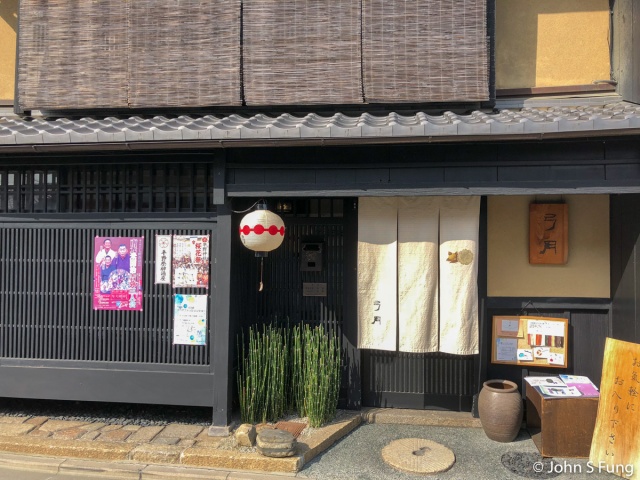
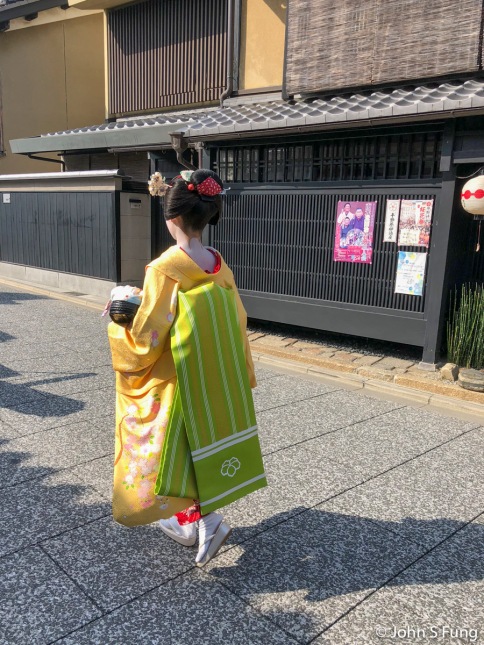
⇑⇑ Maiko (geisha apprentice) in Kamishichiken ⇑⇑ 舞妓
Wikipedia: The geisha of this district are known for being subtle and demure, few in number but each highly accomplished dancers and musicians. There are approximately 25 maiko and geiko in Kamishichiken, along with 11 teahouses.
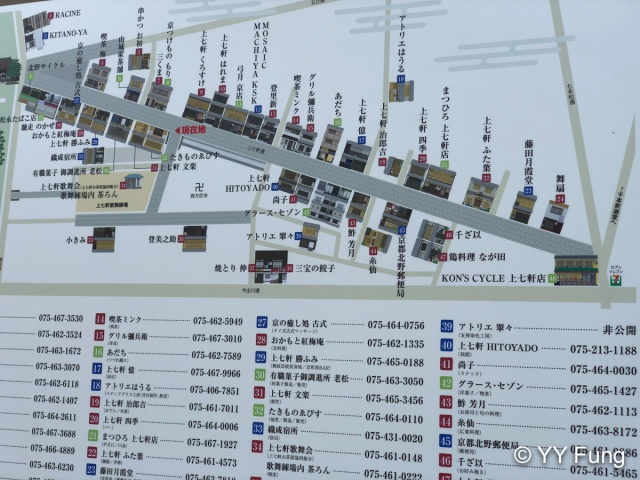
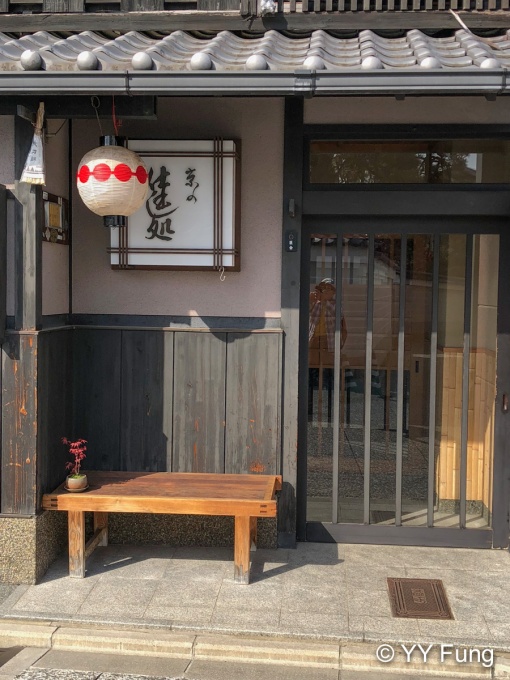
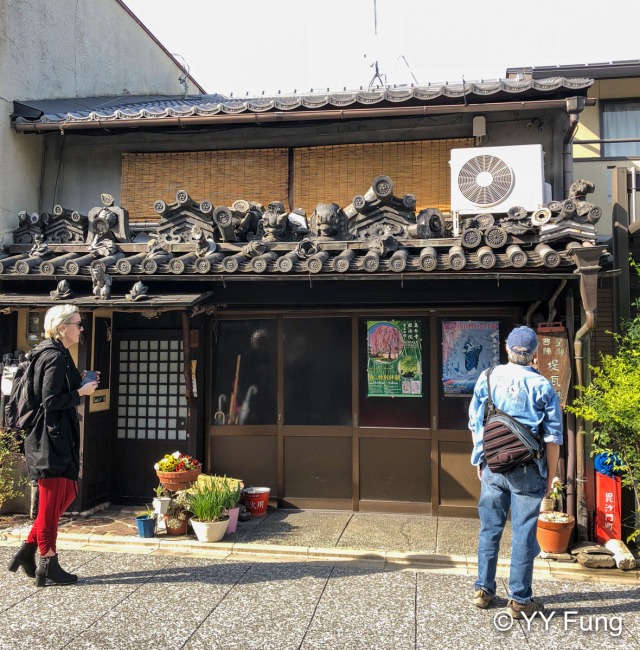
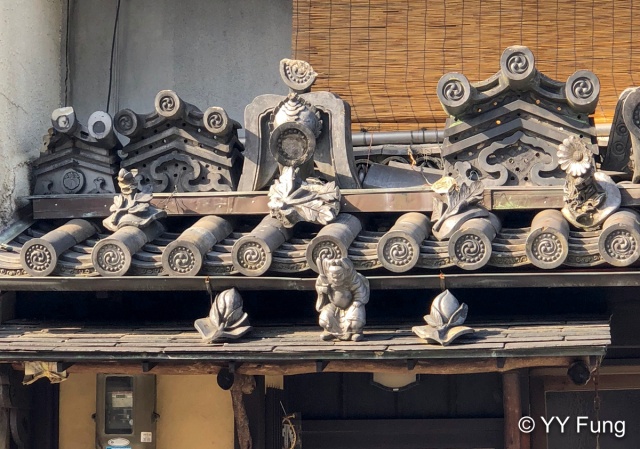
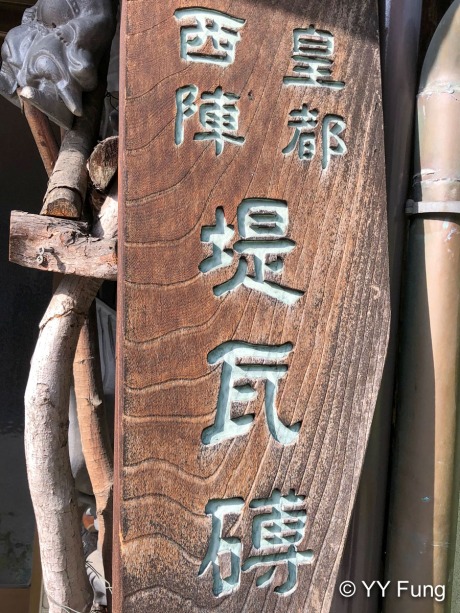
Hirano Shrine series:
4.1-6 平野神社の桜(1) Hirano Shrine (1)
4.10- 1 平野神社の桜(2) Hirano Shrine (2)
4.10- 2 平野神社 – 桜花祭 1 Hirano Shrine Oka-sai (おうかさい Sakura Festival)
4.10- 3 平野神社 – 桜花祭 2 Hirano Shrine Oka-sai (おうかさい Sakura Festival)

Kyoto cherry blossom viewing tour 4.10- 2 Hirano Shrine, Oka-sai 桜花祭 (1)
The shrine has been the site of Oka-sai (桜花祭 sakura matsuri) since 985 during the reign of Emperor Kazan (968-1008), it has become the longest regularly held festival in Kyoto. Being the highlight of Oka-sai, the parade was made up of a combination of medieval characters, weaving ladies, Heian court ladies, maiko, mounted warriors, and horseback archer, etc. The center-piece was the omikoshi (portable shrine) and the accompanied priests.
The Oka-sai of Hirano Shrine consisted of five parts (those with a √ indicates our presence and photos taken, X represents absence and no photos) :
Photos in this collection show the ceremony held in front of the honden, at 10:00 (ceremony #1) and 12:00 (#3), those of the procession (#4) will be included in the next post, It is said that the costumes, Ikan Sokutai (衣冠束帯), dressed by the priests in the ceremony can be traced back to the court of the Tang Dynasty, China. It appeared that in this festival, there were quite a few of Tang Dynasty elements seen in their costumes, make up, etc . Interestingly, there is one late-bloom variety of sakura in Hirano Shrine called 楊貴妃 (よう きひ Yookihi ) sakura, named after Yang Guifei (719-756), the beloved consort of Chinese Emperor Xuanzong of Tang Dynasty.
平野神社的桜花祭有一千一百多的歷史。平野神社建立於平安京遷都時,受桓武天皇命建立,供奉大和國四神(今木神、久度神、古開神、比賣神)。公元985年,花山天皇 Emperor Kazan 臨幸平野神社,觀賞桜花及舞踊、鏑流馬等表演,演變成平野神社之桜花祭,並延續千年至今。
平野神社桜花祭神道儀式: √ 我們參加了 ; X 我們沒有參加
√ 1. 10:00 桜花祭由上午十時神社本殿前進行的神事開始, お秡い (おはらい, 淨化, 驅魔) 之後,本殿神壇之門打開,神靈(御祭神の御靈)被請至停在拜殿之鳯輦(ほうれん),或稱神輿。神祗被請移駕至鳯輦,參與稍後舉行的巡遊。儀式由主祭進行, 在本殿與拜殿間之庭園舉行。
X 2. 11:00 參拜花山天皇陵。 我們在第一部份儀式後,並沒有想著隨第二部份去天皇陵,因為這時已有很多參與巡遊的穿著古代裝束,準備參與第三部份儀式,大家都忙著拍照,我們也不例外。
√ 3. 12:00 神幸列発輿祭(はつれんさい hatsurensai) 所有神幸祭參加者都出席此儀式,載有神祇的鳳輦被供在本殿前。穿淨衣主持第一部份儀式的神職, 此時换上了正式的顔色禮服,主祭穿紅色,輔祭穿紺色(深藍),首先以榊木進行淨化、驅邪,然後獻上祝詞,祈願桜花祭巡遊完滿,合境平安。
√ 4. 13:00 神幸祭 -平野神社桜花祭的高潮就是下午一時出發的神幸祭巡遊。巡遊開始,依上面的路線圖遊經境內。我們在鳥居前拍巡遊行列,但沒有隨隊繞境。因為飢腸轆轆,在附近的豆腐料理店吃中飯去了。
X 5. 15:30 神幸列還幸祭 – 巡遊隊伍返回平野神社,神職人員將神祗自鳳輦請回本殿。活動完滿結束。
此輯照片紀錄本殿前的神道儀式,即上午十時的淨化、驅邪和請神祇移駕鳳輦的過程(#1)和(#3)的神幸列発輿祭。神幸列的人物和巡遊的照片放在下一輯。有説神道教士(神主)所穿的白色淨衣和顔色正服是「衣冠束帶」,此類衣飾可追朔至中國唐朝。有趣的是平野神社內有一桜品種稱楊貴妃。
Part 1 – Shinto ceremony: purification, blessing and transfer of enshrined kami to portable shrine. (Photos are arrange in chronological order).
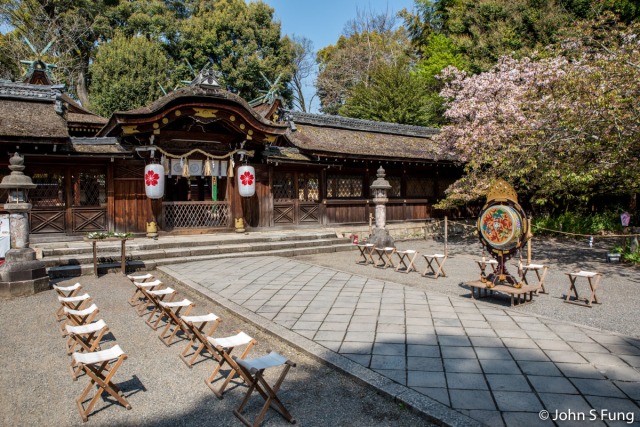
⇑⇑ The courtyard in front of the honden is set up for the first part of Shinto ceremony to kick off the Oka-sai, 桜祭神幸祭。 The honden (本殿, or haiden), also called Shinden (神殿) or sometimes shōden (昇殿), is the most sacred building at a Shinto shrine, intended purely for the use of the enshrined kami.
⇑⇑ 本殿乃神殿最神聖的地方,乃神祗所居之地,故又稱神殿。本殿安排了進行第一部份儀式,本殿對著的拜殿中間停有鳳輦(見下圖)。
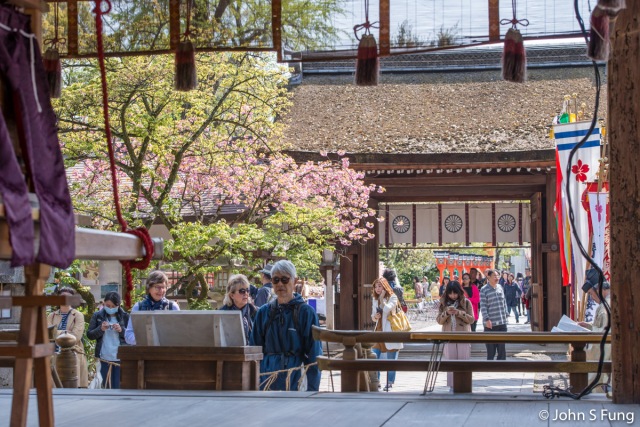
⇑⇓ Kasuga-den (拝殿 hall of worship) , collapsed by the destructive force of typhoon #21 (Jebi) on September 4th 2018, five months after our visit in April.
⇑⇓ 拝殿。也是進行儀式的地方,亦在此舉行桜花祭音樂會。可惜拜殿受本年(2018) #21 颱風吹襲,完全倒塌。
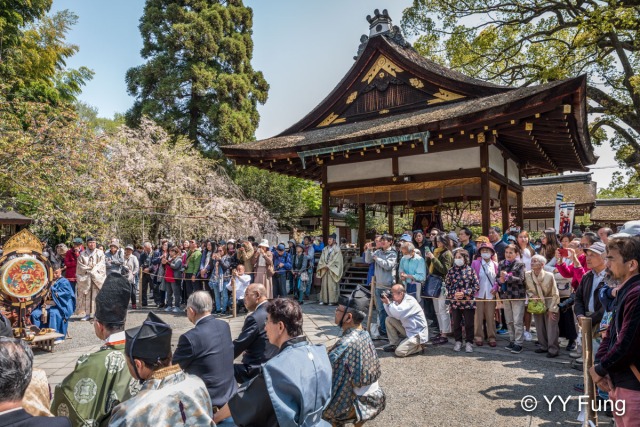
⇑⇓ 鳳輦(Horen ほうれん) or 神輿 (mikoshi): Horen, very likely a term adopted from ancient China. In Chinese literature, 鳳輦 refers to vehicle used by immortal/celestial being. A mikoshi 神輿 in general refers to a divine palanquin, or portable Shinto shrine. A Horen in the kasuga-den.
⇑⇓ 鳳輦(Horen ほうれん) or 神輿 (mikoshi): 拜殿內停有鳯輦, 相信是源於中國,原指仙人所乘座駕。
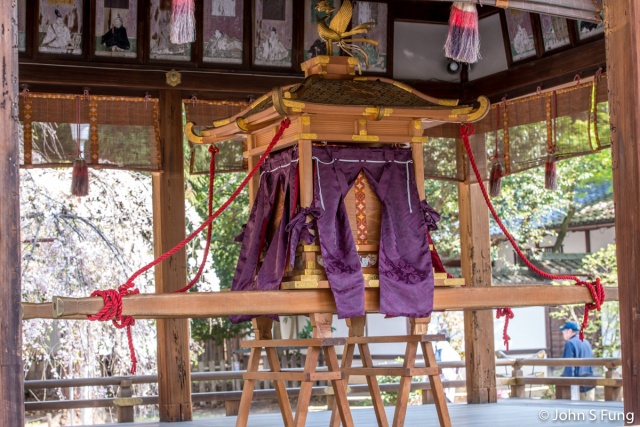
It is not uncommon to see divine palanquin being carried through the streets of Japan during festivals. The idea of cruising Shinto Kami (gods) along the streets of the shrine’s parishioners region is meant to be a purifying, cleansing and blessing act, particularly during desperate times of disaster and plague.
在日本的祭中,常見神輿參與巡遊,繞境,其目的在於淨化、驅邪和祈福。
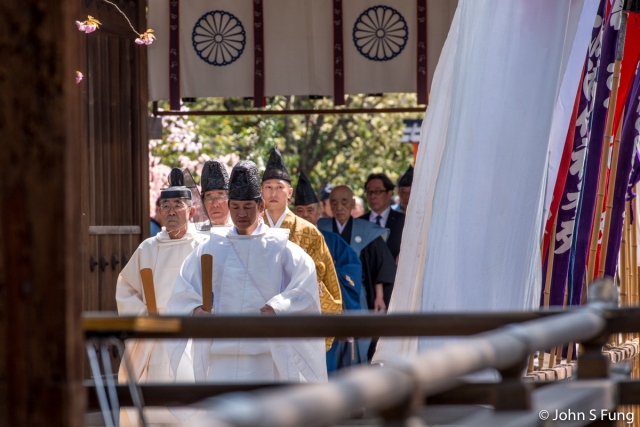
⇑⇓ At 10:00 am, a single file of kannushi (Shinto priests) coming to the courtyard in front of the honden.
⇑⇓ 上年十時,四位穿白色斎服(淨衣)的神主魚貫進場,後隨為神樂手。

⇑⇓ For the first Shinto ceremony, Kannushi were wearing a white garment called jōe (斎服 or 浄衣 “pure cloth”, or Ikan Sokutai 衣冠束帯). The second one in the file was wearing a kanmuni hat (the classic court cap with a tail, imported from China where it is known as the guan 冠) and his vestment was a bit tan in color, my guess is that he was the principal priest. The other three were wearing a hat called ebōshi (立烏帽子) and a white joe. A jōe is essentially a white kariginu, traditional hunting robes worn by nobles during the Heian period. (Wikipedia)
⇑⇓ 主祭戴冠(かんむに),其他三神主載立烏帽子。
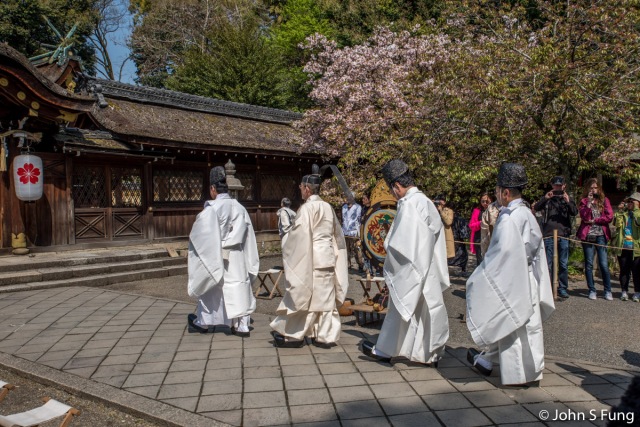
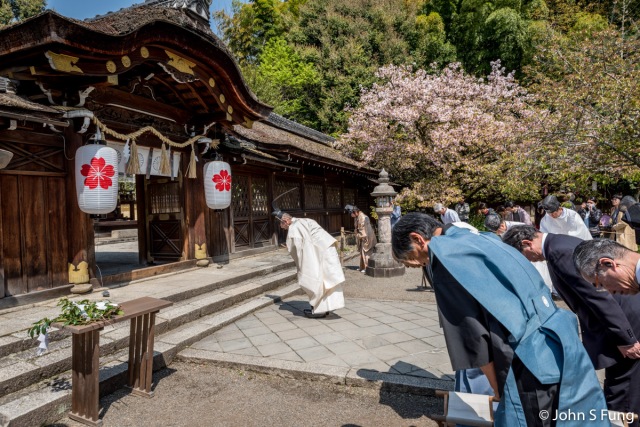
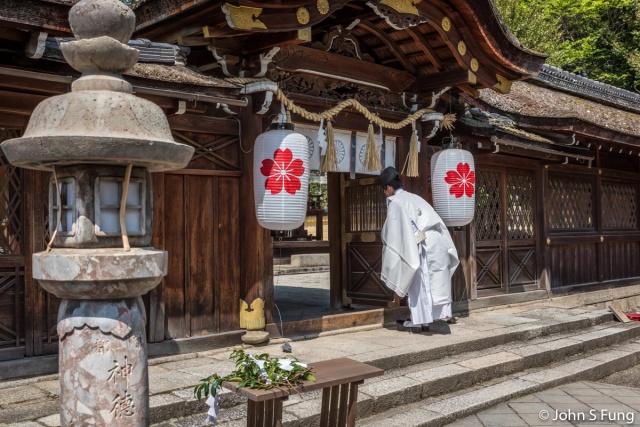
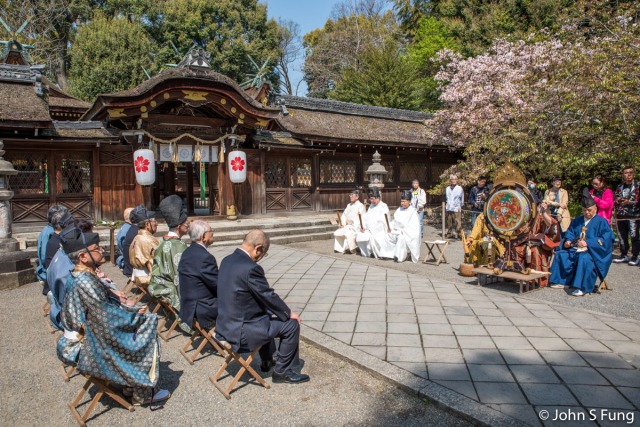
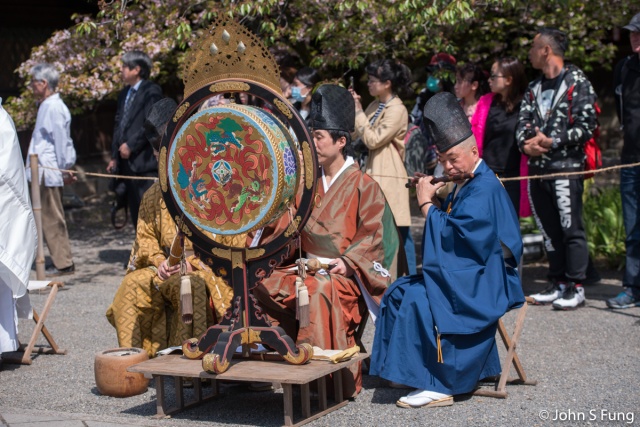
Musicians playing court music.
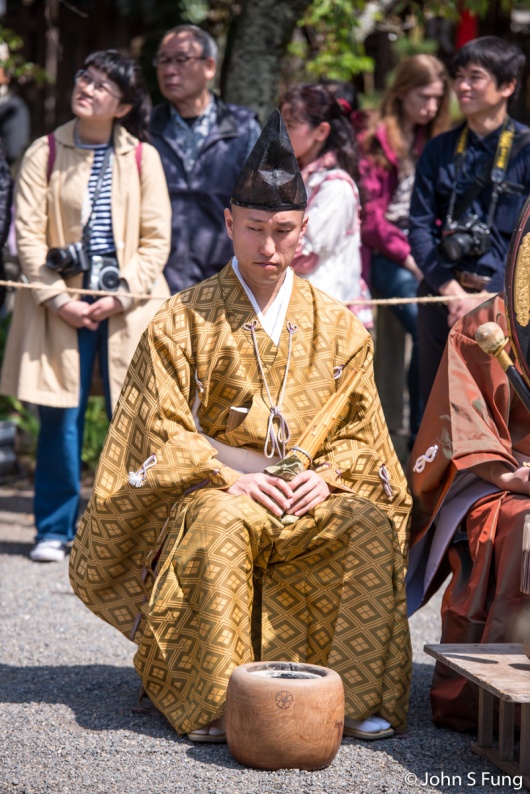
笙 Sho ⇑⇓ The shō (笙 )is a Japanese free reed musical instrument that was introduced from China during the Nara period (AD 710 to 794).



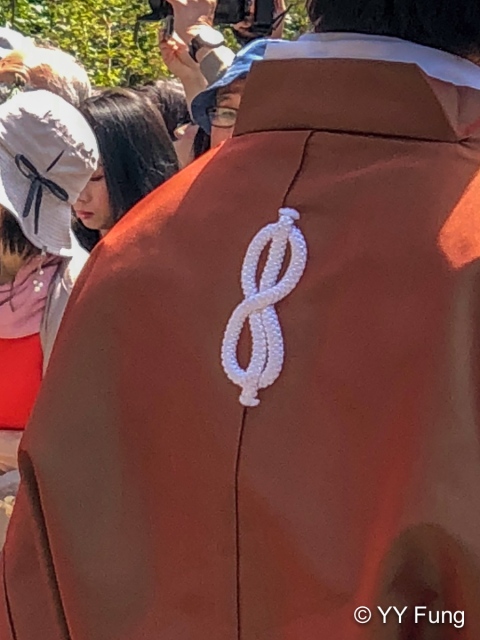
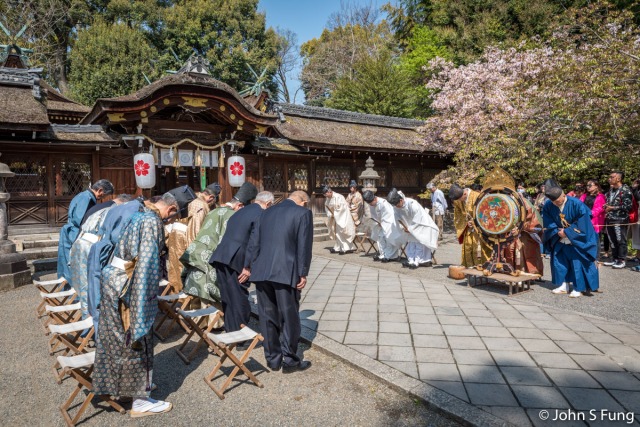
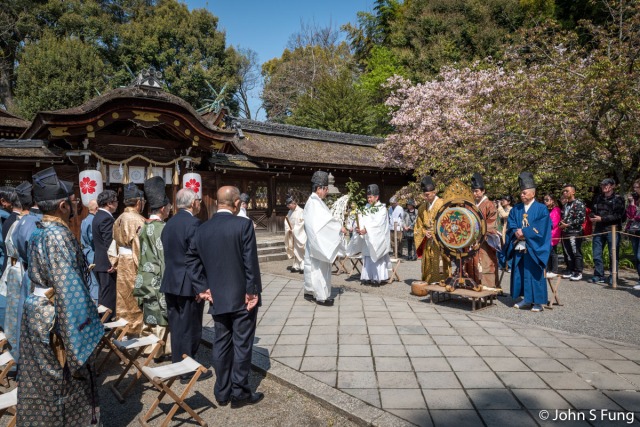
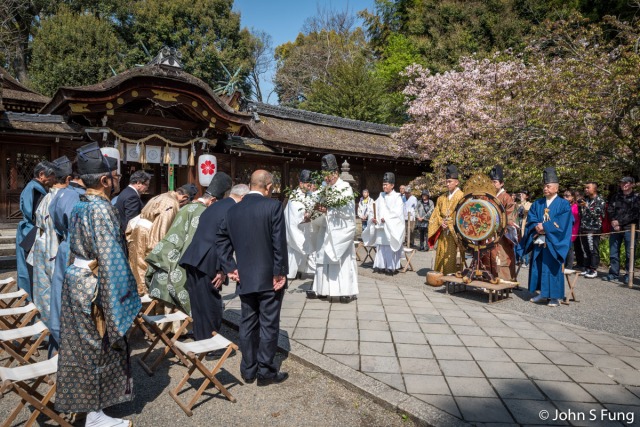
Wikipedia: Originally the kannushi were intermediaries between kami and could transmit their will to common humans. A kannushi was a man capable of miracles or a holy man who, because of his practice of purificatory rites, was able to work as a medium for a kami. Later the term evolved to being synonymous with shinshoku, that is, a man who works at a shrine and holds religious ceremonies there.
維基百科: 神職是日本神社的祭司,也叫神主。神職在神道中是神與人之間的媒介,他們也負責替信徒祓除與主持婚禮並管理神社一般事務。在遠古時代因政教合一,因此氏族首領也是神官,到後來才有專門的神職。在日本和平憲法成立前,國家神道的神官是公務員,他們分五級(淨階、明階、正階、權正階、直階)。

⇑⇑ A kannushi (神主) was performing a purification ritual.
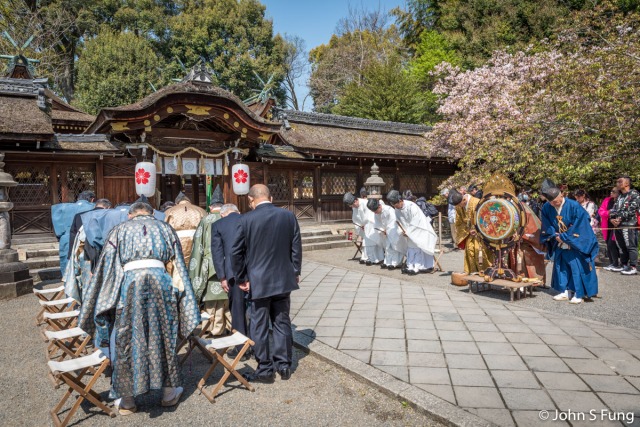

⇑⇓ With the help of other priests, the principal priest was working inside the honden to have the kami transferred to the portable shrine in the 拝殿 (Kasuga-den).
⇑⇓ 由輔祭師幫助下,主祭司進入本殿,恭迎神祗移駕拜殿的鳯輦中。
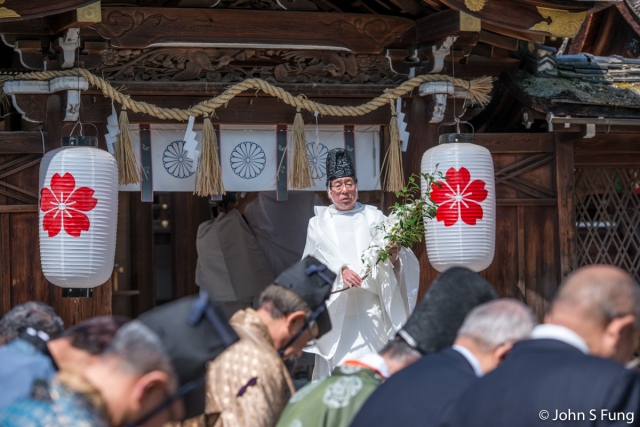
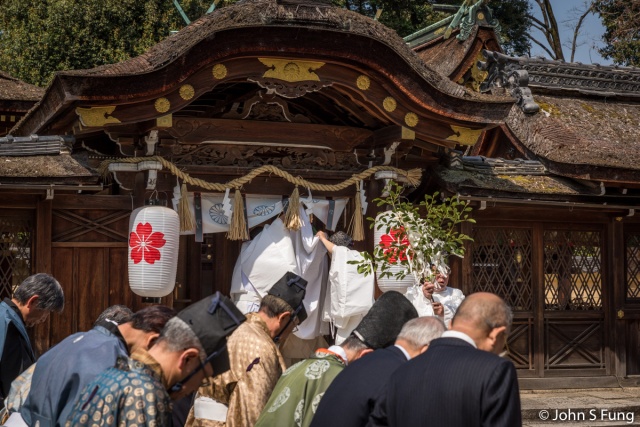
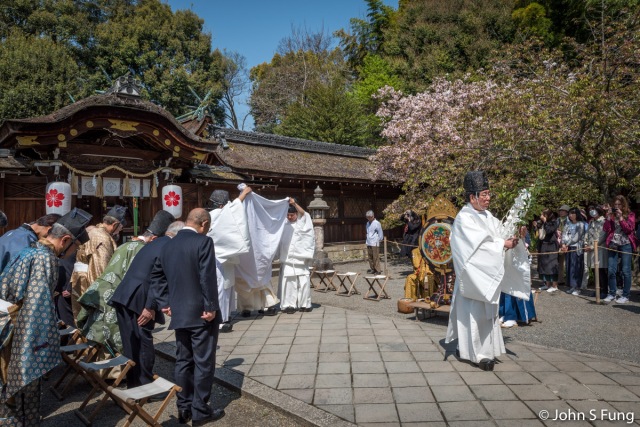
⇑⇓ A divine soul is being transferred by the principal priest (wrapped around by a piece of white cloth holding by two other priests) to the portable shrine. According to official website of Hirano Shrine, there are a total of four deities residing in Hirano Shrine. I don’t know which deity was or all of the deities were being transferred to the mikoshi, a divine palanquin, so as to join the procession to be held later that day.

Unlike the parade of god/gods and devotees in Taiwan and Hong Kong, Shinto Kami (gods) seldom show their images to the public. Some say shinto shrines virtually do not have images, but they may have symbols.
兩位輔祭司高舉白色布塊,維著向拜殿行進中的主祭司和神袛。一般神社內,神祗鮮有以任何形象示於公眾(有說有用一面銅鏡子代替),有別於台灣、香港,巡遊中的神像公開見於公眾。
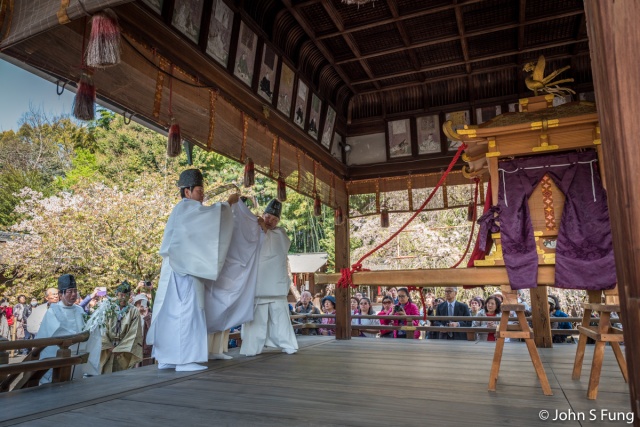

⇑⇓ A mikoshi serves as the vehicle to transport a deity. Note the principal priest is being wrapped around to prevent the public from seeing the Kami.
⇑⇓ 此照顯示主祭在鳯輦前進行請神入神輿的最後一步。完畢後,第一部份神道儀式完成。
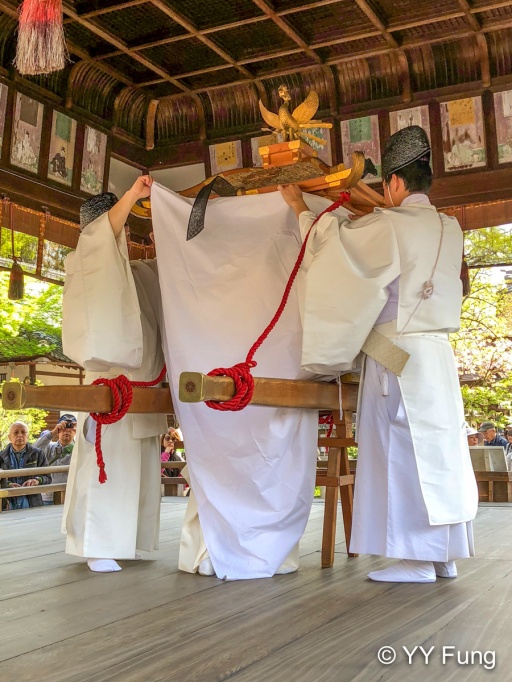
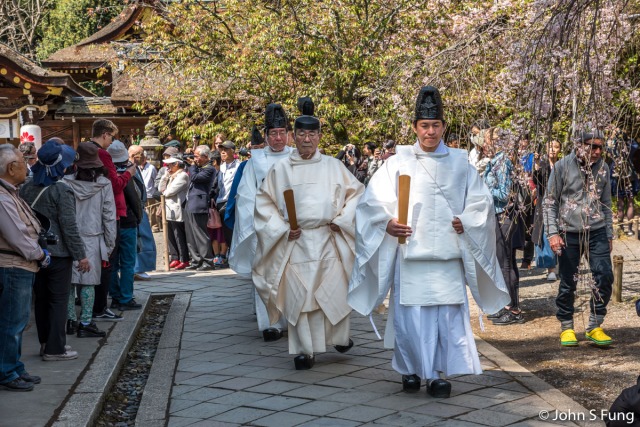
What interests me so much about Japan is how they have been able to keep the tradition alive for such a long time without major changes. I was told that these dresses for the Shinto priests remain more or less the same since they were adopted from the court of Tang Dynasty in China, more than a thousand years ago.
我對日人保持的傳統文化特別有興趣,因為他們對細節的執著和堅持,而且很多的制式,無論是建築、服飾及其他方面是借鏡自中國唐朝,雖然歴經千年,仍然能讓我們得窺唐代文化的一鱗半爪。
*************************************************************************************
Part 3 of the Shinto ceremony. This part of ceremony is known as hatsurensai (発輦祭 はつれんさい). All the parade participants gathered in front of honden for the purification and blessing act from the priest. The Oka-kai parade began after the completion of this ceremony.
桜花祭神道儀式第三部份:此部份為神幸列発輦祭(はつれんさい), 所以所有參加神幸祭的人員都會列隊於本殿參加淨化,驅邪, 神主獻上祝詞,祈求桜花祭完滿結束。
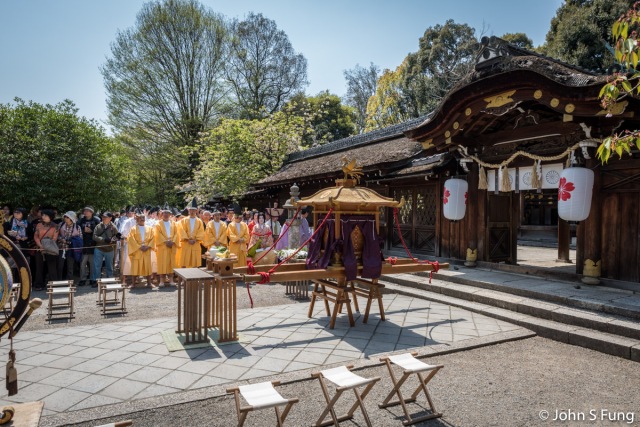
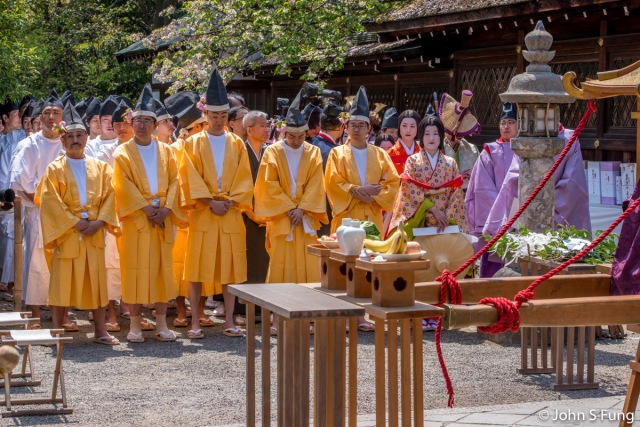
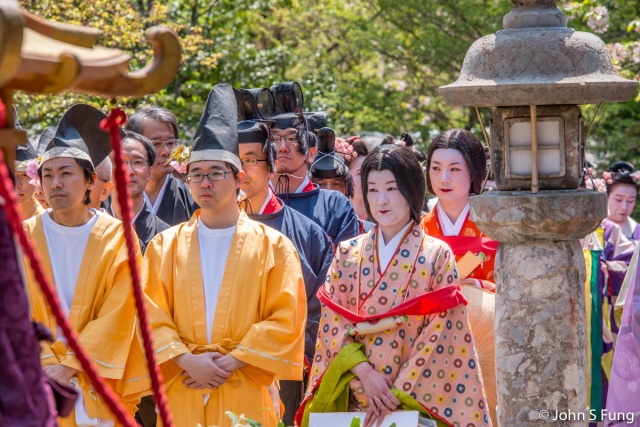

此時神主換下了白色斎服/浄衣,改穿顯示位階的顏色正服.
Note that at this ceremony, the chief priest sitting on the right had changed their jōe (斎服 or 浄衣 “pure cloth” to their colored formal vestment (正服).
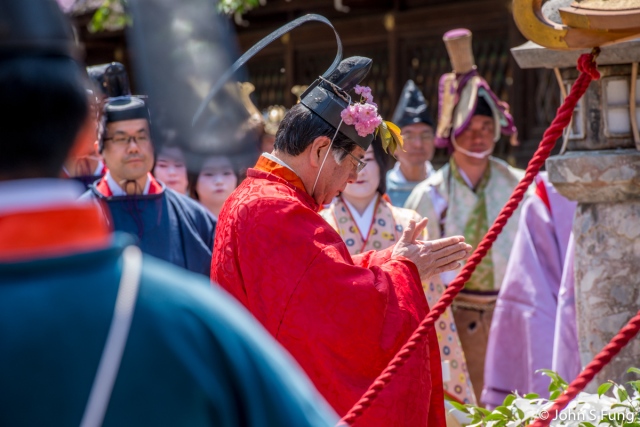
The priest dressed in red is believed to be the principal priest.
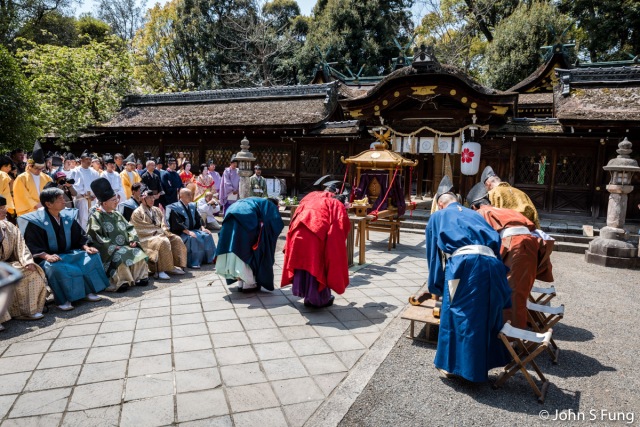
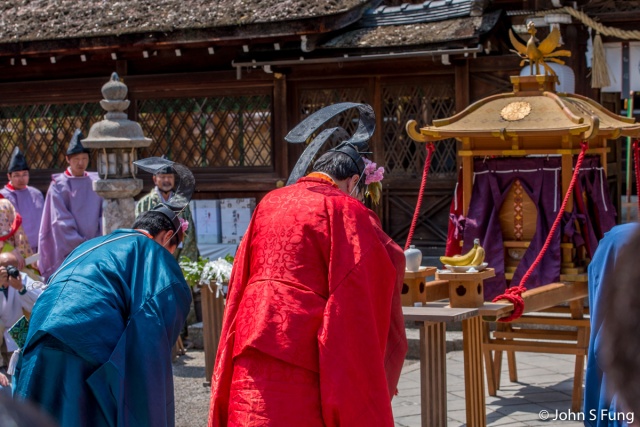
⇑⇓ Note that the priests were wearing kanmuni, the classic court cap, imported from China where it is known as the guan. 此圖清楚顯示神主所載的冠,據說就是引至唐皇朝。
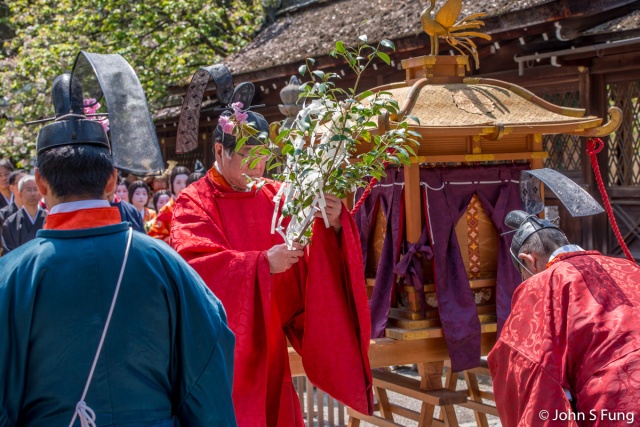
The principal priest was performing a purification ritual, using 玉串 (tamagushi), which is made up of サカキ 榊(sakakiさかき, a branch of evergreen ) + 紙垂 paper streamer ( shide, しで , a zigzag-shaped paper streamer), bound with hemp (麻, おぬさ).
神主手持玉串(榊木+紙垂)淨化。

⇑⇑ Saying a prayer for a successful completion of the Oka-kai parade. 獻上祝詞。
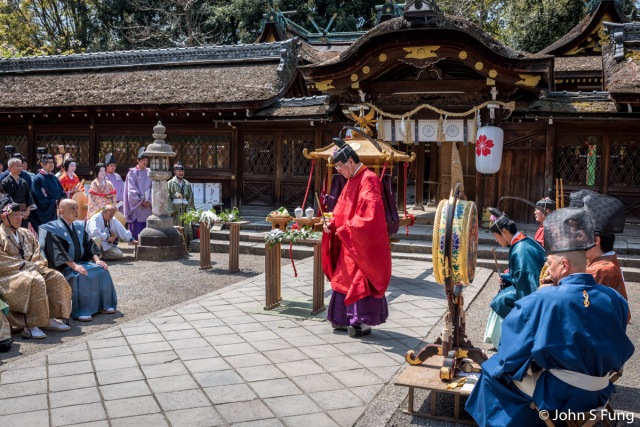
⇓⇓ Note that all the kannushi were holding a tablet called shaku.
Wikipedia: Shaku (笏) or Hu (Chinese: 笏) is a ritual tablet or flat scepter of Chinese origin, which is used in Japan and also currently or historically in China, Korea, Vietnam and Ryukyu.
⇓⇓ 神主手上各持笏。笏亦引至中國,據說東亞文化圈的韓國、越南和琉球舊日皆有用笏。

It is said that the color and pattern of the robe is keyed to rank. As shown above, the first priest, wearing a dark blue (紺色) formal vestment, is believed to be of third or fourth rank while the second and third priests in red (赤色) are believed to be of second rank (it is said that priests of first rank wear black vestment). Those behind wearing ebōshi (立烏帽子) are musicians.
據悉,神道祭司除平常穿著的常服外,祭典儀式穿著服裝有素白的斎服和有顔色的正服。帽子則有立烏帽子和冠。神主的正服顔色顯示其品階,第一級穿著玄黑色正服,第二級穿著赤色,第三、四級穿紺色(深藍色)。
*************************************************************************************
** FYI: ⇓⇓ Hirano Shrine official website: 平成30年の台風21号による被害により、平野神社 拝殿の倒壊をはじめ. Taiphoon No.21 of 2018 caused extensive damages to Hirano Shrine. Haiden collapsed on September 4th as a result of the destructive force of the typhoon. The area is closed until further notice. 平野神社:拝殿倒壊、当面境内立入禁止。
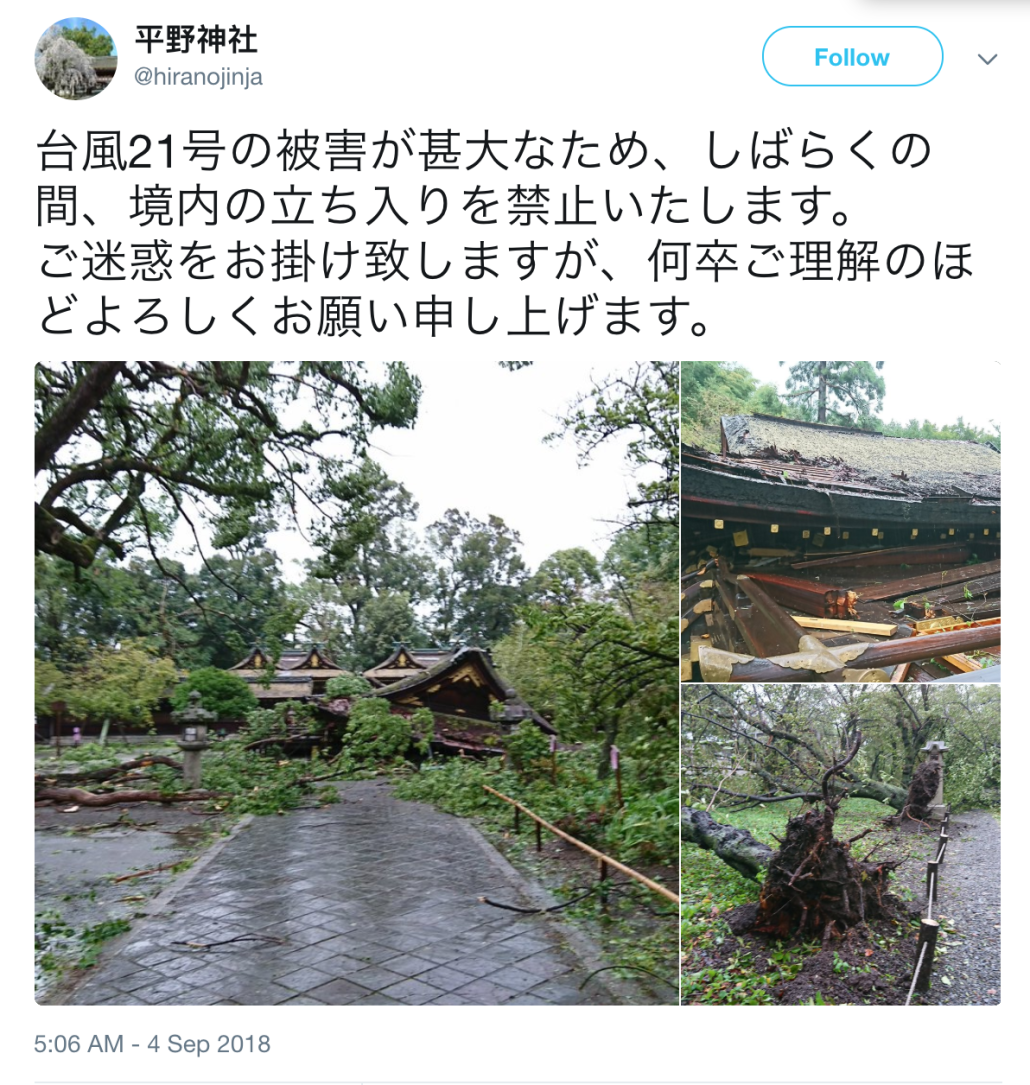
Hirano Shrine series:
4.1-6 平野神社の桜(1) Hirano Shrine (1)
4.10- 1 平野神社の桜(2) Hirano Shrine (2)
4.10- 2 平野神社 – 桜花祭 1 Hirano Shrine Oka-sai (おうかさい Sakura Festival)
4.10- 3 平野神社 – 桜花祭 2 Hirano Shrine Oka-sai (おうかさい Sakura Festival)
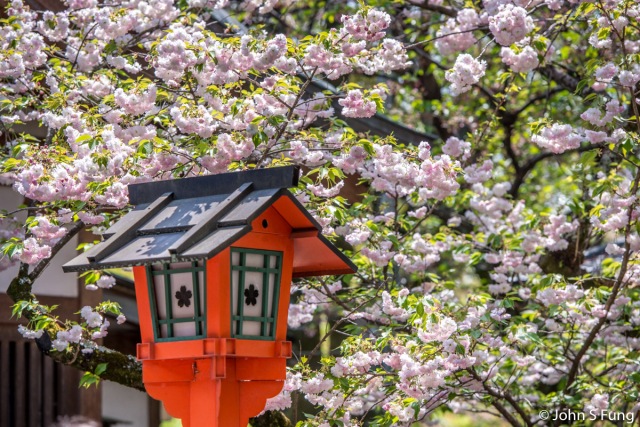
If you are looking for my Kyoto cherry viewing tour 4.9, please kindly be informed that there is no 4.9 because April 9th was a rainy day, we spent most of the day staying in our hotel’s laundry room.
We were so lucky that the weather on 4/10 was sunny, good weather for parades. We first visited Hirano Shrine on 4/1 (see Hirano Shine (1) ), early bloom cherry blossoms were in mankai (full bloom), particularly near the torii and the approach to the main gate. This (4/10) was our second visit, mainly for the sakura festival parade (see my next two posts) and the late-bloom sakura varieties. I have to confess that I’d paid more attention to the ceremony in front of the shrine and the parade held later and not-as-much time for the sakura. However, with the help of my wife, we were able to have taken some pictures of the late-bloom sakura, here are what we’ve got.
看官, 如果你在找京都賞櫻行“之九” (4.9), 很抱歉, 這一輯沒有”之九”這一章, 因為四月九日是雨天, 而且很多景点的櫻花早已落光了, 所以只好留在酒店的洗衣房洗衣服。是日(4.10) 天朗氣清, 惠風和暢, 是看廟會的好日子, 我們來看平野神社的桜祭神幸祭。其實我們在到京的第一天(4.1) 就去過平野神社 (平野神社之櫻(1)) , 那天鳥居附近、東門前的魁櫻開得爛漫。今天的重頭戲是桜祭的巡行隊伍, 這些穿古裝的人物特別吸引我。在本殿前的儀式 (10:00) 和遊行 (13:00) 之間有一点時間, 所以也去看看那些遲開的櫻花品種。
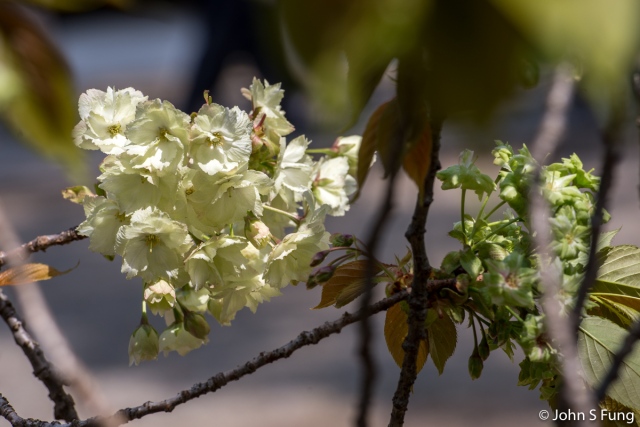
⇑⇓ 鬱金 Ukon(うこん)
⇓⇓ 御衣黃櫻(較稀有品種) Gyoiko cherry (said to be a rare variety)

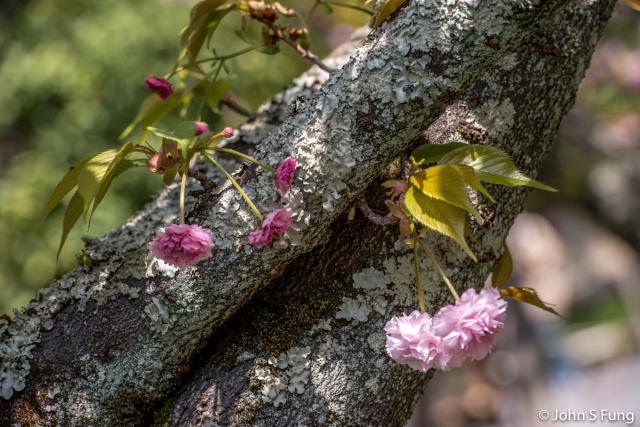
⇑⇓ 突羽根櫻 Tsukuhane cherry (つくはね櫻 ) , bloom late-April
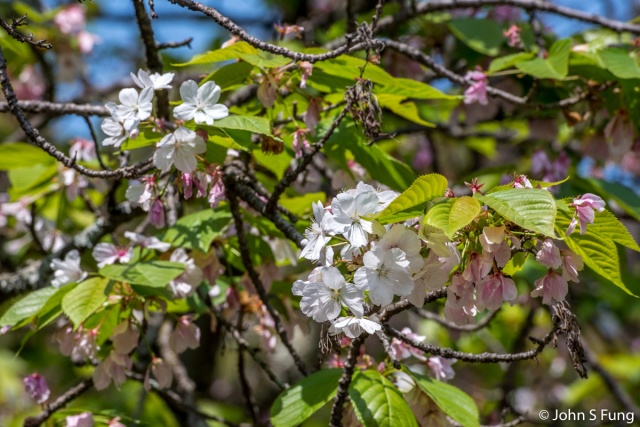
⇑⇑ 白雲櫻 Shira kumo (white cloud) sakura
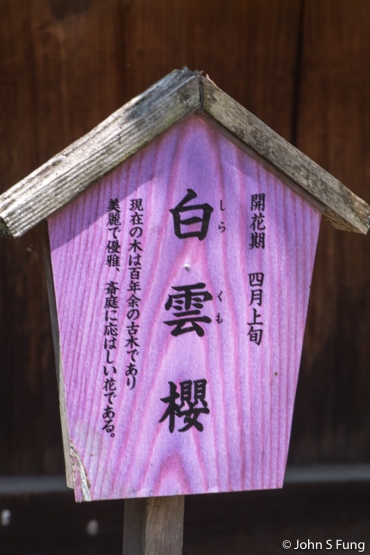
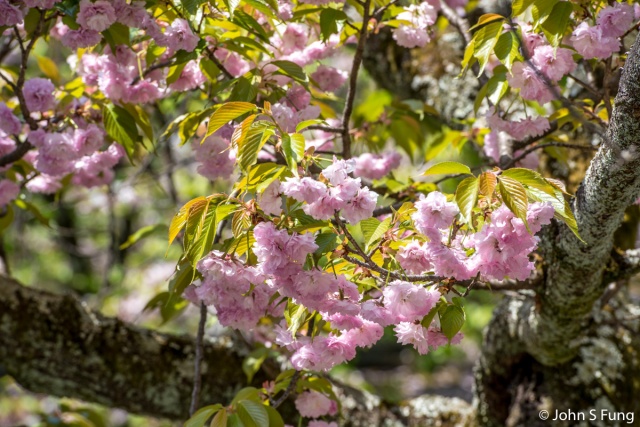
⇑⇓ 平野妹背櫻 Hirano imose sakura (ひらのいもせ櫻), one of Hirano Shrine’s representative variety, bloom mid-April to late-April
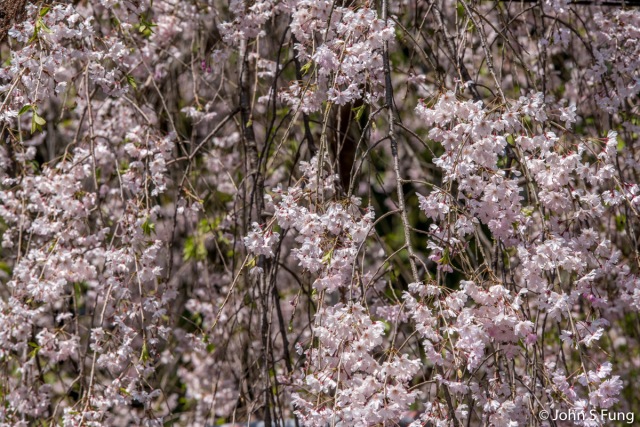
⇑⇓ 八重紅枝垂 Variety – yaebani shidare (literally means: eight layers red weeping cherry) , bloom mid-April
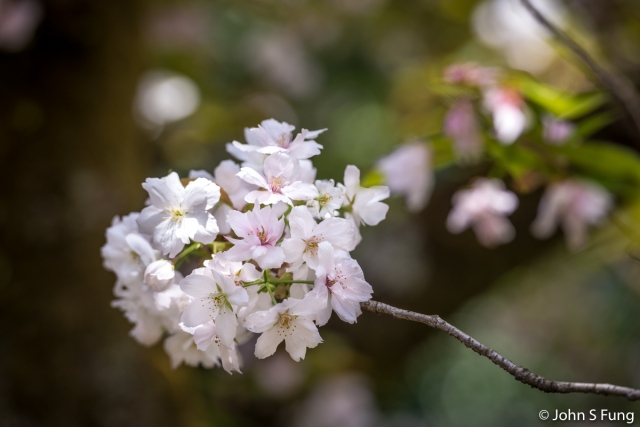
⇑⇓ 衣笠 (Kinugasa きぬがさ) original from Hirano Shrine, bloom mid-April.

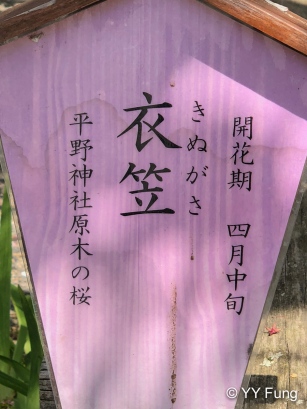
⇑⇓ 衣笠 (Kinugasa きぬがさ) original from Hirano Shrine, bloom mid-April.
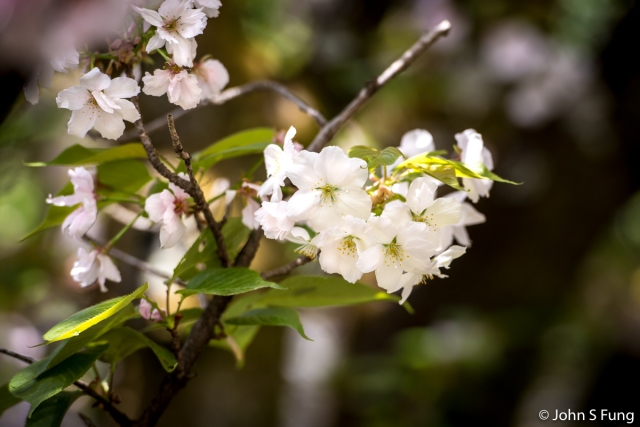
⇑⇓ 衣笠 (Kinugasa きぬがさ) original from Hirano Shrine, bloom mid-April.
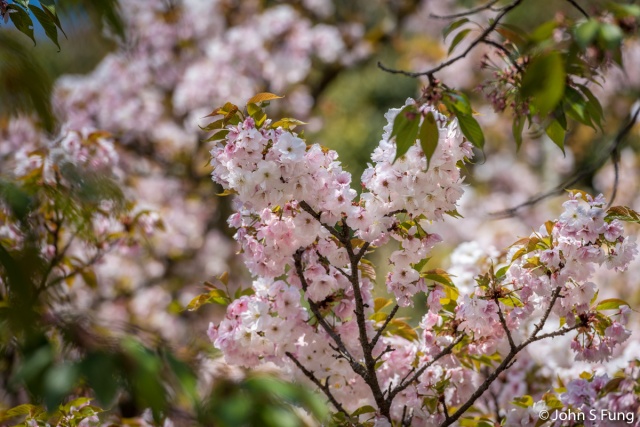
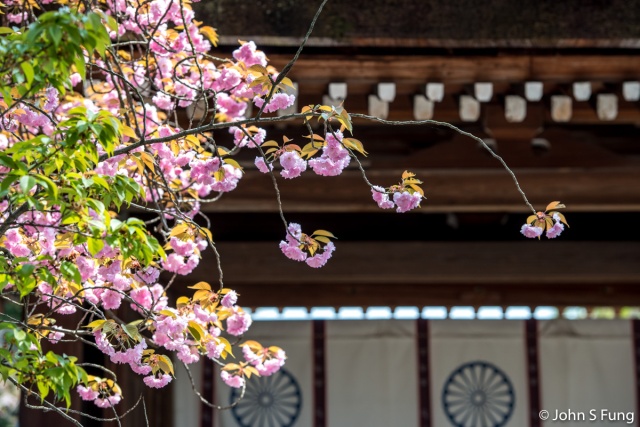
⇑⇓ おけさ Okesa variety (bloom mid-April)
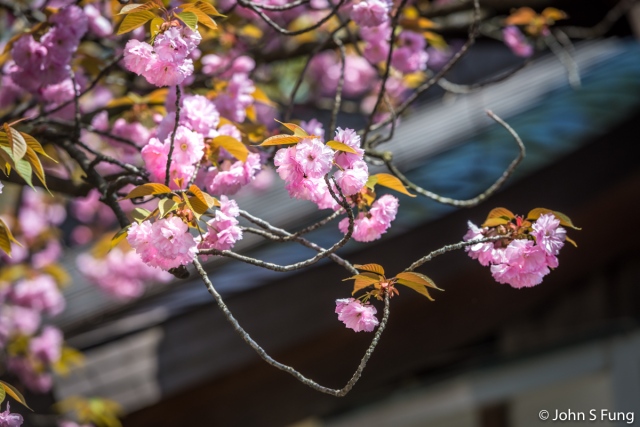
⇑⇓ おけさ Okesa variety (bloom mid-April)
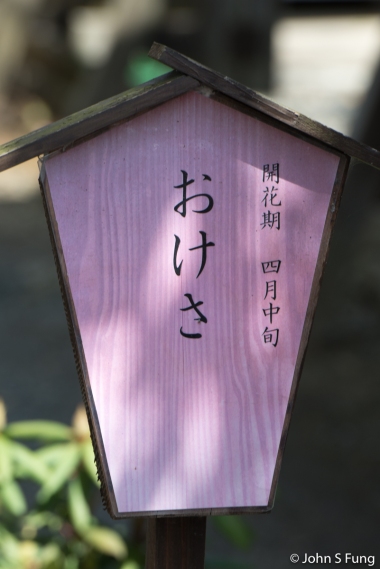
⇑⇓ おけさ Okesa variety (bloom mid-April)

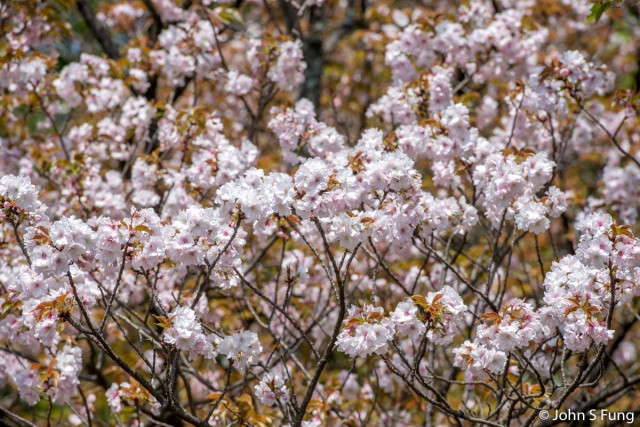
楊貴妃 (よう きひ) yookihi sakura

⇑⇓ 楊貴妃 (よう きひ) yookihi sakura, named after Yang Guifei, the beloved consort of Chinese Emperor Xuanzong of Tang Dynasty (bloom mid-April to late-April).
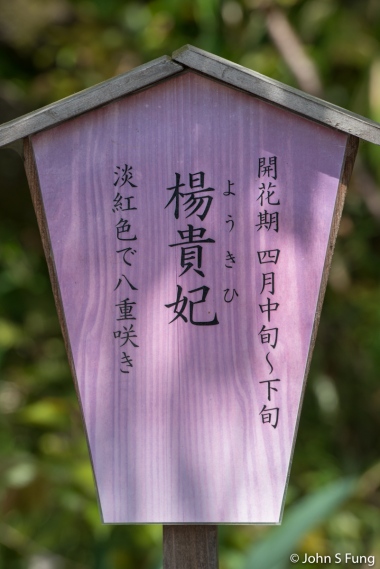
Hirano Shrine series:
4.1-6 平野神社の桜(1) Hirano Shrine (1)
4.10- 1 平野神社の桜(2) Hirano Shrine (2)
4.10- 2 平野神社 – 桜花祭 1 Hirano Shrine Oka-sai (おうかさい Sakura Festival)
4.10- 3 平野神社 – 桜花祭 2 Hirano Shrine Oka-sai (おうかさい Sakura Festival)
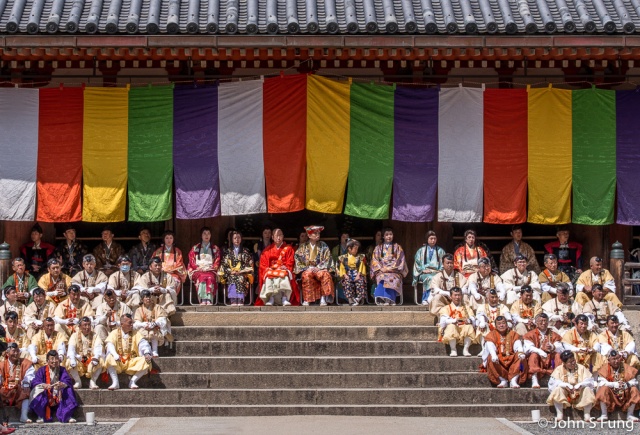
「豐太閣花見」 是醍醐寺每年舉行的「豐臣秀吉太閣賞櫻會」歴史盛會的重演,是櫻花季的高潮, 通常在四月的第二个星期天举行, 約有150表演者参與。四月八日上午我們先去京都御所看櫻花(京都御所出水の小川), 再到醍醐寺。我們低估了交通時間, 豐太閣花見在下午一時舉行, 我們遲到了30分鐘, 前面由書院到金堂的行列行進就錯过了, 幸好金堂前的主要表演還未開始。参與花見的表演者都穿上古裝, 日本人做事認真, 看起來好像真的復古了。豐臣秀吉1598年舉辦的花見會, 十分隆重, 首先斥巨資修復醍醐寺, 並移植700櫻花至寺的周邊、参道及寺內, 據說有賓客1500人, 進寺沿途還建立許多膳食處, 提供赴會客人及隨從之飲食。據說豐臣秀吉性好炫耀, 我想原來的「太閣花見」的規模和豪華的程度並非我能想像的。 醍醐寺介紹
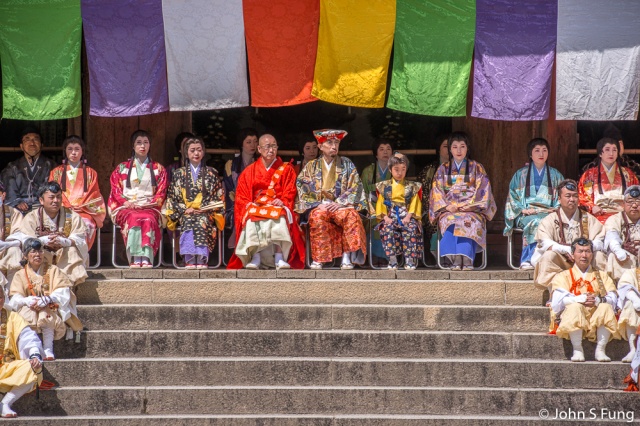
Ho-Taiko Hanami Gyoretsu (豐太閣花見) in Daigoji Kyoto is an event held during the cherry blossom season, the second Sunday every April to be exact. It is a re-enactment of the cherry blossoms viewing party held by Toyotomi Hideyoshi in 1598, about 150 people dressed in 16th century costumes to participate in this reenactment.
We had underestimated the time it took to go to Daigoji, we arrived at the Daigoji Kondo (金堂) 30 minutes after the scheduled beginning time of the procession (13:00), which was said to have started from the “Sanboin Karamon” (the Chinese gate outside Shoin) and paraded through the Nimon (Toshikado, South Gate) to the Kindo. By the time we were there, everyone had just finishing settling in their position. It seemed that we didn’t miss any of the performances except perhaps the poem reading. A variety of different shows performed by local artists and students (shown below). When the performance was done, all the participants, once again, lined up and proceeding back to Shoin in an orderly succession.
This magnificent procession was meant to recreate the atmosphere of the famous large cherry viewing party held by Hideyoshi Toyotomi on this site in 1598. Well, it did, but only to a certain extent, the first Hanami Gyoretsu had 1300 guests, it is said to be the largest tea party of all time in Kyoto. In the 1598 party, performance was not limited to those at the Kondo but along the approach to Daigoji. In order to throw such an extravagant party, Hideoyoshi ordered a total of 700 cherry trees of different varieties be moved or planted to the vicinity of Daigoji, set up tea houses along the way of the approach to provide catering for his guests. He had also financed the rebuilding or renovation of some of the buildings in Sanboin before the party. It is said that Hideyoshi was a rags-to-riches and known for his flauntiness of power and wealth, I believe the luxuriousness of the lavish party was something beyond my imagination. Guide to Daigoji
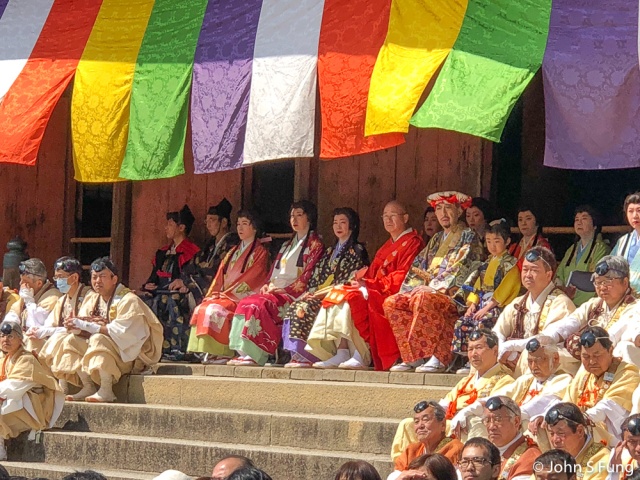
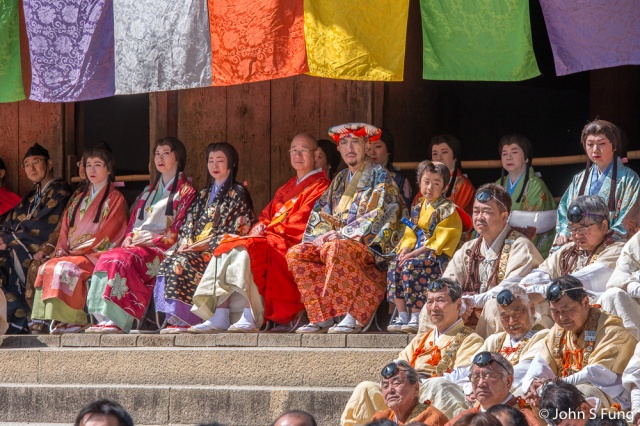

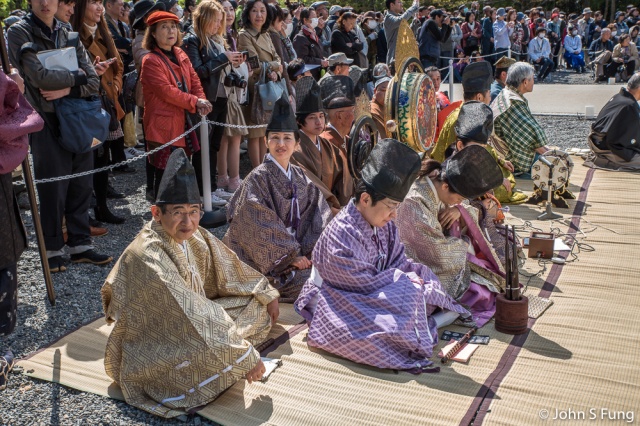
Performance:

雅樂(雅楽、ががく)意指「雅正之樂」,是日本興盛於平安時代的一種傳統音樂,也是以大規模合奏型態演奏的音樂。樂曲以器樂曲為多,至今仍是日本的宮廷音樂,是現存於世界最古老的音樂形式。
Wikipedia: Bugaku (舞楽, court dance and music) is the Japanese traditional dance that has been performed to select elites mostly in the Japanese imperial court, for over twelve hundred years. In this way, it has been known only to the nobility, although after World War II, the dance was opened to the public and has even toured around the world in 1959. The dance is marked by its slow, precise and regal movements. The dancers wear intricate traditional Buddhist costumes, which usually include equally beautiful masks. The music and dance pattern is often repeated several times. Wikipedia – Bugaku
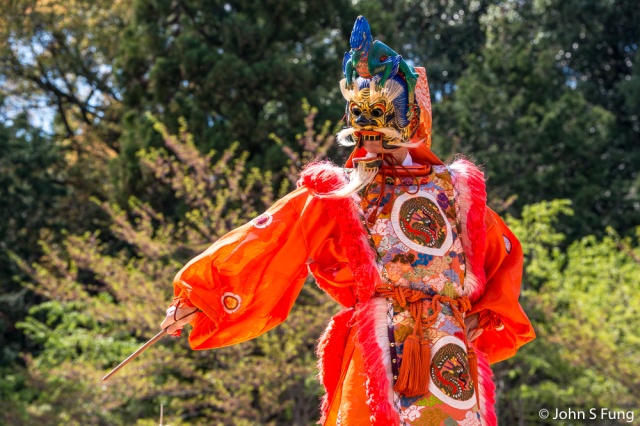
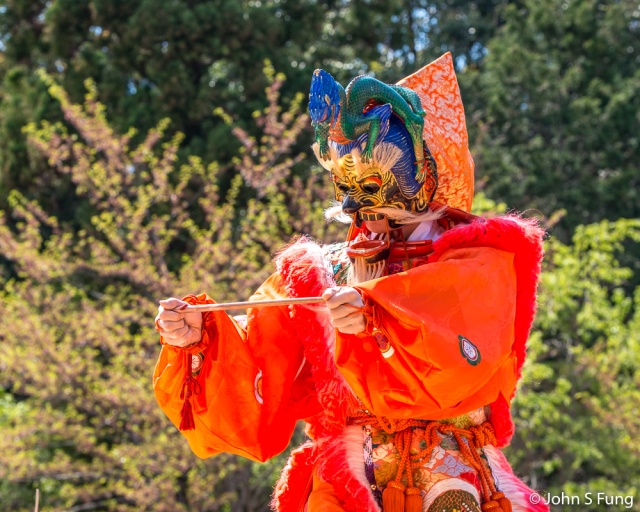
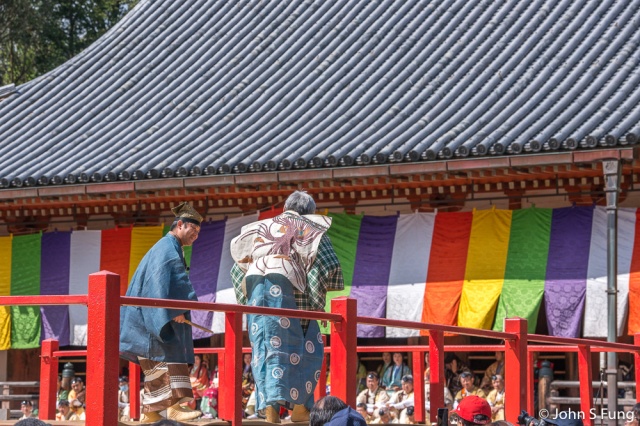
⇑⇓ 茂山狂言 (きょうげん): 維基百科- 是日本戲劇的一個流派。它與能劇一道,從猿樂衍化發展而來,狂言與能劇同屬於日本四大古典戲劇之一。狂言是一種內容簡單而即興的喜劇。在語言方面狂言大量運用民間的俚語。而內容上則一般取材於民間題材,並運用諷刺的手法尖銳的抨擊了武士或者貴族。也正因為如此,狂言比起能劇更受到平民們的歡迎,漸漸發展成一種最為典型的民間藝術形式。….有別於能劇,狂言師在表演的時候穿黃色的襪子,而並非白色。
「狂言」是日本四大古典戲劇之ㄧ,與「能」合稱為「能樂」「狂言」是一種內容簡單而即興的喜劇,是從散樂滑稽表演派生出來的,大量採用民間俚語,劇本用中世紀口語寫成,對十二到十六6世紀的庶民活動有生動描述,內容上一般取材於民間題材,因此,「狂言」比起「能」更受到平民歡迎,漸漸發展成一種典型的民間藝術形式。
Kyōgen (狂言, “mad words” or “wild speech”) A form of traditional Japanese comic theater. It developed alongside Nō, was performed along with Nō as an intermission of sorts between Nō acts on the same stage, and retains close links to Nō in the modern day; therefore, it is sometimes designated Noh-kyōgen. Its contents are nevertheless not at all similar to the formal, symbolic, and solemn Nō theater; kyōgen is a comic form, and its primary goal is to make its audience laugh.

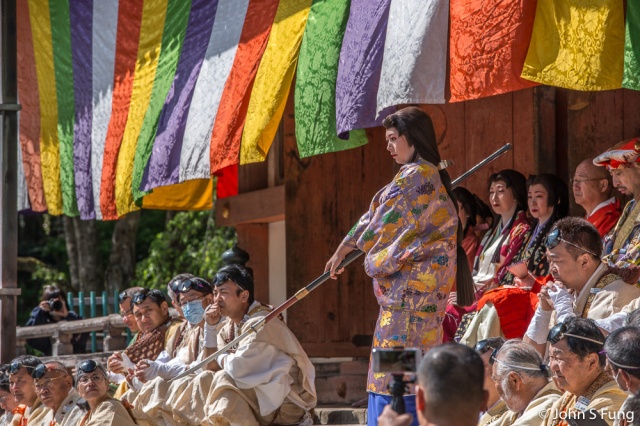
⇑⇓ 淀殿: 淀殿(日語:淀殿/よどどの Yodo Dono,1567年-1615年6月4日),本名為淺井茶茶,父親是日本戰國大名淺井長政,母親是織田信長之妹織田市。她是豐臣秀吉的側室,為秀吉生下鶴松與秀賴兩個兒子(維基百科)。 ⇑⇑ 不知這是歴史事件, 抑或是情節。花見中有武士突然襲擊, 淀殿持羅刀護夫。
⇑⇓ Yodo-dono: Yodo-dono (淀殿) or Yodogimi (淀君) (1567 – June 4, 1615) was a concubine and second wife of Toyotomi Hideyoshi, the mother of his son and successor, Hideyori. She was also known as Lady Chacha (茶々). (Wikipedia)
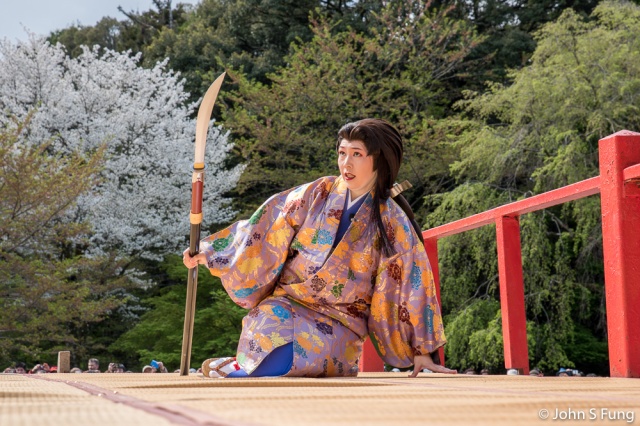
⇑ 双拳難敵四手, 淀殿单刀難敵四武士, 此時時⇓伊達政宗(Date Masamune)拔刀相助。
Not sure if this was a true story. During the hanami, Toyotomi Hideyoshi was attacked by 4 samurais, Cha Cha (⇑) pickup a weapon to protect him. However, she was not able to fend off the attackers alone, Date Masamune (⇓) came to her rescue.
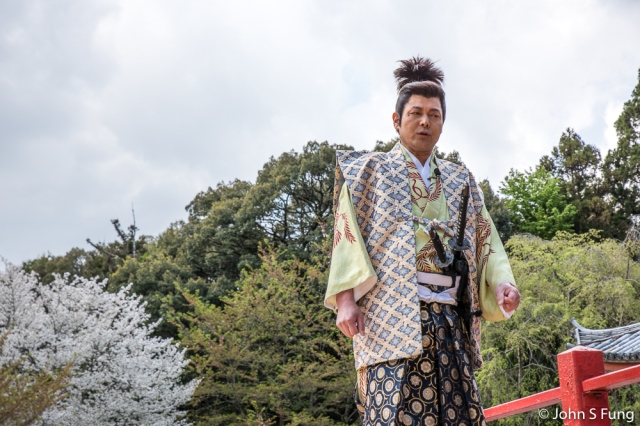
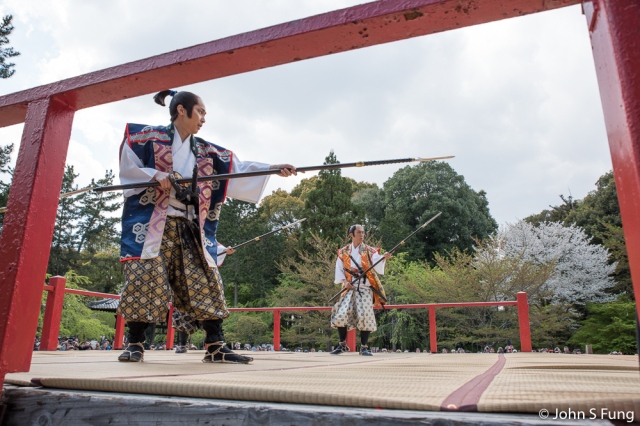
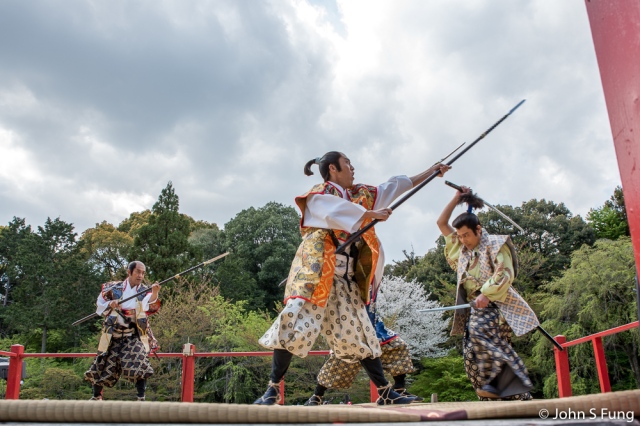
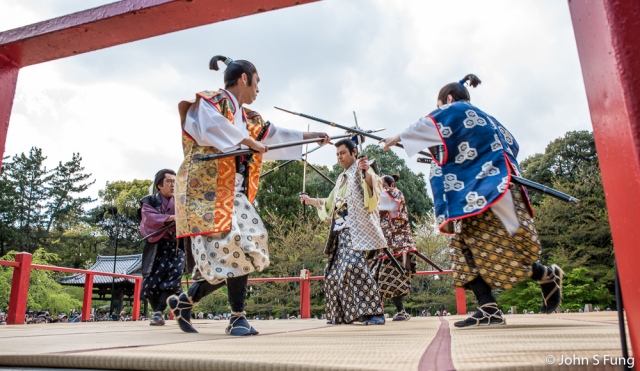

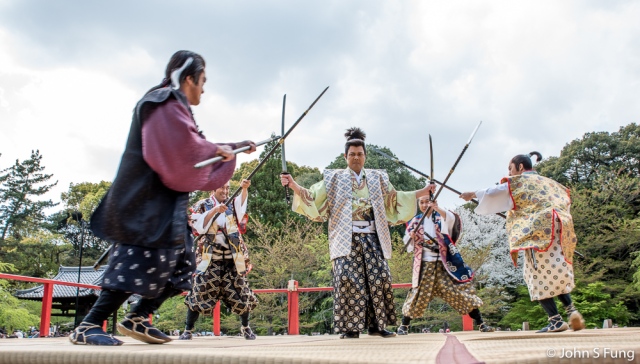

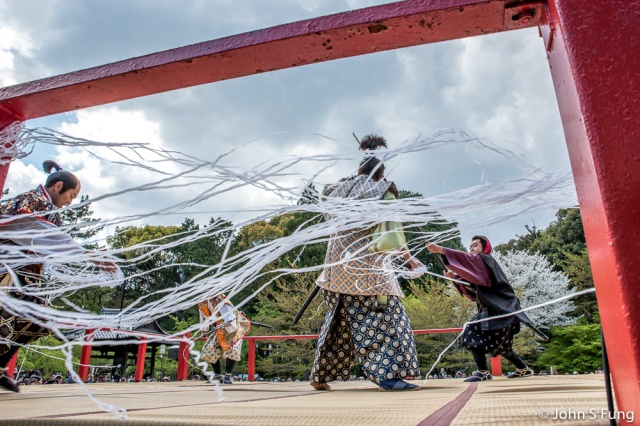




⇓⇓ 地元少女による踊り Local girls performing sakura dance.
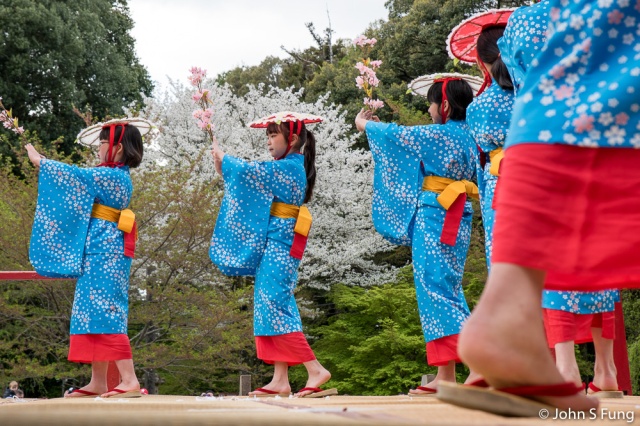
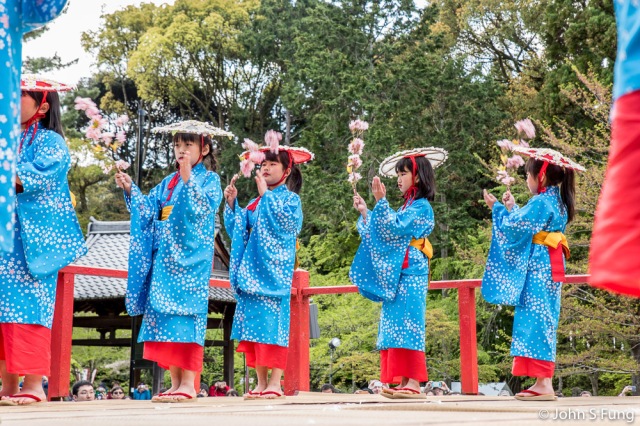

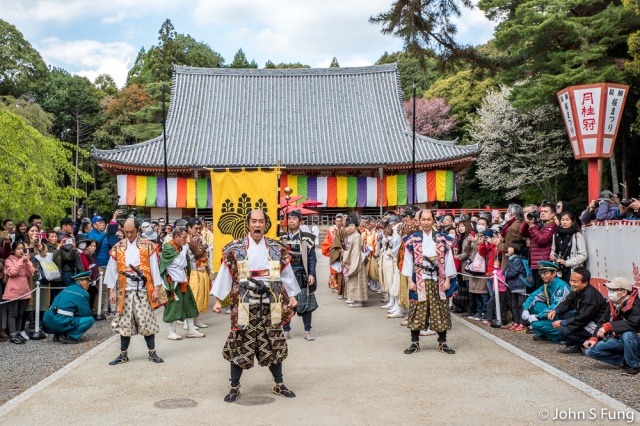
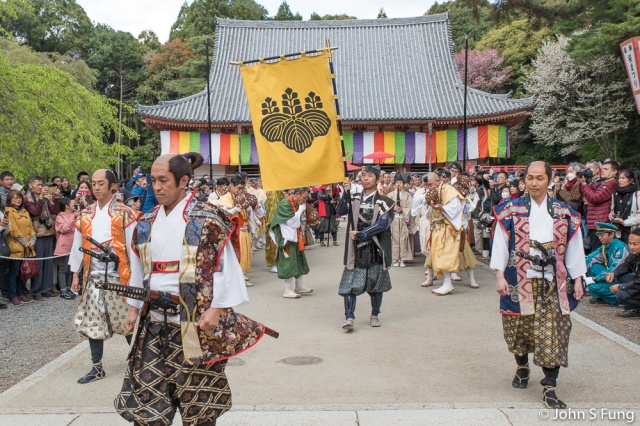

The procession marched to the sounds of conch shell horns. Wikipedia: In Japan this kind of trumpet is known as the horagai, which spread across Asia with Buddhism (first mentioned during the Heian period (794-1185 CE)).
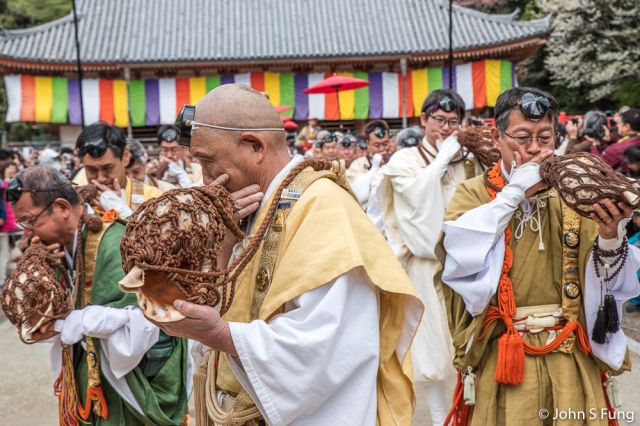

Wikipedia: Japanese horagai. A conch shell used for religious purposes or as a signal for samurai. See Horagai 法螺 and Triton’s trumpet or Triton snail
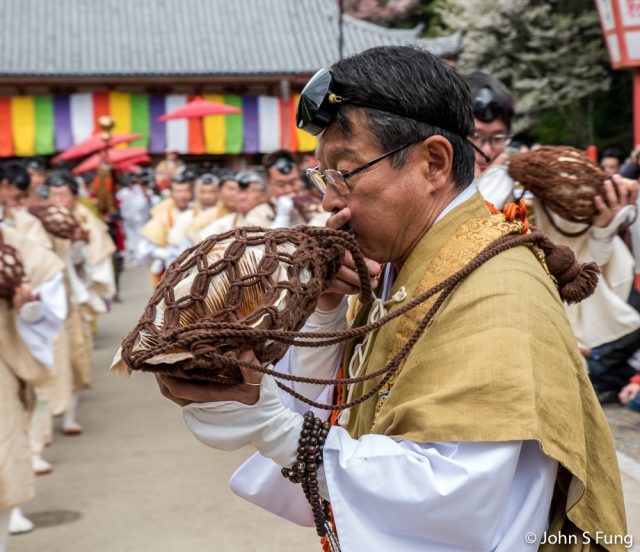
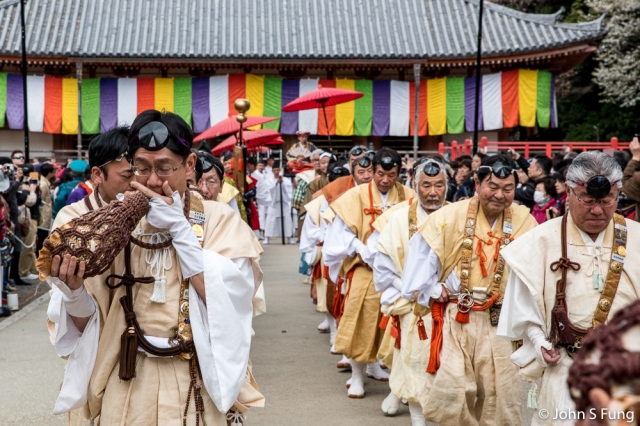

⇑⇓ 豐臣秀吉 Toyotomi Hideyoshi
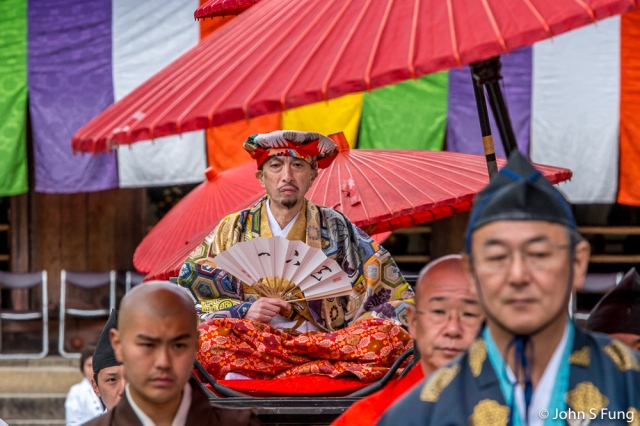

⇓ 豐臣秀賴, 豐臣秀吉之子 Toyotomi Hideyori (his son)
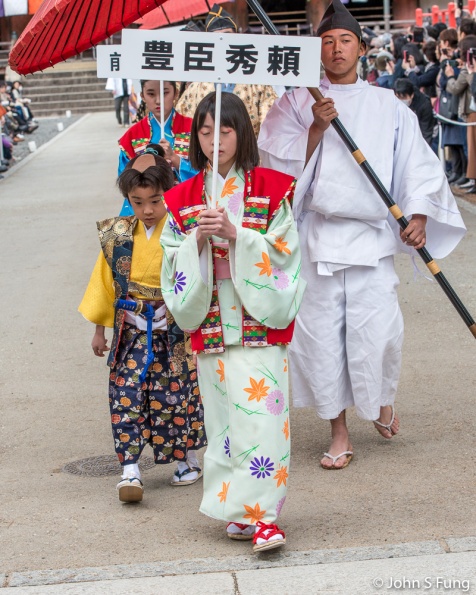
⇓ 北政所, 豐臣秀吉正室. Principal samurai wife of Toyotomi Hideyoshi, Nene (ねね)
⇓⇓ 淀殿茶茶,是豐臣秀吉的側室,豐臣秀瀨的生母。 Yodo-dono (淀殿) or Yodogimi (淀君) , mother of Toyotomi Hideyori (豐臣秀賴). also known as Lady Chacha (茶々). 
⇓ 孝蔵主(孝藏主), 北政所(高台院)的筆頭上臈 (~祕書),並得到秀吉相當的信任. An active figure in Toyotomi Hideyori’s time, said to be the secretary of Nene (ねね).

⇓⇓ 太夫是當時最高級的藝妓, 右京是官職. 右京太夫是啥, 還未查到。太夫 was the highest rank of geisha at that time, and 右京 refers to official position, couldn’t find any info about右京太夫 just yet.
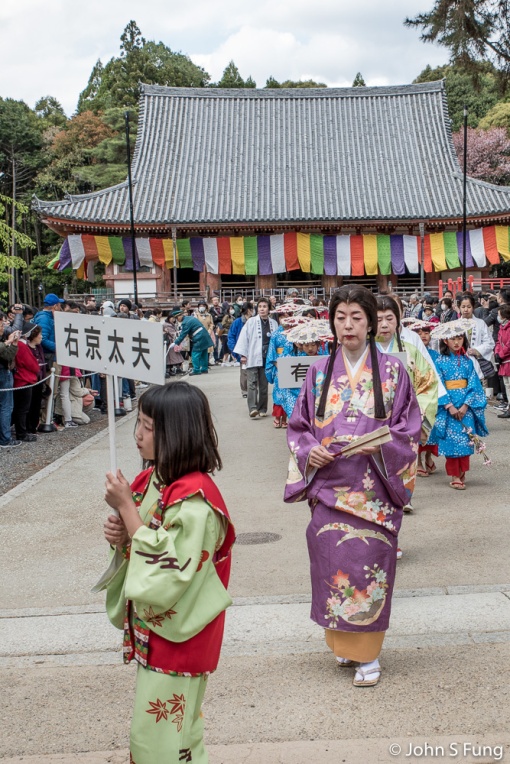
⇓⇓ 樂班: 笙 This lady is holding a shō (笙) which is a Japanese free reed musical instrument that was introduced from China during the Nara period (AD 710 to 794).
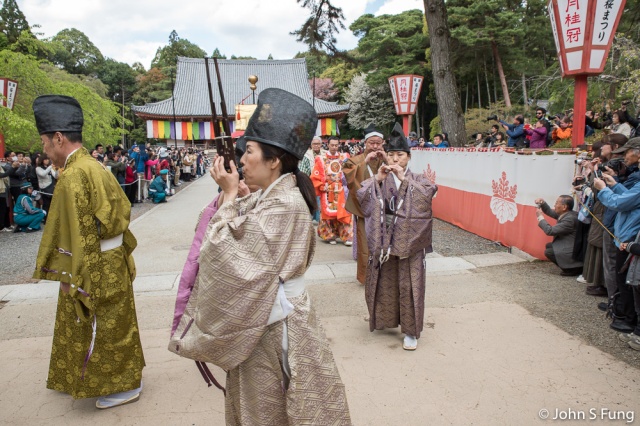
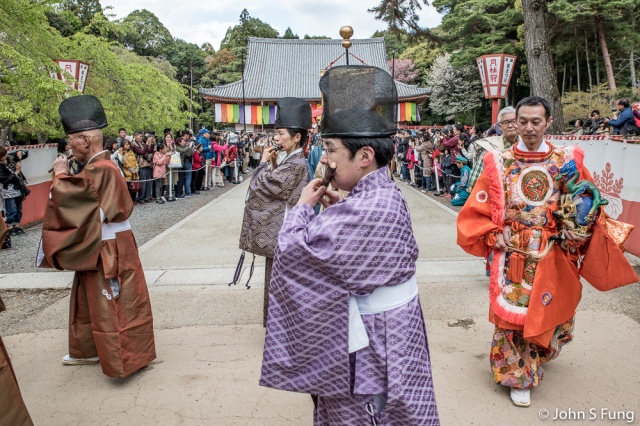
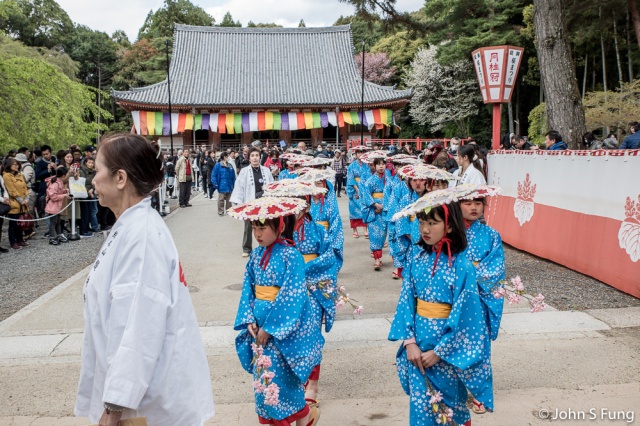
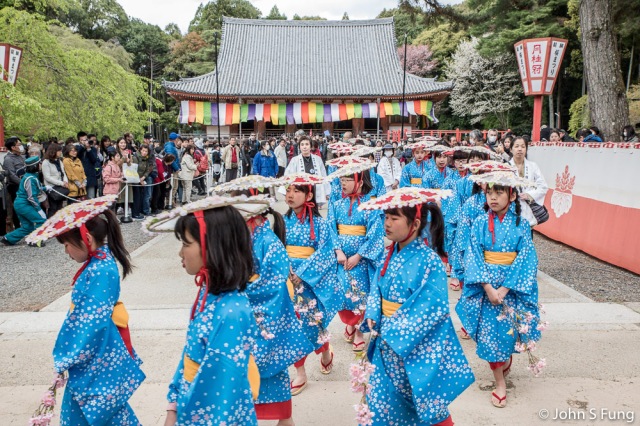
表演完畢後, 参加者再一次列隊, 魚貫而出, 我為了拍照, 緊跟其後, 不覺已離開了下醍醐區, 就連五層塔也沒拍一張照。今年樱花早開了七、八天, 所以早開的品種已落, 倒是靈宝館前的重瓣櫻正盛開。
We followed the procession and was unaware that we were leaving the Shimo-Daigo (the lower part of Daigo) area. Anyhow, I thought I would save the rest of Shimo-Daigo and Kami-Daigo (the upper part of Daigo) for next time. Most of the cherry blossoms we had seen during our last visit 6 days ago were gone, we walked to the Reihokan (museum), for the Yaezakur ( or double blossom which refers to any sakura variety with more than five petals) and the treasures displayed in the museum.
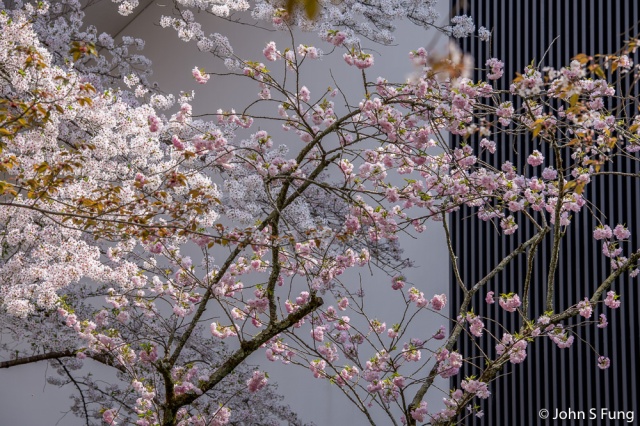
⇓⇑ 我們四月二日首訪醍醐寺, 先賞櫻, 下面幾張照片是那天以靈宝館為背景拍的。四月八日那天, 只見靈宝館前的重瓣櫻盛開。靈宝館是新建築, 但揉合了舊元素, 令人耳目一新, 但跟附近的古建築没有違和感。舘內藏品豐富, 約有珍宝十萬件, 那天展出很多古舊佛像, 很有看頭, 可惜不能拍照, 只留下很好的印象, 內容就成了過眼煙雲了。
⇓⇑ Sakura seen on 4/2/2018 outside the Resihokan (museum). I guess I was preoccupied with sakura, I realized later that I have not taken a good picture of the museum itself. It is a nicely constructed new building in the form of an old architecture.

⇑⇓ 我猜這些可能是染井吉野櫻(Somei Yoshino或山櫻 Yamazakura) 。 This is either the Somei Yoshino variety or Yamazakura.
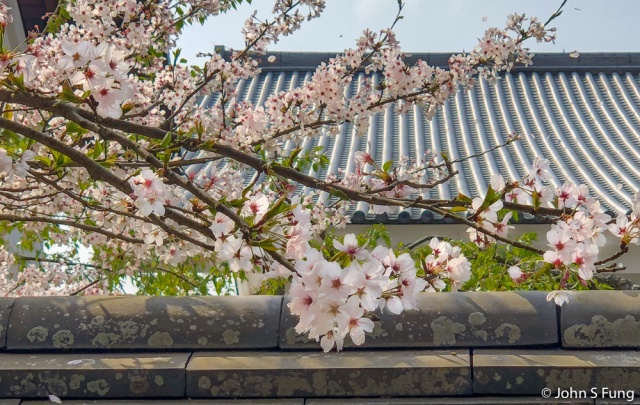
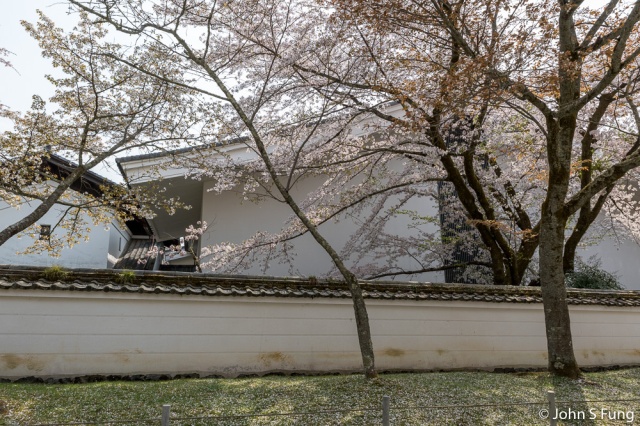
⇓⇓ 四月八日那天, 靈宝館前的重瓣櫻盛開。Sakura in front of the museum, on 4/8/2018, the day of Taiko Hanami Gyoretsu held. Most of the sakura seen on 4/2/2018 were gone, these are the Yaezakur ( or double flower which refers to any sakura variety with more than five petals). The museum has a handsome collection of Buddha images, unfortunately, photo is not allowed.
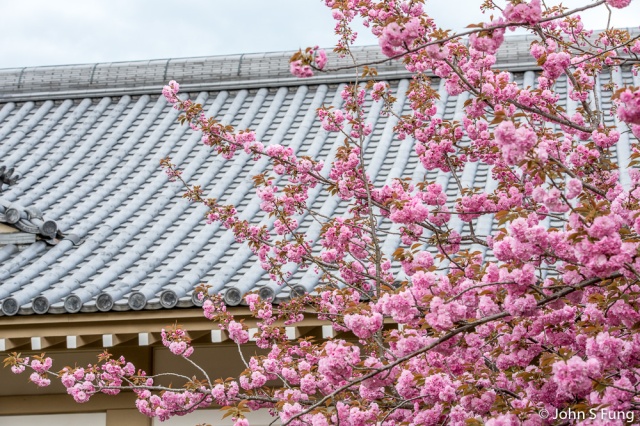
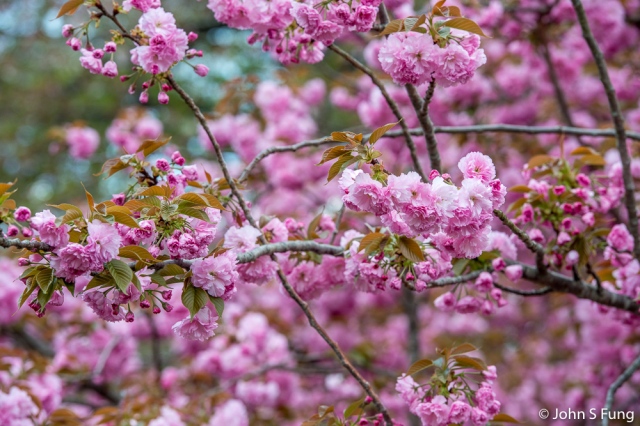
⇑⇓ 此重瓣櫻品種是關山櫻。 ⇑⇓ Variety – Kanzan かんざさん(關山)Prunus lannesiana cv. Sekiyama

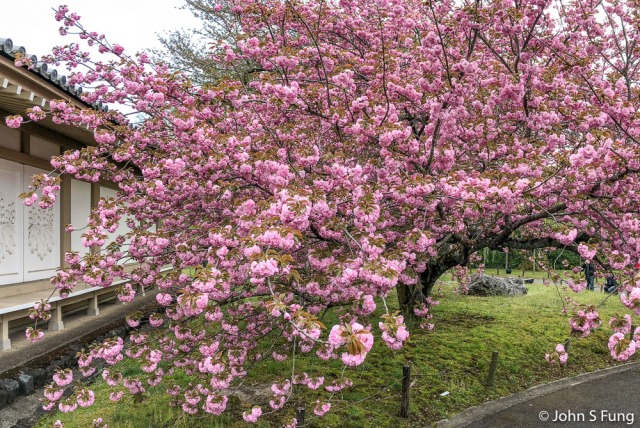
為了去逛靈宝館, 隨便在雨月茶室外的小攤吃了碗麵, 回到市区時飢腸轆轆, 一時也想不起吃什麽, 遂跑到高島屋去, 想那裡會有多些選擇, 没想到發現一鰻魚店, 他們有賣名古屋名物”ひつまぶし”。我坐下來, 跟服務員確認了是名古屋的鰻魚飯三食, 歡喜的下了單, 服務員說要等久一點喔, 我欣然應諾。來日本多次, 都是以觀光列第一位, 所以美食往往就有心無力了。這名古屋美食一直都没機會食, 這次誤打誤撞的吃到了。
I love historical re-enactment/parades, they are educational and recreational, Taiko Hanami Gyoretsu was definitely my cup of tea. Daigoji is famous for sakura and the fall foliage color as well. We had a light lunch that day, and we were eager for a good dinner. We went to Takeshimaya Department Store at Seijo to look for something to eat. We found an unagi (grilled eel) restaurant, and to my delightful surprise, they serve hitsu mabushi. This was a dish I really wanted to try, after making sure with our server that it was the famous dish originated from Nagoya, I patiently waited for my dish to come.
Chopped kabayaki eel on rice : Hitsu mabushi (1 grilled eel dish, 3 ways, or 4, to eat)
ひつまぶし(Hitsu mabushi). Hitsumabushi is said to have originated from Nagoya where cut up grilled eel was serve on a bed of rice in a wooden tub. Hitsu means ‘wooden rice bowl’ and mabushi means ‘to scatter, to put on’. However, when ordering, this dish is not to be mixed with hima tsubushi which means 暇つぶし=kill time.
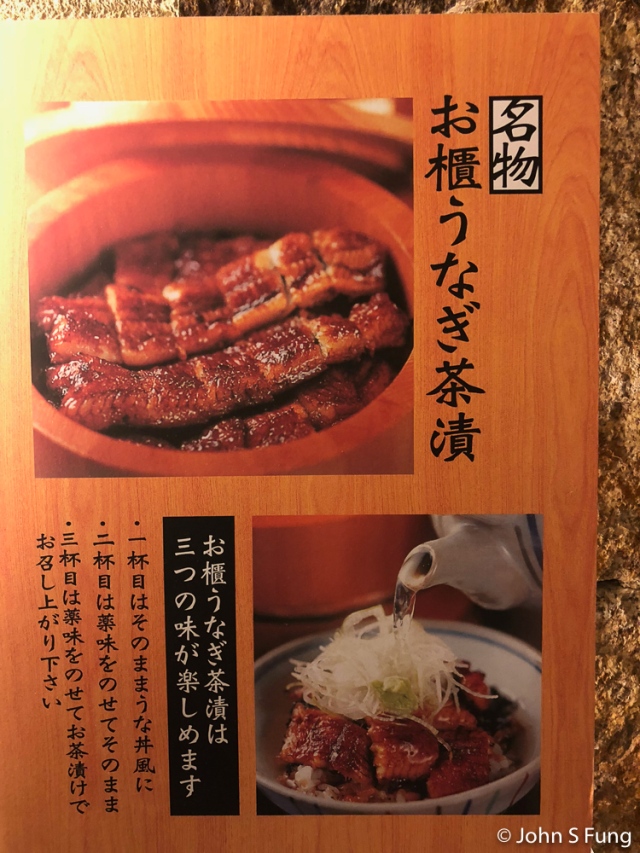
鰻魚蓋飯三吃 (或四吃), 將櫃內鰻魚和飯均分為四份:
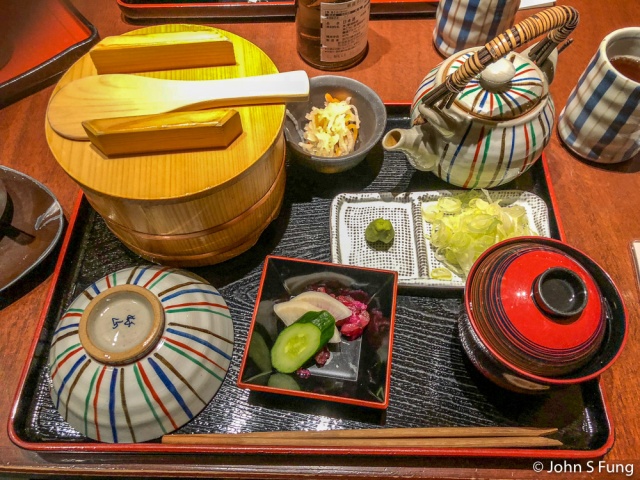
The whole set of Hitsumabushi: the o-hitsu on the upper left corner is the wooden tub in which the rice and grilled eel is served. The tea pot on the upper right contains tea. The red bowl is soup with eel liver and the empty bowl is to be used for eating the meal. In the middle plate, sits the green wasabi and sliced scallion, the others two dishes serve pickles. The main point of having hitsu-mabushi is that one can enjoy grilled eel and rice in different ways and most importantly, your way.
I was given a written instruction with drawings as how to enjoy hitsu-mabushi.

Here is my version of the instructions: divide the eel and rice in the o-hitsu (お櫃, the wooden tub) into four portions, and enjoy them in the following ways:
The following pictures show how the ochazuke style (my favorite) was prepared:
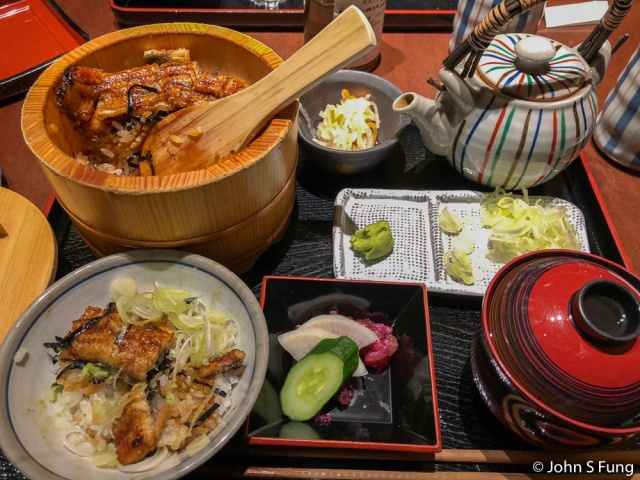
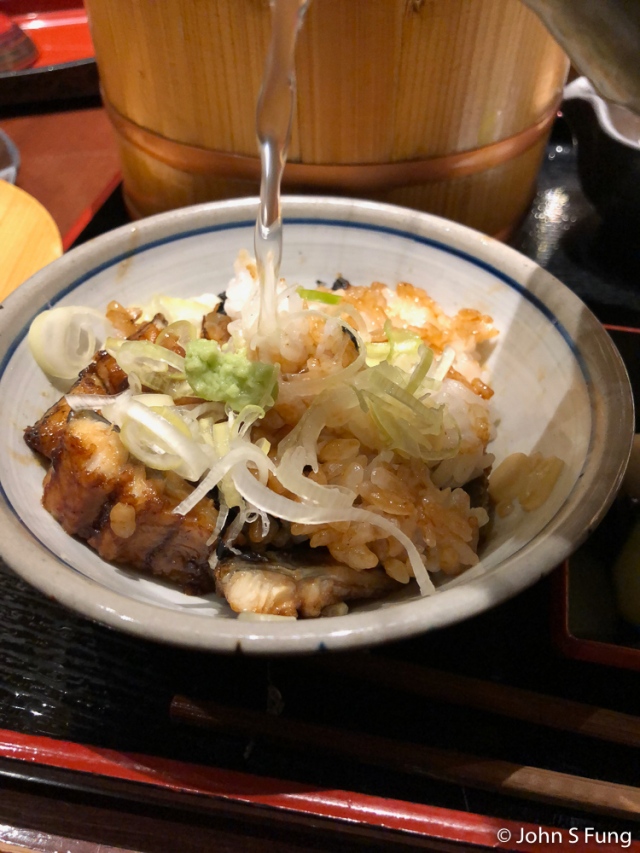
This was delicious, definitely one of the high notes of the day!

⇑⇑ 中之島的櫻花樹幾乎都長滿綠葉了。 Cherry blossom viewing party underway at Nakanoshima, not much sakura left to be seen on the cherry trees.
幾乎每次到北京來, 都會來嵐山逛逛, 只是每次來, 多是旅遊旺季, 嵐山總是人山人海。這次來嵐山來之前, 已聽說是「無足觀矣」, 所以没有帶着賞櫻的心情來, 而是希望能嘗到廣川的鰻魚料理。可惜下午一點站在店前 (午餐營業時間11:30-2:30), 已掛出大大的”Closed” 牌, 一條長長的人龍安靜的在排隊, 等候入座。渡月橋两岸和中之島仍是人頭湧湧, 熙來攘往。桂川两岸的櫻花樹幾乎都長滿綠葉了。我們隨便逛了一下, 櫻花没有了, 廣川的鰻魚也沒得吃了, 我們在主街上買了两串串揚 (Kushiage), 邁開脚步往平野屋進發。往北走左轉到往二尊院的路上, 氣氛就明顯的不同, 沒有紛雜的人群, 多了一分閑静的郊外氣息。路上看到一些晚開的櫻花正盛開着, 走了一段路, 在一小店休息, 吃了碗鯡魚麵, 身心舒暢。可是快走到平野屋時, 開始下雨了, 也有點冷, 天色太暗, 愛宕念仏寺就没上去, 怱怱拍了幾張平野屋就找車往回走了。
Kyoto Cherry blossom viewing tour 4.7 Arashiyama
The weather forecast for that day was partly sunny in the morning, and turning cloudy and shower in the afternoon. Based on the info collected the day before and what we’d seen in the past six days in Kyoto and Nara, we came to the conclusion that most of the cherry blossom spots on our list that we hadn’t visited at that point would not have much to offer except those of late blooming varieties.
On April 7th, we decided to go to Arashiyama in the morning for a walk and more importantly, in hope of getting a grilled eel lunch at the famous Unagi Hirokawa (廣川) and to take picture of the four-hundred-year-old teahouse Hirano-ya. Unfortunately, by the time we stood in front of the Hirokawa restaurant which is located just across the street from Tenryu-ji, a big “closed” sign was already posted although it was only 1pm (lunch hours: 11:30-2:30), a long line of folks were waiting quietly to be seated. As always, the main streets of on both sides of the Togetsu-kyo bridge (渡月橋), and the Karashima as well, were crowded with tourists. We briefly strolled the areas and found there was not much of sakura blossoms left to be seen along the Katsura River, we bought a couple of fried food on the stick, Kushiage, also known as Kushikatsu, across the street of Hirokawa, and set out to walk to the country side of Sagano.
It was a pleasant day to walk in such a nice neighborhood, once we turned to the road that leads to Nisonin Temple, we left the crowd behind. By the time we almost reached Hirano-ya (平野屋), it was raining on and off. Anyhow, I was able to take some pictures of Hirano-ya but skipped Otagi Nenbutsuji Temple(愛宕念仏寺).
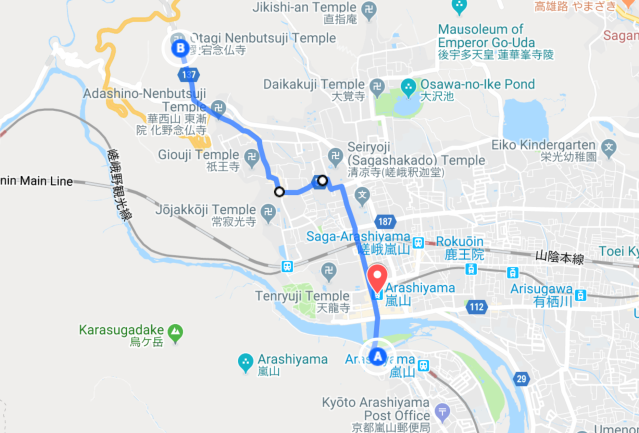
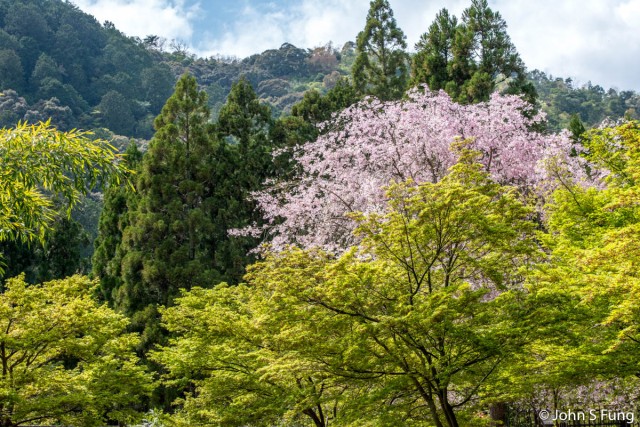

⇑⇑ 串揚 Kushiage, also known as Kushikatsu
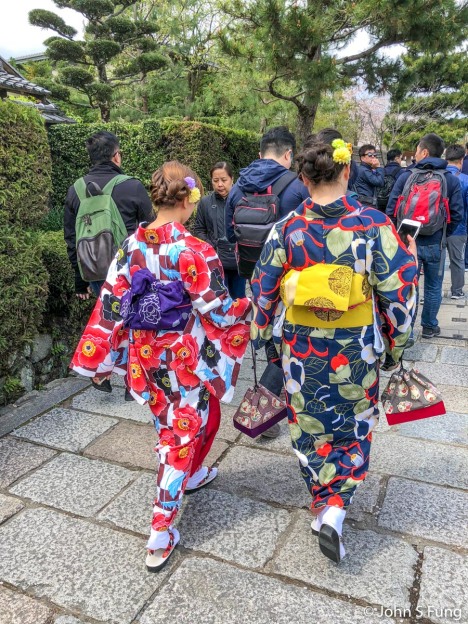
⇑⇑ As always, the main street of Arashiyama was crowded.
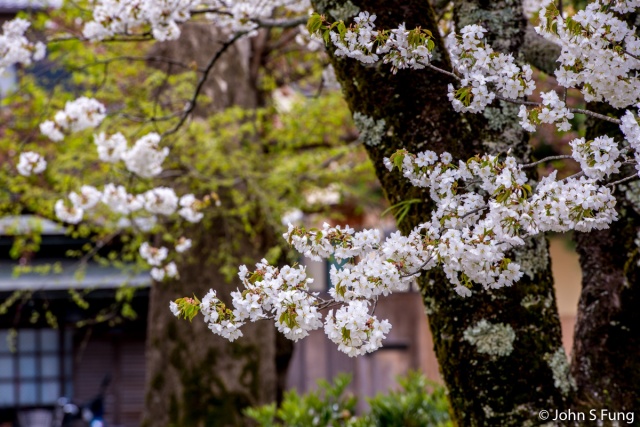


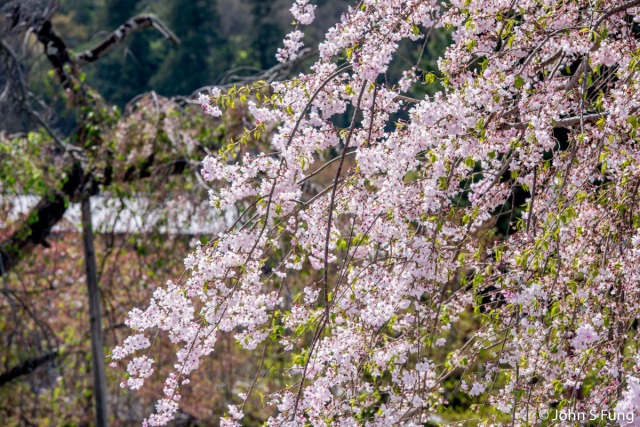

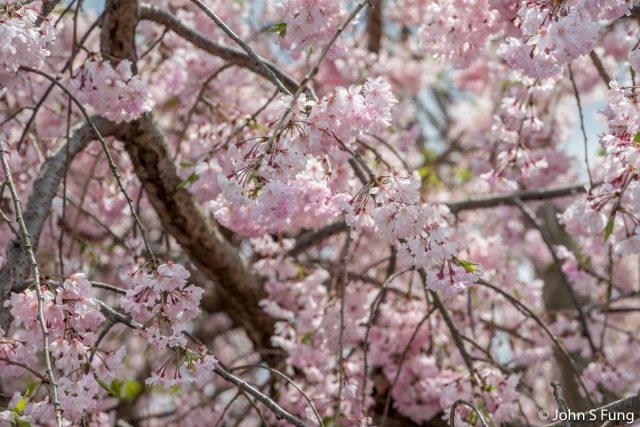
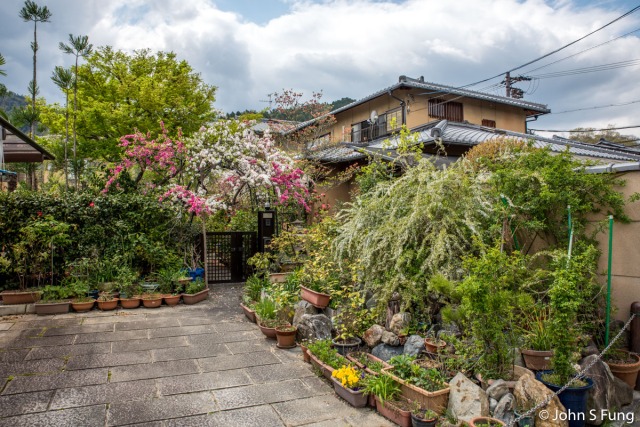
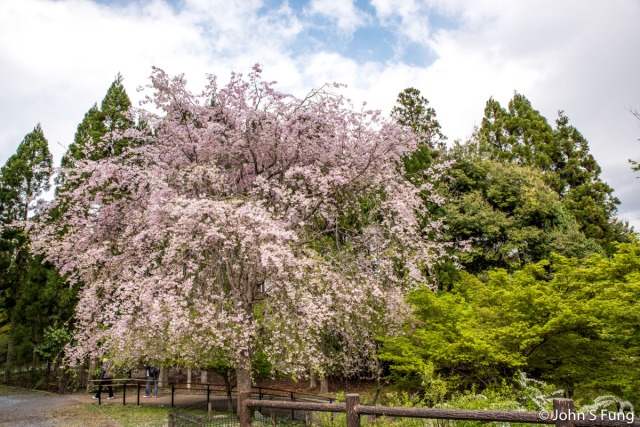
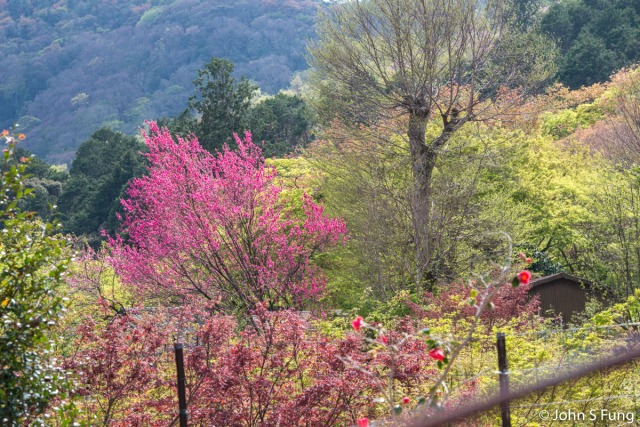

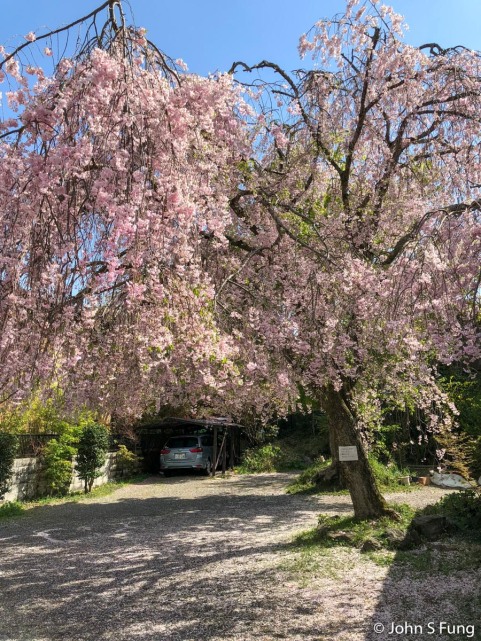
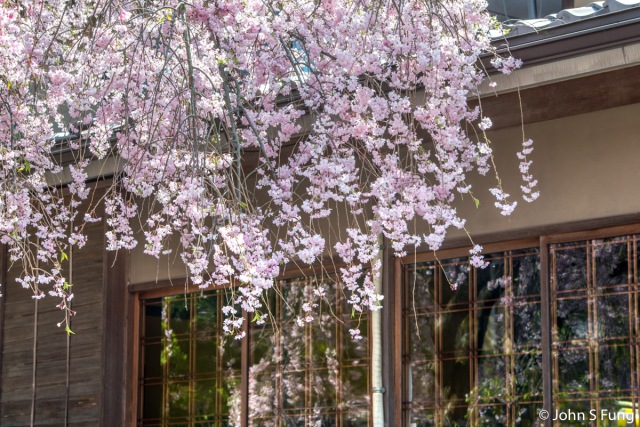
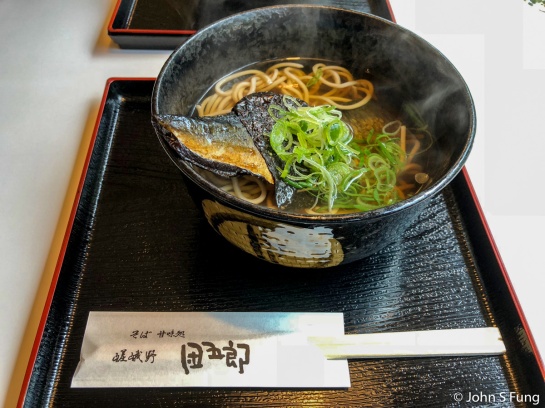
⇑⇑ 鯡魚蕎麥麵說是代表京都的味道, 所以每次到京都, 有機会都会吃上一碗, 並不是真的喜歡那味道, 而是喜歡我在京都那感覺。
⇑⇑ Nishin soba (kippered herring), known to be the taste of Kyoto. Whenever I am in town, I like to have a bowl, not that I like the taste that much, but to feel that I am in Kyoto.

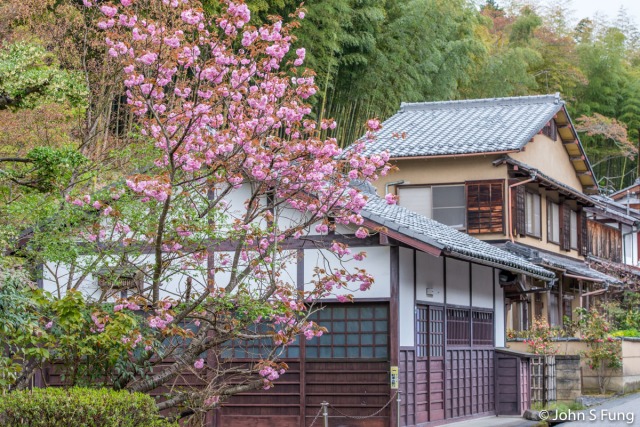

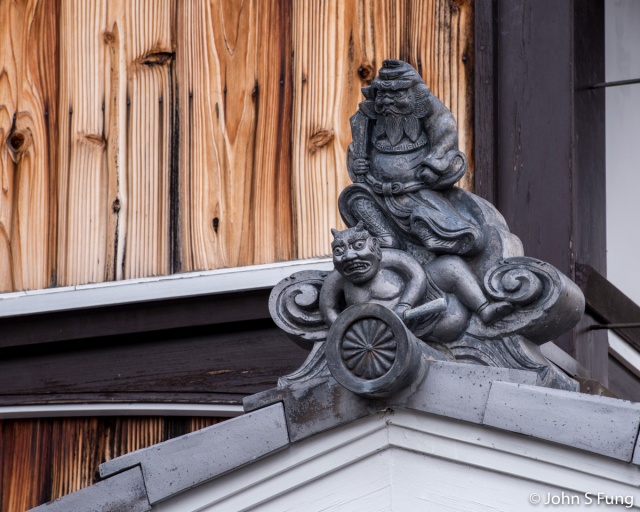

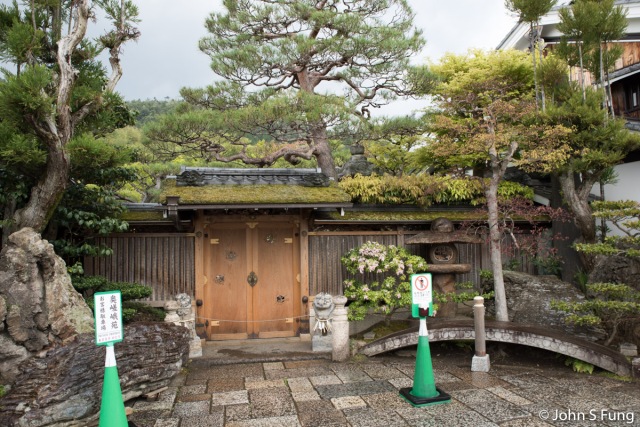
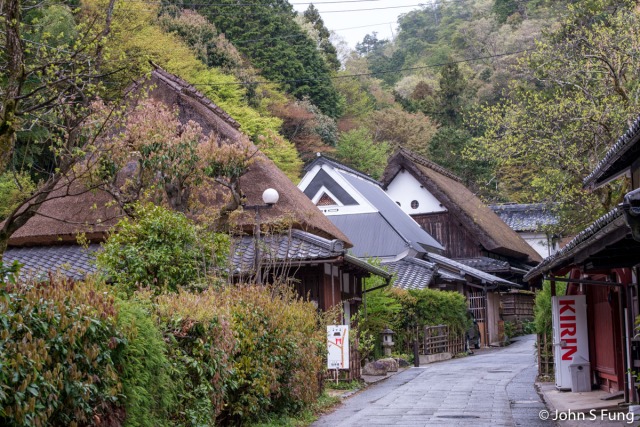
據說原來的嵯峨野只是普通的鄉間, 雖然已没有多少農田, 不過仍然見到茅草屋頂的農舍。
It was said that Sangno was once nothing more than a quiet country village. We didn’t see any paddy fields along the road to Hiranoya, but we still saw some farm house with thatched roof. It is pretty much look like a hundred years ago except the Kirin beer selling machine.
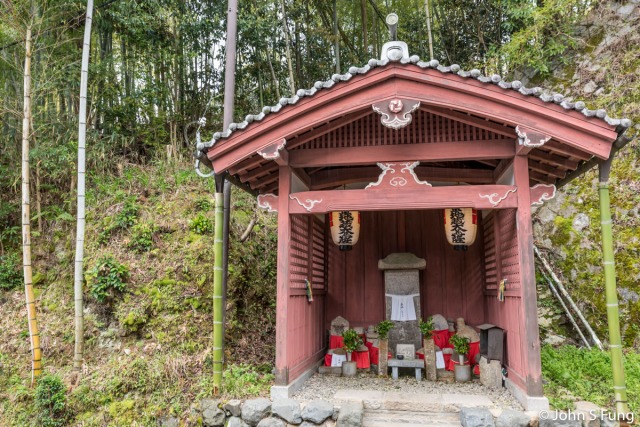
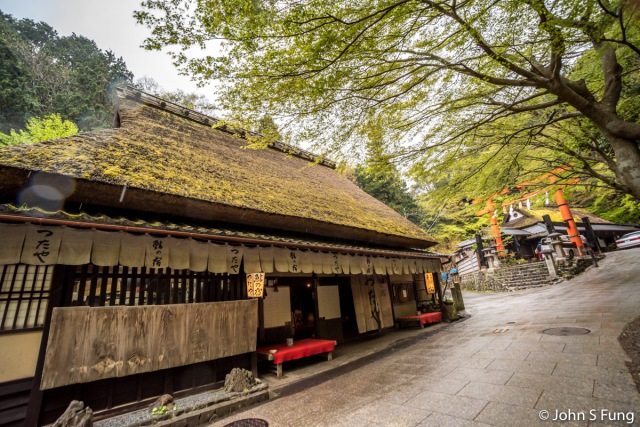
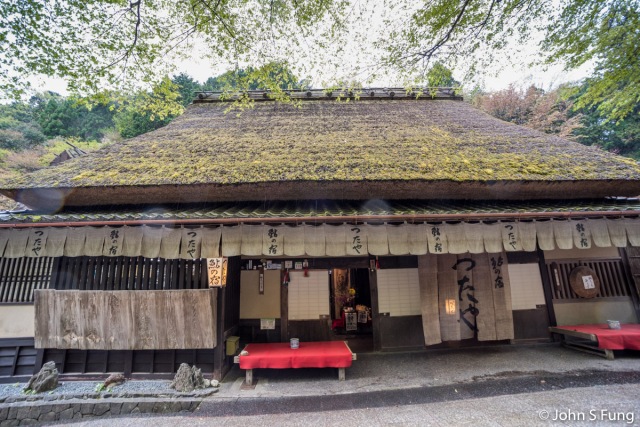
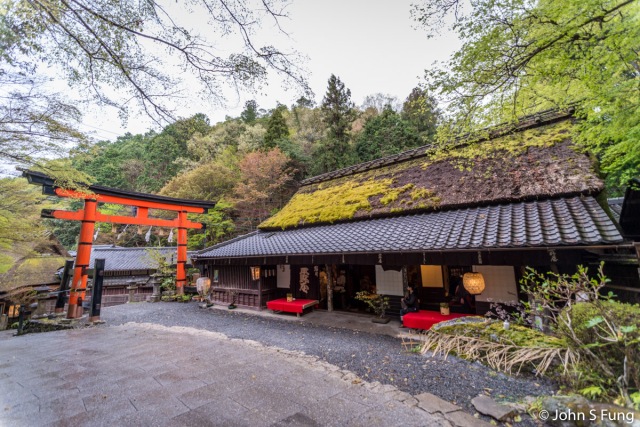
⇑⇑ 愛宕神社 一の鳥居 /平野屋 Atago-Jinja Shrine Ichi-no-Torii Gate/Hirano-ya
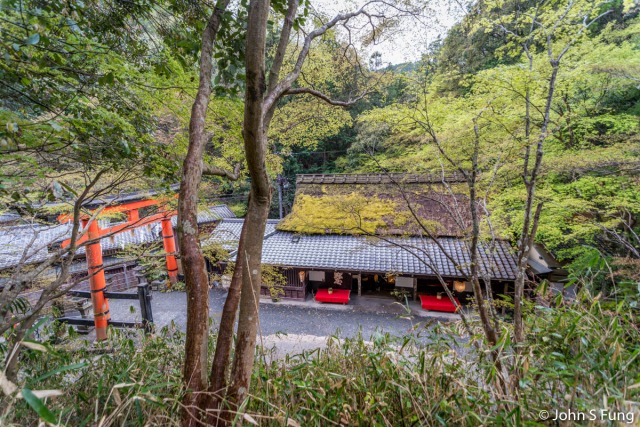
從前, 嵯峨野是京都人上山祈福(免於火災)所經之路, 茅草屋頂的平野屋茶座是四百年的老店, 是上下山遊人的歇脚喫茶的茶室, 供應しんこ だんご(烤糯米丸子) 和綠茶。雖然現在供應糯米丸子, 但現在平野屋以鮎魚(ayu)料理聞名。
The beautiful thatched rooftops of Hirano-ya, a four-hundred-year-old teahouse, used to serve tea and a skewer of shinko dango (rice confection), now well-known for their ayu (sweet fish).
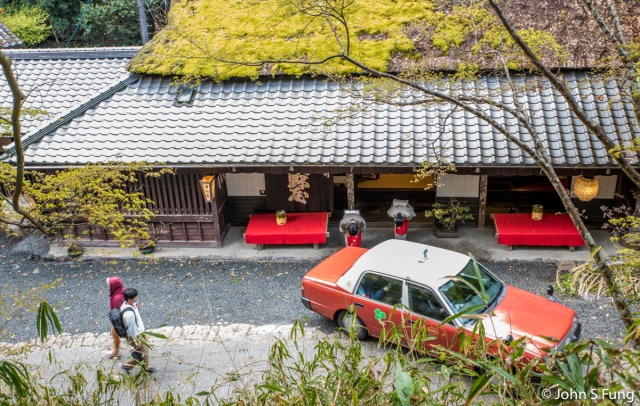
In the old days, Hirano-ya was one of the teahouses at the base of the hill of Sangano that offered a resting place for those folks who performed a customary climb to plead for the mercy of the God of Fire. In modern days, although shinko dango are still being made freshly every morning, the teahouse is now well know for their sweet fish cuisine.
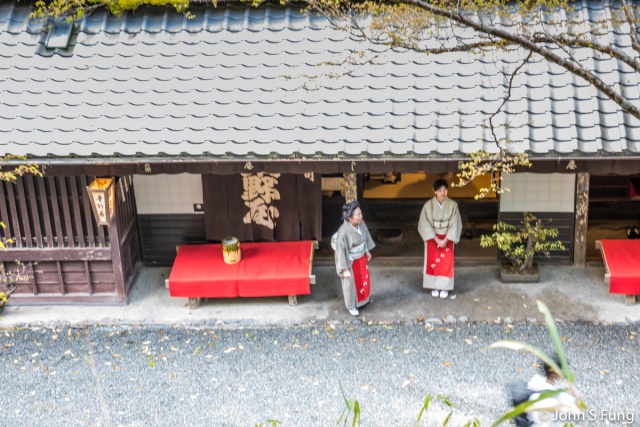
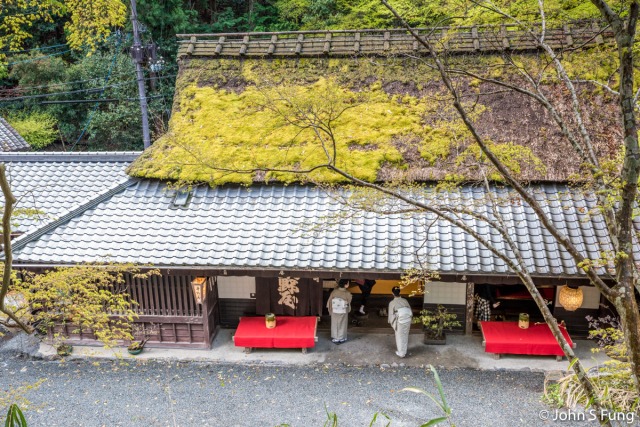
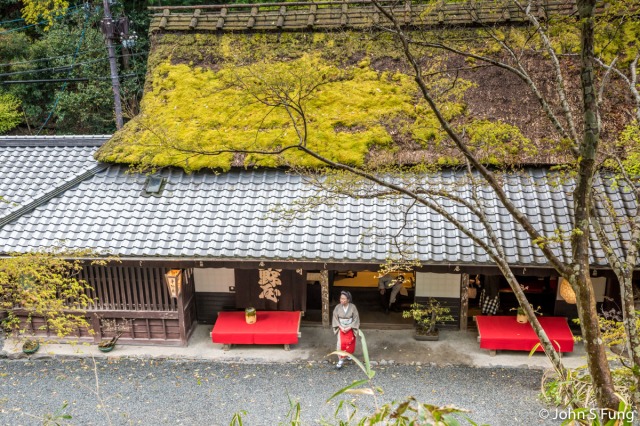
It was drizzling and kind of chilly, my wife was dragging her legs to the bus station. I climbed over the guardrail and stood on the slope above the teahouse and watched for 5 minutes. Somehow I was able to feel the atmosphere of the old Kyoto.


⇑⇑ 愛宕念仏寺: 寺內有數以百計的石刻羅漢, 每一個都是獨一無二的, 像後有奉納善信的名字。據說近年已不再接受奉納, 因為寺內已沒有空間了。下面是十年前拍的羅漢像。
⇑⇑ Otagi Nenbutsuji Temple is famous for its hundreds of rakan (羅漢), each of them was custom made with different facial expression and represents the devotee himself/herself. I had taken a bunch of photos here 10 years ago,
see 京都愛宕念佛寺石羅漢 Otagi Nenbutsuji rakan
2008 嵐山行 My visit to Arashiyama and Otagi Nenbutsuji, the fall of 2008
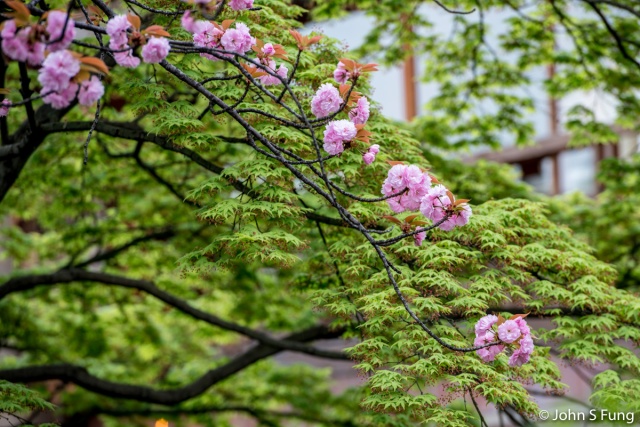
四月五日吉野山之行整日密雲, 陽光没露臉, 六日的天氣預告有陣雨, 加上幾个想去的景点, 如大阪城及造幣局一带、背割堤等據說已落櫻片片, 所以今天不去郊外, 改在市區內賞樱, 下雨時容易避雨。早上再訪高瀬川船入, 因為四月二日初訪見重瓣樱含苞待放, 所以是日再來看, 果然不失所望, 見 高瀨川一之船入 4.2-7 & 4.6-1。隨後信步往祇園進發, 走到三条地鉄站附近就下雨了, 在站內歇了一會, 待雨停了, 再出發。在祇園、白川逛了好一陣, 沒有下雨, 不过天色太暗, 我們遂往高島屋覓食, 就回酒店了。
維基百科: 祇園, 作為八坂神社的門前町,從鴨川到東大路通、八坂神社的四條通沿線發展而成。京都有數的花街(以舞妓聞名),有許多茶屋、料亭、酒吧,也有歌舞伎劇場的南座。北部的新橋通到白川沿岸的地區被選定為國之重要傳統的建造物群保存地區,南部的花見小路一帶被指定為京都市的歷史的景觀保全修景地區。「祇園」一名源自於祇園精舍。維基百科: 祇園
Kyoto Cherry blossom viewing tour 4.6- 2 Shirakawa & Gion, Kyoto
It was kind of rainy that morning, we couldn’t make up our mind of where to go. It was already 10 days after a lot of the early bloom spots had been announced full bloom, meaning that blossoms in those spot would be long gone. Plus, rain was in the forecast, so we decided to stay inside the city, we first walked along Takasegawa, the Yashino cherry and yamazakura were gone, instead some varieties of yaezakura (double flower cherry) are blooming. Our next destination was Gion (祗園) and the Shirakawa (白川).
Gion (祇園, ぎおん) is a district of Kyoto, Japan, originally developed in the Sengoku period, in front of Yasaka Shrine(Gion Shrine). The district was built to accommodate the needs of travelers and visitors to the shrine. It eventually evolved to become one of the most exclusive and well-known geisha districts in all of Japan. The term Gion is related to Jetavana. The geisha in Kyoto do not refer to themselves as geisha; instead, they use the local term geiko. While the term geisha means “artist” or “person of the arts”, the more direct term geiko means essentially “a woman of art”. Wikipedia: Gion, Kyoto
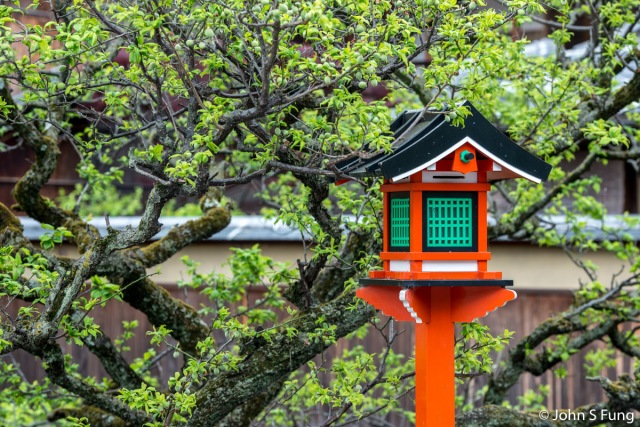
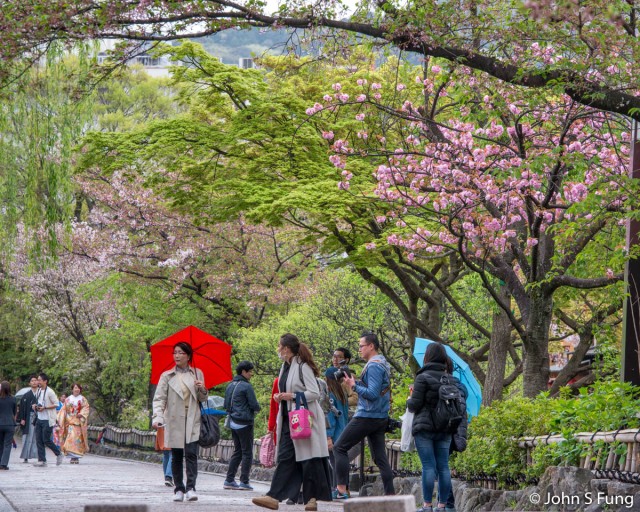

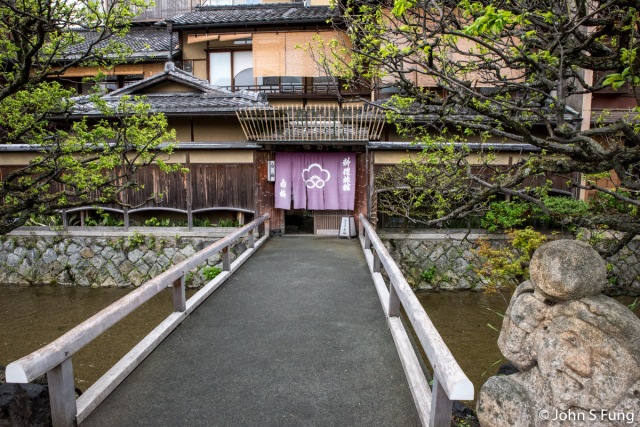
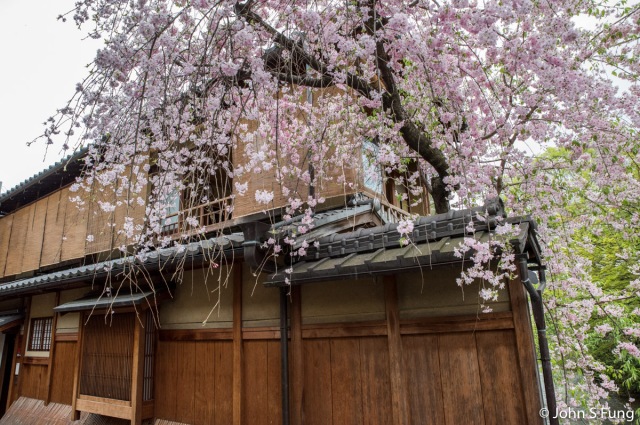
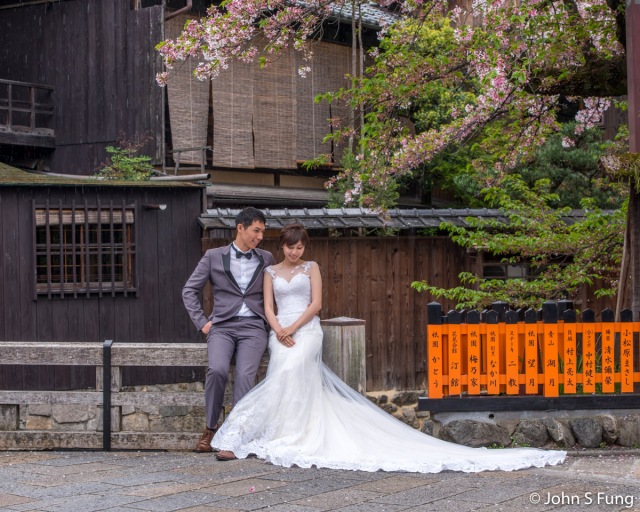
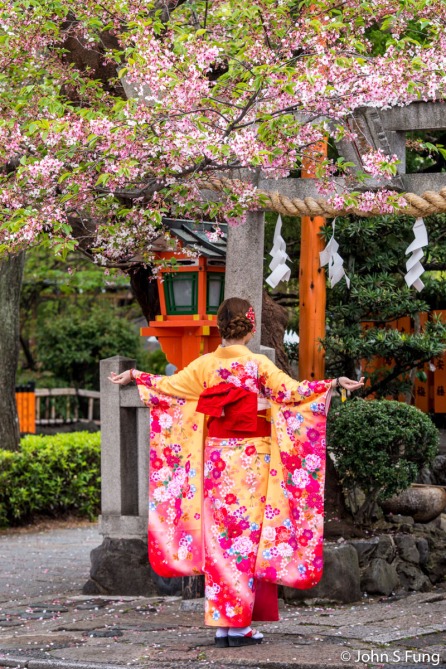
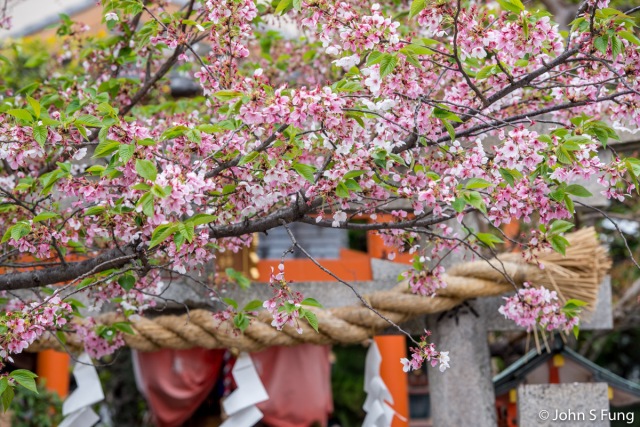
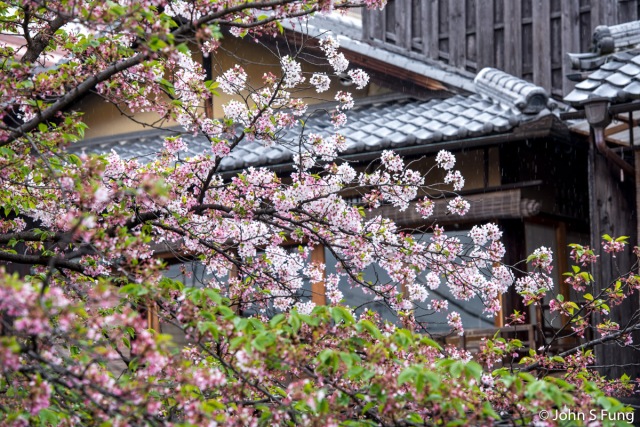
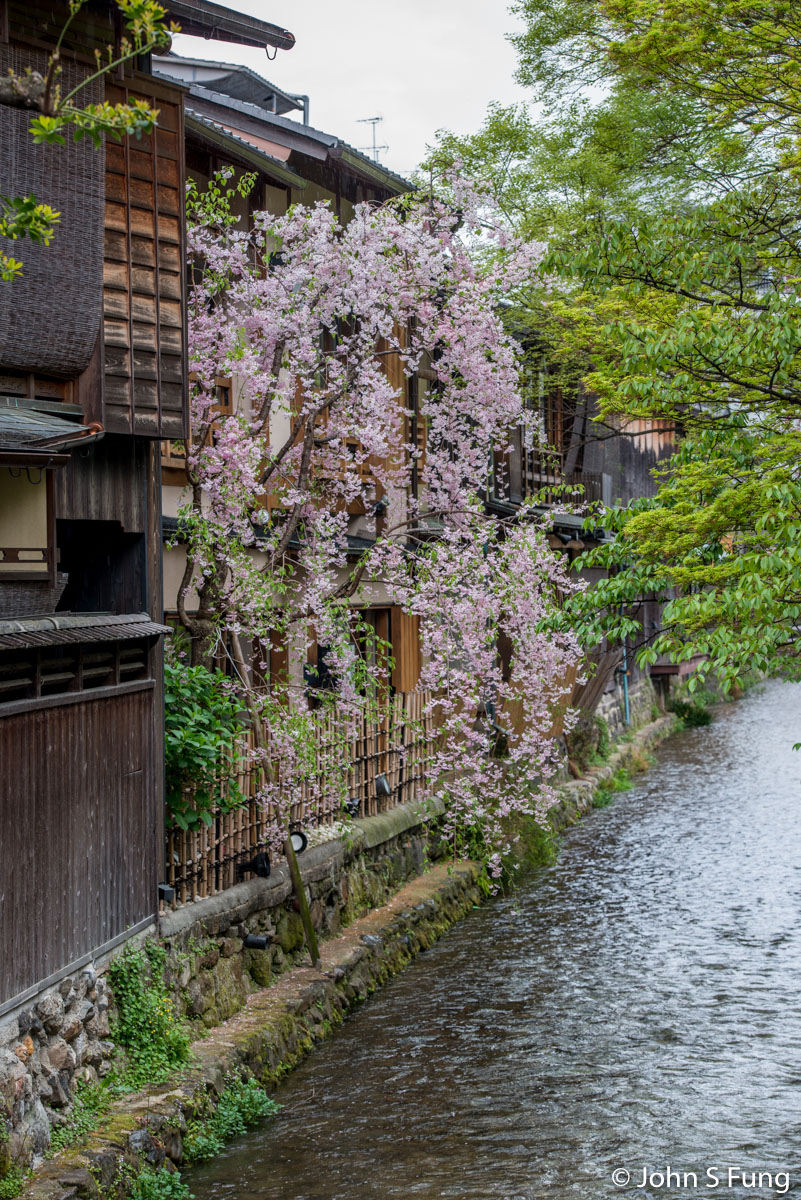
⇑⇑ Shirakawa (白川)

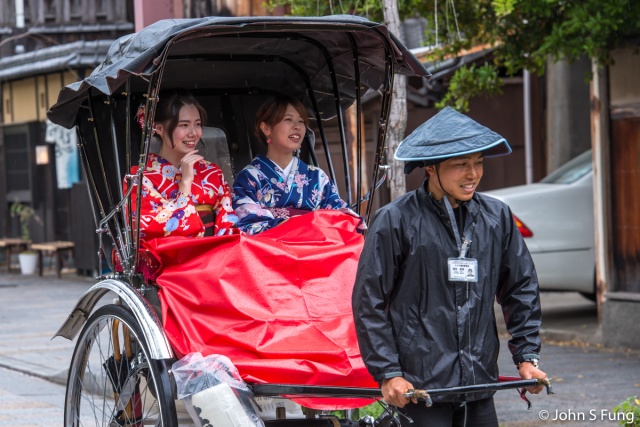
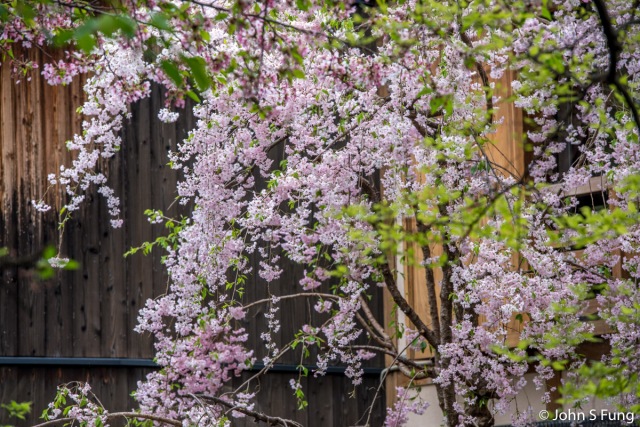
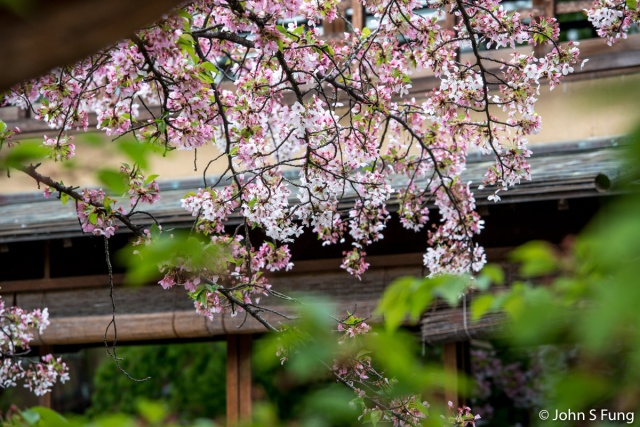
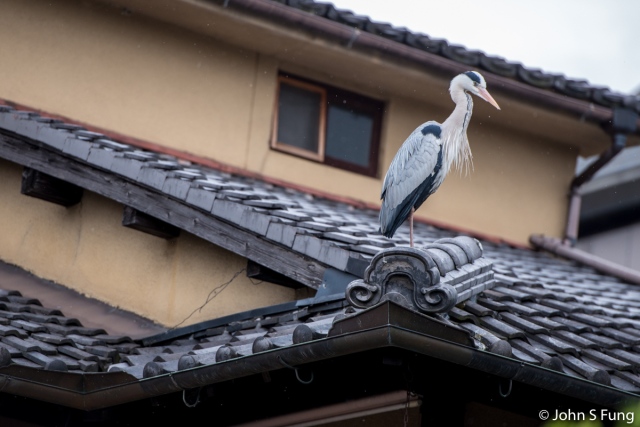
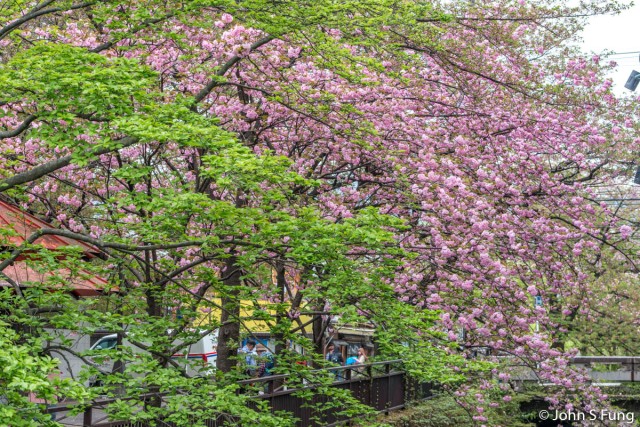
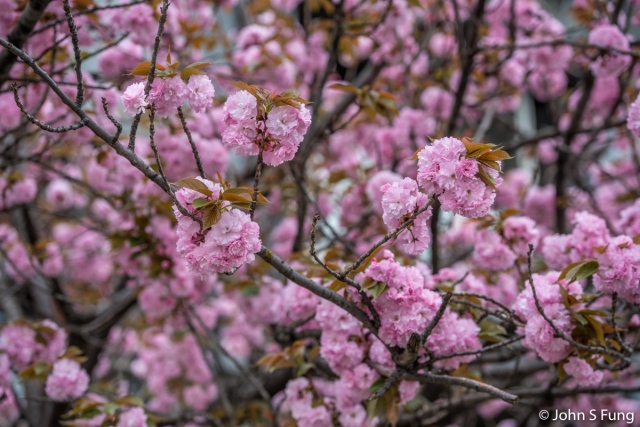


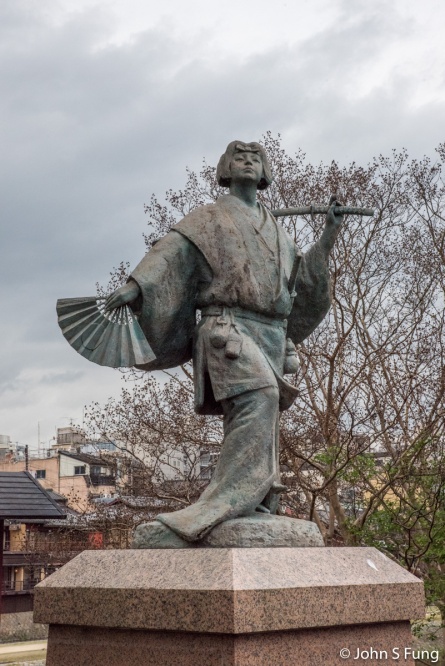
⇓⇓ We walked pass Kamo River and heading to Takashimaya Department Store for lunch. This group of yaezakura (double flower cherry) next to Takasegawa (高瀨川) at Shijo (四条) drew a big crowd of cherry peepers.
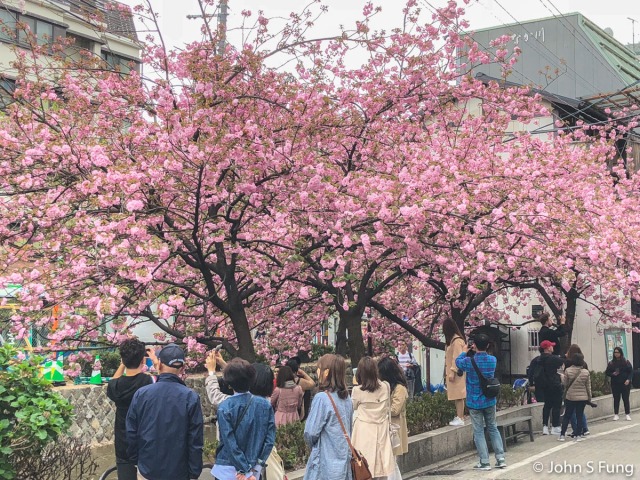
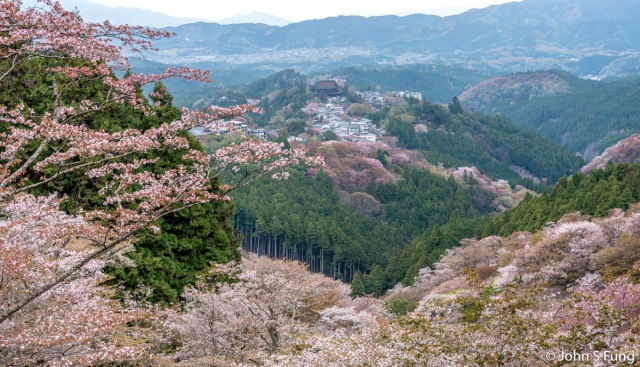
奈良吉野山被譽為関西賞櫻的聖地, 因為吉野山由山脚至山頂種植了成千上萬的櫻花, 與一般寺院、神社的近距離、小品式的賞櫻經騐有很大的不同。我們本來排在4/12-13去賞櫻, 可是2018年的櫻花早開了很多, 加上將會有雨的天氣報告, 我們就在四月五日到訪。由京都去吉野山, 近鉄特急列車(比普通車快不了多少, 只是有位子坐)也要快两小時。我們失策, 沒有提早一天買票, 那天早上只能買到十点多的車票。幸好買了來回票, 否則回程要站两个小時了。
當日陰天, 天色灰沉。出火車站後上接駁巴士直上中千本, 本欲即供上千本, 走至巴士站前, 人龍頗長, 詢問值勤人員, 說要两小時才上得了車, 所以只能安步當車, 徒步由中千本走上上千本。走了差不多三个小時, 差一步之遥快到上千本時, 路很徙, 加上怕回程巴士侯車需時, 誤了回程火車, 就往回走了。
維基百科: 吉野山(よしのやま)位在奈良縣中部,為從吉野郡吉野町吉野川(紀之川)南岸到大峰山脈北端的山稜之總稱,或是以金峯山寺為中心的山地之廣域地名。
古來以花之名而為人熟知,其中特別以櫻花最為出名,甚至被稱讚為千本櫻,地域分成下千本(しもせんぼん)、中千本(なかせんぼん)、上千本(かみせんぼん)、奧千本(おくせんぼん)。 平成2年(1990年),選定為日本櫻名所100選。 維基百科- 吉野山
Kyoto Cherry blossom viewing tour 4.5 Mount Yoshinoyama
The Yoshinoyama in Nara is considered to be the Mecca of cherry blossom viewing in Kansai region (関西地方 Kansai-chihō). Mount Yoshino is famous for its many thousands of sakura trees which are planted at different altitudes. There is a Japanese term used to describe the whopping cherry trees here at Yoshinoyama,「一目千本」, literally means “one eye for thousand trees”, that is “one can view thousands of cherry blossom trees at a glance”. In general, the viewing areas are divided in four areas according to altitudes, namely, Shimosenbon (lower thousand trees 下千本), Nakasenbon (middle thousand trees 上千本), Kamisenbon (upper thousand trees 上千本), and Okusenbon (inner thousand trees 奧千本).
For a typical year, April 12-14 is considered the best time one can view the most of the cherry blossoms at Yoshinoyama. However, 2018 sakura season was not typical, most of the areas bloomed 7-8 days earlier than usual. The weather was pretty nice the first four April days in Kyoto, we were able to cover a number of spots. However, starting from April 5th, overcast, shower and rain were forecasted for the next few days, we therefore made our strategical decision to abandon the plan to go to Osaka, and also two river bank spots where petals had been blowing off for days, instead, we headed to Yoshinoyama, a week earlier than originally planed.
Yoshinoyama is a 40 minutes train ride from Nara, from Kyoto it takes about 100 minutes by express Kintetsu train (I didn’t feel it was an express train, and on its second leg, the train stopped frequently on most of the stations). we arrived Kyoto station before 9 am to find out that the earliest express tickets we could get were the 10:30 am (?) one. It was definitely a right decision to go to Yoshinoyama, by the time we were there, it was said that the lower-thousand-tree had already passed their full bloom, with limited time, we headed directly to the middle-thousand-tree. After getting off the bus, we checked the connecting bus service to the Kamisenbon (upper thousand) and the Okusenbon, the bus attendant at the bus station with a long line told us that there was no way we could get on board in the next two hours. The only thing we could do was to walk as far up as possible.
Wikipedia: Yoshino Mountain is famous for its many thousands of sakura trees, and is heavily referenced in both traditional waka poetry and folk song for its abundance of flowers in the spring, with famous poets such as Chiyo offering prose on the peak and its many flowers. These flowering specimen trees were planted in four groves at different altitudes, in part so that the famed trees would come into bloom at different times of the spring. A 1714 account explained that, on their climb to the top, travelers would be able to enjoy the lower 1,000 cherry trees at the base, the middle 1,000 on the way, the upper 1,000 toward the top, and the 1,000 in the precincts of the inner shrine at the top. Wikipedia: Yoshinoyama
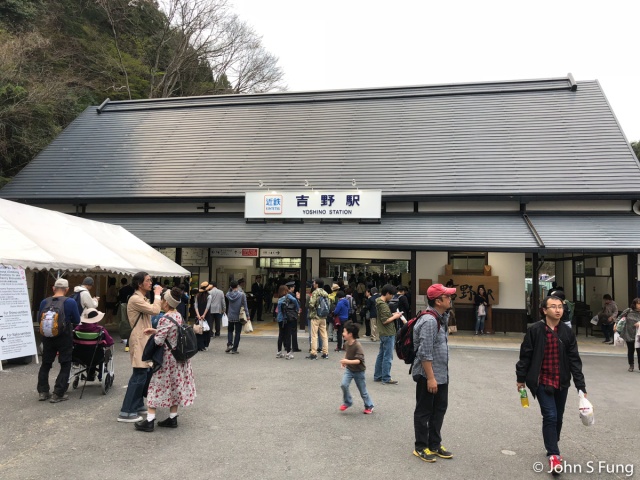
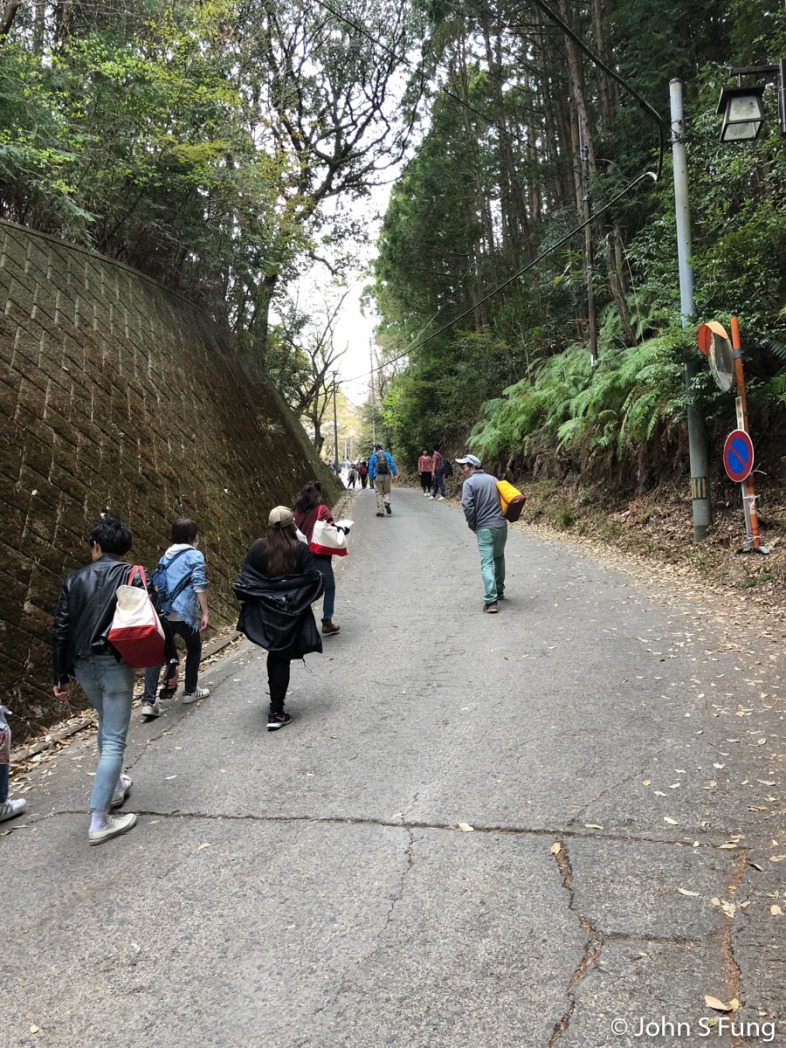
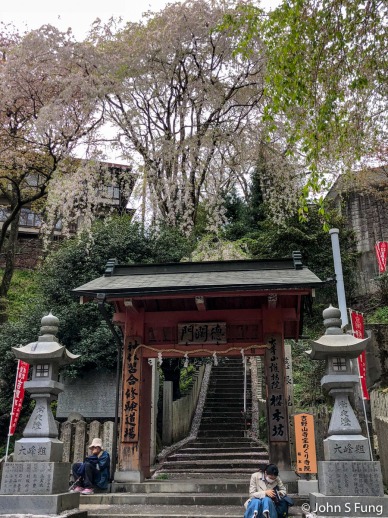
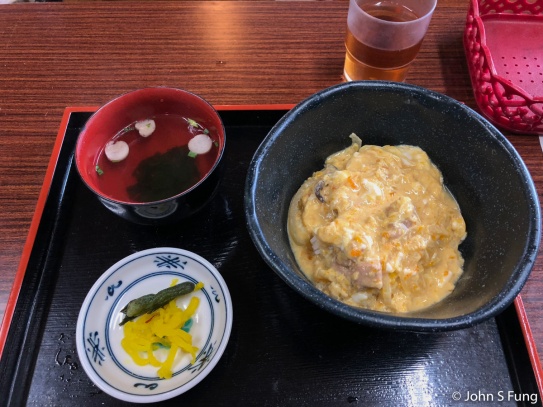
中千本(なかせんぼん): 抵中千本己是下午二時, 飢不擇食, 怱怱吃点午餐就上路了。
By the time we reached Nakasenbon (middle thousand trees 上千本), it was already two o’clock in the afternoon, the first thing we did was to get something to eat.

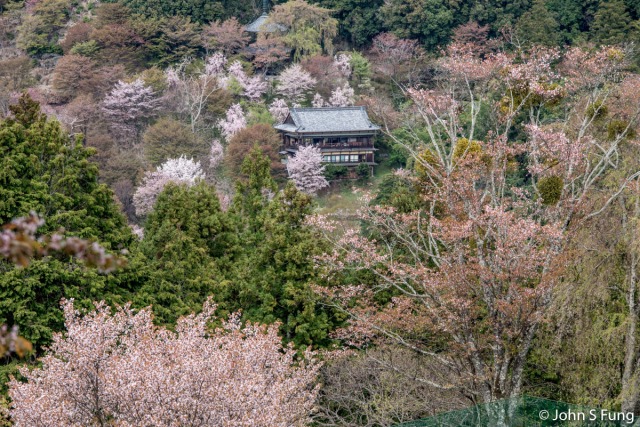
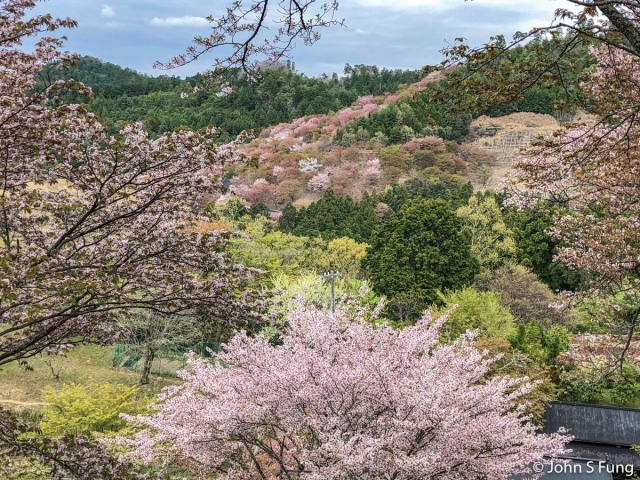


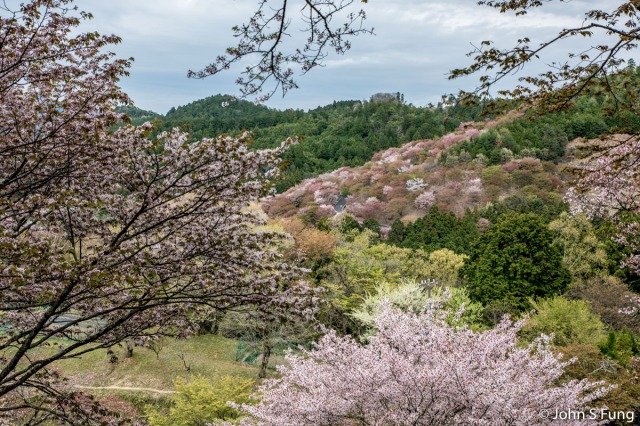


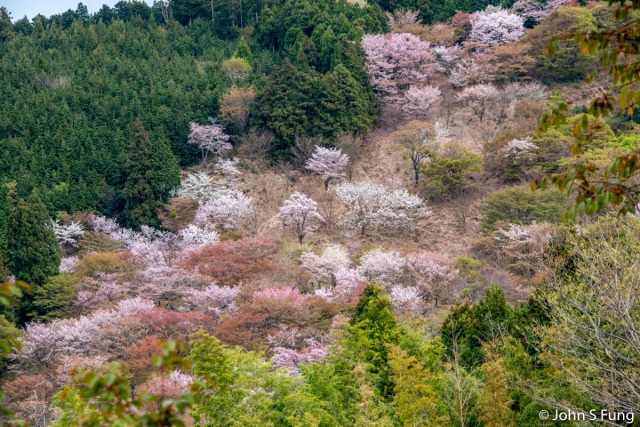
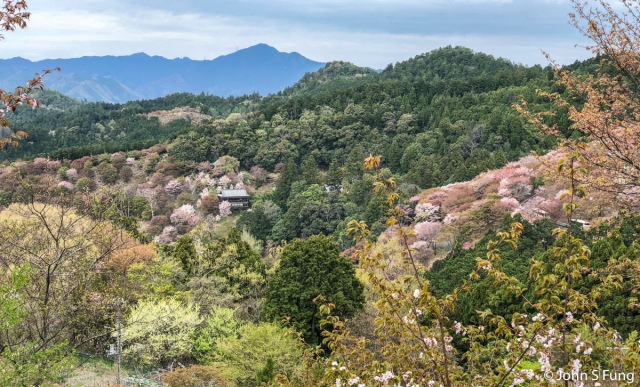
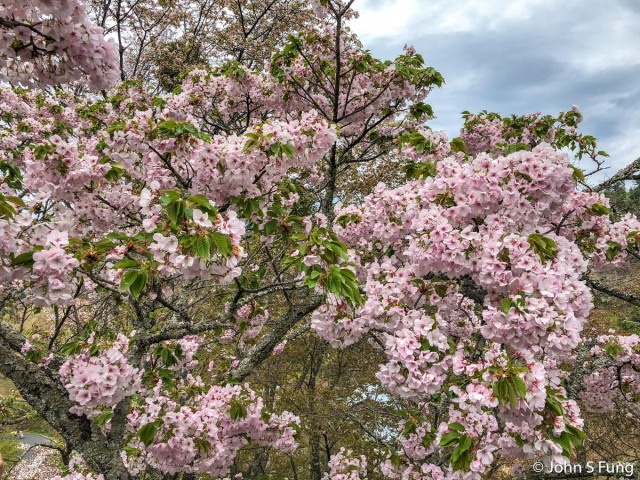

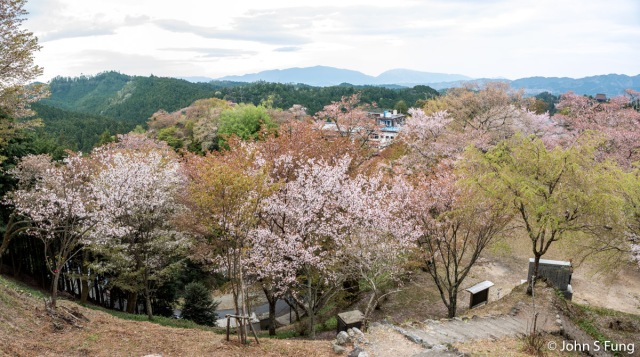

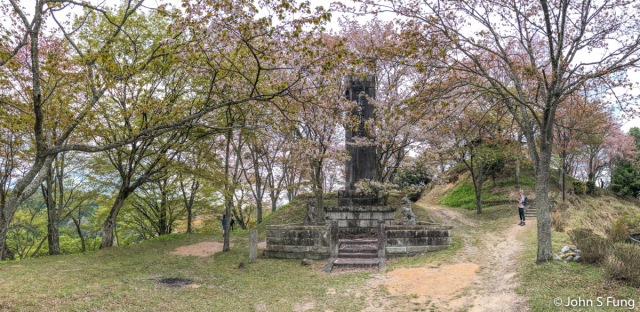
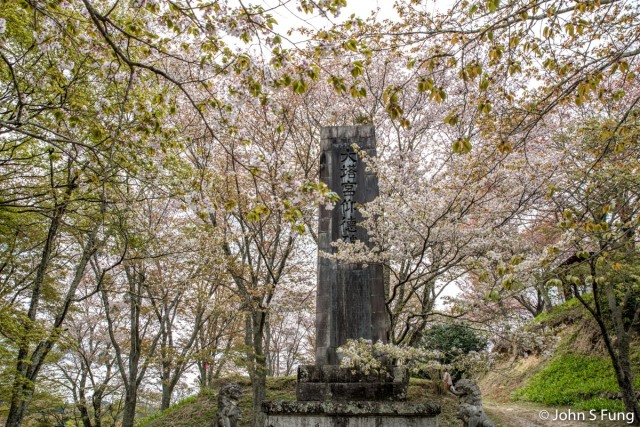
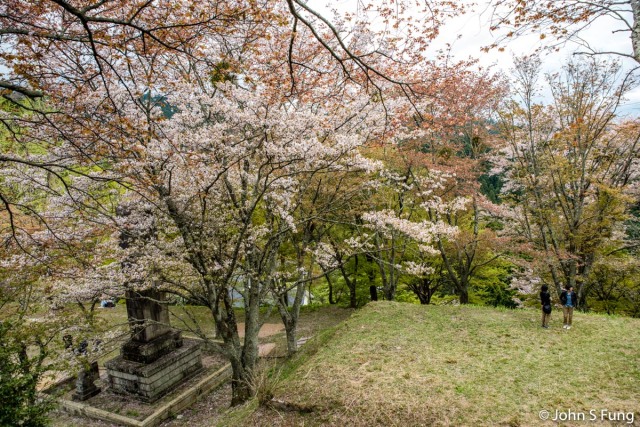
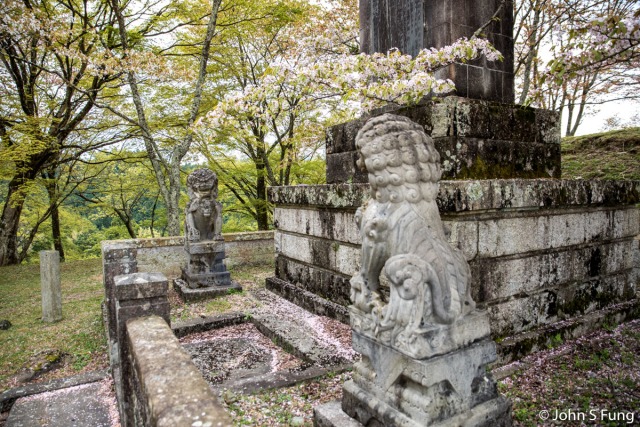


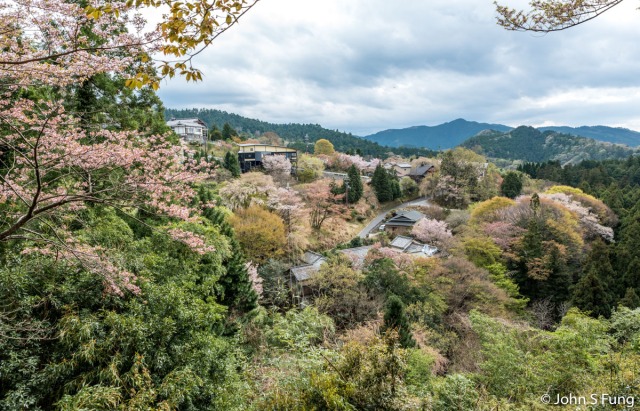

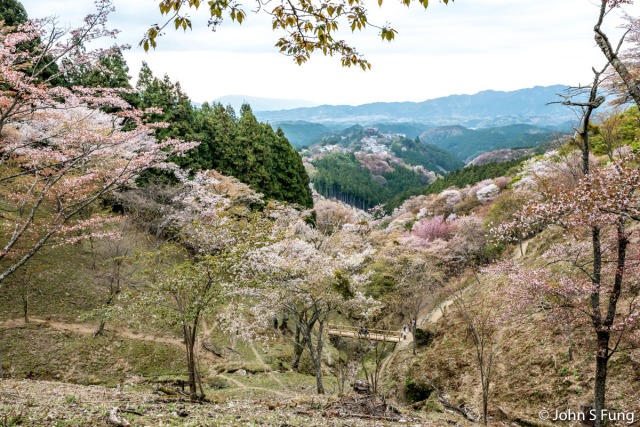


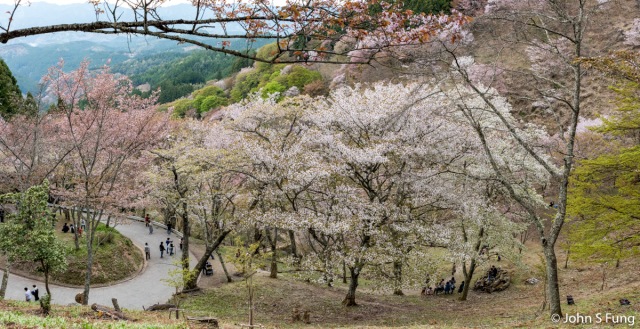
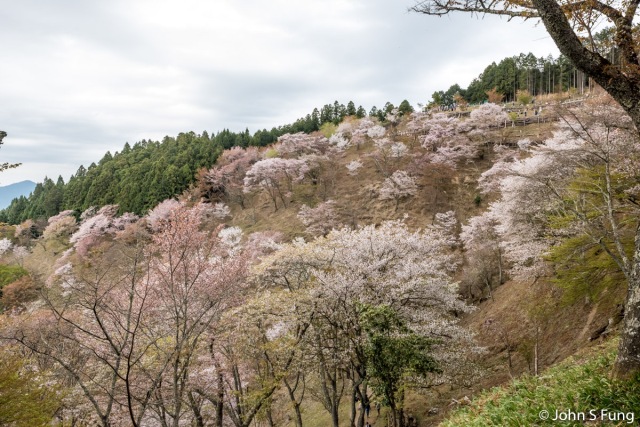
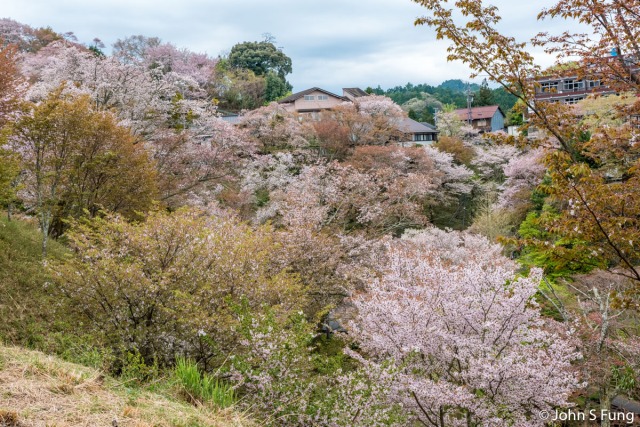
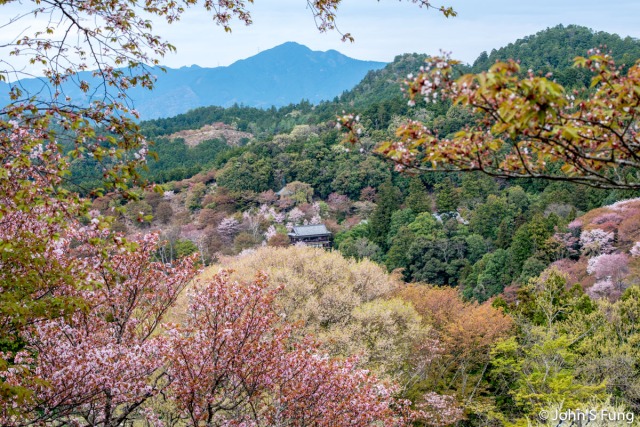
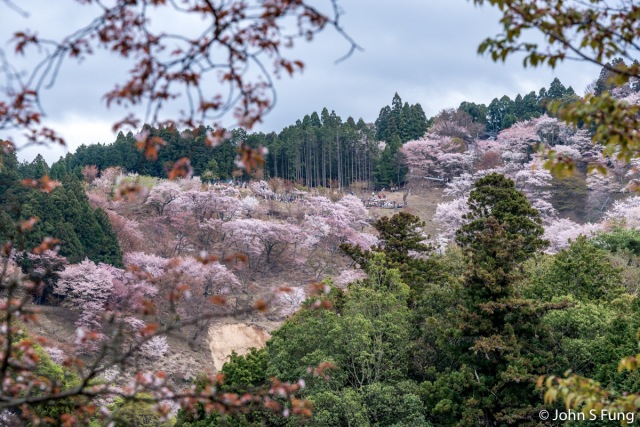


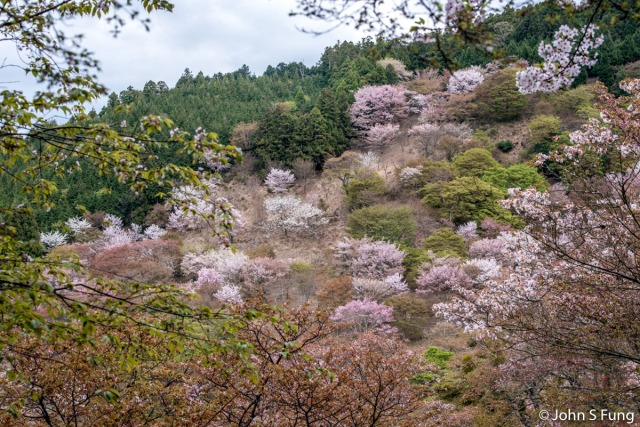

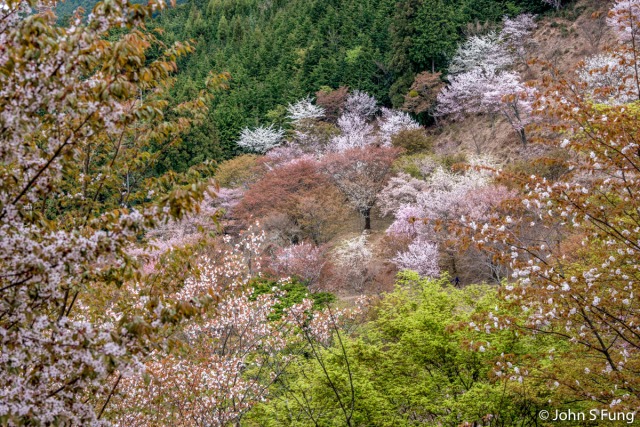


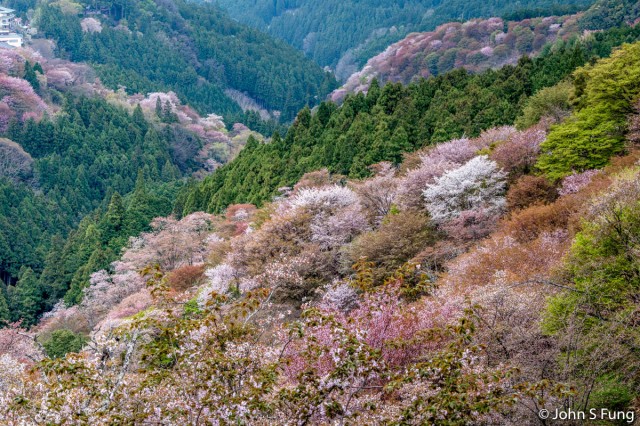
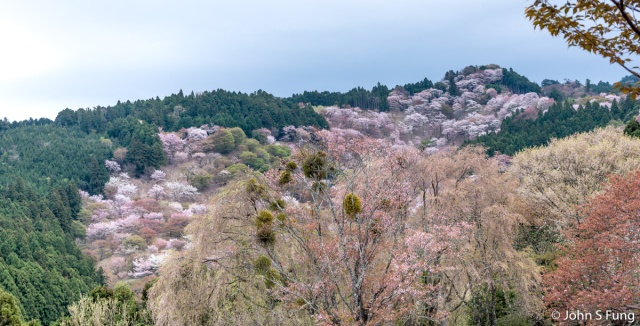
After a 2-hr+ up hill hike, the upper-thousand ⇑⇑ was in sight (if I am not mistaken) and as the road ahead became steeper and steeper, we were in a dilemma whether we should proceed on or turn back to catch a bus to the train station in order not to miss our train. We were lucky that we had bought our return tickets that morning, and after checking with the locals, we decided to head down to the bus station to ensure we had enough time. By the time we stood in front of the station, a big SOLD OUT sign was posted (one still can get on a non-express-train, it just takes longer and a seat is not guaranteed). My advice to those who think of visiting Yoshinoyama during sakura season, get your express return ticket early, a day or two in advance if you can.

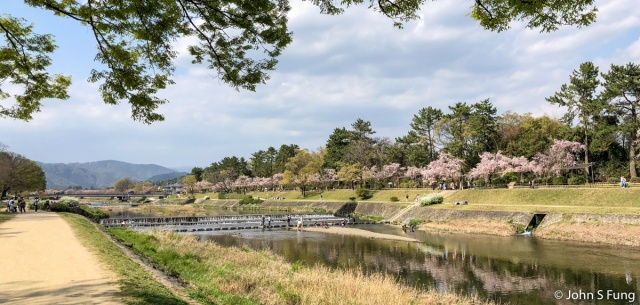
四月四日這天, 上午去平安神宮, 櫻花還不少, 只是走到崗崎疏水, 花就明顯落得七七八八了。走到蹴上鉄道, 花况奇差, 真的是惨不忍睹。我們按計劃坐地鉄去訪半木之道和京都植物園, 只是網上說3月28-29就滿開了, 雖然那天才是4/4, 恐怕是不太樂觀。
半木之道位於京都植物園西面, 沿鴨川東岸種了八百公尺長的深粉紅色的垂樱, 櫻樹前築有竹棚, 開花時形成深粉紅色櫻花隧道。網上照片十分好看。我們來到時, 還有不少花, 只是花色淺淡。繼續向前行, 過了北山路, 前面的樱花並不是垂樱, 有可能是早開的吉野櫻, 花落的多, 恐怕超過一半了。
無可奈何, 只好向植物園進發, 怎知剛到入口處, 就刮風下雨, 猶豫了一下, 就鑽進入口旁的北山地鉄站, 打道回府去也。
Kyoto Cherry blossom viewing tour 4.4-3 Nakaragi no Michi (Path)
As shown on the map below, Nakaragi no michi is the section of the path in front of Kyoto Botanical Garden along the Kamo River. A long line of pink weeping cherry trees are planted along the river, our goal that afternoon was to walk along this path, and then check out the cherry blossom in the Kyoto Botanical Garden.
Sections of bamboo trellis are constructed along the path to support the branches of the weeping cherry trees. It is said that this weeping cherry variety (Beni shidare sakura) is deep pink in color making the path a pink cherry blossom tunnel. We visited this site on April 4th, supposed best time to visit for cherry blossom, however, the color of the blossom was light pink, appeared to have faded and was at the final stage of their full bloom. When we walked further north and across the Kitayama Road, the cherry trees are not the same variety, they are probably the Yoshino sakura, it was even worse, not much left to see. I have to confess that we were disappointed.
We then turned to Kyoto Botanical Garden, however, before reaching the entrance of the garden, it began to rain, we had no choice but walked down the Kitayama subway station and called it a day.
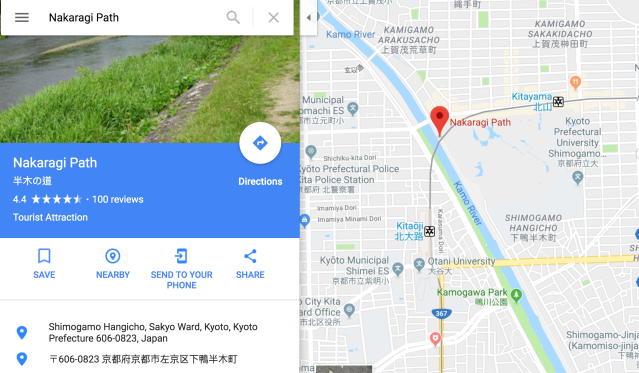
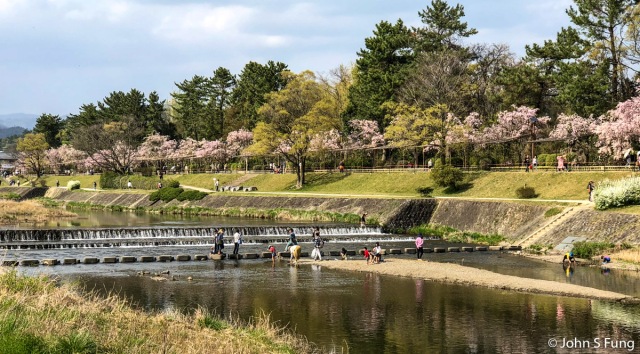

⇑⇓ 粉紅色櫻花隧道。
⇑⇓ The pink sakura tunnel along Nakaragi Path.
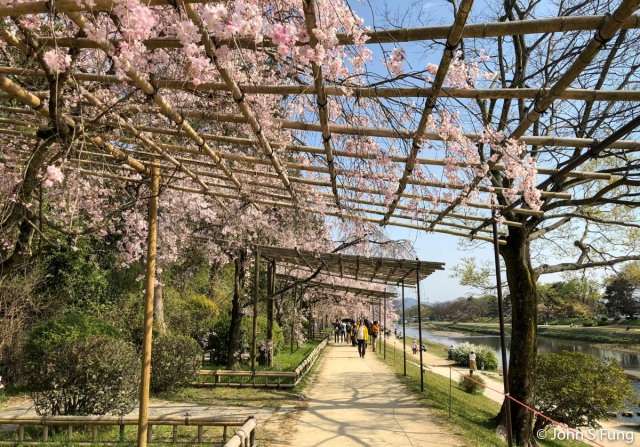
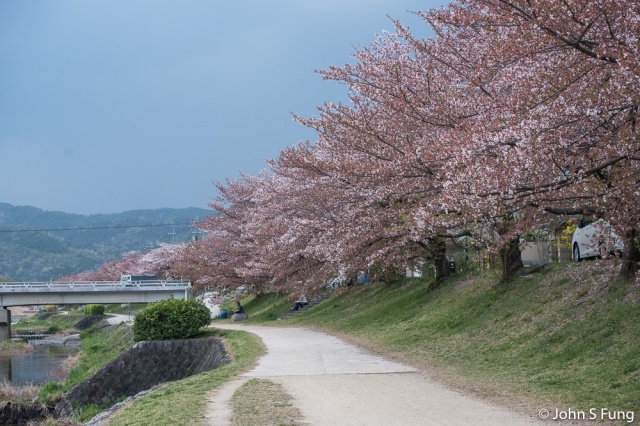
⇑⇓ 過了北山路, 前面的樱花並不是垂樱, 有可能是早開的吉野櫻。
⇑⇓ North of Kitayama Road, the cherry trees are not weeping cherry, probably Yoshino sakura.
